The Renaissance in Rome
Encore
Learning
Fall Semester 2014
Instructor: Tom Wukitsch
All
type
sequences
in the text that begin with "http" are internet links.
Note that the Internet is notoriously volatile and that links
can vanish overnight. Searching with an Internet search
engine can often find what you need.
For
additional information and Internet links, see http://www.mmdtkw.org/ALRItkwPages.html#Renaissance%20Rome
All
information,
texts,
and
images
are either original work or are used under the "fair use
doctrine" (http://mason.gmu.edu/~montecin/cpyrght.htm).
Medieval Legacy -- Unit 01http://www.mmdtkw.org/RenRomUnit01MedievalLegacy.html
From Medieval to Renaissance - Finding the Transition Point
Mental Renaissance -- Humanism replaces/adds to Scholasticism
Benedict and ScholasticaLiterary prerequisites -- two seemingly opposing trends
Influence of Aquinas and ThomismRise of vernacular literatureArtistic prerequisites
Interest in and attempts at emulation of the classics in LatinFinding the source materialPrinting makes literature widely available
Epigraphy
Documents and books
Analysis and criticism(Not deconstruction)The Late Medieval literary "big three":
Dante,
Petrarch, and
BoccaccioMedieval replacement of Byzantine art with "Westen" art"Rediscovery"? or "Rebirth"? -- Il Instauro? o Il Rinascimento?Late Medieval Artistic "big three" (and Rusuti)
In either case a willingness to break loose
"Charlemagne's renaissance" was cut short by expenditures connected with family disunity and wars. Charlemagne himself had tried to use the divisio regnorum system to divide his empire, but only one of his sons, Louis, survived him. Louis was more successful in breaking up the Carolingian domains -- his four legitimate sons (by two wives: 3 + 1) fought wars amongst themselves for their shares of Charlemagne's empire. The Carolingians
The 12th century "Little Renaissance" (http://www.historyguide.org/ancient/lecture26b.html) -- cut short in Rome by the departure for Avignon
(Rusuti),
Cimabue,
Cavalini, and
Giotto
Classical physical "remains" were in Rome and that's where everyone came to study themClassical literary "remains" were in monasteries and church libraries and folks with (Roman) church connections had better access.
Where did the Renaissance start?
Petrarch and the French Troubador traditionWhere did the Renaissance go?
Florentine and other northern patronsRoman physical remains - topography as inspirationWhat ancient and Medieval Rome had left behind -- see Unit 01 slides page
Monumental epigraphy
Papal patronage and commands to presence
http://www.mmdtkw.org/RenRomUnit0100-0PixList.html-------------------------------------
Other internet links:
Boccaccio on the Plague
http://www.fordham.edu/halsall/source/boccacio2.htmlDecameron Web
http://www.brown.edu/Departments/Italian_Studies/dweb/dweb.shtmlCimabue bio
http://www.newadvent.org/cathen/03771a.htmCimabue works
http://www.nga.gov/cgi-bin/psearch?Request=S&imageset=1&Person=232230
http://www.kfki.hu/~arthp/html/c/cimabue/Dante bio
http://www.newadvent.org/cathen/04628a.htmGiotto works
http://www.christusrex.org/www1/francis/Giotto bio
http://www.newadvent.org/cathen/06565a.htmPetrarch Bio
http://www.newadvent.org/cathen/11778a.htmPetrarch excerpts from works
http://www.humanistictexts.org/petrarch.htmGeneral Humanist texts
http://www.humanistictexts.org/Appreciation of Petrarch's works
http://members.tripod.com/~kimmel/Petrarch.htmlCavallini works (with additional links)
http://wwar.com/masters/c/cavallini-pietro.htmlMore Cavallini works (and links)
http://www.artcyclopedia.com/artists/cavallini_pietro.htmlTKW on Cavallini and Giotto
http://www.mmdtkw.org/VCavallini.html
_________________________
Renaissance RomeUnit 1 Slides http://www.mmdtkw.org/RenRomUnit0100-0PixList.html
The Medieval LegacyClick on small pictures or on links to see larger images
http://www.mmdtkw.org/RenRom0000a-VaticanLibrary.jpg
One of the display rooms of the Vatican library
http://www.mmdtkw.org/RenRom0000ContrastsSlide.jpg
The Renaissance was a complete change from the period immediately before it, but it had marked affinities with the classical period of which it claimed to be a rebirth. The start of the artistic renaissance is usually said to have occurred in Florence and its dependencies, but the intellectual renaissance was firmly centered in Rome and in the papal curial bureaucracy which first revived the Latin classics (particularly Senecan stoicism) and later revived the Greek philosophical classics (especially after the movement from Constantinople to Rome of Basilios Bessarion.) For information on Bessarion and his influence on the Roman renaissance, see http://en.wikipedia.org/wiki/Basilios_Bessarion.
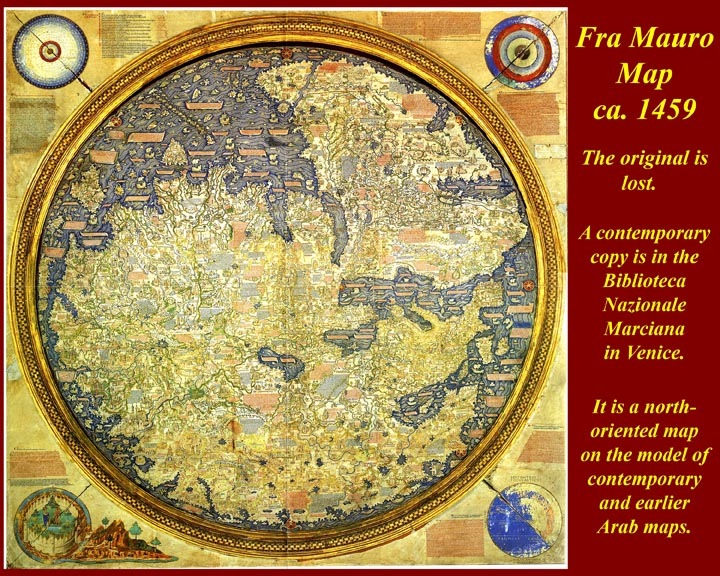
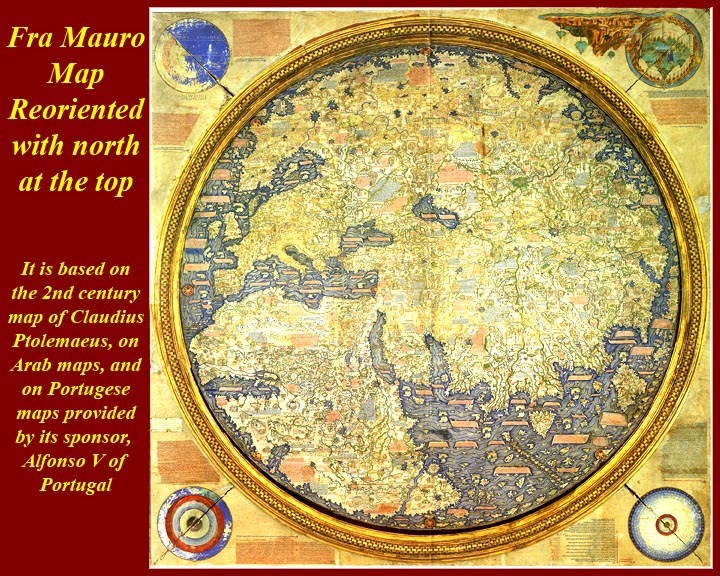
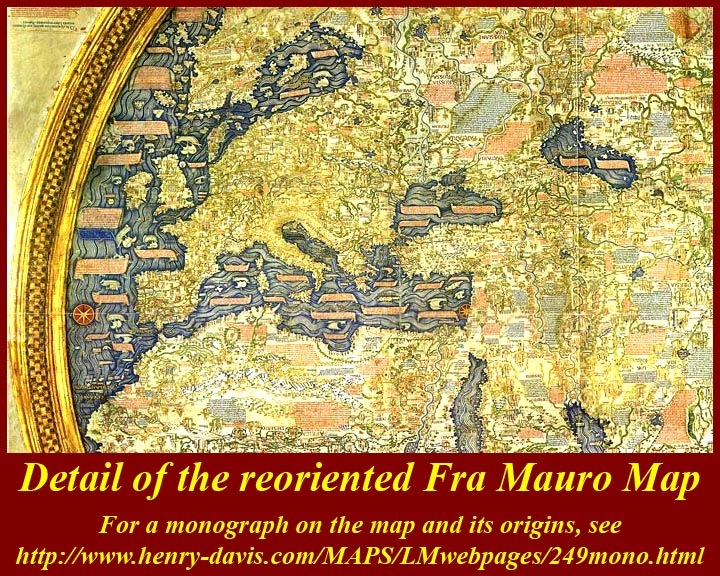
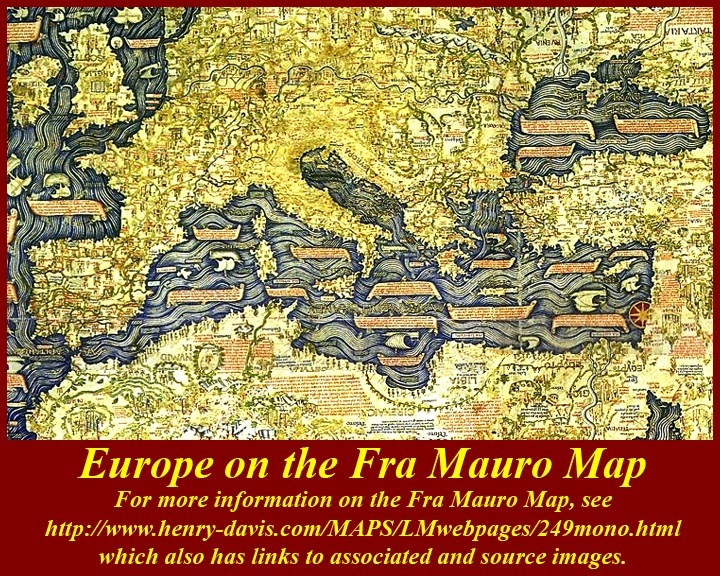
http://www.mmdtkw.org/RenRom0100a-FraMauroDetailedMap.jpg
http://www.mmdtkw.org/RenRom0100b-FraMauroDetailedMap180.jpg
http://www.mmdtkw.org/RenRom0100c-FraMauroPartOfMap.jpg
http://www.mmdtkw.org/RenRom0100d-FraMauroEurope.jpg
The map drawn by Fra Mauro in 1449 reflected the accumulated knowledge of Europe and the Middle East about the world. The map was commissioned by Alfonso V of Portugal, but the copy that was sent to him is lost. Fra Mauro was making a second copy when he died, and it was completed by his students. That copy, found in his monastery on Murano Island and now displayed in the Biblioteca Nazionale Marciana in Venice, is shown here. It is based on the 2nd century AD Ptolemy map, which was circulating in Europe in Latin translation since 1406, on Arab maps and on Portuguese exploration maps and Journals supplied by Alfonso. Although in many ways it is more accurate than the Ptolemy map, the Fra Mauro map was not widely circulated -- the less accurate Ptolemy became the standard when it was widely circulated twenty years after the Fra Mauro map was completed. A monograph about the Fra Mauro map, with links to images, is at http://www.henry-davis.com/MAPS/LMwebpages/249mono.html.
http://www.mmdtkw.org/RenRom0101-TradeRoutes.jpg
Medieval Trade Routes already connected the major centers of European commerce at the start of the Renaissance. The centers of commerce were also the centers of knowledge, and many had universities and learned monasteries. The curricula of medieval universities were based on Benedictine scholasticism, and any change was vigorously opposed. Only after the Black Death emptied out the universities (1347-50) did the new humanistic scholars have a chance to flourish.
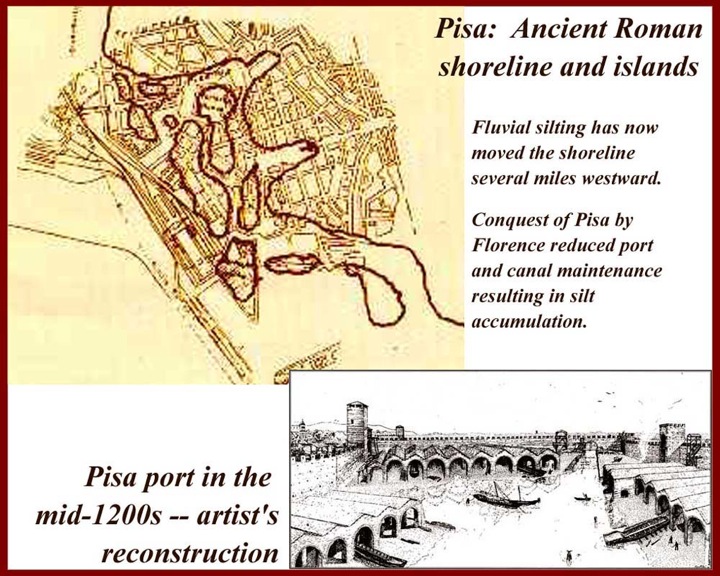
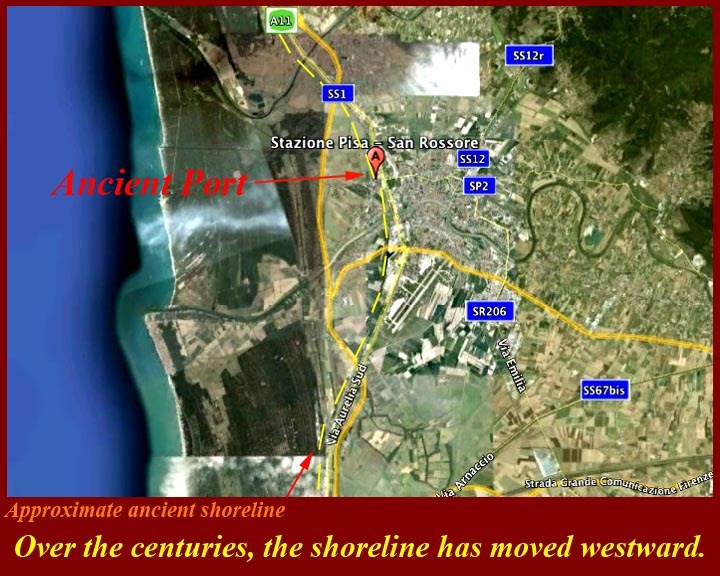
http://www.mmdtkw.org/RenRom0102-PisaShoreline.jpg
http://www.mmdtkw.org/RenRom0102a-AncientPisaShore.jpg
http://www.mmdtkw.org/RenRom0102b-AncientPisaShips.jpg
The ancient Pisa trading port has been found during construction of the Pisa San Rossore railway station. Numerous ships, which apparently were capsized during periodic tsunami occurrences have been excavated. The Pisa port was one of several ports that connected Italy to the rest of Europe during the medieval period. It is also, supposedly, the port through which the plague passed on its way to northern European ports in 1348.
http://www.mmdtkw.org/RenRom0103-BankingTrade.jpg
Medieval Banking was was the all-important grease for the wheels of commerce. The Medici family originally may have had some connection with medicine (doctoring? or pharmacy?
The little red balls on their coat of arms are said to be pills -- see http://en.wikipedia.org/wiki/File:Coat_of_Arms_of_Medici.svg). But they soon got into the banking trade. Members of the Medici family entered the Florentine banking business in the latter 1300s. In 1393 Giovanni di Bicci de’ Medici (1360–1429) took ownership of the Roman branch of a bank owned by one of his Florentine cousins. He moved the headquarters of this bank to Florence in 1397, the official founding date for the Medici Bank. At the time Rome was a source of funds, whereas Florence offered a better market for making loans. A notable contribution to the profession of accounting was the improvement of the general ledger system through the development of double-entry bookkeeping for tracking credits and debits. This system was first used by accountants working for the Medici family in Florence.
http://www.mmdtkw.org/RenRom0104-Mercato.jpg
Street Markets occupied the piazze in front of large medieval churches. The same kind of markets occupy the same spaces today.
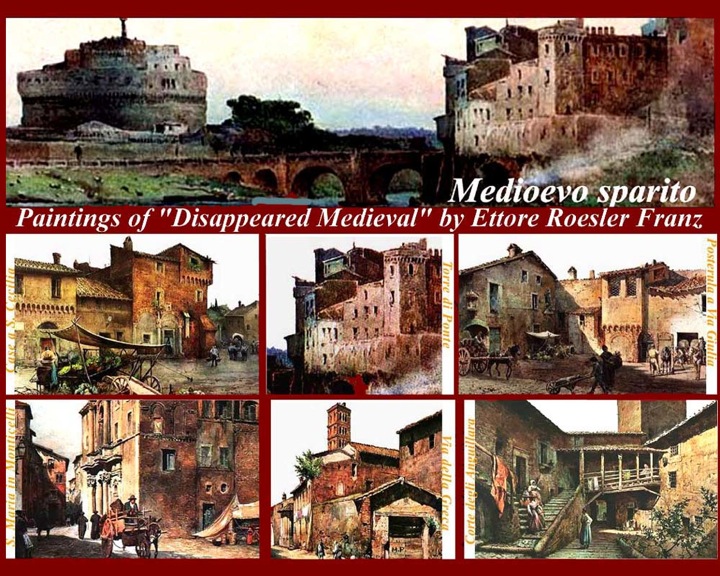
http://www.mmdtkw.org/RenRom0106-MedioevoSparita.jpg
Medieval Rome Disappearing -- Medioevo Sparita. Ettore Roesler France, a 19th century Roman painter produced a series of 120 aquerelles named "Roma sparita" (disappeared Rome), where he portrayed with great realism parts of the city which he supposed were going to be destroyed in the effort to modernize it. These paintings are now at the Museo di Roma in Palazzo Braschi (at the southwest corner of Piazza Navona facing Corso Vittorio Emanuele II).
(a)
(b)
(c)
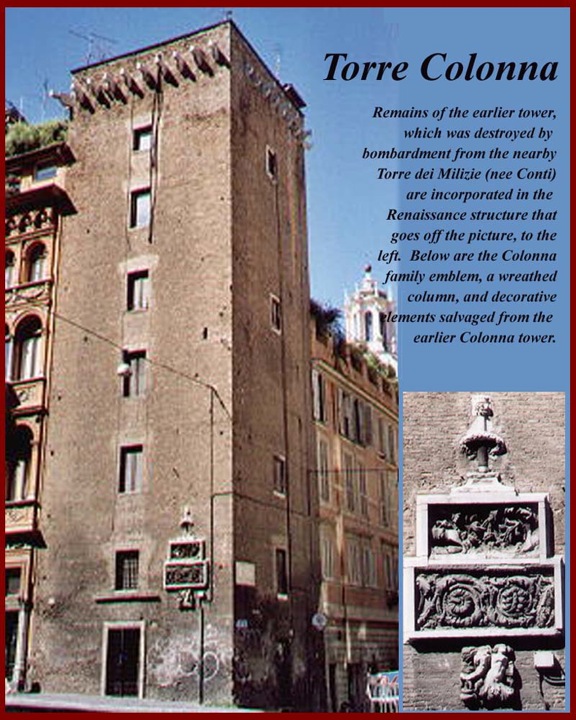
http://www.mmdtkw.org/RenRom0106a-MarcelloOrsini4.jpg
http://www.mmdtkw.org/RenRom0106b-TorreMilizie.jpg
http://www.mmdtkw.org/RenRom0106c-Colonna.jpg
The big Roman medieval families either took over existing ancient buildings and fortified them or they built their own fortified towers. Ownership/occupation of the ancient Theater of Marcellus, built by Augustus, passed through several families and finally ended up in the hands of the Orsini. The Conti family apparently had two massive towers at opposite ends of the Ancient Roman imperial forums, the massive Torre Millizie and the Torre Conti. The Colonna tower near the Torre Millizie was an attempt by the Colonna to "tower over" the Conti. Torre Colonna was knocked down in a battle with the Conti, but was rebuilt, and the Colonna still live in their nearby Palazzo. (a) Fortifications in the Theater of Marcellus, (b) Conti fortifications -- Torre Millizie, (c) Colonna fortifications -- Torre Colonna(a)
(b)
(c)
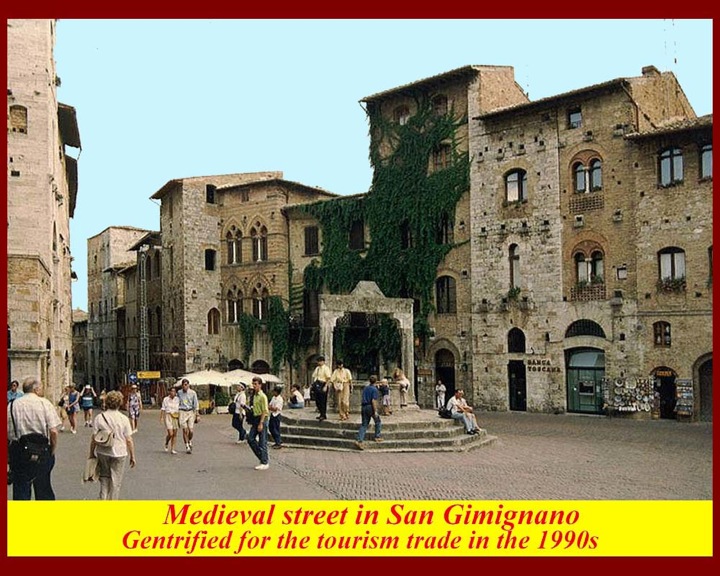
http://www.mmdtkw.org/RenRom0107-MedievalTowers.jpg
http://www.mmdtkw.org/RenRom0107a-MedievalTowers.jpg
http://www.mmdtkw.org/RenRom0107b-SanGimignano.jpg
Towering over your neighbors could be quite important both for prestige and for defense. There are still many medieval towers on Rome, but most are obscured by later and grander renaissance structures. A few towns were bypassed by the renaissance (at least architecturally) and their towers still stand above surrounding structure. The most visited of these "tower towns" today is San Gimignano, which is now taken over by trendy boutiques, artists (and pretenders), and Italian and foreign yuppies. The medieval buildings still line the central piazza, but most have been redone into upscale condominiums. (a) San Gimignano towers, (b)"towering over" in San Gimignano, (c) San Gimignano gentrified again
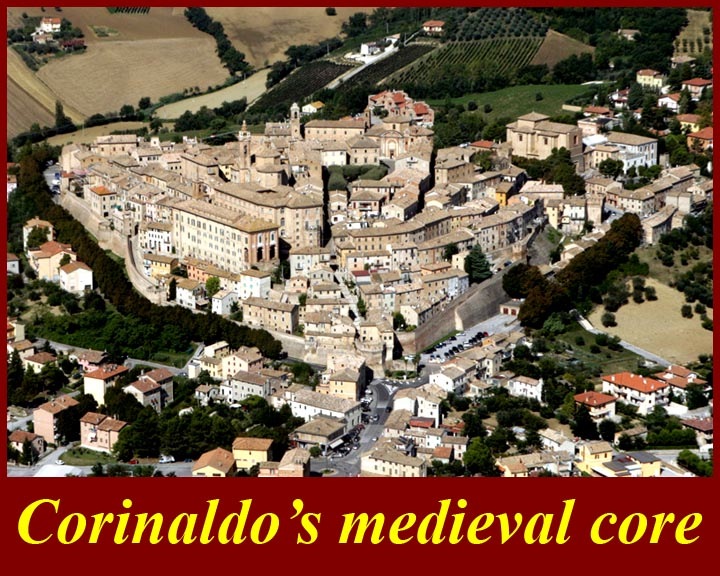
http://www.mmdtkw.org/RenRom0108b-Corinaldo.jpg
http://www.mmdtkw.org/RenRom0108c-CarpenetoManor.jpg
Some towns stood on fortified hilltops like the medieval core of Corinaldo. The successor to the isolated Ancient Roman rural villa was the fortified Medieval manor house. "Manorialism" with serfs tied to the land virtually disappeared with the arrival of the high death tolls associated with the plagues that swept through Italy after 1347. Manorialism required solidarity among the "signore", the rich owners of the land. When urban populations were wiped out by plague, many serfs ran off to cities to replace them leaving fewer of them to work the land. The "signore" then started to actively poach their neighbors' serfs, and soon a rural wage-labor market developed. Signorial solidarity was irretrievably broken.
The new arrivals in the cities, by the way, were not universally welcomed -- urban artisan and tradesmen "confraternities" developed at least partially to keep the new arrivals from easily competing with the already established trades. The new arrivals might not be as skilled as the established workers, but they sometimes were able to produce cheaper (if inferior) products and were often willing to offer their services more cheaply. (Does this sound familiar?)
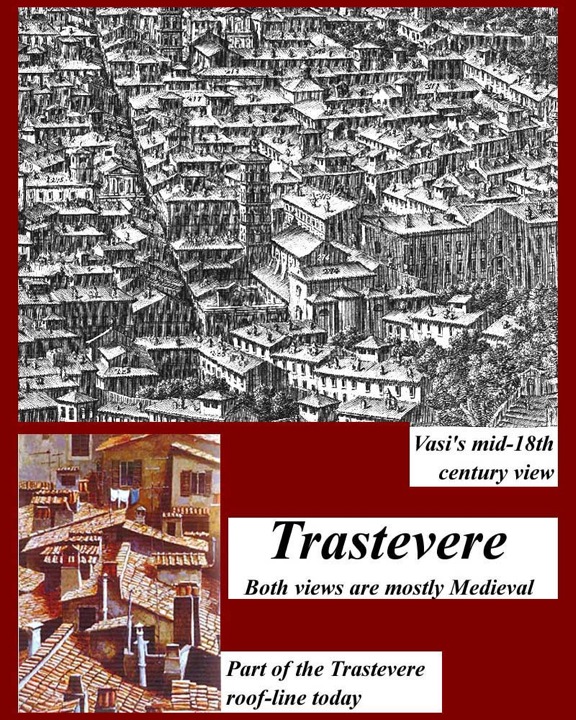
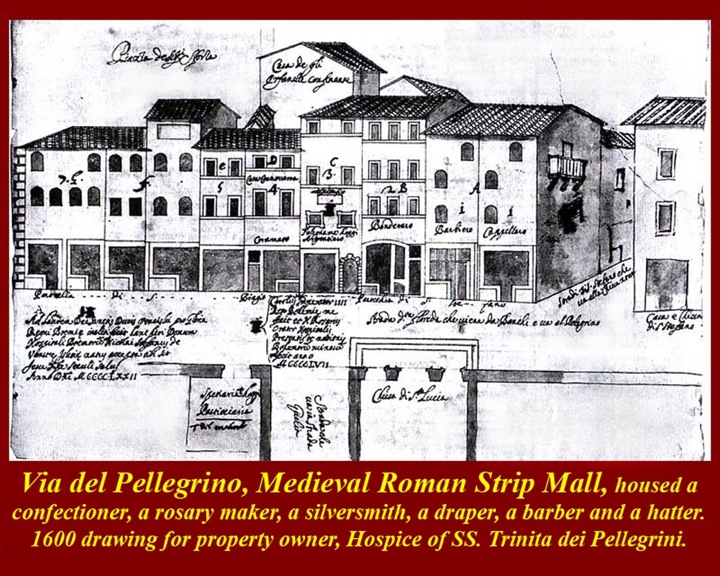
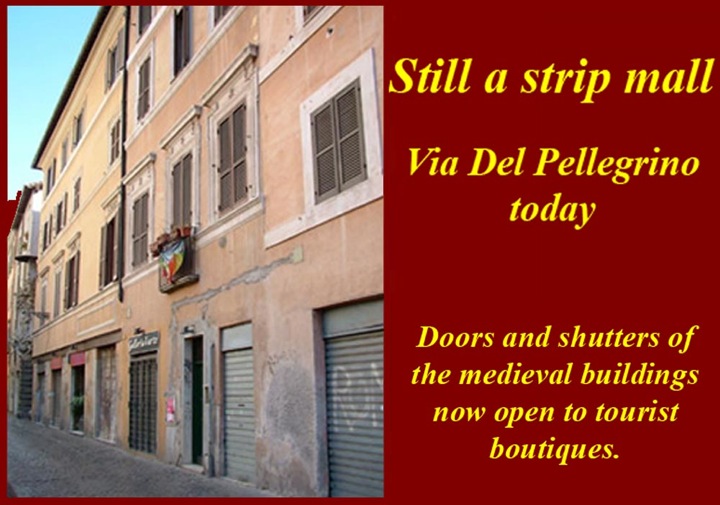
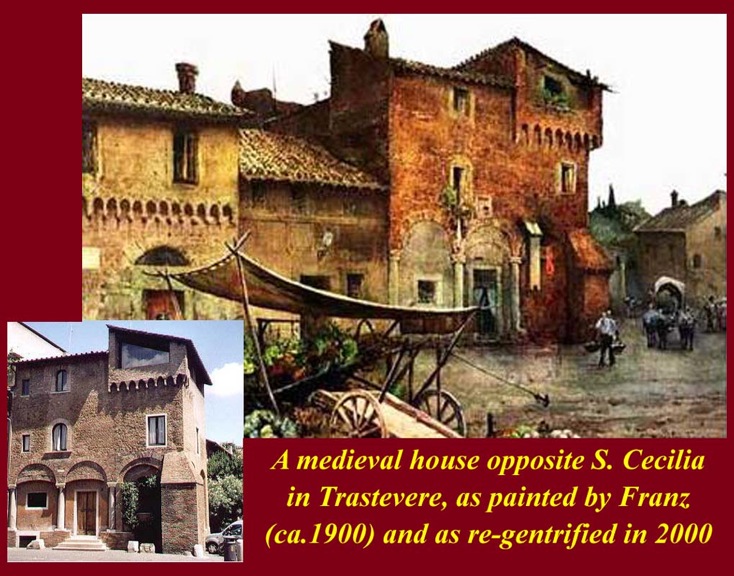
http://www.mmdtkw.org/RenRom0110-MedievTrastevere.jpg
http://www.mmdtkw.org/RenRom0112a-ViaDelPellegrino.jpg
http://www.mmdtkw.org/RenRom0112b-ViaDelPellegrinoToday.jpg
http://www.mmdtkw.org/RenRom0112c-CaseSCecilia.jpg
Medieval Trastevere. Trastevere (= trans-Tiber, across the river from the "historical center" of Rome) was always a place where outsiders dwelled. It was outside of the ancient city's pomerium or sacred boundaries -- a place for non-citizens and for those who didn't worship Rome's gods. It was the place, for example, where ancient Rome's Jews and Christians and Mithraists and Isis worshipers (like Cleopatra) could be expected to reside. It was also a place where an emperor or his wife might have a river-side hideaway. The district became crowded in Medieval times, and most of it escaped urban renewal during the renaissance -- except, of course, those riverside imperial hideaways which were replaced by renaissance hideaways. Medieval Trastevere is still there today, although many of its buildings are being renovated as high-priced condominiums like the houses opposite the church of Santa Cecilia shown in the fourth image above.
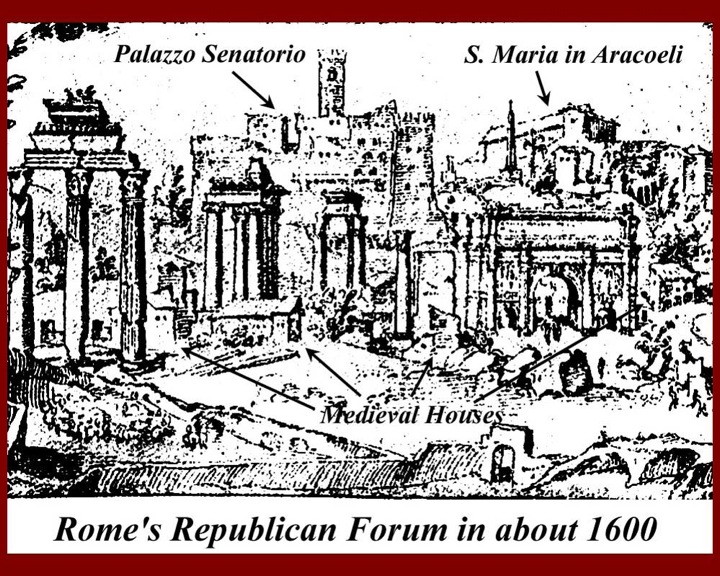
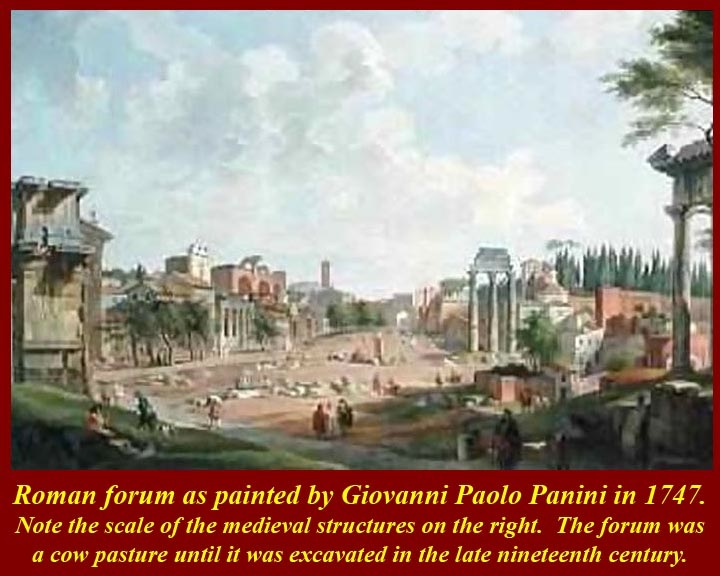
http://www.mmdtkw.org/RenRom0111-ForoMedHouses.jpg
http://www.mmdtkw.org/RenRom0111b-ForumPanini1747.jpg
http://www.mmdtkw.org/RenRom0111a-ArchSeptimiusSeverus.jpg
Medieval Houses in the Republican Forum. The Roman republican forum became a pestilential quagmire after the eastern Roman emperors stole the metal clamps that held together the cloaca maxima, the sewer that had drained the area since the times of the Etruscan kings that had ruled Rome even before it became a republic. By the time of the renaissance the streams leading down from Rome's hills had silted up the forum to the point that it could be used as a campo vaccino or cow pasture. A few medieval structures were built along one edge, and the Arch of Septimius Severus, only the top half of which was exposed, became a fortified home of a local capo. The forum escaped the attentions of renaissance builders except for several churches build around its fringes and except for its use as a mine for ancient Roman marble -- the base of the ancient bronze statue of Marcus Aurelius that Michelangelo put up in the center of Piazza Campidoglio was once part of the steps leading up to the temple of Castor and Pollux. The forum, in fact, wasn't really excavated until the 19th century. Carlo Fea began his work around the Severus arch in 1803, and, later in the century, Rudolfo Lanciani formed a core of distinguished late nineteenth-century scholars of the Roman forum including Henri Jordan, Christian Huelsen, Samuel Ball Platner, and Thomas Ashby. Excavations in the republican forum continued into the 20th century, and in the adjacent imperial forums excavations are still under way.
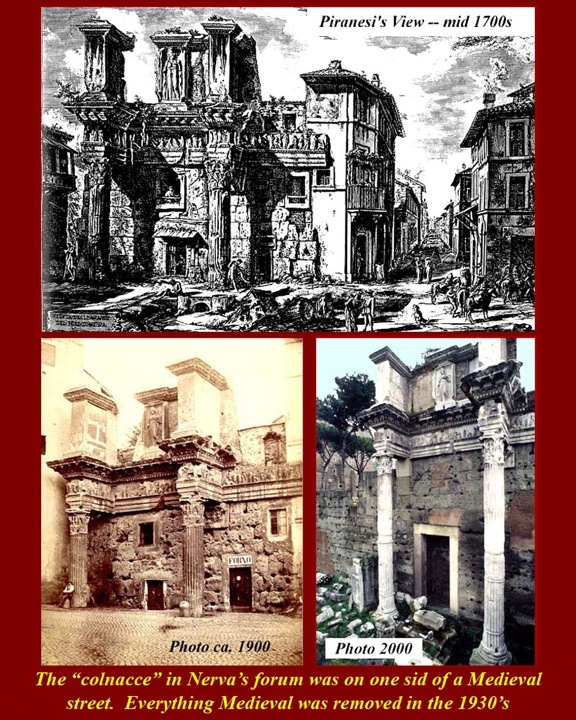
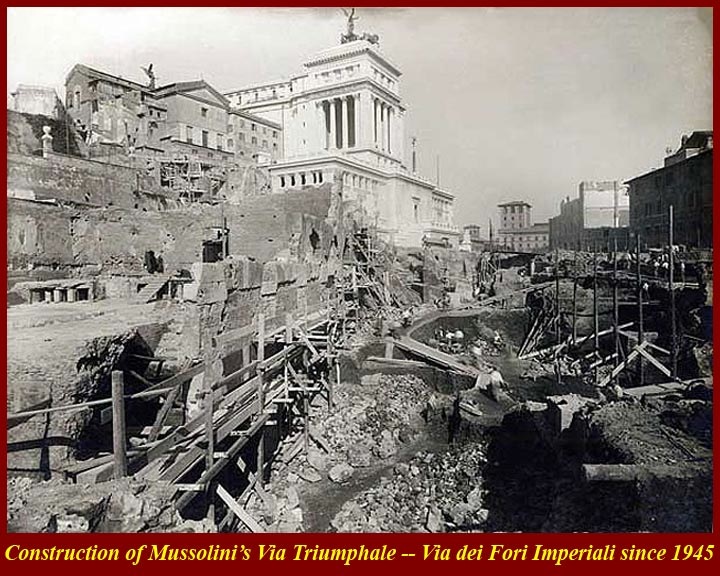
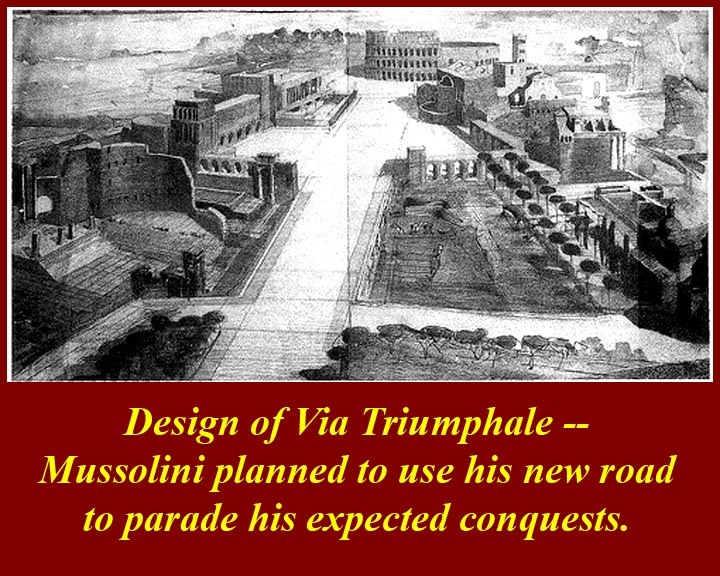
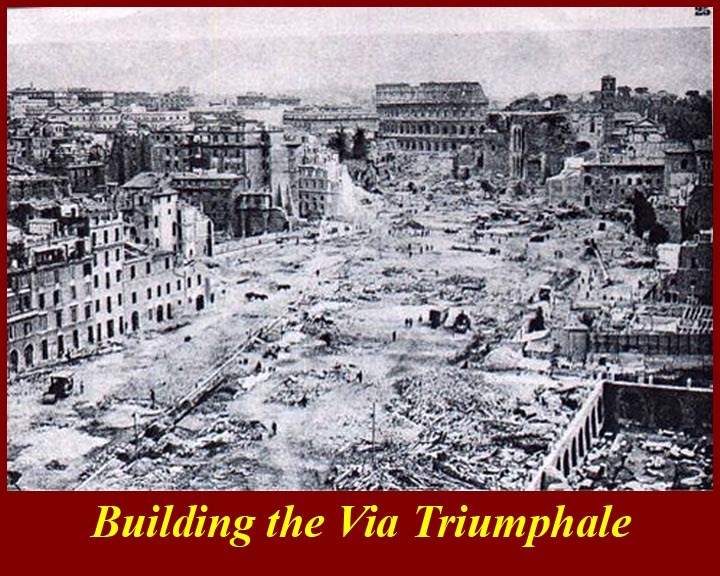
http://www.mmdtkw.org/RenRom0112-ColnacceMedView.jpg
http://www.mmdtkw.org/RenRom0112-ColnacceViaForiImperiali-a.jpg
http://www.mmdtkw.org/RenRom0112-ColnacceViaForiImperiali-b.jpg
http://www.mmdtkw.org/RenRom0112-ColnacceViaForiImperiali-c.jpg
http://www.mmdtkw.org/RenRom0112-ColnacceViaForiImperiali-d.jpg
Medieval street behind the Colnacce. The Colnacce is part of the wall that Trajan built around his Forum of Peace. A road into the forum ran in front of Trajan's forum. Commodus built a narrow forum called the Forum Transitorium in the space occupied by the road, but that forum was ascribed to Nerva after Commodus was assassinated and subjected to damnatio memoriae. (Damnatio memoriae is the Latin phrase literally meaning "damnation of memory" in the sense of removal from remembrance. It was a form of dishonor that could be passed by the Roman Senate upon traitors or others who brought discredit to the Roman State.)Constructed between 1931 and 1933, the Via dei Fori Imperiali (originally Mussolini's Via Triumphale) was one of the most controversial of all the urban reconstructions carried out at the time. The opening of this road wiped out one of the most extraordinary zones of the city where various strata of Renaissance and medieval buildings lay above the ruins of the ancient forums.
In creating this street that links the Colosseum with Piazza Venezia, the loss of monuments and churches was not given any weight. At the same time, the road ruined a plan, going back to 1800, to create a great archeological park embracing the area of the forums, the Circus Maximus and Via Appia Antica. The excavations of recent years on both sides of the Via dei Fori Imperiali have uncovered many ruins but many monuments remain buried under the street. The city council of Rome decided in 1980 to remove the road in order to complete the excavations of the imperial forums, but, in the Italian fashion, that work has not yet been started.
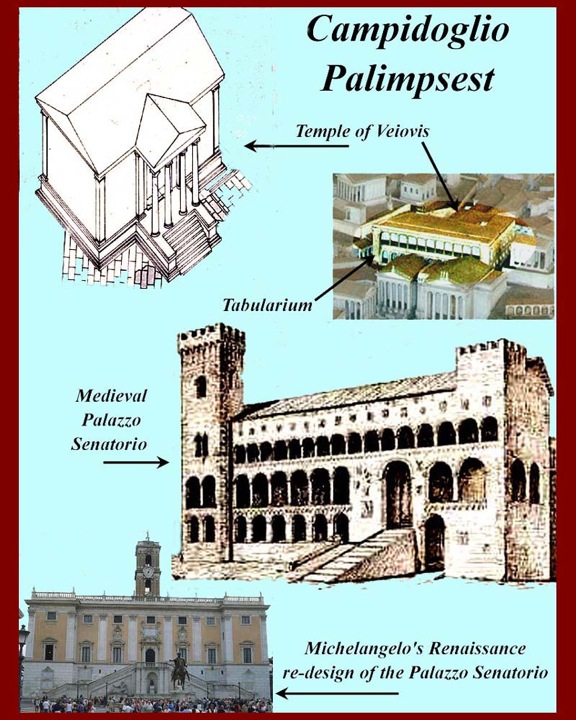
http://www.mmdtkw.org/RenRom0113-Campidoglio.jpg
http://www.mmdtkw.org/RenRom0113a-AerialCampidogli.jpg
Rome's Capitoline hill, Campidoglio in Italian, is an architectural palimpsest. A pre-Roman temple of Veiovis is overlaid with the ancient Roman Tabularium (archives) and with a medieval fortress-house which was remodeled by Michelangelo. Michelangelo's building at the back of his Piazza Campidoglio (with the bell tower) now houses the ceremonial rooms of Rome's municipal government. His other two buildings on the Piazza house the Capitoline Museums. The layers under the municipal building are accessible to visitors. Entry is through the museums.
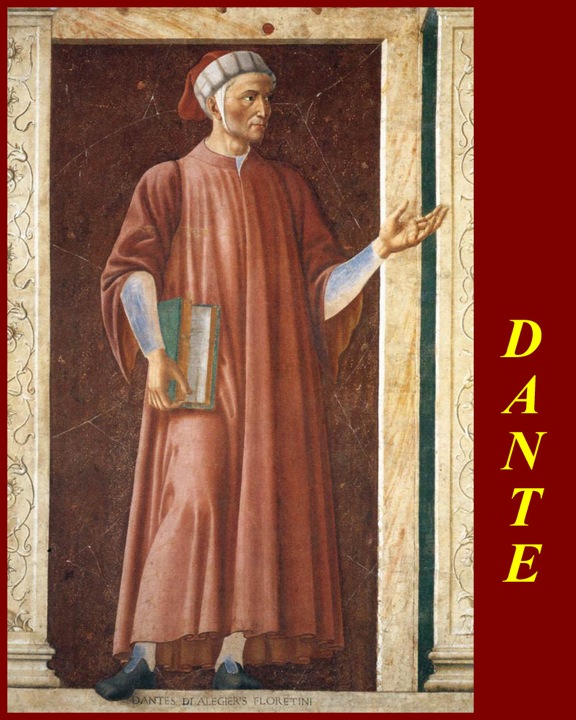
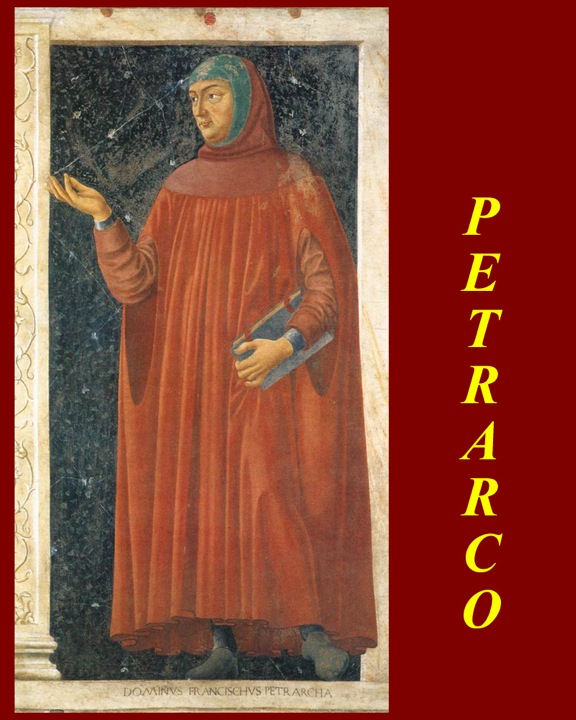
http://www.mmdtkw.org/RenRom0114-Dante.jpg
http://www.mmdtkw.org/RenRom0115-Petrarch.jpg
http://www.mmdtkw.org/RenRom0116-Boccaccio.jpg
Dante Allighieri, Francesco Petrarch, and Giovanni, three giants of Italian Renaissance literature. They were initially castigated by humanist Latinists for their Italian vernacular writings, which the Latinists claimed had degraded classical Ciceronian Latin, but they are now celebrated as the fathers of the modern Italian language. All three images are frescoes from the nine part Il ciclo degli uomini e donne illustri (= cycle of famous men and women) painted by Andrea del Castagno (Andrea di Bartolo di Bargilla, ca. 1421/23 - 1457) around 1455 for the Villa Carducci di Legnaia or Villa Carducci-Pandolfini, Florence, Italy. The frescoes are now in the Uffizi Museum in Florence (but not on public display) and replicas are in the Villa. The frescoes were of the three Tuscan Poets, three condottieri and three "famous women" (Queen Esther, Queen Tomyris and the Cumaean Sibyl), and all nine can be seen on the Internet at http://www.paradoxplace.com/Perspectives/Italian%20Images/Montages/Art/Andrea%20del%20Castagno.htm.
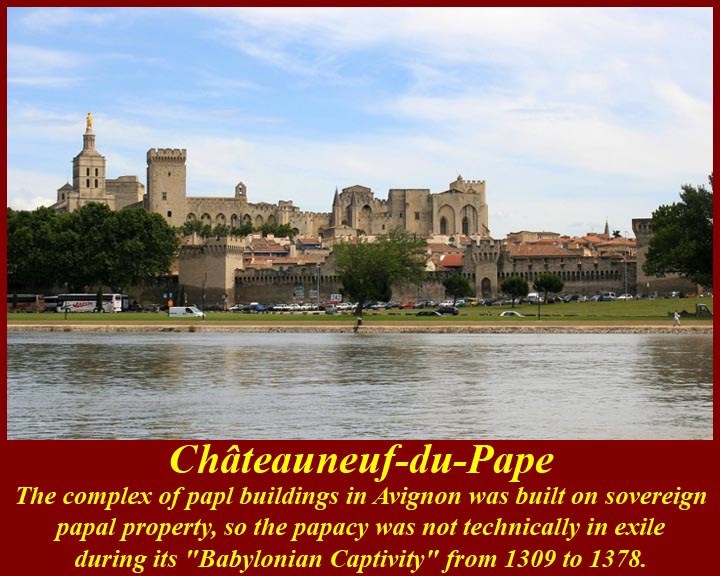
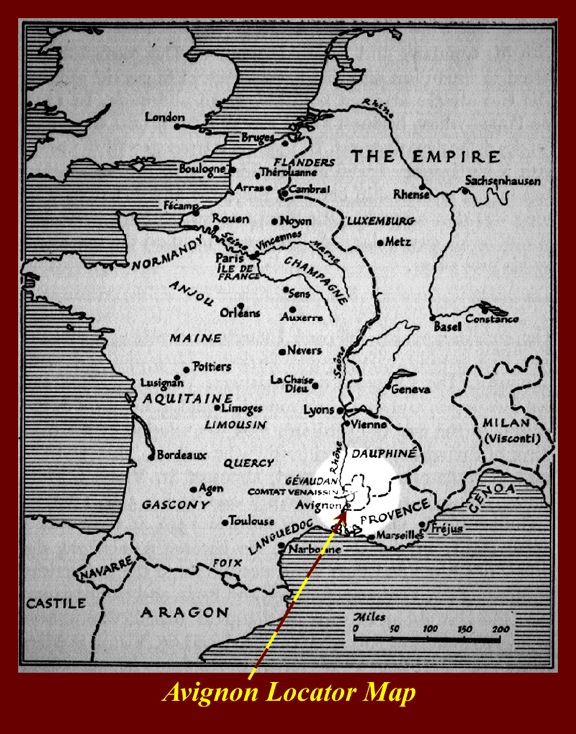
http://www.mmdtkw.org/RenRom0115b-ChateauneufduPape.jpg
http://www.mmdtkw.org/RenRom0115a-AvignonMap.jpg
Châteauneuf du Pape in Avignon, where Petrarch imbibed French Romance, heard the poetry of the 11th to 13th century Provencal Occitan troubadour poets and got the idea for the invention of the sonnet. Petrarch was also an éminence grise behind Cola di Rienzi and was in and out of favor with the Avignon popes sometimes working for them and sometimes trying to achieve the return of the papacy to Rome -- he was a political opportunist. For more on Petrarch, see http://www.lycos.com/info/petrarch--avignon-papacy.html. For more on the troubadour poets, see http://en.wikipedia.org/wiki/Troubadour and http://globegate.utm.edu/french/globegate_mirror/occit.html.
The Avignon Papacy refers to a period in the history of the Roman Catholic Church from 1309 to 1378 when the seat of the Pope was moved from Rome to Avignon. The period has been called the "Babylonian Captivity" (or "Babylonish Captivity") of the Popes (or the Church), particularly by Martin Luther. This nick-name is polemical, in that it refers to the claim by critics that the fabulous prosperity of the church at this time was accompanied by a profound compromise of the Papacy's spiritual integrity, especially in the alleged subordination of the powers of the Church to the ambitions of the Frankish emperor. Coincidentally, the "captivity" of the popes at Avignon lasted around the same duration as the exile of the Jews in Babylon, making the analogy all the more convenient and rhetorically potent.
Seven popes resided in Avignon:
Pope Clement V - 1305-1314
Pope John XXII - 1316-1334
Pope Benedict XII - 1334-1342
Pope Clement VI - 1342-1352
Pope Innocent VI - 1352-1362
Pope Urban V - 1362-1370
Pope Gregory XI - 1370-1378
In 1378 the seat was moved back to Rome, while a disputing party continued to honor the bishop in Avignon as the head of the church. From 1378 to 1414 was a time of difficulty which Catholic scholars refer to as the "Papal Schism" or, "the great controversy of the antipopes" (also called the Second Great Schism by some secular and Protestant historians), when parties within the Catholic Church were divided in their allegiances among the various claimants to the office of Pope. The Council of Constance, which convened in 1414, finally resolved the controversy, dismantling the last vestiges of the Avignon Papacy and brought the Great Schism to an end in 1417.
(From http://faculty.ucc.edu/egh-damerow/avignon_papacy.htm. This article is licensed under the GNU Free Documentation License -- http://www.gnu.org/copyleft/fdl.html.)
For more on the Avignon Papacy, see http://www.newadvent.org/cathen/02158a.htm.
Precursor artists:
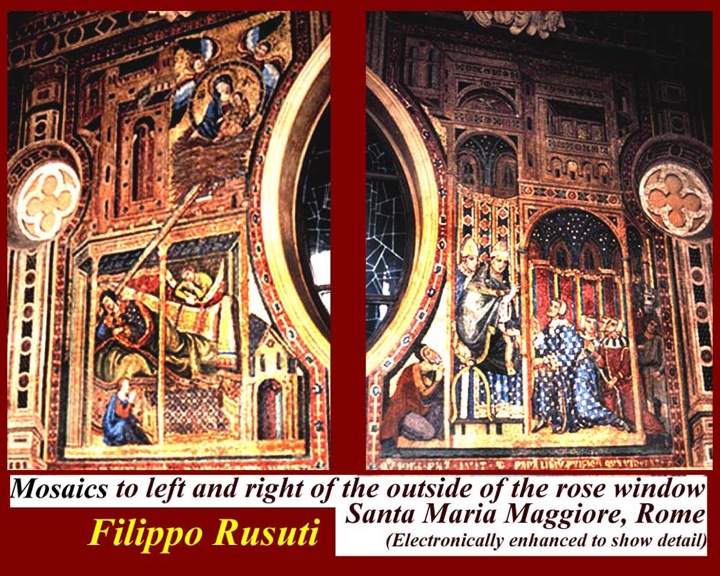
http://www.mmdtkw.org/RenRom0117-RusutiMMaggiore2.jpg
http://www.mmdtkw.org/RenRom0118-MariaMaggioreEvo.jpg
The Filippo Rusuti (ca. 1297-1317) Mosaics are now hidden on the back wall of the Baroque Logia of Santa Maria Maggiore in Rome but they were originally fully visible on the front façade of the building. Mosaics, it should be noted, were the higher class form of art of the medieval as well as ancient Roman periods; frescoes, although longer lasting because they were more durable, were considered to be inferior substitutes for more expensive mosaic art. Rusuti's only certain work is the mosaic on the façade of S Maria Maggiore, Rome, which is signed. He served as 'King's painter' in France during the reigns of Philip IV and Louis IX, receiving payments in 1304/5, 1308 (for repairs in the Grande Salle of the royal palace at Poitiers), 1309, 1316 and 1317, but none of this work survives. His use of perspective is notable, and he, like Pietro Cavallini, preceded Goitto.
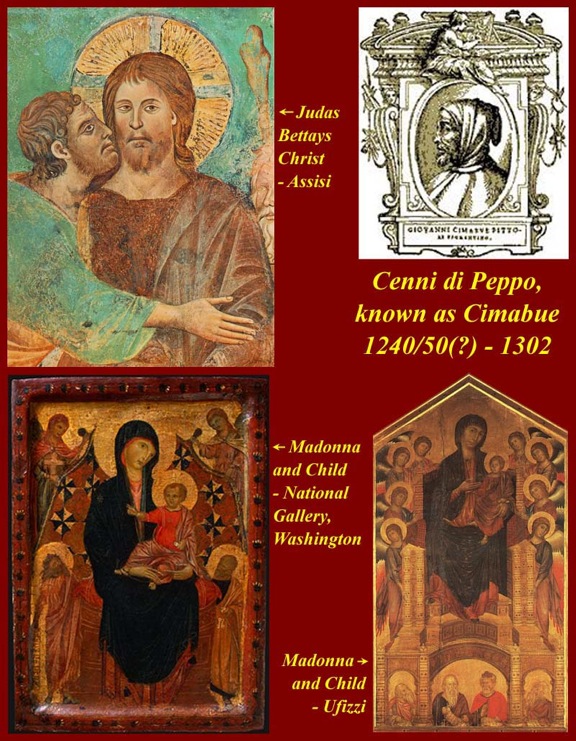
http://www.mmdtkw.org/RenRom0119-Cimabue.jpg
http://www.mmdtkw.org/RenRom0119a-CimabueArezzoCrucifixion.jpg
Cimabue: Cenni di Pepo (Giovanni) Cimabue (ca. 1240 — c. 1302) also known as Bencivieni di Pepo or in modern Italian, Benvenuto di Giuseppe, was an Italian painter and creator of mosaics from Florence. He is also well known for his student Giotto, considered the first great artist of the Italian Renaissance. Cimabue is generally regarded as the last great Italian painter working in the Byzantine tradition. The art of this period comprised scenes and forms that appeared relatively flat and highly stylized. Cimabue was a pioneer in the move towards naturalism, as his figures were depicted with rather more life-like proportions and shading. His 448 × 390 cm Crucifixion of Christ, tempera on wood painted in 1287-88 in chiesa di San Domenico in Arezzo, Italy, is especially striking; the face of Christ could have been done by Picasso. For more images of Cimabue's Crucifixion, including one of the face before the work's recent cleaning restoration, see http://commons.wikimedia.org/wiki/Category:Crucifix_by_Cimabue_(Arezzo).
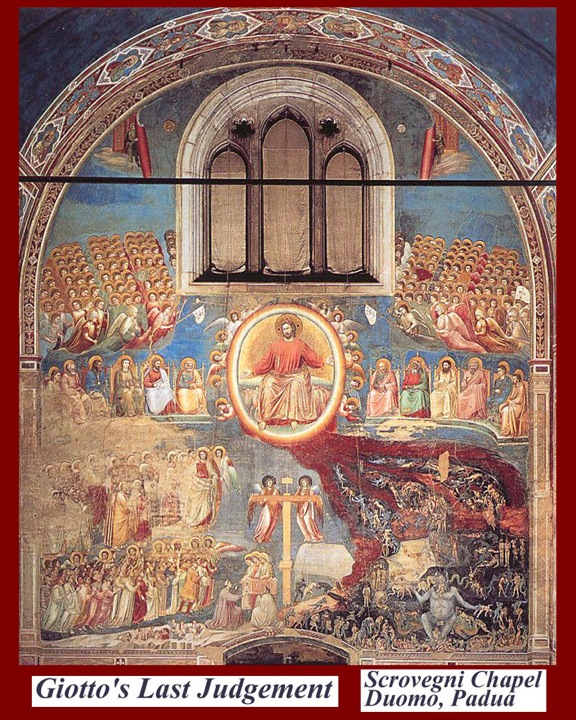
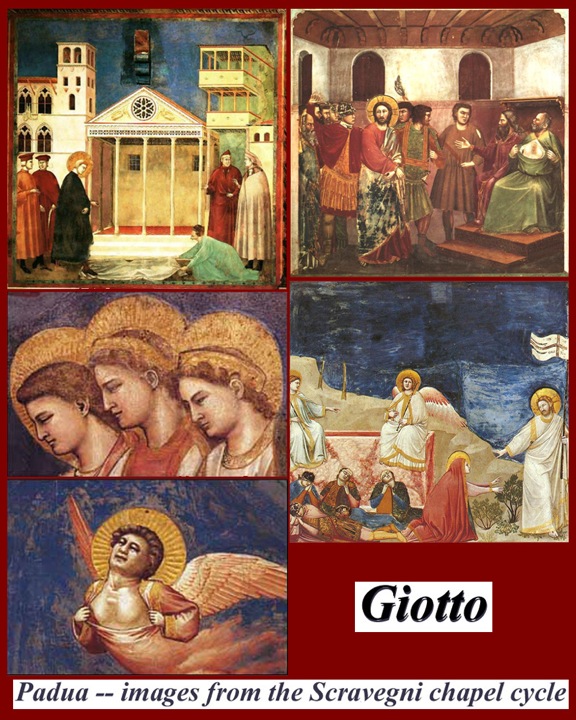
http://www.mmdtkw.org/RenRom0120-GiottoJudgement.jpg
http://www.mmdtkw.org/RenRom0120a-GiottoScravegn.jpg
http://www.mmdtkw.org/RenRom0121-Cavallini.jpg
Giotto's Last Judgment and the Scravegni Chapel fresco cycle, Scravegni Chapel in the Padua Duomo and Cavallini's earlier works in Santa Maria in Trastevere church in Rome. Giotto also worked in Santa Maria in Trastevere church in Rome where he would have seen works already installed by Pietro Cavallini. For more information on Giotto di Bondone and on the question of whether some of the works ascribed to him in Assisi were actually done by Pietro Cavalinni, see http://www.mmdtkw.org/VGiotto.html.
Other Late medieval influences
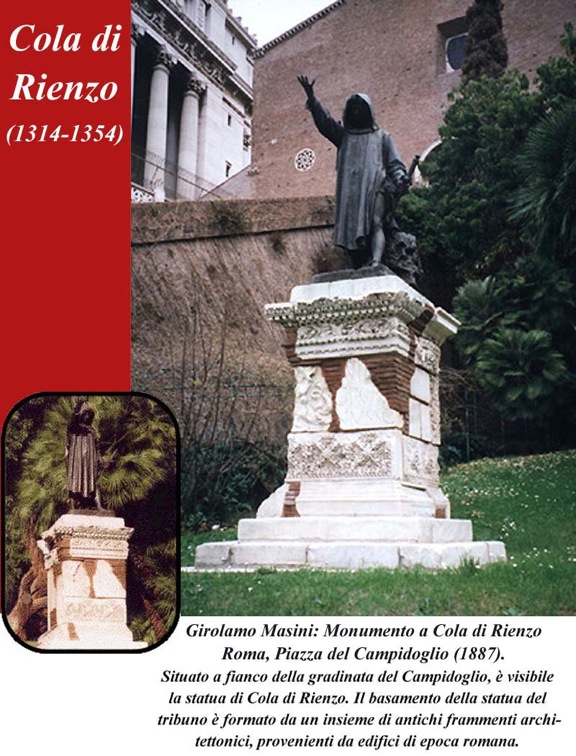
http://www.mmdtkw.org/RenRom0122-ColaDiRienzo.jpg
http://www.mmdtkw.org/RenRom0123-Hunt'sRienzi.jpg
Cola di Rienzo (1314 - 1354) was a man of the Trastevere lower classes with a fixation on ancient Rome. According to his and Petrarch's propaganda, Rienzi's younger brother was an innocent bystander who was slain in a skirmish between Colonna and Orsini thugs in Rome. He then declared war on all of Rome's nobility. He was probably manipulated by agents of the Avignon popes including, most importantly, Petrarch. For much more on Rienzi, see http://www.mmdtkw.org/VRienzi.html.
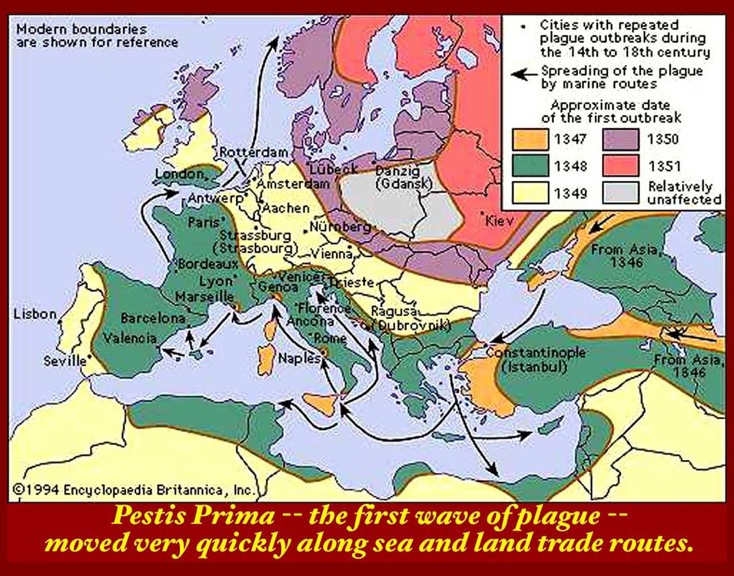
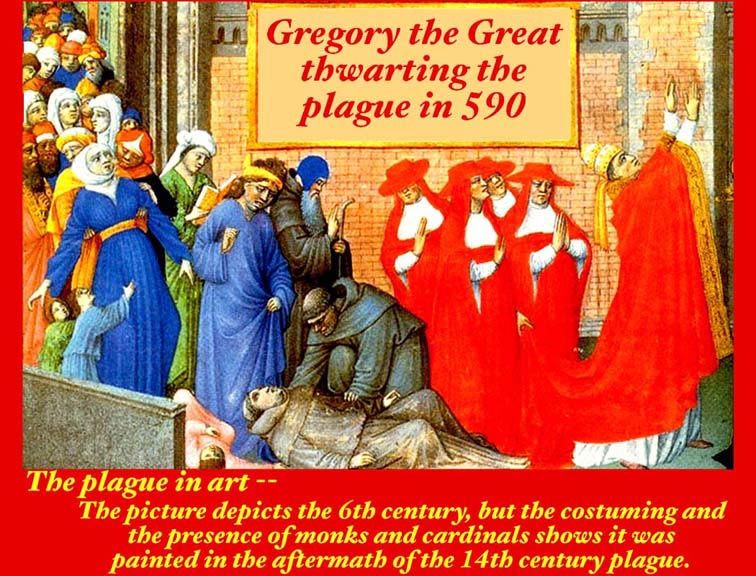
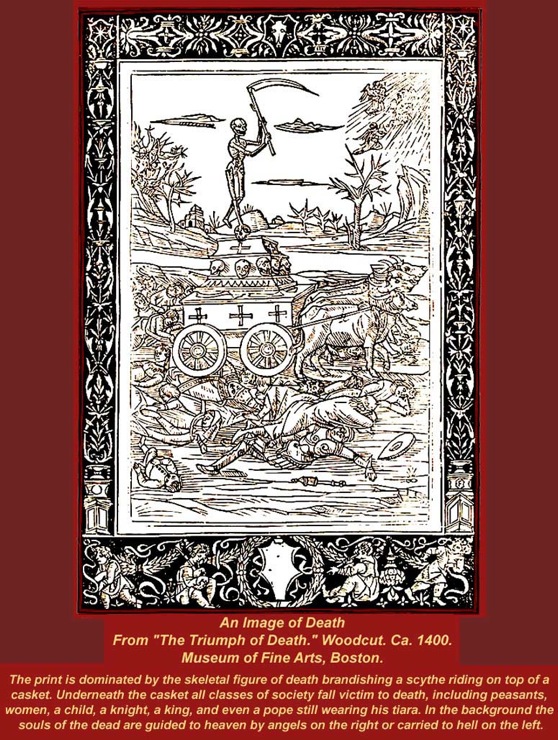
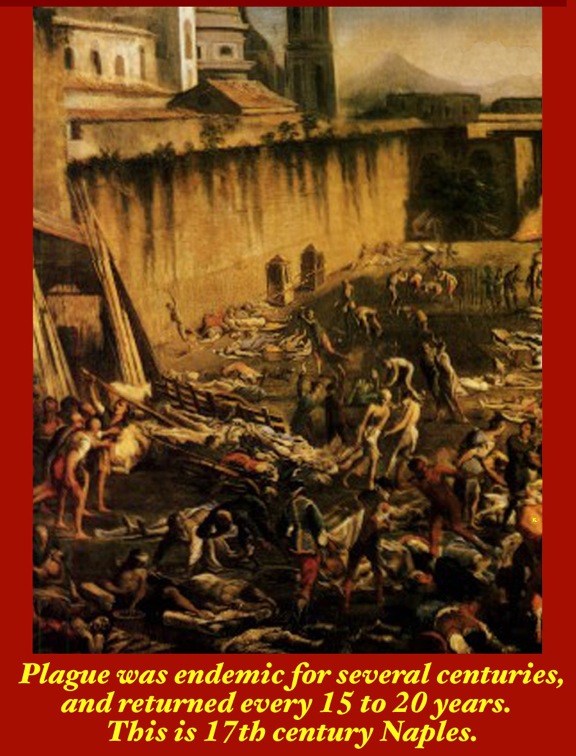
http://www.mmdtkw.org/RenRom0124-PlagueMap.jpg
http://www.mmdtkw.org/RenRom0125-PlagueGreg.jpg
http://www.mmdtkw.org/RenRom0126-Death.jpg
http://www.mmdtkw.org/RenRom0127-Naples17CPlague.jpeg
http://www.mmdtkw.org/RenRom0127a-EuropePopulationPlague.jpg
Plague map - 1347 and following years
Gregory I stops the 590 AD plague -- ca. 1400 picture
Classless death
Plague recycles every few generations
Black Plague deaths in Europe
For much more information on the plague, see
http://en.wikipedia.org/wiki/Black_Death.
Guelphs and Ghibellines
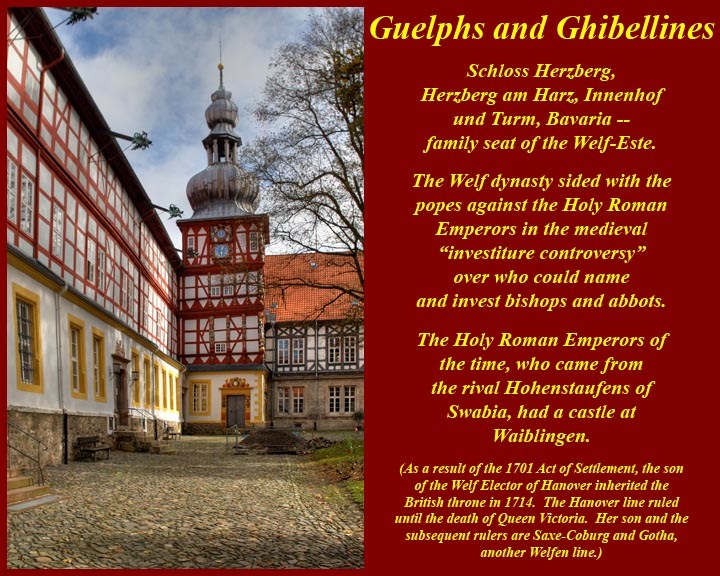
http://www.mmdtkw.org/RenRom0128a-GuelphsGhibellines1.jpg
http://www.mmdtkw.org/RenRom0128b-GuelphsGhibellines2.jpg
In the late medieval period a dispute (called the "investiture controversy" by modern historians) arose when the popes insisted that they had the right to choose and invest bishops and abbots. In earlier times, such profitable offices were the gift of local kings and lords, and, of course, were filled by their favorites rather than those of the popes. A lot of money was involved both in the sale of the offices and in the exercise of the offices. The Hohenstaufen family family were supplying the incumbent Holy Roman Emperors, and they would be the most injured if the popes got to name bishops and abbots.
The Hohenstaufen had their headquarters in a Waiblingen castle (in southwest Germany in the center of the Stuttgart region). The Welf families were the other major force in the Holy Roman Empire -- themselves having ambitions to take over the imperial throne -- and they hoped to diminish the power of the Hohenstaufens by supporting the Popes in the investiture controversy. The Welf had their seat in Herzberg am Harz, Bavaria, in central Germany. A number of major battles were fought between the Hohenstaufen and the Welf, during which the opposing sides used "Welf" and "Waiblingen" as their battle cries. Those two battle cries became Guelph and Ghibelline when families allied to the two German families imported the dispute into northern Italy.
In fact, by the end of the medieval period, the investiture controversy had ceased to be central to the fighting between Guelph and Ghibelline factions in Italy -- "Guelphs" and "Ghibellines" were merely the names of fluid groupings of families struggling for local power. In Florence, the Ghibelline factions were defeated and killed or driven out. No matter. The Guelphs quickly split into "Black" and "White" Guelphs and the struggles for dominance continued.
[As a result of the Act of Settlement passed in 1701 by the British Parliament, the Hanover line of the Welf family inherited the British throne in 1714. The Hanover line ruled until the death of Queen Victoria. Her son Albert Edward, later King Edward VII, and his successors are considered to be from the Welf Saxe-Coburg and Gotha line of their father, Prince Albert. For more on the 1701 Act of Settlement, see http://www.royal.gov.uk/HistoryoftheMonarchy/HistoryoftheMonarchy.aspx.]
http://www.mmdtkw.org/RenRom0129-MarcPolo.jpg
We started with the preexisting European trade routes, but interest in trade with the East was one of the main drivers of the Renaissance and particularly with the Renaissance as expressed around the Mediterranean. The travels Marco Polo (ca. 1254 – January 8, 1324) and his best selling travel book, called, not very imaginatively, The Travels of Marco Polo, were what captured everyone's imagination. For a short bio of Polo, see http://en.wikipedia.org/wiki/Marco_Polo and for a description of his book, see http://en.wikipedia.org/wiki/The_Travels_of_Marco_Polo. Volume I of thee book is available free on line at http://www.gutenberg.org/etext/10636, and Volume II is at http://www.gutenberg.org/etext/12410.
Florence and Rome -- Unit 2
http://www.mmdtkw.org/RenRomUnit02RomeFlorence.html
Rinascimento or Instauratio: where to focus?
Disunited Italy. Borders shifted occasionally, but for the most part this was the way the Italian peninsula existed during the middle centuries of the second millennium AD.
Before there was a rinascimento (Renaissance) there was an instauratio (restoration) -- or at least a sentiment toward instauratio. Rinascimento was a Florentine invention -- Giorgio Vasari coined the usage. Instauratio was first of all a Roman concept that originally referred to the desire to return the popes, who were resident in Avignon, to their chair in Rome. A corollary of that return was the reaffirmation of their authority, power, and perquisites. The papal party and its allies, of course, would define it all, and it, naturally, included the dignities of the Roman emperors as well as those of the early popes. Just as importantly, it was necessary to restore the grandeur of Rome -- arts, architecture, literature, sciences -- which would make the popes' restoration both possible and comfortable.Topics for Unit 2
Rome at the beginning of the Instauratio / Renaissance as described by Gibbon---------------------------------------Rulers of Rome -- succession of actual authority
Renaissance in Florence -- circumstances that led to an early start
The Medici as a unifying force
Vasari as an artist and, more importantly, as a biographer
Forces limit an early start in Rome
Avignon and the "Petrarchian" impetus
Rival Roman families -- Orsini and Colonna -- Guelphs and Ghibellines
Great Western Schism
Rinascimento v. instauratio
Unifications: Orsini and Colonna (Julius II in 1611 and Sixtus V in the 1580s patch things up in the city) -- Medici popes (Florence in Rome)
Internet Links for Unit 2:
Avignon
http://www.newadvent.org/cathen/02158a.htm
Gibbon, Decline and Fall
http://www.worldwideschool.org/library/books/hst/roman/TheDeclineandFallofTheRomanEmpire-1/toc.htmlGiorgio Vasari
http://www.newadvent.org/cathen/15274a.htm
http://www.artcyclopedia.com/artists/vasari_giorgio.html
http://www.kirjasto.sci.fi/gvasari.htmTwisted History
http://www.fordham.edu/halsall/basis/goldenlegend/ -- Golden Legend Voragine
http://www.newadvent.org/cathen/08002a.htm -- Infessura
Guelf and Ghibelline
http://en.wikipedia.org/wiki/Guelphs_and_Ghibellines
http://www.newadvent.org/cathen/07056c.htm
Medici
http://italian.about.com/library/weekly/aa091599a.htm -- Medici arms
http://es.rice.edu/ES/humsoc/Galileo/People/medici.html -- Medici family
http://www.romeartlover.it/Vasi188.html -- Villa Medici
http://www.metmuseum.org/toah/hd/frac/hd_frac.htm -- French Academy in RomeNotable Colonna and Orsini
http://en.wikipedia.org/wiki/Colonna_family and http://www.newadvent.org/cathen/04125c.htm
http://en.wikipedia.org/wiki/Orsini_family and http://www.newadvent.org/cathen/11325b.htm
Great or Western Schism
http://www.newadvent.org/cathen/13539a.htm-- a Catholic version
http://www.bible.ca/history/philip-schaff/6_ch02.htm -- a Protestant assessment
http://en.wikipedia.org/wiki/Western_Schism
Renaissance Rome
Unit 2 Slides
Florence and Rome
Click on small images or links to see larger images.
http://www.mmdtkw.org/RenRom0201-ItalyMap.jpg
Map: Division of the Italian Peninsula during the Renaissance
What was wrong with Rome? Or put another way, why didn't the Renaissance start there instead of in Florence?
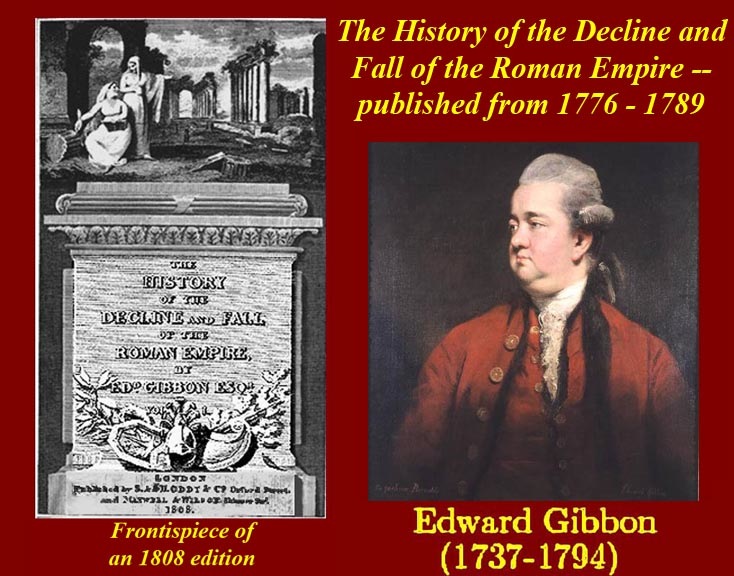
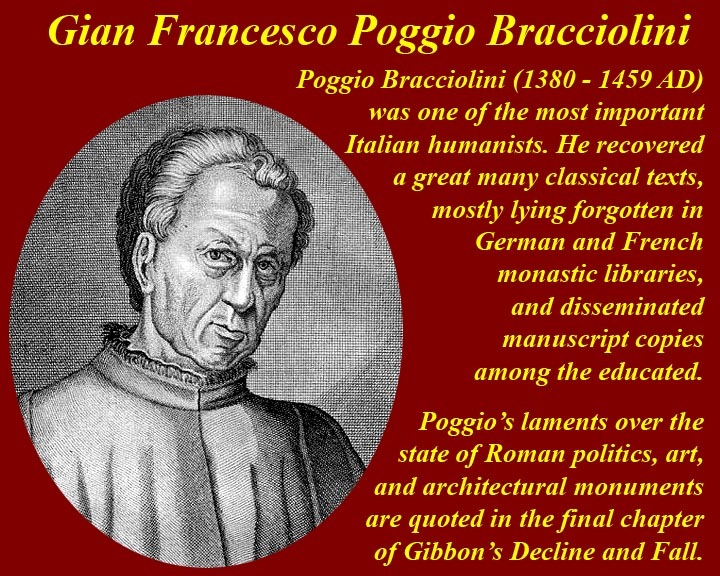
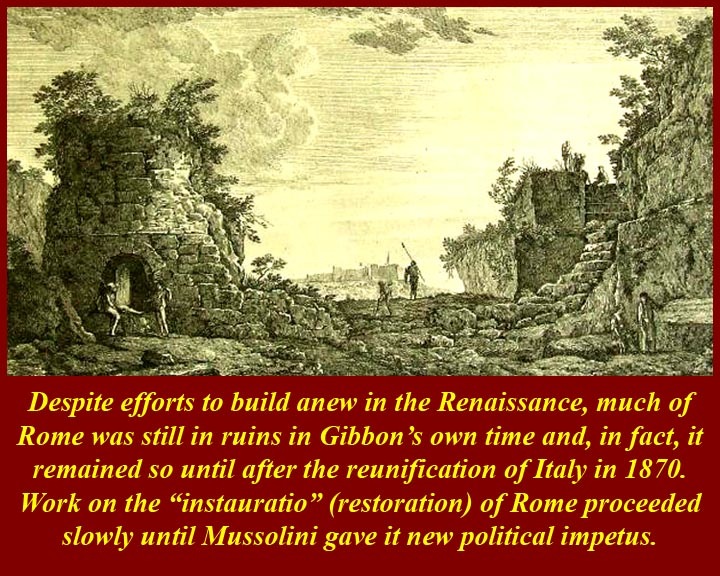
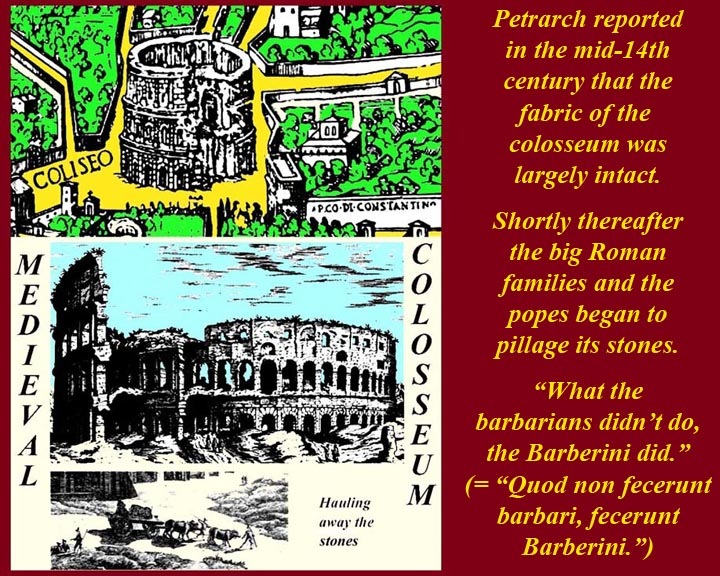
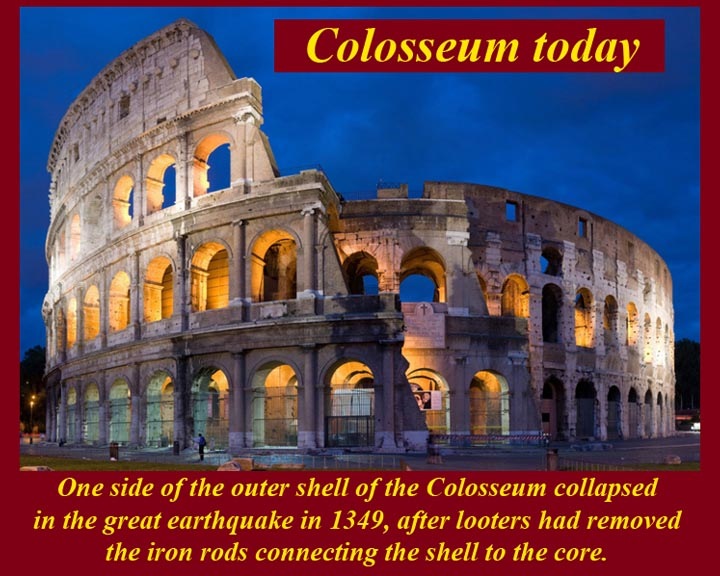
http://mmdtkw.org/RenRom0201a-Gibbon.jpg
http://mmdtkw.org/RenRom0201b-PoggioBracciolini.jpeg
http://mmdtkw.org/RenRom0201c-RomeRuins1700s.jpg
http://mmdtkw.org/RenRom0201d-Colosseum.jpg
http://mmdtkw.org/RenRom0201d-ColosseumCollapse.jpg
Gibbon, in the last (LXXI) chapter of his "Decline and Fall" (1776 - 1789), quoted Poggio Bacciolini extensively on the ruination of Rome. Poggio, who lived at the end of the 14th and beginning of the 15th centuries, had written many letters, some of which were available to Gibbon. Poggio complained (loosely translated) that the Capitoline temple was overthrown, its gold pillaged, its sacred ground disfigured by thorns and brambles. The triumphal route was obliterated by vines and the Senators' benches concealed by a dunghill (i.e., the cloaca maxima had collapsed after the Byzantines had stolen the metal staples that held it together). The Palatine hill was strewn with shapeless and enormous fragments. The other hills were vacant space interrupted by ruins and gardens. The Forum was fenced for cultivation of pot herbs and open for the reception of swine and bufalo. Public and private edifices, which had been built for eternity, lie prostrate , naked, and broken like the limbs of a mighty giant, and the ruin is more visible from the stupendous relics that have survived the injuries of time and fortune.
Gibbon gave four reasons for the ruinous state of the city:
1) injuries of time and nature -- no work force to effect repairs after weathering and earth tremors.
2) hostile attacks of Barbarians and Christians.
3) use and abuse of building materials.
4) domestic quarrels of Romans.
Gibbon said that with the restoration of a unified Papacy resident in Rome (after 1420) the clouds of barbarism were gradually dispelled -- the peaceful authority of Pope Martin V restored the ornaments of the city and the "order of the ecclesiastical state."
But what didn't work was the "natural root" (i.e., productive hinterland) of a great city. The greater part of the Campagna was reduced to a dreary and desolate wilderness; overgrown princely and clerical estates cultivated by the lazy hands of indigent and hopeless vassals; scanty harvests benefiting monopolies.
Monarchical court revenues -- even New World moneys -- were squandered by Popes and "nephews". But the "squandering" was in rebuilding churches, palaces, etc. (especially the new St. Peters Church); replacement of ancient ornamentation with new or "re-placed" art; restoring aqueducts or building new ones (as Pope Sixtus V had done).
Who Ruled Rome during the chaotic "dark ages"?
Power had shifted from the imperial bureaucracy to the Barbarian monarchs and finally to the Popes (through claims derived from the fraudulent "Donation of Constantine". But, in the final stages, the Popes lost major chunks of Italy and even eventually lost temporal power in Rome itself. "Families" took over and fought each other. The Popes had to seek "protection" from the French, after which they were taken to "safety" in Avignon (1309-1377).
While the Popes were in Avignon rapid changeovers took place:
The Colonna family (http://en.wikipedia.org/wiki/Colonna_family) fought incessantly with the Orsini (http://en.wikipedia.org/wiki/Orsini_family), and in one of their skirmishes a young man, the brother of Cola di Rienzi was killed. This led Rienzi to organize the people (1347) -- the equivalent of the ancient Roman mob -- against all of the "noble" families. He was temporarily successful, until the "families" brought in their rural supporters. Rienzi fled and eventually ended up in Germany where a local prince arrested him and packed him off to Avignon where he was held. A change in Avignonese attitude (and popes) led to the release of Rienzi -- under the influence of Petrarch -- and he was sent back to Rome (1354). The idea was that he would again undermine the "families" and raise the influence of the Popes. Rienzi, however, by his own excesses (including bathing in the baptismal basin at St. John Lateran), lost the support of the populace (the Roman mob). He was again threatened by the "families", and when he range the bell at the "Palazzo Senatorio" to assemble his popular supporters, they failed to show up. He was quickly dispatched with a sword thrust. The families were again in power, but they weakened themselves by infighting. (For more on this whole sordid mess, see http://www.ccel.org/g/gibbon/decline/volume2/chap70.htm, which is Chapter LXX if Gibbon's Decline and Fall.)
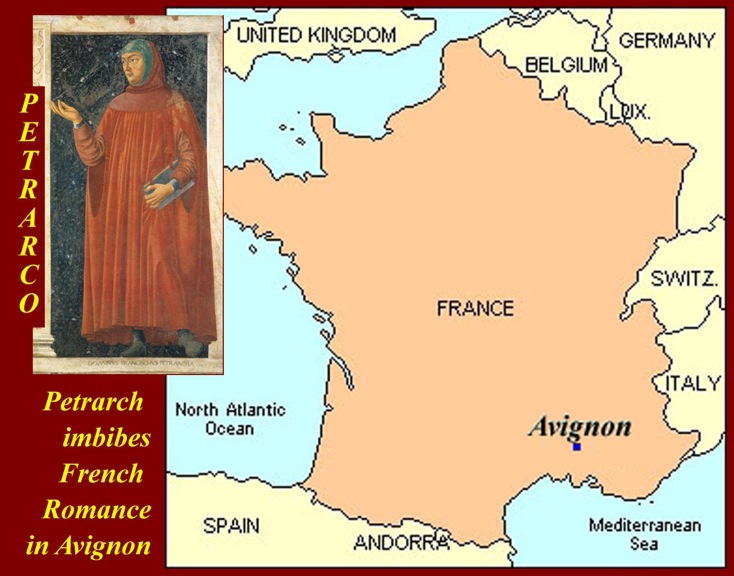
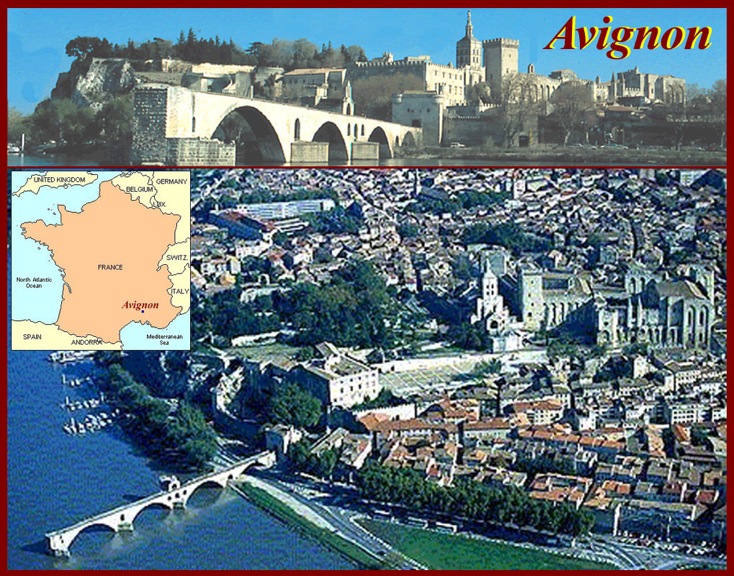
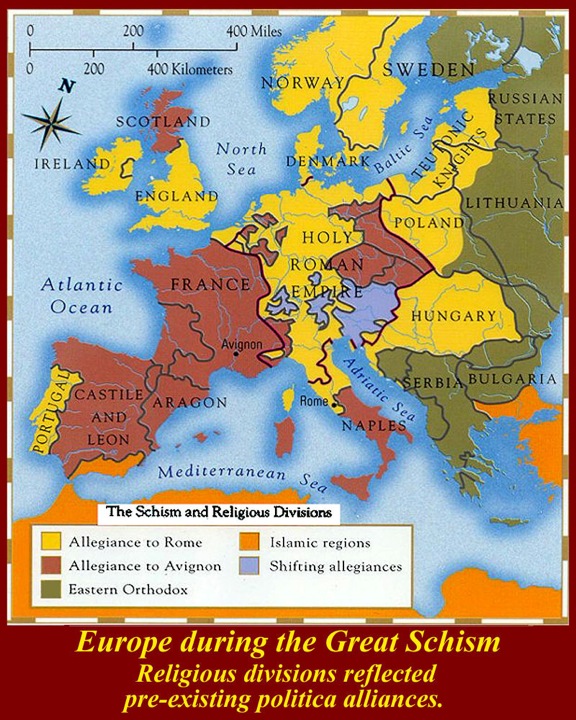
http://www.mmdtkw.org/RenRom0201e-PetrarchAvignon.jpg
http://www.mmdtkw.org/RenRom0201f-Avignon.jpg
http://www.mmdtkw.org/RenRom0201g-SchismMap.jpg
http://www.mmdtkw.org/RenRom0201h-TwoPopes.jpg
Francesco Petrarca (July 20, 1304 – July 19, 1374), known in English as Petrarch, was an Italian scholar, poet and one of the earliest Renaissance humanists. Petrarch is sometimes called the "Father of Humanism". His sonnets were admired and imitated throughout Europe during the Renaissance and became a model for lyrical poetry. Petrarch was also known for being one of the first people to refer to the Dark Ages. He was one of the first since ancient times to collect books, manuscripts, and coins, and has been called “the first tourist" for his love of travel.
Petrarch's writings reflect a more worldly spirit than that of the Middle Ages. Marked by technical perfection and formal polish, his poems about his beloved Laura are classics of the Italian language. Laura was married woman who has never been positively identified, but who may have been the wife of Count Hugues de Sade. Petrarch's Italian language lyrics to Laura, in the troubadour tradition of courtly (i.e., unrequited) love, which he imbibed in Avignon, were collected as the Canzoniere (Songbook). They advanced the growth of Italian as a literary language and popularized the form of the sonnet that is called the Petrarchan sonnet. Many years after Laura's death in 1348, Petrarch wrote Trionfi, a religious allegory in which she was idealized. Most of Petrarch's other writings were in Latin.
Petrarch wrote mainly in Latin, which he hoped to restore to classical purity. Cicero, Virgil, and Seneca were his literary models. Among his works were books of history, biography, and moral philosophy; a dialogue with Saint Augustine; and volumes of letters. After being crowned in Rome as poet laureate (1341) for his Latin epic, Africa, he was honored throughout Italy. Giovanni Boccaccio turned to scholarship under Petrarch's influence. Although Petrarch wrote poems in praise of a free Italy, he accepted the patronage of the Visconti, tyrants of Milan, from 1353 to 1362 and also spent some time in the Avignon papal court. He supported the aspirations of Cola di Rienzi, but he also may have been Rienzi's mentor/controller for the Avignon Popes.
The Great Western Christianity or Papal Schism (also known as the Western Schism) (http://en.wikipedia.org/wiki/Western_Schism) was a split within the Roman Catholic Church from 1378 to 1417, and it followed immediately after the Avignon "captivity", during which the Popes decamped from Rome and took up French protection. After the "official" (i.e., Roman version ) end of the Avignon period there were two simultaneous claimants to the Papacy. Driven by politics rather than any real theological disagreement, the schism was ended by the Council of Constance (1414–1418). The simultaneous claims to the papal chair of two different men -- and for a short time three -- hurt the reputation of the office.
Meanwhile, the first wave of the "Black Plague" swept through Italy (1347-49) wiping out at least thirty percent of the population. (See http://www.historyguide.org/ancient/lecture29b.html and Boccaccio's description of the plague in "The Introduction of the Author" to his Decameron at http://www.brown.edu/Departments/Italian_Studies/dweb/florio/day01.shtml. The strength of this particular iteration of bubonic/pneumonic/enteric plague resulted, in large part, from the fact that all of Europe was already suffering from famine caused by the end of the Medieval warm period. See also this graphic (http://www.mmdtkw.org/MedRom1000MedievalWarming.jpg) from the Medieval Rome course:
The Popes, of course, eventually came back to Rome, but not without problems. A new "Roman" pope was elected, leading to "The Great Western Schism", about which more will be said later. For now, it needs only to be said that many authors start their accounts of the Renaissance in Rome with the end of the Great Western Schism (ca. 1417) and/or the beginning of "The Second Era of the Papal States" (ca. 1431).
Why was Florence ready for an artistic Renaissance?
http://www.mmdtkw.org/RenRom0202-Florence.jpg
Florence today from across the Arno. The simple answer to Florentine readiness was money and especially money concentrated in one family, the Medici. Unlike in Rome, where the many "families" wasted their resources fighting against each other, there really was only one dominant family in Florence. Other families in Florence had political power aspirations, but they were never strong enough to permanently oust the Medici -- even when they were aided by outsiders like the Popes and the French..
http://www.mmdtkw.org/RenRom0202a-MediciArms.jpg
Medici Arms -- the six little red balls are said to represent pills which some unknown "medicus" (a doctor) would have prescribed. Medici origins are obscure, so it's not known whether there was a real eponymous Medici doctor who made the seed money for the family. What is known is that the Medici were successful late medieval wool traders and that the Medici family was connected to most other elite families of the time through strategic marriages, partnerships, or employment, as a result of which the Medici family had a position of centrality in the social network: several families had systematic access to the rest of the elite families only through the Medici, perhaps similar to banking relationships. This has been suggested as a reason for the rise of the Medici family. For a short summary of the Medici family, see http://en.wikipedia.org/wiki/House_of_Medici.
Some Illustrius Medici:
http://www.mmdtkw.org/RenRom0202ab-GiovanniDiBicciMedici.jpg
Giovani di Bicci, increased the wealth of the family through his creation of the Medici Bank, and became one of the richest men in the city of Florence. Although he never held any political charge, he gained strong popular support for the family through his support for the introduction of a proportional taxing system. Giovani's son Cosimo the Elder took over in 1434 as gran maestro, and the Medici became unofficial heads of state of the Florentine republic.
http://www.mmdtkw.org/RenRom0202b-CosimoVecchio.jpg
Còsimo di Giovanni degli Mèdici (September 27, 1389 – August 1, 1464), was the first of the Medici political dynasty, de facto rulers of Florence during most of the Italian Renaissance. He is most often known as Cosimo "the Elder" ("il Vecchio") or "Cosimo Pater Patriae". This can get a little confusing: Cosimo "the Elder" is not Cosimo I. That title was taken later by the first Medici to become the Grand Duke of Tuscany. At any rate, Cosimo the Elder was exiled in 1433 by a cabal of other Florentine families, who thought he was becoming too powerful. He went to Venice and took his bank with him. Other bankers followed him and the Florentine money market crashed. Within a year he was invited back, and his power was restored.
http://www.mmdtkw.org/RenRom0202c-LorenzoByVasari.jpg
Lorenzo the Magnificent (1449-1492), was more capable of leading and ruling a city; however, he neglected the family banking business, leading to its ultimate ruin. Although not a good banker, Lorenzo was the first of the great Medici patrons of art and architecture -- in fact, that's what broke the bank. To ensure the continuance of his family's success, Lorenzo planned his children's future careers for them. He groomed the headstrong Piero II to follow as his successor in civil leadership; Giovanni (future Pope Leo X) was placed in the church at an early age; and his daughter Maddalena was provided with a sumptuous dowry when she made the politically advantageous marriage to a son of Pope Innocent VIII. When Giuliano, Lorenzo's brother, was assassinated in church on Easter Sunday (the Pazzi plot of 1478, which also aimed to kill Lorenzo), Lorenzo adopted Giuliano's illegitimate son, Giulio de' Medici (1478-1535), the future Pope Clement VII. Unfortunately, all Lorenzo's careful planning fell apart to some degree under the incompetent Piero II, who took over as the head of Florence after Lorenzo's death. Piero was responsible for the expulsion of the Medici from 1494-1512 when the French invaded from the North. For a short period of time, Girolamo Savonarola, a Dominican priest, ran Florence. (see below -- http://www.mmdtkw.org/RenRomUnit0200-0PixList.html#Savonarola.)
http://www.mmdtkw.org/RenRom0202d-Cosimo-OldestWatchPainting.jpg
Cosimo I, Grand Duke of Tuscany, is famous for having a pocket watch. Horologists say that this painting by Maso da San Friano from the mid 1500s is the first appearance of a watch in art.
http://www.mmdtkw.org/RenRom0202e-LeoXRaphael.jpg
Raphael painted the first Medici pope, Leo X (Giovanni, Lorenzo's son, who was Pope from 1513 - 1521), and some unknown artist later added the two Cardinals to his left and right. The one of the left is Giulio de' Medici, the illegitimate son of Lorenzo's brother Giuliano and adopted son of Lorenzo. Giulio became Pope Clement VII after Leo X died. (There was a scant year between Leo and Clement, during which Adrian VI was pope.) Lorenzo, it turned out, had not really been a financial naif -- he directed the Medici fortunes toward the even greater wealth of the Papal states.
http://www.mmdtkw.org/RenRom0202f-LeoX-ClementVII.jpg
Altogether there were four Medici popes. Leo X and Clement VII both had illustrious reigns and transferred the Medici artistic patronage to Rome, which ever after became the apex of Italian Renaissance art and architecture. After their reigns, popes could summon and commission artists and architects from all over Italy and beyond. Papal money and power (even threats of military action, abduction, and personal or mass excommunication) made sure that those who were summoned actually came to Rome. In most cases those drafted into the papal realms were only too glad to come. (A notable exception was Michelangelo, who would rather have stayed in Florence after Pope Julius II took him off the project to build Julius a tomb and told him to paint the Sistine chapel. The illustration shows the tombs of Leo and Clement, both of which are in the church of Santa Maria Sopra Minerva near the Pantheon in Rome, a church that they and subsequent popes heavily patronized.
A one hour video on Leo X and Clement VII is available on the internet at http://www.youtube.com/watch?v=BmNbecu1V6I.
The other two Medici Popes were later: Giovanni Angelo Medici, Pius IV (1559 - 65), was not even related to the Florentine Medici. Allessandro Ottaviano de' Medici, Leo XI was a Florentine Medici, but he died within a month of his election in February of 1605, after catching a chill while moving into the papal residence (then in the Lateran Palace).
http://www.mmdtkw.org/RenRom0202g-MediciTree.jpg
This is a much simplified family tree showing the descent of the main actors in the Florentine branch of the Family.
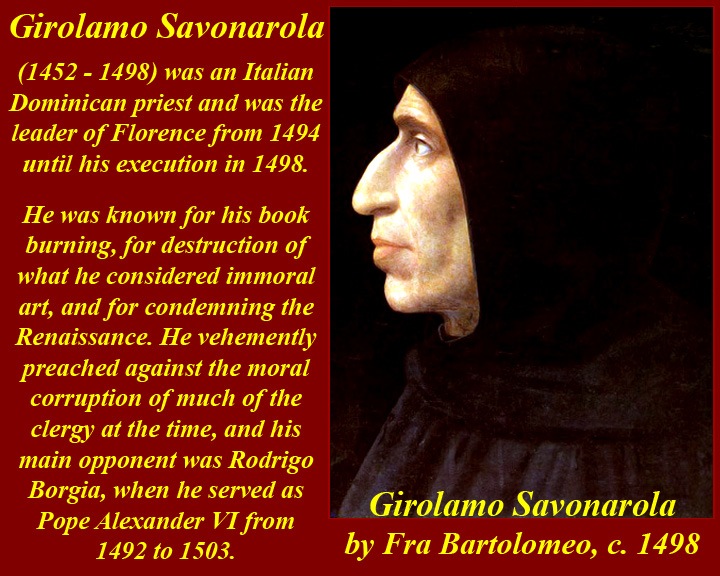
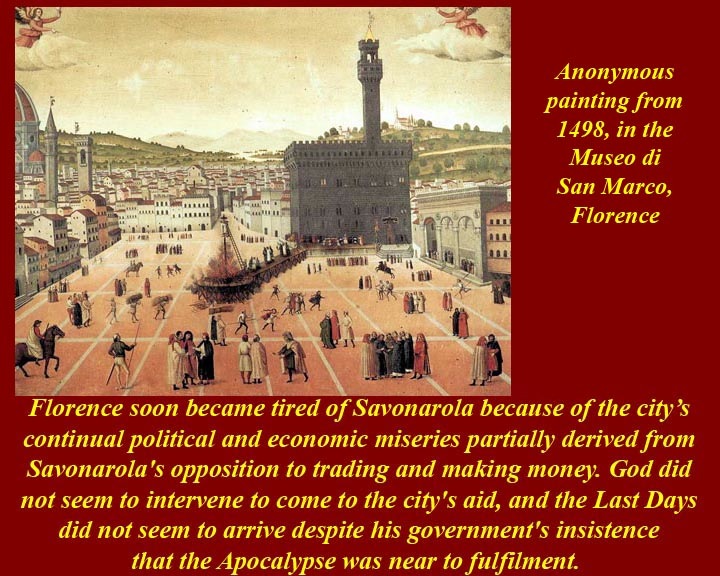
http://www.mmdtkw.org/RenRom0202h-Savonarola1.jpg
http://www.mmdtkw.org/RenRom0202i-Savonarola2.jpg
http://www.mmdtkw.org/RenRom0202j-Savonarola3.jpg
Girolamo Savonarola was a Dominican priest who preached against the "vanities" of the Renaissance. He was famous for (although he probably did not invent) the "bonfire of the vanities". Born in 1452, he was the leader of Florence from 1494 until his execution in 1498. He was known for his book burning, destruction of what he considered immoral art, and hostility to the Renaissance. He vehemently preached against the moral corruption of much of the clergy at the time, and his main opponent was Rodrigo Borgia, when he was Pope Alexander VI, from 1492 to 1503. Because book-burning became associated with the Nazis in the 20th century, Savonarola sometimes has been characterized as a right-wing religious extremist. In fact, he was not that but rather he was a left-wing religious extremist. The penalty for crossing Savonarola, when he was in charge, was a particularly gruesome death suspended in chains from a cross over a raging bonfire. Savonarola and his two best henchmen eventually were killed the same way after they lost popular support (and after French support evaporated.) He was excommunicated by the Pope, tortured until he confessed, condemned, and turned over to the civil authorities for execution. A contemporary artist recorded the event -- the Bonfire of Savonarola.
For accounts of Savonarola's rise and fall, see http://en.wikipedia.org/wiki/Girolamo_Savonarola and http://www.newadvent.org/cathen/13490a.htm. The second internet link will take you to the Catholic Encyclopedia. The Catholic Church maintains that Savonarola was not, repeat not, a heretic; he was condemned for insubordination, not heresy.
Many protestants consider Savonarola a predecessor of Martin Luther, and in Worms, Germany, where Luther refused to recant, the Luther statue has Savonarola in a supporting role -- he's the one in Dominican robes with his right hand raised at http://www.travel-tidbits.com/tidbits/Worms3.jpg.
(a)
(b)
(c)
(d)
http://www.mmdtkw.org/RenRom0204-VasariLives.jpg
http://www.mmdtkw.org/RenRom0205-SalaRegiaVasari.jpg
http://www.mmdtkw.org/RenRom0205a-VasariSalaGrande.jpg
http://www.mmdtkw.org/RenRom0205b-FlorenceDuomoDomeFresco.jpg
Giorgio Vasari (30 July 1511 – 27 June 1574) was an Italian painter and architect, who is today most famous for his biographies of Italian artists (a), considered the ideological foundation of art-historical writing. Vasari's "Lives" has a consistent and notorious bias in favor of Florentines and tends to attribute to them all the developments in Renaissance art -- for example, the invention of engraving. Venetian art in particular (along with arts from other parts of Europe), is systematically ignored in the first edition. Between the first and second editions, Vasari visited Venice and while the second edition gave more attention to Venetian art (finally including Titian) it did so without achieving a neutral point of view. Vasari's biographies are interspersed with amusing gossip. Many of his anecdotes have the ring of truth, while others are inventions or generic fictions, such as the tale of young Giotto painting a fly on the surface of a painting by Cimabue that the older master repeatedly tried to brush away, a genre tale that echoes anecdotes told of the Greek painter Apelles. With a few exceptions, however, Vasari's aesthetic judgment was acute and unbiased. He did not research archives for exact dates, as modern art historians do, and naturally his biographies are most dependable for the painters of his own generation and those of the immediate past. Modern criticism, with new materials opened up by research, has corrected many of his traditional dates and attributions. The work remains a classic, though it must be supplemented by modern critical research. The myth of Florentine domination of the Italian Renaissance is at least partly based on Vasari's biases.
Vasari's own Mannerist paintings were more admired in his lifetime than afterward. He was consistently employed by patrons in the Medici family in Florence and Rome, and he worked in Naples, Arezzo and other places. Many of his pictures still exist, the most important being the Sala Regia in the Vatican (b), wall and ceiling paintings in the great Sala di Cosimo I (Sala Grande) of the Palazzo Vecchio in Florence (c), where he and his assistants were at work from 1555, and his uncompleted frescoes inside the vast cupola of the Duomo(d), which were finished by Federico Zuccari and with the help of Giovanni Balducci.
Links to Vasari's works in museums around the world are at http://www.artcyclopedia.com/artists/vasari_giorgio.html.
(a)
(b)
(c)
(d)(e)
(f)
http://www.mmdtkw.org/RenRom0205c-VasariUffizi.jpg
http://www.mmdtkw.org/RenRom0205d-VasariCorridor.jpg
http://www.mmdtkw.org/RenRom0205e-VasariCorridorPonteVecchio.jpg
http://www.mmdtkw.org/RenRom0205f-VasariCorridorGallery.jpg
http://www.mmdtkw.org/RenRom0205g-TorreMannelli.jpghttp://www.mmdtkw.org
http://www.mmdtkw.org//RenRom0205h-VasariCorridorPittiEnd.jpg
Vasari's reputation as an architect is more durable than his reputation as a painter. He designed and supervised the construction of the Uffizi (a), the name of which indicates its original function as an "executive office building" for the Medici family. His loggia of the Palazzo degli Uffizi by the Arno opens up the vista at the far end of its long narrow courtyard, a unique piece of urban planning that functions as a public piazza, and which, if considered as a short street, is the unique Renaissance street with a unified architectural treatment. The view of the Loggia from the Arno reveals that, with the Vasari Corridor (b through f), it is one of very few structures that line the river which are open to the river itself and appear to embrace the riverside environment.
The Corridor is a long passage that passes over the Arno River on top of the Ponte Vecchio connecting the Palazzo Vecchio and the Uffizi with Palazzo Pitti on the other side of the river. The interior walls of the Corridor are lined with hundreds of self portraits of 15th through 20th century artists including Vasari's own self-portrait at http://www.mmdtkw.org/RenRom0204-VasariLives.jpg.
Rome eventually caught up in art and architecture:
(a few examples: there will be separate units on art and on architecture later.)
http://www.mmdtkw.org/RenRom0209-ColonnaGalleria.jpg
Galleria Colonna in Palazzo Colonna, Rome -- The Colonna fought for centuries with the Orsini for power in Rome. The Orsini, headquartered in the Torre Milizie bombarded the nearby Colonna tower until it collapsed, but the Orsini regrouped and drove out the Orsini. Later the Colonna built Palazzo Colonna which includes this great hall, which is now known as the Galleria Colonna. The Galleria is open to the public only on most Saturday mornings, and it along with two monumental gardens can be rented as a venue for "great events". (See http://www.galleriacolonna.it/ -- click on the red, white, and blue icon in the lower right corner for English language.)
Michelangelo's Campidoglio -- Michelangelo designed the Campidoglio for Pope Paul III Farnese. The project was started in 1538, but little was completed before Michelangelo's death in 1564. Its buildings were completed in the 1600s, but the pavement designed for the piazza was only completed was not finished until the 20th century (and then in reverse -- white where Michelangelo had specified black and black where he wanted white. See
http://www.greatbuildings.com/buildings/Piazza_del_Campidoglio.html or see GOOGLE for about 114,000 more images at http://images.google.com/images?hl=en&safe=off&client=safari&rls=en&num=100&newwindow=1&q=campidoglio&um=1&ie=UTF-8&sa=N&tab=wi.
http://www.mmdtkw.org/RenRom0211-GiambolognaVenus.jpg
Giambologna's Grotticelli Venus and his Cesarini Venus. See http://www.mmdtkw.org/VGiambolognaVenus.html and http://www.mmdtkw.org/VGiambolognaVenusBrochure.html
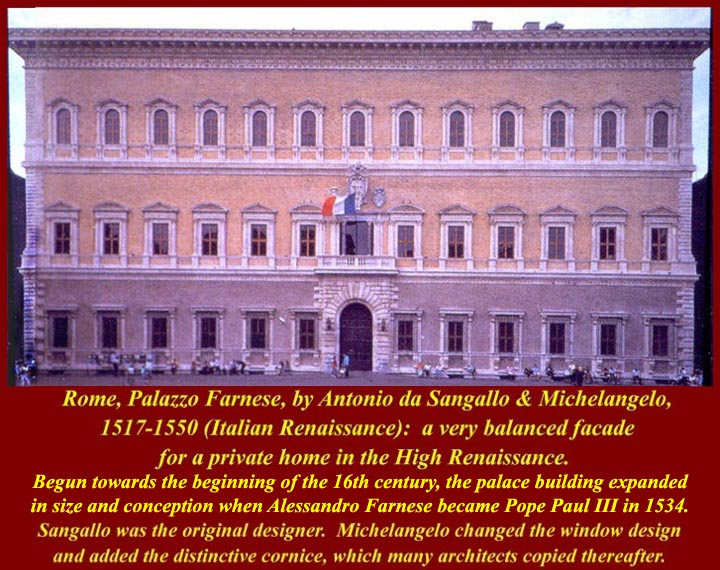
http://www.mmdtkw.org/RenRom0212-PalFarnese.jpg
http://www.mmdtkw.org/RenRom0213-LoggiaFarnese.jpg
Palazzo Farnese and the Loggia of Palazzo Farnese. See http://www.romeartlover.it/Vasi73.htm.
http://www.mmdtkw.org/RenRom0215VillaMedici.jpg
The construction of the Villa Medici in Rome memorialized a change of venue for the headquarters of Medici influence in Italy. Rather than contend with the Popes, the Lorenzo the Magnificent decided that his son and stepson would become the Popes. The Medici did not stop their activities in Florence, but rather moved their headquarters to Rome to bolster their position in Florence. The Medici remaiined in Florence until the last Medici scion Anna Maria Luisa de' Medici (http://en.wikipedia.org/wiki/Anna_Maria_Luisa_de%27_Medici), Electress Palatine; Duchess of the Palatinate-Neuburg, of Jülich and Berg, of Cham and the Upper Palatinate; Countess of Megen died in 1743 and left the Medici collections to the Tuscan state. The Florentine Medici name disappeared, but by that time Medici women had married into all the ruling families in Europe. The name died, but Medici blood still flows in the veins of European royalty.
The "villa" Medici actually is the whole of the large architectural complex centered on the a Rome family residence, whose gardens are contiguous with the larger Borghese "villa", on the Pincian Hill next to Santa Trinità del Monti in Rome. The Villa Medici, founded by Ferdinando I de' Medici, Grand Duke of Tuscany, has housed the French Academy in Rome since 1803. A musical evocation of its garden fountains features in Ottorino Respighi's Fontane di Roma. In ancient times, the site of the Villa Medici was part of the gardens of Lucullus, which passed into the hands of the Imperial family with Messalina, the third wife of Claudius, who was murdered in the villa.
The upper image, above, was the formal entrance to the Villa in the Renaissance. The "back door" that faces Viale della Trinita del Monti is now the entrance to the French Academy. The lower image is the architectural copy, the Jefferson Hotel in Richmond, Virginia (http://www.jeffersonhotel.com/).
For information on the Villa Medici, see http://en.wikipedia.org/wiki/Villa_Medici and http://www.villamedici.it/ (French and Italian only). For information on Valaria Messalina, see http://en.wikipedia.org/wiki/Valeria_Messalina.
Two Reasons:
Rome was safer -- The north was under threat from the French.
Rome had more wealth and a bigger market to exploit.
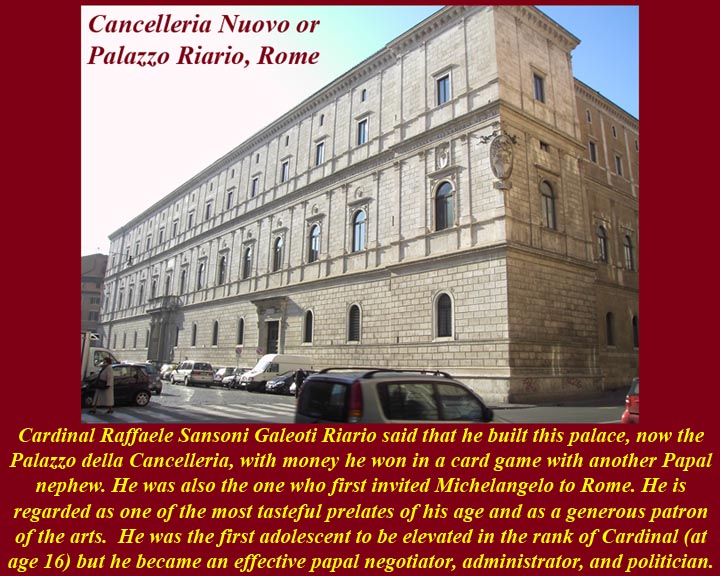
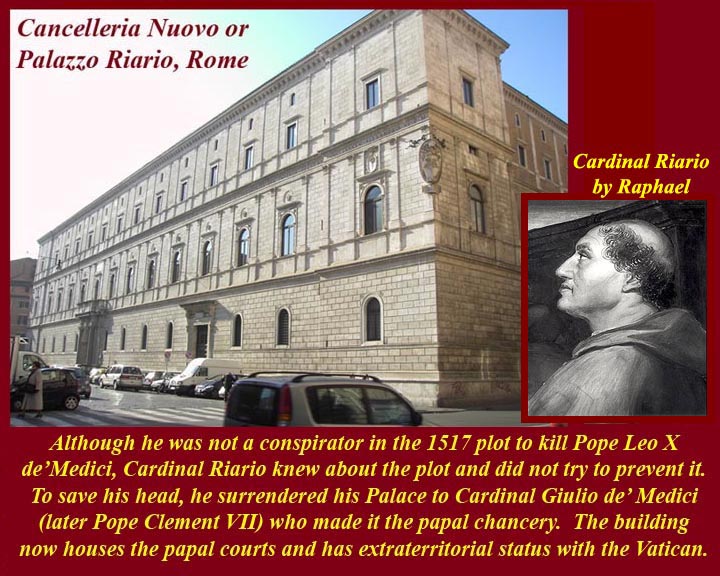
http://www.mmdtkw.org/RenRom0216a-CancelleriaExterior1.jpg
http://www.mmdtkw.org/RenRom0216b-CancelleriaExterior2.jpg
http://www.mmdtkw.org/RenRom0216ba-BramanteCourtyard.jpg
The Palazzo della Cancelleria Apostolica, or simply the Cancelleria, is the modern name for the splendid renaissance Palazzo Raffaele Riario that runs the full length of the western side of the broad Piazza della Cancelleria, halfway between the southern end of Piazza Navonna and the northern corner of Camp di Fiori, in the Camp Marzio. For many years, guidebooks of Rome had the simple comment "not accessible" at the beginning of their descriptions -- it had never been open to the public since it was built -- but that is no longer true. Although three functioning offices of the Papal chancery still occupy most of the palazzo, some important areas are now open and hosting exhibitions.The Palazzo was built sometime between 1471 and 1484 for Cardinal Raffaele Riario, the nephew of Pope Sixtus IV who reigned during that period, but, unlike many other Roman Palazzi built by papal nephews, it was not build with church funds. The good Cardinal built his house with 60,000 scudi won in a single night of gambling from another important nephew, Cardinal, Francheschetto Cibo, whose uncle was to succeed Sixtus IV and become Pope Innocent VIII. Trying to determine how much that might be in modern money is difficult, but it must have been a lot from the looks of the palace it bought. Romans of the time were familiar with the custom of building palaces for Cardinals using church funds, but, judging from the fact that it became part of Roman lore, they must have been at least a little scandalized by how Cardinal Riario got the money for this one -- at least by the size of the stakes the Cardinals' card game.
Nobody knows for certain who designed the Palazzo, because the records appear to have been lost in the sack of Rome in 1527, but there are theories: architectural historians say there are distinct Florentine influences. Giorgio Vasari, an artist and art historian of the next century, said that Donato Bramante was the architect, but that was clearly impossible because Bramante was not yet in Rome when the Cancelleria was built. Bramante may later have done the grand multi-level pillared courtyard, but even that is occasionally disputed. The main door and the balcony above it are by Domenico Fontana and were added during the reign of Pope Sixtus V. The rest of the Palace is now generally attributed, based on design and artistic affinities, to Andrea Bregno and/or Antonio da Montecavallo.
The only decorations on the outside of the palace, aside from window and doorway treatments reminiscent of ancient Roman styles, are some examples of the Riario heraldic roses, the dedicatory inscription running the length of the front, and papal arms at the corners (added later.)
The architectural gem of the interior of the palazzo is the "Bramante" courtyard which has three levels of porticoes adorned with 44 fine granite columns which are thought to have been taken from Pompey's hekatostylon, the "hundred-pillared" ambulatory next to his theater, and with more Riario roses. This courtyard for years was only available for an occasional quick peak through the door when it might be opened briefly to allow in a Vatican limo. Now you can walk right in on the ground level, and a stairway on the left takes you up to the piano nobile level of the portico, which is also open.
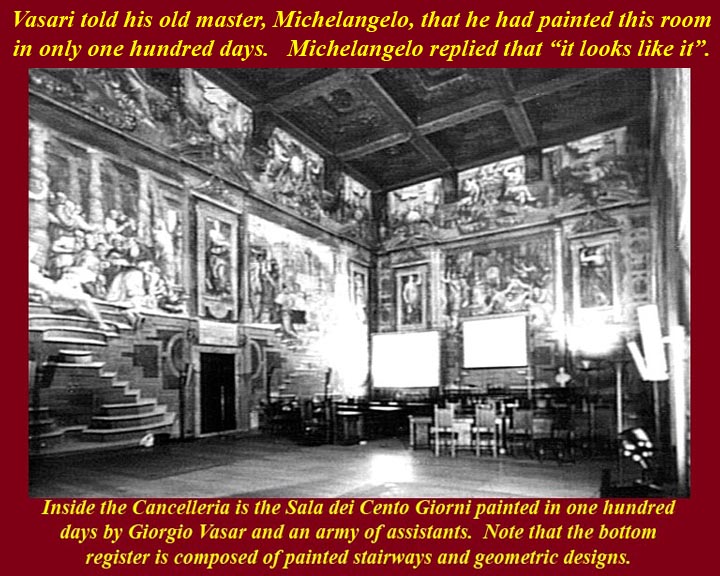
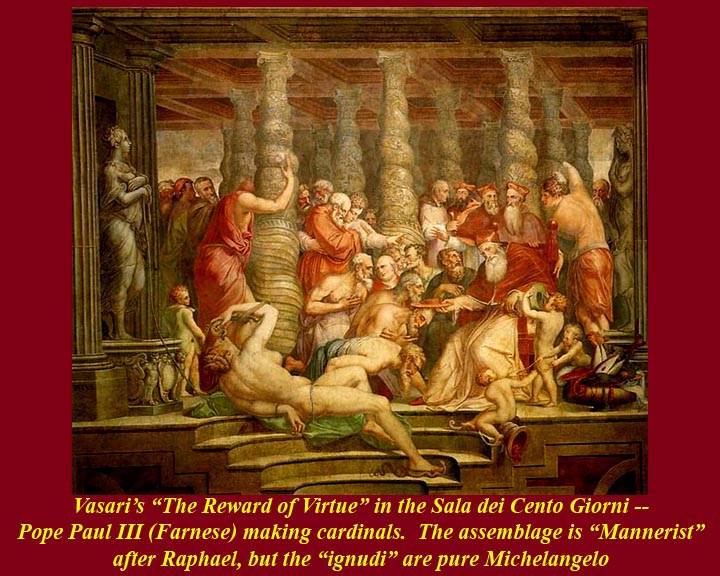
http://www.mmdtkw.org/RenRom0216c-SalaCentoGiorni.jpg
http://www.mmdtkw.org/RenRom0216d-SalaCentoGiorniCardinals.jpg
http://www.mmdtkw.org/RenRom0216e-SalaCentoGiorniStPeters.jpg
The interior decorations of the viewable part of the Palazzo della Cancelleria have never attracted the same level of critical praise as its architecture. It is probably, therefore, just as well that the newly installed lighting in the very large Sala Riaria (the main reception room, which is profusely frescoed by unidentified Renaissance artists) is designed to emphasize the exhibitions that occupies this hall and the adjoining Sala dei Cento Giorni. The Sala dei Cento Giorni is so named, because Vasari, after installing its frescoes in the next century, boasted to Michelangelo that he and his students had finished the whole room in one hundred days. Michelangelo's famous retort was supposedly, "It looks like it."
The style of Vasari's frescoes in the Sala dei Cento Giorni is called "mannerist", meaning in the manner of Raphael. It refers to the grouping of figures in active groups and can best be seen in the Stanze (= rooms) di Raffaello that Raphael frescoed in the new Vatican Papal apartments for commissioned by Pope Julius II della Rovere -- Julius refused to live in the same rooms that had been occupied by Alexander VI Borgia.
(For the Raphael frescoes in the Stanze, see http://en.wikipedia.org/wiki/Raphael_Rooms). (For the frescoes in the Borgia apartments by Pinturicchio (Bernardino di Betto), see http://www.wga.hu/frames-e.html?/html/p/pinturic/vatican/.)
It should be noted that the muscular forms and the (often) nudity or semi-nudity of the figures in the Stanze and in paintings by mannerist painters that followed Raphael are derived from Michelangelo Buonarotti. Raphael changed his style to incorporate muscular ignudi after seeing what Michelangelo was concurrently painting on the ceiling of the Sistine Chapel. (See http://en.wikipedia.org/wiki/Sistine_Chapel_ceiling)
-- note that part of the left hand of Adam in the "iconic image of the hand of God giving life to Adam" (http://en.wikipedia.org/wiki/File:Hands_of_God_and_Adam.jpg) at the top of that web page is not Michelangelo's work. Cracks had developed in Michelangelo's ceiling in the years after its completion causing the loss of some fingers. The index and middle fingers were replaced in 1565, the year after Michelangelo's death, on the orders of Pope Pius IV by an obscure Modenese artist named Domenico Carnovale.
Both of the large rooms have been extensively and very meticulously restored adopting the modern convention of clearly delineating original and restored sections.
Scholasticism Replaced by Humanism -- Unit 3http://www.mmdtkw.org/RenRomUnit03Humanism.html
Topics for Unit 3
A selective list of major actors -- selective because it is impossible to note them all. So these are some representative threads in the weave of humanism:Wrong books!! Popular books that get the Renaissance all wrong: Manchester's A World Lit Only by Fire and Tuchman's The March of Folly.Scholasticism -- the prevalent thought process that had to be changed. Aquinas -- last scholastic or first humanist? Petrarch / Avignon -- Petrarch delivers the method Humanism flow chart Can humanism and religion coexist? "Classical" as "pagan" whereas southerners regarded classical religion and philosophy as another (parallel) source for Christianity. Italian Renaissance artists could put classical figures into religious art and not blink an eye -- e.g., the Sybils in Michelangelo's Sistine Chapel ceiling frescoes. This is one reason why northen Protestantism rejected imagery.]Bessarion and other refugees deliver the Greek texts -- effect in the West of the fall of Constantinople Guicciardini and modern history -- fact-checking Pico della Mirandola -- brilliant mind, but too much puffery -- early death Leonardo Bruni -- too reasonable for his own good Lorenzo Valla -- debunks the Donation but later works for the Papacy Julius II -- "Warrior Pope" and harsh master of artists
Internet Links for Unit 3
http://www.saint-andre.com/ismbook/ism3.html The "-ism" Book
Scholasticism
http://www.nd.edu/Departments/Maritain/etext/art.htm
http://www.nd.edu/Departments/Maritain/etext/scholas1.htm
http://en.wikipedia.org/wiki/Scholasticism
http://www.newadvent.org/cathen/13548a.htm
Petrarch
http://petrarch.petersadlon.com/
http://www.fordham.edu/halsall/source/petrarch1.html
http://www.fordham.edu/halsall/source/petrarch1.html
http://www.newadvent.org/cathen/11778a.htm
http://en.wikipedia.org/wiki/Petrarch
http://www.kirjasto.sci.fi/petrarca.htm
http://www.humanistictexts.org/1300_-_1450.htm
Aquinas
http://www.newadvent.org/cathen/14663b.htm
http://www.newadvent.org/summa/
http://plato.stanford.edu/entries/aquinas/
http://www.home.duq.edu/~bonin/thomasbibliography.html
Humanism
http://www.wsu.edu:8080/%7Edee/REN/HUMANISM.HTM
http://www.newadvent.org/cathen/07538b.htm
http://www.telemachos.hu-berlin.de/bilder/gudeman/gudeman1.html
Humanists
http://www.humanistictexts.org/boccaccio.htm Boccaccio
http://www.brown.edu/Departments/Italian_Studies/dweb/dweb.shtml Boccaccio
http://www.humanistictexts.org/manetti.htm Manetti
http://www.newadvent.org/cathen/07064a.htm Guicciardini
http://www.humanistictexts.org/bruni.htm Bruni
http://www.newadvent.org/cathen/15257a.htm Valla
http://history.hanover.edu/texts/vallatc.html Valla
http://www.tertullian.org/rpearse/donation/donation_of_constantine.htm Valla
http://www.newadvent.org/cathen/10352a.htm Pico della Mirandola
http://www.wsu.edu:8080/~dee/REN/PICO.HTM Pico
http://www.wsu.edu:8080/~wldciv/world_civ_reader/world_civ_reader_1/pico.html Pico
http://www.newadvent.org/cathen/08562a.htm Julius II
http://www.kfki.hu/~arthp/html/r/raphael/5roma/1/09julius.html JuliusII
Remember, always, that there are many other
Internet sites that you can find with you favorite
"search engine".
Renaissance Rome
Unit 3 Slides
Humanism Displaces ScholasticismClick on links or small images below to go to larger images for Unit 3
Definitions:
scholasticism [From Latin schola: school]: Any approach to philosophical inquiry that is focuses on academic disputes rather than real-world concerns, especially in the high to late Middle Ages (~1100-1500 CE). (For more on scholasticism, see http://en.wikipedia.org/wiki/Renaissance_humanism, and http://www.newadvent.org/cathen/13548a.htm.)
humanism [From Latin humanus: relating to or characteristic of human beings]: A focus on human concerns as opposed to the interests of the gods (theism) or the technical issues of philosophy (logicism). Examples include Aristotelianism and Epicureanism in ancient Greece, Confucianism and Taoism in China, Renaissance humanism in Europe, and some forms of transcendentalism and pragmatism in America. While humanism is often closely associated with secularism and to individualism, these connections are not necessary; in fact, humanism is sometimes thought of as a 'religion of humanity' that takes altruism and action for the sake of all humanity as its guiding principle. (For a quick rundown on Renaissance humanism, see http://en.wikipedia.org/wiki/Renaissance_humanism. For a slightly longer explication, see http://wsu.edu/~dee/REN/HUMANISM.HTM. For a short list of important Renaissance humanistic works and their authors, see http://www.lib.uchicago.edu/e/spcl/excat/berlin/renaissa.html from the University of Chicago Library. For the US Library of Congress page on Humanism from its 1993 "Rome Reborn" exhibition, see http://www.loc.gov/exhibits/vatican/humanism.html; there are links to other aspects of the exhibition at http://www.loc.gov/exhibits/vatican/.)
http://www.mmdtkw.org/RenRom0301-WrongBooks.jpg
Even respected authors and historians sometimes succumb to the temptation to selectively use source materials, either in an attempt to denigrate the Catholic church (which, Lord knows, can do that for itself) or to boost sales. In short, any modern work that uses the diary of Stefano Infessura (http://en.wikipedia.org/wiki/Stefano_Infessura) as a source is suspect, whereas those which use the contemporary works of Johannes Burckardt are considered more reliable.
Burchardt, an Alsatian bishop, was a VIP in the Rome of 500 years ago where he was known as Burcardo Argentinensis. The Argentinensis part of his name came from Argentoratum, the old Latin name of his native Nieder-Haslach, a silver mining town near Strasbourg. Burckardt was Papal Master of Ceremonies for five successive Popes (Sixtus IV, Innocentius VIII, Alexander VI (the infamous Roderigo Borgia), Pius III and Julius II), and was Master of Ceremonies for the Great Jubilee Year of 1500. But he made powerful enemies, and almost all memory of him was abolished after he died. He would not be known at all, outside obscure Papal liturgical history circles, if he had not kept an accurate and partially documented diary from December 1483 through April 1506, which included the time of the Borgias. Although it is extremely gossipy, historians accept his Liber Notarum as the most accurate source on Papal affairs during this important period of the Renaissance in Rome. (The writings of Stefano Infessura, an anti-papal republican and a partisan of the Colonna family, are just as universally discounted.)
Burcardo's history and the present use of his completely restored Palace on Via Sudario as a world class Theatre Library and Museum. Read a short item about Burcardo at http://www.mmdtkw.org/VBurcardo.html.
[It's important not to confuse Johannes Burckardt/Burcardo with the greatest 19the century historian of the Italian Renaissance, Jacob Burckhardt, information about whom is available at http://en.wikipedia.org/wiki/Jacob_Burckhardt. The full text of Jacob Burckhardt's The Civilization of the Renaissance in Italy is on the Internet at http://www.gutenberg.org/ebooks/2074, and that's what you should read instead of the two books illustrated above.]
http://www.mmdtkw.org/RenRom0302-Aquinas.jpg
The Dominican Thomas Aquinas was either the last scholastic or the first humanist, depending on which source you wish to believe. See http://www.newadvent.org/cathen/14663b.htm and http://plato.stanford.edu/entries/aquinas/.
http://www.mmdtkw.org/RenRom0303-PetrarchAvignon.jpg
The Epistolae Familiares and Epistolae Seniles of Petrarch (1304-1374) reflect the author's emphasis on concrete human experience and his love of classical antiquity attitudes which became characteristic of the revival of classical learning which he helped set in motion. By composing letters to ancient Greek and Roman personalities as if they were still alive, Petrarch hoped to revive the individuality, beauty, and purity which he perceived in the classical works. He felt that the lessons of the ancients could serve to invigorate the moral life of Christendom and to lighten a world beset by disease, famine, and other woes. A short article on Petrarch's "familiar" and "old age" letters is at http://en.wikipedia.org/wiki/Epistolae_familiares. Some of the letters are at http://petrarch.petersadlon.com/letters.html and http://petrarch.petersadlon.com/seniles.html and http://history.hanover.edu/texts/petrarch/pettable.html.
Francis Petrarch has been labeled the "first modern man of letters" and the "founder of humanism." Probably best known for his creation of the sonnet form of poetry and for his love poems to Laura, he was also a prolific scholar and writer. He wrote theological and philosophical treatises, epic poems, and polemical works directed against those whom, he believed, had corrupted learning and religion in Christendom. He also played a leading role in rehabilitating the literary genre of the epistle, a letter addressed to a private individual but intended for a public audience. Most of Petrarch's letters are addressed to living human beings, but he did write several addressed to authors of the ancient world.
Petrarch was highly critical of the learning of his own age. He criticized scholasticism, the dominant method of learning in the "schools" or universities, as arid and useless, focusing too much on hair-spitting logic and on abstract and abstruse subjects. Petrarch instead looked the ancients for guidance, and especially to Cicero. Marcus Tullius Cicero (104-43 B.C.E.) appealed to Petrarch and to subsequent humanists because his writings provided (in elegant Latin) an overview of all of Greek and Roman learning and specifically because Cicero was a prophet of a humanities-based liberal arts education favored by the humanists (and articulated by Vergerius in the next section). Petrarch wrote the following letter to Cicero after he had discovered a hitherto unknown cache of Cicero's letters. The letters reveal Cicero to be a man deeply involved in the Roman politics in the last years of the Republic, a partisan on the side of Republican liberty against the side of monarchy, or empire. Before reading the letters, Petrarch had imagined Cicero in his later years to be a sage philosopher, retired from public life and far removed from the world of politics.
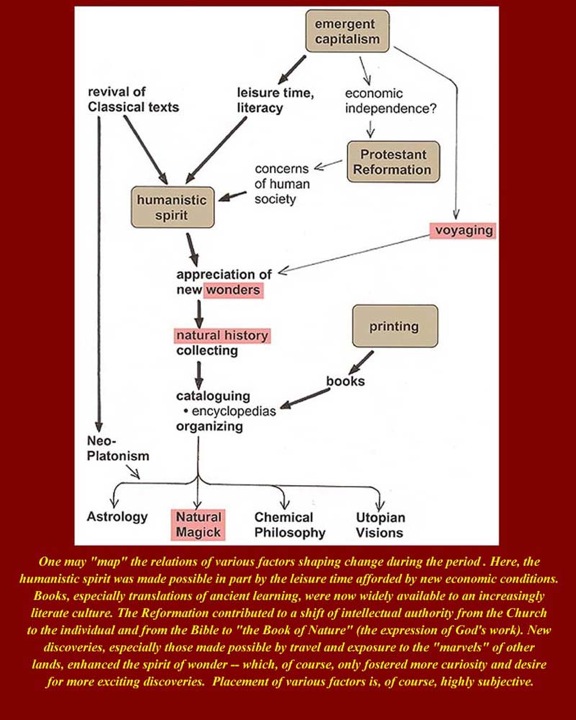
http://www.mmdtkw.org/RenRom0304-HumanismFloChart.jpg
http://www.mmdtkw.org/RenRom0305-TheismVHumanism.jpg
A hypothetical flow chart of factors shaping change toward Humanism and a graphic illustrating some differences between Humanism and Theism.
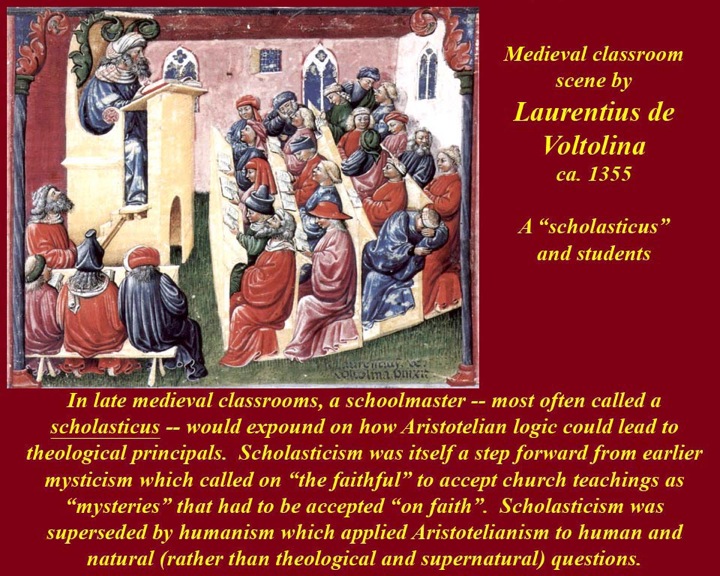
http://www.mmdtkw.org/RenRom0305ab-MedievalClassroom.jpg
http://www.mmdtkw.org/RenRom0305ac-StAnselm.jpg
In medieval university classrooms, the "scholasticus" would expound and the students would listen. Debate rarely followed, at least in the classroom setting. Anselm was one of the great proponents of scholasticism and one of several persons called "the father of Scholasticism". Anselm relied on "reason" (not mere faith or mysticism) to argue for the existence of god and to argue about other theological tenets. For more on Anselm, see http://maritain.nd.edu/jmc/etext/hop30.htm.
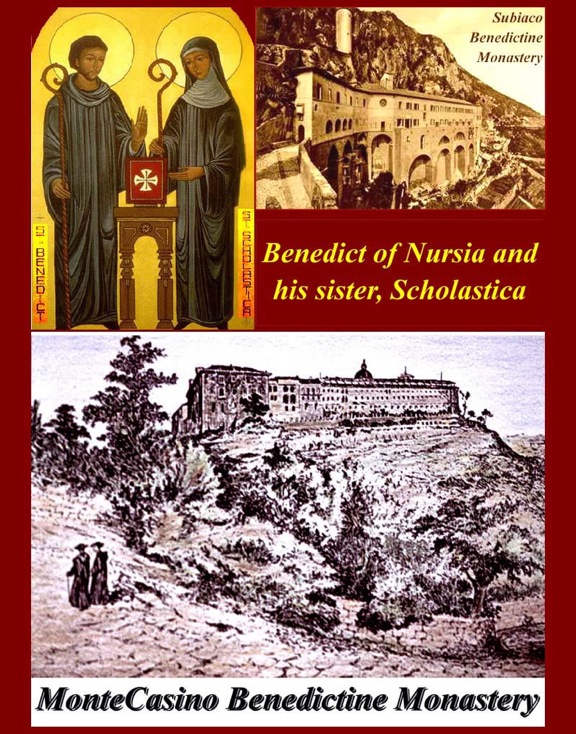
http://www.mmdtkw.org/RenRom0305ac-BenedictNursia.jpg
http://www.mmdtkw.org/RenRom0305b-BenedictinePreservation.jpg
Benedict of Nursia founded twelve communities of monks at Nursia, 40 miles east of Rome before moving to Monte Casino in the mountains near Naples. His "Benedictine" monks lived by a specific "rule" which was of his composition (full English text at http://www.ccel.org/ccel/benedict/rule2/files/rule2.html). Benedict's "twin sister", Scholastica, may be merely an allegorical later addition, although her real existence is said to be based on a description based on a words supposedly dictated to his Deacon by the Benedictine Pope, Gregory the Great (c. 540-604). See http://www.indiana.edu/~engs/scholas.htm for more about Scholastica and whether she was a real person. Much about Benedict himself is conjectural.
What is certain is that "Benedictine" monasteries sprang up first in Italy and then elsewhere in Europe during Medieval times, and that the libraries of some of these monasteries, including the great library of Monte Casino supplied some of the Patristic and classical texts that were essential for the development of "Latinity", "Ciceronianism", and Humanism.
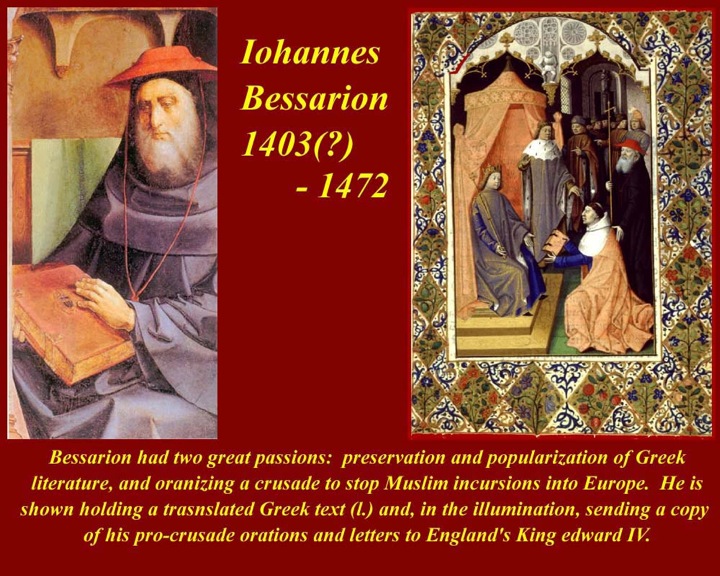
http://www.mmdtkw.org/RenRom0306-Bessarion.jpg
http://www.mmdtkw.org/RenRom0307BibMarciana.jpg
Iohannes Bessarion (1403(?) - 1472) exercised his passions -- classical Greek literature, crusade mongering, and rapprochement between the Greek and Roman Churches -- from a small house inside Rome's old San Sebastian Gate on the Old Appian Way (Via Appia Antica). For information on the life and works of Bessarion, see http://www.newadvent.org/cathen/02527b.htm and http://en.wikipedia.org/wiki/Basilios_Bessarion. Bessarion's personal collection of classical Greek works, some of which he translated into Latin, provided the Greek input to humanistic studies of classical literature and life.
Bessarion's collection of 750 codices in Latin and Greek, to which he added another 250 manuscripts and some printed books (incunabula), became the nucleus of the first "public" library open to scholars, the Biblioteca Nazionale Marciana (= National Library of St Mark's) in Venice. The Marciana is one of the earliest surviving public manuscript depositories in the Italy, holding one of the greatest classical texts collections in the world. The library is named after St. Mark and sits at the corner of Piazza San Marco opposite the Doge's Palace. Information is at http://en.wikipedia.org/wiki/Biblioteca_Marciana.
http://www.mmdtkw.org/RenRom0308-GuicciardiniHist.jpg
Francesco Guicciardini (March 6, 1483 - May 22, 1540) was an Italian historian and statesman. He is considered one of the major political writers of the Italian Renaissance. Guicciardini is considered as the Father of Modern History, due to his use of government documents to verify his "History of Italy." Read about Guicciardini at http://en.wikipedia.org/wiki/Francesco_Guicciardini and at http://en.wikipedia.org/wiki/Francesco_Guicciardini.
http://www.mmdtkw.org/RenRom0309-PicoDignity.jpg
Giovanni Pico della Mirandola -- If there is such a thing as a "manifesto" of the Italian Renaissance, Giovanni Pico della Mirandola's "Oration on the Dignity of Man" is it. No other work more forcefully, eloquently, or thoroughly remaps the human landscape to center all attention on human capacity and the human perspective. Pico himself had a massive intellect and literally studied everything there was to be studied in the university curriculum of the Renaissance; the "Oration" in part is meant to be a preface to a massive compendium of all the intellectual achievements of humanity, a compendium that never appeared because of Pico's early death. For more on Pico and his oration, see http://www.cscs.umich.edu/~crshalizi/Mirandola/pater.html and http://www.cscs.umich.edu/~crshalizi/Mirandola/ for the entire Oration in English translation.
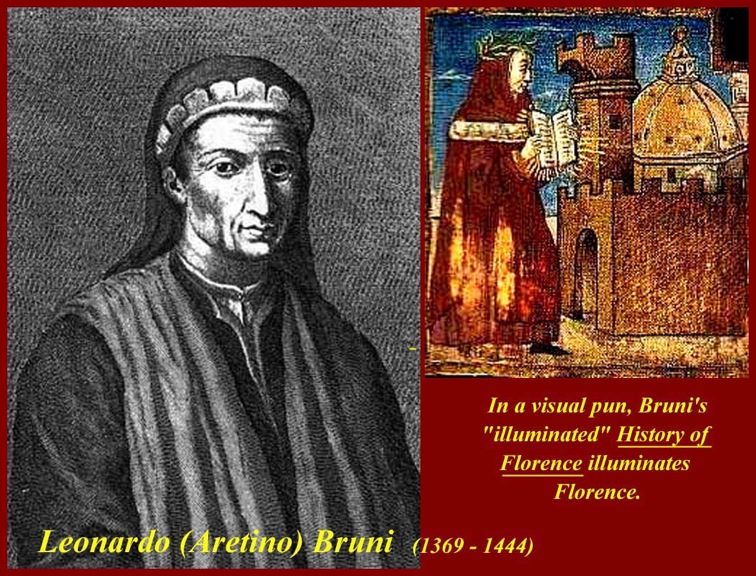
http://www.mmdtkw.org/RenRom0310-Bruni.jpg
http://www.mmdtkw.org/RenRom0311-BruniTomb.jpg
Leonardo Bruni's most notable work is History of the Florentine People, which has been called the first modern history book. Bruni was the first historian to write about the three period view of history: Antiquity, Middle Age, and Modern, a concept from which the term Middle Age was coined by a contemporary Flavio Biondo. The dates Bruni used to define the periods are not exactly what modern historians use today, but he laid the conceptual groundwork for a tripartite division of history. While it probably was not Bruni's intention to secularize history, the three period view of history is unquestionably secular and for that Bruni has been called the first modern historian. The foundation of Bruni's conception can be found with Petrarch who had first written, a generation earlier, about a "Dark Age" covering the period from the time of the fall of Rome extending to the time of Petrarch. Bruni and his fellow humanists believed they had reached the end of the Dark Age and were entering a modern period and thus logically called the intervening period a Middle Age. See http://en.wikipedia.org/wiki/Leonardo_Bruni for more on .
http://www.mmdtkw.org/RenRom0312-Valla.jpg
Lorenzo Valla (c. 1406–1457) was one of the most important humanists of his time. Valla did not have an easy life. Equipped with a sharp and polemical mind, an even sharper pen and a sense of self-importance verging on the pathological, he made many enemies throughout his life. In his Elegantiae linguae Latinae, an advanced handbook of Latin language and style, he gave the humanist program some of its most trenchant and combative formulations, bringing the study of Latin to an unprecedented level. He made numerous contributions to classical scholarship. But he also used his vast knowledge of the classical languages and their literatures as a tool to criticize a wide range of ideas, theories, and established practices. He famously exposed the Donation of Constantine—an important document justifying the papacy's claims to temporal rule—as a forgery. He compared, for the first time, St. Jerome's Latin translation of the Bible (the Vulgate) with the Greek text of the New Testament and pointed out both Jerome's translation errors and Jerome's incorrect Latin usages, thereby laying the foundations of critical biblical scholarship. In his Repastinatio dialectice et philosophie (Re-ploughing of Dialectic and Philosophy), also known as his Dialectics, he attacked scholastic-Aristotelian thought from an essentially linguistic point of view. Some of Valla's most important (and anti-Papal) work was done in Naples, but his skill and intellect was so well recognized by the Papal Court that he was later employed as a Papal Secretary and, when he died, he was honored with a lavish funeral and burial in the St. John Lateran Basilica. Already highly controversial in his own times, Valla's works continue to provoke heated debate in modern times. For more on Valla, see http://plato.stanford.edu/entries/lorenzo-valla/.
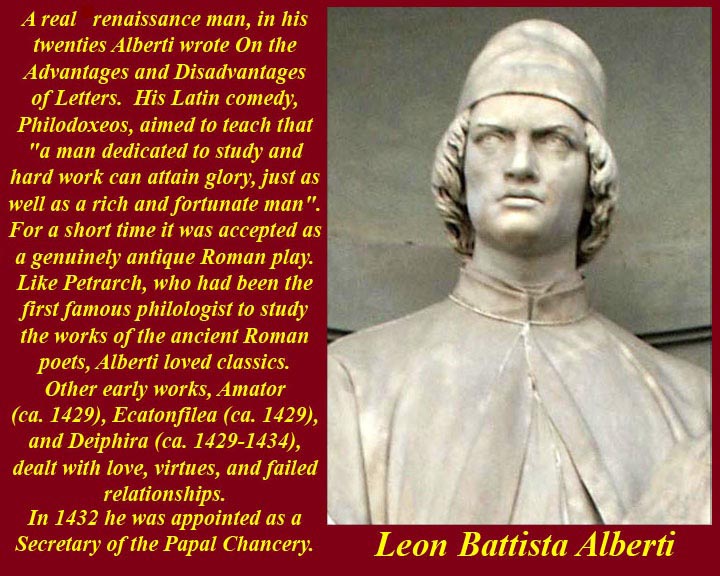
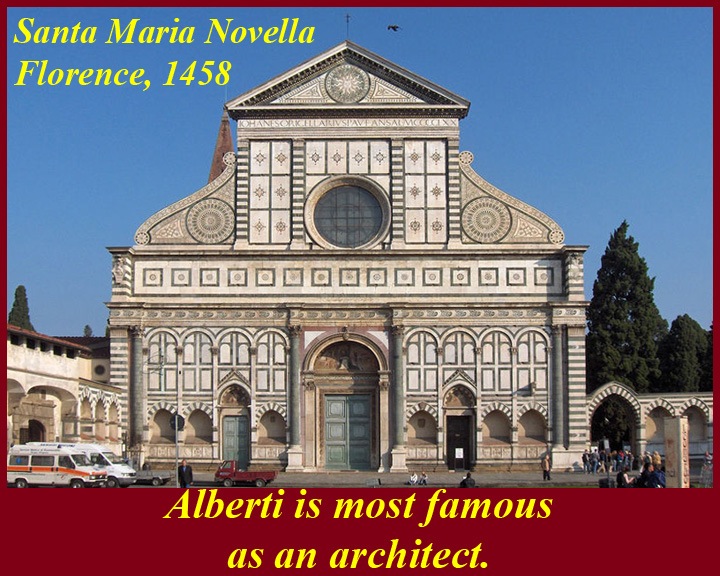
http://www.mmdtkw.org/RenRom0312a-AlbertiPhilologistAuthor.jpg
http://www.mmdtkw.org/RenRom0312b-AlbertiSMariaNovella.jpg
http://www.mmdtkw.org/RenRom0312c-AlbertiSantAndrea.jpg
Leon Battista Alberti (born Feb. 14, 1404, Genoa - died April 25, 1472, Rome) was an Italian architect and humanist author. In his personality, works, and breadth of learning, he is considered the prototype of the Renaissance "universal man".
The first theorist of Humanist art, Alberti belonged to an important Florentine family that had been exiled from Florence since 1387. When the family returned to the city in 1429, Alberti gained access to the city's great architecture and art which he studied extensively. Well-versed in Latin and Greek, Alberti never received a formal architectural education. His architectural ideas were the product of his own studies and research.
Alberti's two main architectural writings are "De Pictura" (1435), in which he emphatically declares the importance of painting as a base for architecture and "De Re Aedificatoria" (1450) his theoretical masterpiece. Like Vitruvius's "Ten Books on Architecture", "De Re Aedificatoria" was subdivided into ten books. Unlike Vitruvius's book, Alberti's told architects how buildings should be built, not how they were built. "De Re Aedificatoria" remained the classic treatise on architecture from the sixteenth century until the eighteenth century.
The unfinished Tempio Malatestiano in Rimini (1450) was the first building that Alberti designed and attempted to build based on his architectural principals. Up to that point Alberti's architectural experience was purely theoretic. The facade of Santa Maria Novella (1458-71) is considered his greatest achievement since it allows the pre-existing and newly added parts of the building to merge into a clear statement of his new principles.
The terms Renaissance Man and, less commonly, homo universalis (Latin for "universal man" ) are related and used to describe a person who is well educated or who excels in a wide variety of subjects or fields. The idea developed in Renaissance Italy from the notion expressed by one of its most accomplished representatives, Leon Battista Alberti (1404–72): that “a man can do all things if he will.” It embodied the basic tenets of Renaissance humanism which considered humans empowered, limitless in their capacities for development, and led to the notion that people should embrace all knowledge and develop their capacities as fully as possible. Thus the gifted humans of the Renaissance sought to develop skills in all areas of knowledge, in physical development, in social accomplishments and in the arts.
For more on Alberti, see http://en.wikipedia.org/wiki/Leon_Battista_Alberti
http://www.mmdtkw.org/RenRom0312d-AeneasSilvius-Pintoricchio.jpg
Although humanists had thronged the papal court since the beginning of the century, Pius II was the first real humanist to sit in the chair of Peter. Born in Siena as Enea Silvio Piccolomini, he acquired a reputation as a diplomat, belletrist, and womanizer, and was crowned poet laureate by the Emperor Frederick in 1442.
Aeneas Silvius Piccolomini (1405–64), Pope Pius II from 1458 until his death, was a patron of letters and author of a romance in Latin, Eurialus and Lucretia, of treatises on many subjects, and of commentaries on his times. His secular works include the Miseriae Curialium, which are decidedly secular moral and satirical stories. In his wild younger days he had fathered two illegitimate children (before taking holy orders), had been a partisan and official of the anti-pope Felix V (before shifting allegiance to Pope Eugene IV), and had been a diplomat, secretary, and poet laureate of Holy Roman Emperor Frederick III. He reputation as an inspired and learned humanist was recognized in the several courts in which he worked before his formal reconciliation between him and Pope Eugene IV, which took place in 1445. At about the same time, he apparently was morally regenerated and thereafter led an exemplary life. His experience in foreign courts (as far away as Scotland) meant that he was a useful and able Papal diplomat. After his election as Pope, he lived for a while in his birthplace, which he aggrandized and renamed Pienza (after himself) before returning to Rome to try to suppress internecine battles among the fractious Roman "noble" families. He devoted most of his papacy to trying to organize a crusade against the Turks, who had meanwhile taken Constantinople and were threatening points westward, but was unable to unify either the Italian or other European nobilities and monarchies behind the effort.
Unlike some later popes (Medici and della Rovere) who were merely enthusiastic patrons of humanism and the arts Pius II had been a humanist in his own right. For more on Aeneas Silvius, see http://en.wikipedia.org/wiki/Aeneas_Silvius (which appears to duplicate the entry on Pius II in the old Catholic Encyclopedia).
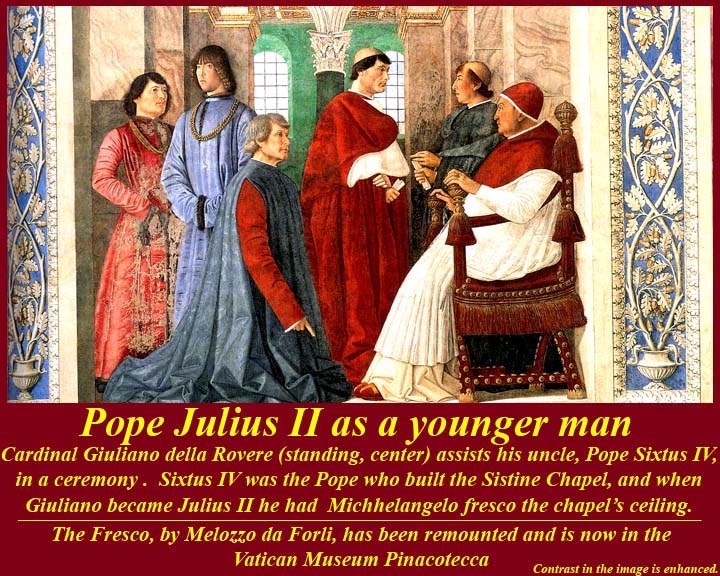
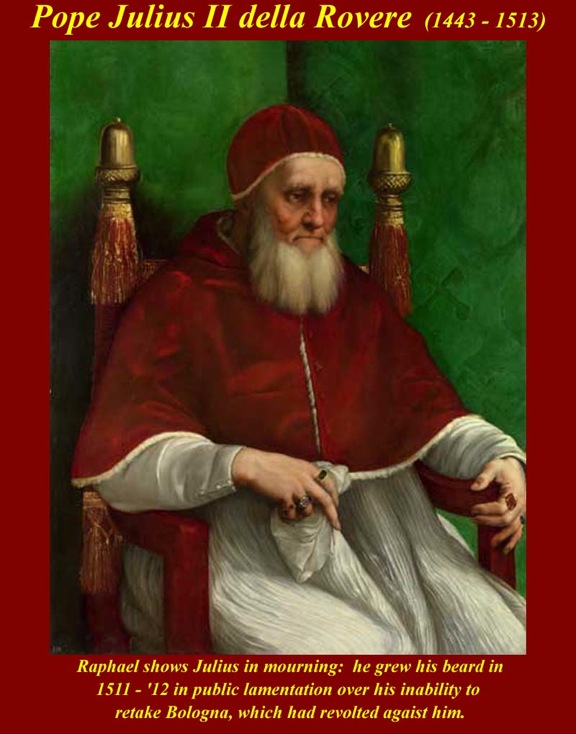
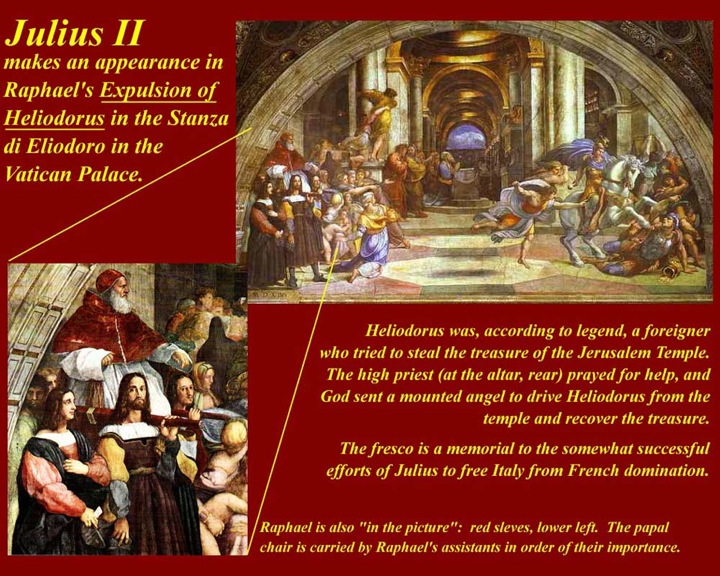
http://www.mmdtkw.org/RenRom0312e-JuliusIIYounger.jpg
http://www.mmdtkw.org/RenRom0313-JuliusRaphael.jpg
http://www.mmdtkw.org/RenRom0314-JuliusHeliodorus.JPG
http://www.mmdtkw.org/RenRom0315-JuliusTomb.jpg
The most famous papal patron of humanism and the arts is, of course, Julius II della Rovere, who commissioned Bramante to start construction of the new St Peter's basilica, who put Michelangelo to work in the Sistine Chapel, and who kept Raphael and his studio employed decorating the walls of the Vatican Stanze (papal apartments) and logie (porticoes). Pope Julius II, nicknamed "The Terrible Pope" (Il Papa Terribile -- i.e., the pope who inspires terror) and "The Warrior Pope" (Il Papa Guerriero), was born Giuliano della Rovere. He was Pope from 1503 to 1513. His reign was marked by an aggressive foreign policy, ambitious building projects, and patronage for the arts. A short biography is at http://www.luminarium.org/encyclopedia/julius2.htm. His projects are so well known that they need no discussion here; they will be taken up in later units.
http://www.mmdtkw.org/RenRom0316-RenaissancePopes.jpg
The list of Renaissance Popes. Some authorities say the Roman Renaissance began or ended sooner or later than the reigns of the listed popes, but their time period is about right.
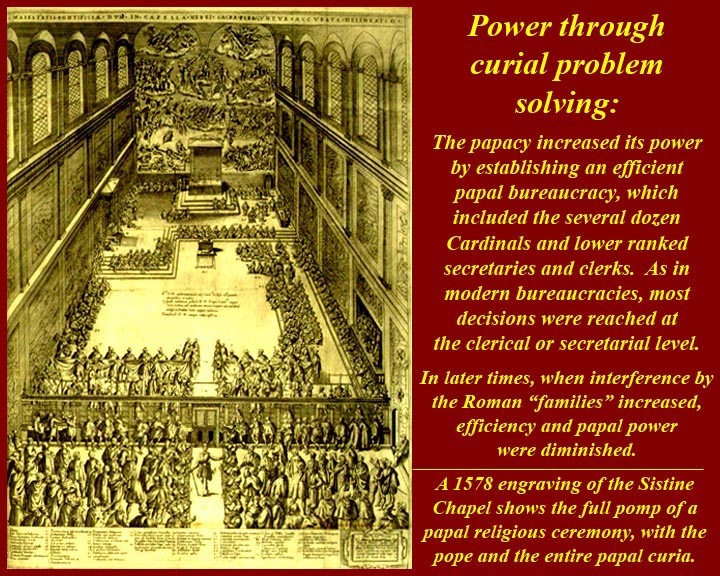
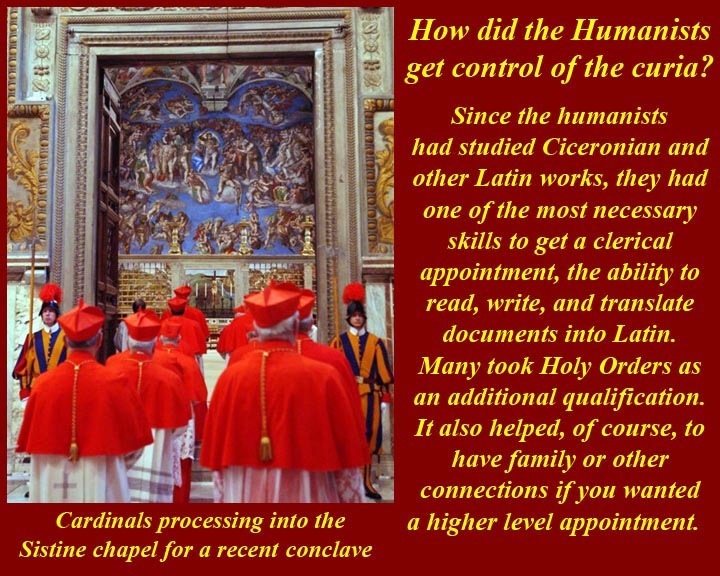
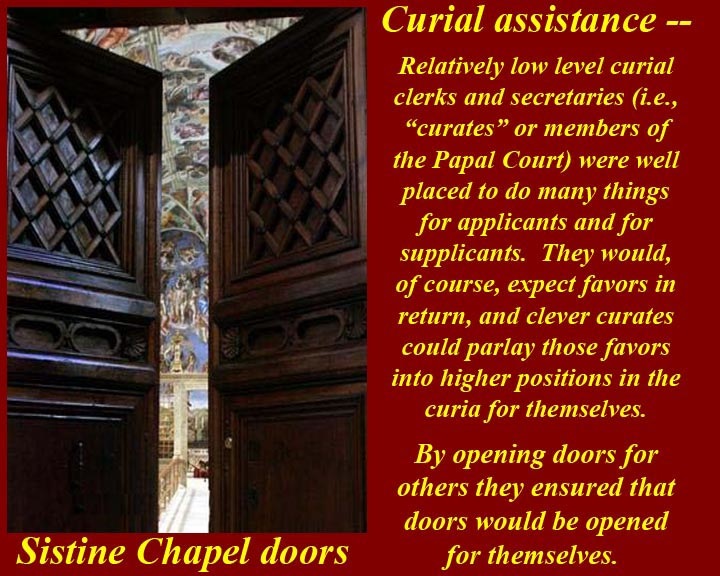
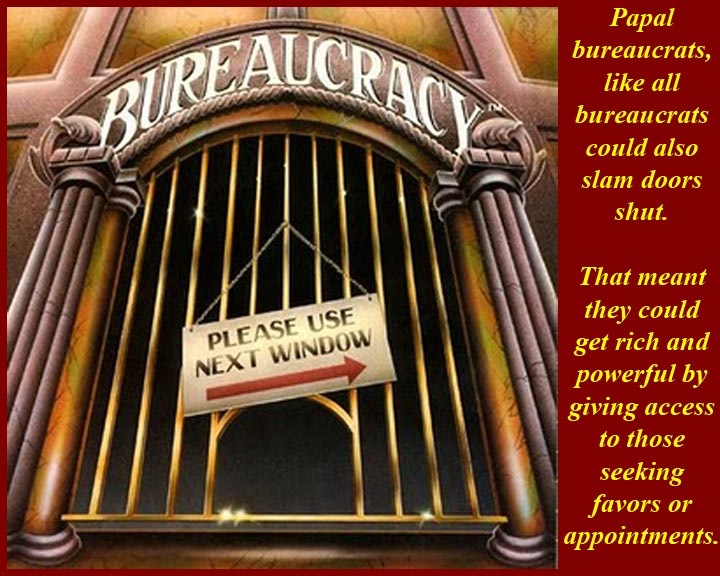
http://www.mmdtkw.org/RenRom0317-CurialBureaucracy.jpg
http://www.mmdtkw.org/RenRom0318-HumanistCuria.jpg
http://www.mmdtkw.org/RenRom0319-CuratesOpenDoors.jpg
http://www.mmdtkw.org/RenRom0319a-Bureaucracy.jpg
http://www.mmdtkw.org/RenRom0320-WeberBureaucracy.jpg
The Papal Curia is often identified as the College of Cardinals, but the Curia, in fact, includes not just the cardinals but also the entire papal bureaucracy; there have always been "disciples" as well as "apostles". The bureaucrats, as always, wield the majority of the power. This was and is not because they have arrogated to themselves the powers of the "monarch" and the "princes" of the church, but rather it is the natural result of how decisions are made in any bureaucratic system. Very few things need the attention of the "principals", or, put the other way, almost all authority is delegated to underlings. It is also the nature of bureaucracy that underlings and principals might be approached privately on a quid pro quo basis and that some may succumb to the temptation. Often the favor granted is merely access to someone higher up the line, and this and other favors are reciprocated. Clever bureaucrats, papal or otherwise, game the system for their own advancement or for what they regard as "higher ideals". This has always been considered to be inevitable -- part of the bureaucratic game. Never mind that is contradicts some of Max Weber's principles of bureaucracy.
http://www.mmdtkw.org/RenRom0321-Guidance.jpg
RenRom0400-outline
The Church and the Popes -- Unit 4http://www.mmdtkw.org/RenRomUnit04PapacyChurch.html
Topics for Unit 4
Popes of the Mid-14th to the end of the 17th CenturyJacob Burckhardt on the Papacy
Some interesting popes and papal families -- why we can't cover them all, and where to find more if you want it.
Sixtus IV (Francesco della Rovere) and the Sistine Chapel
Nicholas V or Sixtus IV -- Vatican Library
The Borgia popes and other Borgias
Sixtus V, Felix Peretti
The Medici family and the four Medici popes
Julius della Rovere, warrior pope and patron of artists
Internet links for Unit
4
http://www.newadvent.org/cathen/12272b.htm -- The Catholic Encyclopedia list of all the Popes from Peter I to the present. Each Pope's name is linked to a biography, some of which are heavily slanted in a Catholic direction, but most of which are surprisingly candid. Popes on the list are numbered and our period starts in the 190s. A list of the Renaissance popes with thumbnail bios and pictures of all of them is at http://catholicsites.org/popes/renaissance.html.
http://images.google.com/ -- Just as the web address says, this is the Google Image search page. Type in the word pope and the name and Roman numeral of any Pope (e.g., pope nicholas v -- no capital letters) to see some of the available Internet pictures of that Pope.
http://www.italycyberguide.com/History/popes/popes.htm -- The ItalyCyberGuide list of the Popes. Click on the century to see a short description of each Pope along with a small image (taken from the mosaic roundels in St. Peter's in the Vatican) and the papal escutcheon of each Pope.
http://www.boisestate.edu/courses/hy309/docs/burckhardt/1-10.html -- Full text English translation of the Jacob Burckhardt chapter (Part 1 - chapter 10) on the Papacy. All of the Englished Burkhardt text is at http://www.boisestate.edu/courses/hy309/docs/burckhardt/burckhardt.html.
http://www.kfki.hu/~arthp/database/glossary/popes/ -- 12th to 18th century Popes as listed in the wonderful Web Gallery of Art. Short bios (and some longer ones for more important Popes) with some associated art works. Links to the rest of the Web Gallery are available at the top of every page. The entire Gallery contains over 12,000 high-quality digital reproductions of European paintings and sculptures created between 1150 and 1800. It is hosted by KFKI, the Central Research Institute for Physics (Kozponti Fizikai Katato Intezet = KFKI) of the Hungarian Academy of Sciences in BudaPesht.
http://www.vaticanlibrary.va/home.php?pag=storia&ling=eng -- Nicholas V and the Vatican Library.
http://lcweb.loc.gov/exhibits/vatican/intro.html -- For the role of Sixtus IV, see this Introduction to the Vatican Library section of the U.S. Library of Congress (LOC) Rome Reborn Internet exhibition -- The companion web site for the major exhibition cosponsored with the Vatican Library in the first quarter of 1993. The rest of the Exhibition is also still on the Internet -- links at the top of the page. (Other LOC Internet exhibitions are at http://www.loc.gov/exhibits/ .)
http://www.pbs.org/empires/medici/medici/index.html -- PBS version of the Medici. Pretty good, but note that the pictures included are of the actors that played the various characters in the TV series, not of the real Medici. The series was broadcast in February 2004, and the video is available on line and at better bookstores.
http://www.crimelibrary.com/serial_killers/history/borgias/1.html?sect=6Borgias -- The Borgias, the "First Crime Family", much to my surprise a fairly balanced and well sourced account of the family. Another site, specific to Lucrezia, and heavily linked, including links to "Lucrezia fiction" -- plays, operas, movies -- is at http://en.wikipedia.org/wiki/Lucrezia_Borgia.
For my own article on the Borgias, go to http://www.mmdtkw.org/VBorgias.html. Note that there are no known authentic images of Lucrezia: although there are some contemporary or near contemporary paintings, they are either highly imaginative, highly idealized or she changed her appearance often -- they just don't look like the same woman. This may be, in part because of her aging. We'll meet the Borgias again in Unit 10: Roman Renaissance Controversies.
Note that anything
that you read on the Internet or elsewhere that uses
Stefanno Infessura as a source should not be taken
seriously. Infessura was an anti-papal propagandist who
was in the pay of the Colonna family. His
unreliability, obfuscation, and outright lies have been
known by serious historians for centuries, but he keeps
popping up as a "primary source" simply because he wrote
his scurrilous tracts in Renaissance Rome. Not
only should you not believe anything sourced to him, but
you should also seriously question the credentials and
motivation of anyone who uses his material -- as noted
above, his complete unreliability has been known for a
long, long time. More on Infessura and on his much
more reliable contemporary, Johannes Burckhardt
(Giovanni Burcardo), the remarkably frank diarist who
was secretary and Master of Ceremonies of several
Renaissance popes, including the Borgias, is in Unit
9 of this course: Historians
and
Diarists --
http://www.mmdtkw.org/RenRomUnit0900-0PixList.html.
Popes Renaissance Rome
Unit 4 Slides
http://www.mmdtkw.org/RenRomUnit0400-0PixList.html
The Church and the PopesClick on small images or links below to view larger images for Unit 4
http://www.mmdtkw.org/RenRom0400-00RenaissanceItalyMap.jpg
The papal states appear to be the largest agglomeration of territory in Italy, but control over them during the early Italian Renaissance was tenuous. Local warlords and condottieri (mercenary warlords in the hire of local barons) ignored papal officials, and, more importantly, they impeded papal tax collectors. It wasn't until the reign of Pope Julius II della Rovere (from 1503 to 1513) that control and revenue gathering was regularized. And that's why Julius and succeeding popes had enough money to aggrandize and embellish Roman papal properties -- even after spending vast amounts on wars and ceremonies.
Definition: Pontifex maximus (Latin) = "greatest bridge-builder". Pontifex maximus was the title of the high priest of the ancient pagan Roman religion. According to legend, he, and only he, had the authority to destroy or rebuild bridges across the Tiber River. The original ancient Roman bridges were made only of wood with no metal fasteners of any kind; they were held together with wooden pegs that could be removed to cause the bridge to collapse to prevent enemies (notably Etruscans) from crossing to the east side of the River where the city of Rome was situated inside its pomerium, its sacred boundary.
Augustus and all later emperors took the title, but it was used by the popes long before the forging of the "Donation of Constantine" (probably between 750 and 775), which, if it were real, might have transferred the title from Constantine to the popes.
It is often said that Pope Damasus I, Bishop of Rome from 366 to 384 and so for the whole of the reign of Gratian, was the first pope to use the title Pontifex Maximus, but no document is cited to support such statements. Emperor Theodosius I's edict De fide catholica of 27 February 380 refers to Damasus as a "pontifex", not as the "Pontifex Maximus". It is at a much later stage in history that the title Pontifex Maximus appears on buildings, monuments and coins of a specific pope of Renaissance and modern times. See http://en.wikipedia.org/wiki/Pontifex_Maximus.
Renaissance Popes (See pope list at http://www.newadvent.org/cathen/12272b.htm starting a #209; in 1447 the Western Schism was finally ended, and the anti-popes were no more.)
(Note that this is the official list of popes and anti-popes. The Catholic Church is a membership organization, and like others of this kind, it and only it gets to decide who its leaders are or were -- no credence should be given to outsiders, who might want to decide these things, regardless of their good or bad motivations.)
http://www.mmdtkw.org/RenRom0400-01NicholasV.jpg
Pope Nicholas V (Italian: Niccolò V; November 15, 1397 – March 24, 1455), born Tommaso Parentucelli, was Pope from March 6, 1447 to his death in 1455. See http://en.wikipedia.org/wiki/Pope_Nicholas_V and http://www.newadvent.org/cathen/11058a.htm.
http://www.mmdtkw.org/RenRom0400-02CallistusIIIBorgia.jpg
Pope Calixtus III (December 31, 1378 – August 6, 1458) (Catalan: Calixt III, Spanish: Calixto III), né Alfons de Borja, was Pope from April 8, 1455 to his death in 1458. See http://en.wikipedia.org/wiki/Pope_Callixtus_III and http://www.newadvent.org/cathen/03187a.htm.
http://www.mmdtkw.org/RenRom0400-03PiusII.jpg
Pope Pius II, born Enea Silvio Piccolomini (Latin Aeneas Sylvius; October 18, 1405 – August 14, 1464) was Pope from August 19, 1458 until his death in 1464. Pius II, "whose character reflects almost every tendency of the age in which he lived", was born at Corsignano in the Sienese territory of a noble but decayed family. His longest and most enduring work is the story of his life, Commentaries, which is the only autobiography ever written by a reigning Pope. See http://en.wikipedia.org/wiki/Pope_Pius_II and http://www.newadvent.org/cathen/12126c.htm.
http://www.mmdtkw.org/RenRom0400-04PaulII.jpg
Pope Paul II (February 23, 1417 – July 26, 1471), born Pietro Barbo, was Pope from 1464 until his death in 1471. See http://en.wikipedia.org/wiki/Pope_Paul_II and http://www.newadvent.org/cathen/11578a.htm.
http://www.mmdtkw.org/RenRom0400-05SixtusIV.jpg
Pope Sixtus IV (July 21, 1414 – August 12, 1484), born Francesco della Rovere, was Pope from 1471 to 1484. He founded the Sistine Chapel where the team of artists he brought together and introduced the Early Renaissance to Rome with the first masterpiece of the city's new artistic age. See http://en.wikipedia.org/wiki/Pope_Sixtus_IV and http://www.newadvent.org/cathen/14032b.htm and the entry for the Sistine Chapel below.
http://www.mmdtkw.org/RenRom0400-06InnocentVIII.jpg
Pope Innocent VIII (1432 – July 25, 1492), born Giovanni Battista Cybo (or Cibo), was Pope from 1484 until his death. See http://en.wikipedia.org/wiki/Pope_Innocent_VIII and http://www.newadvent.org/cathen/08019b.htm.
http://www.mmdtkw.org/RenRom0400-07AlexanderVI.jpg
Pope Alexander VI (1 January 1431 – 18 August 1503) (Spanish: Alejandro VI, Catalan: Alexandre VI), born Roderic Llançol, later Roderic de Borja i Borja (Italian: Rodrigo Borgia) was Pope from 1492 to 1503. He is one of the most controversial of the Renaissance popes, and his surname (Italianized as Borgia) became a byword for the debased standards of the papacy of that era. Ironically, he entered the papacy with strong credentials: his official position in the Curia from 1457 to 1492 was that of Vice-Chancellor of the Roman Church, and, although many rivals envied him this lucrative office, he seems in his long administration of the Papal Chancery to have given general satisfaction. Even Guicciardini, in his Storia d'Italia, which embraces the whole period from the death of Lorenzo de'Medici in 1492 to that of Clement VII in 1534, and in his preserved correspondence, admits that "in him were combined rare prudence and vigilance, mature reflection, marvelous power of persuasion, skill and capacity for the conduct of the most difficult affairs". See http://en.wikipedia.org/wiki/Pope_Alexander_VI and http://www.newadvent.org/cathen/01289a.htm.
http://www.mmdtkw.org/RenRom0400-08PiusIII.jpg
Pope Pius III (May 29, 1439 – October 18, 1503), born Francesco Todeschini Piccolomini, was Pope from September 22 to October 18, 1503. His coronation took place on October 8, 1503. He at once took in hand the reform of the papal court and arrested Cesare Borgia; but after a brief pontificate of twenty-six days he died (October 18, 1503) of an ulcer in the leg, or, as some have alleged, of poison administered at the instigation of Pandolfo Petrucci, governor of Siena. See http://en.wikipedia.org/wiki/Pope_Pius_III and http://www.newadvent.org/cathen/12128a.htm.
http://www.mmdtkw.org/RenRom0400-09JuliusII.jpg
Pope Julius II (c. 5 December 1443 – 21 February 1513), nicknamed "The Terrible Pope" (Il Papa Terribile) and "The Warrior Pope" (Il Papa Guerriero), was born Giuliano della Rovere. He was Pope from 1503 to 1513. His reign was marked by an aggressive foreign policy, ambitious building projects, and patronage for the arts (about which there will be greater detail later in this unit and in later units). See http://en.wikipedia.org/wiki/Pope_Julius_II and http://www.newadvent.org/cathen/08562a.htm.
This is the Pope that everyone knows from watching him as played by Rex Harrison in the 1965 movie The Agony and the Ecstasy and a few might know from reading the 1961 Irving Stone biographical novel of the same name, from part of which the movie was adapted. The novel, of course, covers more ground and is much better than the movie. (But both the novel and the movie are definitely fiction; both, for example, portray Michelangelo as doing a solo paint job on the Sistine chapel ceiling [while laying on his back!], whereas in reality, he always had assistants standing on the scaffold with him, and the assistants did much of the painting. For an accurate description of the work and the relationship of Julius II and his staff with his artists, read Michelangelo and the Pope's Ceiling by Ross King -- available new in paperback in bookstores for about $17 and on line from $7.23 [$4.21 used] including shipping.)
http://www.mmdtkw.org/RenRom0400-10LeoX.jpg
Pope Leo X (11 December 1475 – 1 December 1521) was Pope from 1513 to his death. He was the last non-priest to be elected Pope. He is known primarily for the sale of indulgences to reconstruct St. Peter's Basilica and his challenging of Martin Luther's 95 theses. He was the second son of Lorenzo de' Medici, the most famous ruler of the Florentine Republic, and Clarice Orsini. His cousin and adoptive brother, Giulio di Giuliano de' Medici, would later succeed him as Pope Clement VII (1523–34). See http://en.wikipedia.org/wiki/Pope_Leo_X and http://www.newadvent.org/cathen/09162a.htm.
http://www.mmdtkw.org/RenRom0400-11AdrianVI.jpg
Pope Adrian VI (2 March 1459 – 14 September 1523), born Adriaan Florenszoon Boeyens, served as Bishop of Rome from 9 January 1522 until his death some 18 months later. He was the last non-Italian pope, a "pontefice barbaro", until John Paul II, 456 years later. See http://en.wikipedia.org/wiki/Pope_Adrian_VI and http://www.newadvent.org/cathen/01159b.htm.
http://www.mmdtkw.org/RenRom0400-12ClementVII.jpg
Pope Clement VII (26 May 1478 – 25 September 1534), born Giulio di Giuliano de' Medici, was a cardinal from 1513 to 1523 and was Pope from 1523 to 1534. At the death of Leo X de' Medici in 1521, Cardinal Giulio de' Medici was considered especially papabile in the protracted conclave. Although unable to gain the Papacy for himself or for his ally Alessandro Farnese (both preferred candidates of Emperor Charles V (1519–58)), he took a leading part in determining the unexpected election of the short-lived Pope Adrian VI (1522–23), with whom he also wielded formidable influence. Following Adrian VI's death on 14 September, 1523, Giulio de' Medici finally was elected pope in the next conclave (19 November 1523). He brought to the Papal throne a high reputation for political ability, and possessed in fact all the accomplishments of a wily diplomat. Events overtook him when European big-power politics led to the Sack of Rome in 1527. And it was during the Sack, when he had taken refuge in Castel Sant'Angelo, that he received the request for a divorce from Henry VIII of England. Clement was considered worldly and indifferent to the Protestant reformation.See http://en.wikipedia.org/wiki/Pope_Clement_VII and http://www.newadvent.org/cathen/04024a.htm.
http://www.mmdtkw.org/RenRom0400-13PaulIII.jpg
Pope Paul III (29 February 1468 – 10 November 1549), born Alessandro Farnese, was Pope of the Roman Catholic Church from 1534 to his death in 1549. He came to the papal throne in an era following the sack of Rome in 1527 and rife with uncertainties in the Catholic Church following the Reformation. During his reign, and in the spirit of the Counter-Reformation, new Catholic religious orders and societies, such as the Jesuits, the Theatines, the Barnabites and the Congregation of the Oratory, attracted a popular following and he convened the Council of Trent in 1545. He was a significant patron of the arts and, as was usual for the time, employed nepotism to advance the power and fortunes of his family. See http://en.wikipedia.org/wiki/Pope_Paul_III and http://www.newadvent.org/cathen/11579a.htm on Paul II, and see http://en.wikipedia.org/wiki/Council_of_Trent and http://www.newadvent.org/cathen/15030c.htm and http://history.hanover.edu/texts/trent.html on the Council of Trent, which issued condemnations of what it defined as Protestant heresies and defined Church teachings.
http://www.mmdtkw.org/RenRom0400-14JuliusIII.jpg
Pope Julius III (10 September 1487 – 23 March 1555), born Giovanni Maria Ciocchi del Monte, was Pope from 7 February 1550 to 1555.
In his early career in the Church Julius established a reputation as an effective and trustworthy diplomat, and was elected to the Papacy as a compromise candidate when the Papal Conclave found itself deadlocked between the rival French and German factions. As Pope he lost, or failed to show, any of the qualities which had distinguished his previous career, devoting himself instead to a life a personal pleasure and indolence, and the achievements of his incumbency were very few. His lasting fame, or notoriety, rests rather on his relationship with the 17 year old boy, Innocenzo del Monte (whom the Catholic Encyclopedia discretely calls "his unworthy favourite". Julius raised the boy to the position of Cardinal-Nephew, and, it was said at the time, the Pope and the Cardinal Nepote shared a bed: the resulting scandal, whether it was based on fact or on rumor, did great harm to the reputation of the Church. See http://en.wikipedia.org/wiki/Pope_Julius_III and http://www.newadvent.org/cathen/08564a.htm, and for the sordid tale of Innocenzo Ciocchi Del Monte, see http://en.wikipedia.org/wiki/Innocenzo_Ciocchi_Del_Monte.
http://www.mmdtkw.org/RenRom0400-15MarcellusII.jpg
Pope Marcellus II (6 May 1501 – 1 May 1555), born Marcello Cervini degli Spannochi was Pope from 9 April 1555 to 1 May 1555, succeeding Pope Julius III. Before his accession as Pope he had been Cardinal-Priest of Santa Croce in Gerusalemme. He was the last Pope not to change his name on his accession. Marcellus II had a high reputation for integrity, tact and ability in his earlier church offices. Having reigned as pope for just 22 calendar days, Marcellus II ranks sixth on the list of 10 shortest-reigning popes. See http://en.wikipedia.org/wiki/Pope_Marcellus_II and http://www.newadvent.org/cathen/09641a.htm.
http://www.mmdtkw.org/RenRom0400-16PaulIV.jpg
Pope Paul IV (28 June 1476 – 18 August 1559), Giovanni Pietro Carafa, was Pope from 23 May 1555 until his death. Early on, Carafa had held some minor church offices Carafa, but he resigned his benefices and joined the ascetic and newly founded Congregation of Clerks Regular, popularly called the Theatines, after Carafa's own see of Theate. Following the sack of Rome in 1527, the order moved to Venice. But Carafa was recalled to Rome by the reform-minded Pope Paul III (1534–49), to sit on a committee of reform of the papal court, an appointment that forecast an end to a humanist papacy, and a revival of scholasticism, for Carafa was a thorough disciple of Thomas Aquinas.
He was a surprise choice as pope to succeed Pope Marcellus II (1555). He accepted the office apparently because Emperor Charles V was opposed to his accession despite his rigid, severe and unbending character combined with his age and patriotism, which meant he might have declined the honor. As pope his nationalism was a driving force; he used the office to preserve some liberties in the face of four-fold foreign occupation. The Habsburgs disliked Paul IV and he allied with France, possibly against the true interests of the Papacy. He used the instruments of the Inquisition to suppress the Spirituali, a group of reform-minded Catholics. Among his first acts as Pope was to cut off Michelangelo's pension, and he had fig leaves painted over the nudes of the Sistine Chapel. He also alienated Protestants in England and rejected the claim of Elizabeth I of England to the Crown.
Paul IV believed in extra ecclesiam nulla salus ("outside the Church there is no salvation"). The strengthening of the Inquisition continued under Paul IV, and few could consider themselves safe by virtue of position in his drive to reform the Church; even cardinals could be imprisoned if he disliked them.
In 1555 he issued a canon law, Cum nimis absurdum, by which the Roman ghetto was created. Jews were then forced to live in seclusion in a specified area of the rione Sant'Angelo, locked in at night, and he decreed that Jews should wear a distinctive sign, yellow hats for men and veils or shawls for women. Jewish ghettos existed in Europe for the next 315 years.
See http://en.wikipedia.org/wiki/Pope_Paul_IV and http://www.newadvent.org/cathen/11581a.htm.
-------------------
Many Renaissance scholars say that Paul IV was the last pope of the Renaissance. Many others carry their Renaissance studies into the Baroque and Rococo periods of Roman art and architecture. It is clear, however that Paul IV tried very hard to end humanism as a driving force of the Roman intellectual Renaissance.
http://www.mmdtkw.org/RenRom0400-17Renaissance end-Innocent-X.jpg
Humanism may have ended, but art continued to flourish, and whole new styles of architecture developed. Popes, cardinals and city notables continued to patronize and to build. An exemplar of important "post Renaissance" 17th century popes was Innocent X.
Pope Innocent X (6 May 1574 –7 January 1655), born Giovanni Battista Pamphili), was Pope from 1644 to 1655. Born in Rome of a family from Gubbio in Umbria who had come to Rome during the pontificate of Pope Innocent IX, he graduated from the Collegio Romano and followed a conventional cursus honorum, following his uncle Girolamo Pamphilj as auditor of the Roman Rota (a Catholic Church appeals court), and like him, attaining the dignity of Cardinal-Priest of Sant'Eusebio, in 1629. Trained as a lawyer, he succeeded Pope Urban VIII (1623–44) on 15 September 1644, as one of the most politically shrewd pontiffs of the era, who much increased the temporal power of the Vatican. His pontifical reign was blighted, however, by his relationship with Donna Olimpia Maidalchini, who had been married to his deceased brother. Because her influence with him in matters of promotion and politics was so complete, she was alleged to be Innocent X's mistress, although evidence of such a relationship is lacking.
See http://en.wikipedia.org/wiki/Pope_Innocent_X and http://www.newadvent.org/cathen/08020b.htm
on Innocent X, and see http://en.wikipedia.org/wiki/Olimpia_Maidalchini on Donna Olimpia. See http://www.newadvent.org/cathen/13205c.htm on the Rota.
http://www.mmdtkw.org/RenRom0401-VaticanAerial.jpg
Today's Vatican is a multi-century agglomeration. But almost all of the structures visible in satellite images date from the Renaissance. The audience hall is modern, but the "new" St. Peter's basilica the Vatican Palace including the papal apartments and the gardens all took their present form in the Renaissance. The "Leonine" Wall, which surrounds Vatican City, was constructed following the sack of Old St. Peter's Basilica by Saracens in 846. Built from 848 to 852, it is the only extension ever made to the Aurelian wall of imperial Rome, which was itself built from 271 to 275 AD. There have been many modernizations and improvements to building interiors, but they are mostly invisible from above. Many structures, including the basilica, were cleaned and restored for the "Giubileo" of 2000.
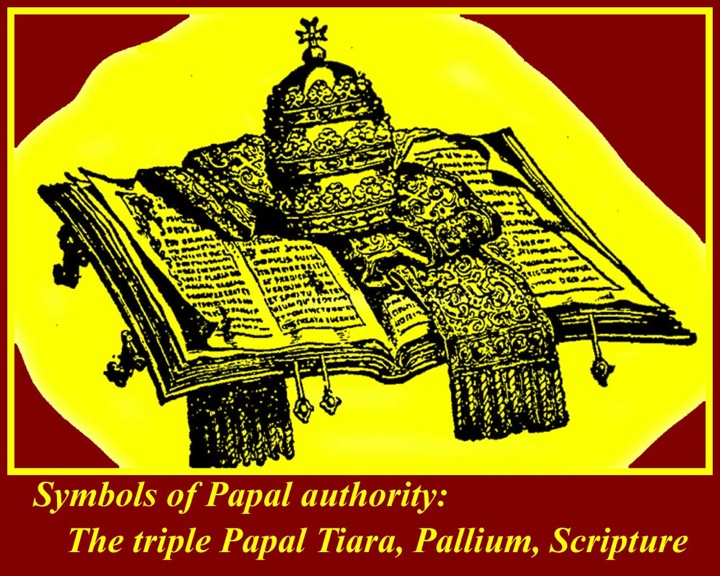
http://www.mmdtkw.org/RenRom0402-PapalSymbols.jpg
http://www.mmdtkw.org/RenRom0403-JuliusBanner.jpg
Some of the symbols of papal authority. See also http://en.wikipedia.org/wiki/Papal_regalia_and_insignia.
http://www.mmdtkw.org/RenRom0404-Hardhat.jpg
The Catholic Church has never claimed to be democratic. In fact, at the time of its its founding, "democracy" was universally deemed to be the most undesirable of all possible governing systems; the demos was the wild and uncontrollable mob, and democracy meant "mob rule" with no protection for individuals or minorities. That's why the US was organized as a "democratic republic" -- the "republic" part implies individual and minority rights guaranteed by a constitution.
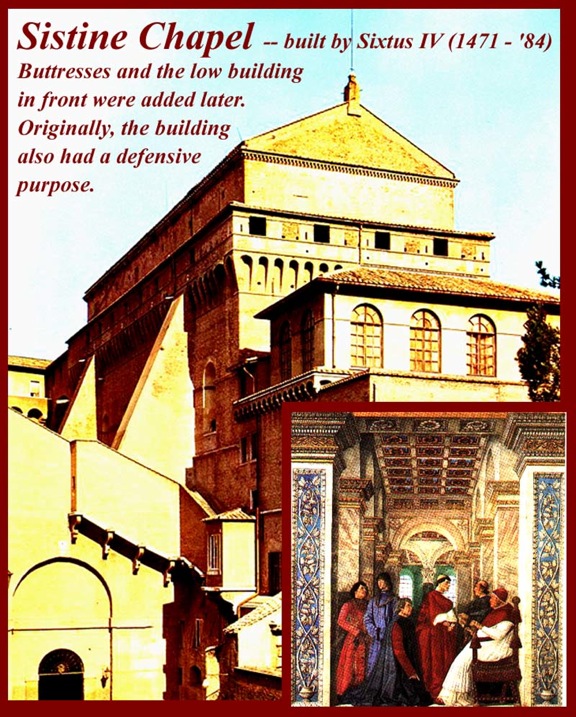
http://www.mmdtkw.org/RenRom0405-SixtusSistineExt.jpg
http://www.mmdtkw.org/RenRom0406-SistineInterior.jpg
The Sistine Chapel (Italian: Cappella Sistina) is the best-known chapel in the Apostolic Palace, the official residence of the Pope in Vatican City. It is famous for its architecture, evocative of Solomon's Temple of the Old Testament, and its decoration which has been frescoed throughout by the greatest Renaissance artists including Michelangelo, Raphael, Bernini, and Sandro Botticelli. Under the patronage of Pope Julius II della Rovere, Michelangelo frescoed 12,000 square feet (1,100 m2) of the chapel ceiling between 1508 and 1512. Michelangelo resented the commission, but today the ceiling and the Last Judgment fresco on the wall above the chapel altar are widely believed to be Michelangelo's crowning achievements in painting.
The chapel takes its name from Pope Sixtus IV della Rovere, who restored the old Cappella Magna between 1477 and 1480. The Sistine chapel, built to the measurements of the Temple of Jerusalem (as given in the Bible) became the formal papal chapel, but it also had a defensive mission; the walls are thick, the (now roofed) cornice walkway, and the attic level Swiss Guard wardrooms and barracks (now disused) all were designed to make the chapel an impregnable structure. During the Sixtus IV period a team of painters that included Pietro Perugino, Sandro Botticelli and Domenico Ghirlandaio created a series of frescoed panels depicting the life of Moses and the life of Christ, offset by papal portraits above and trompe l’oeil drapery below. These paintings were completed in 1482, and on August 15, 1483,[1] Sixtus IV consecrated the first mass in honor of Our Lady of the Assumption.
Since the time of Sixtus IV, the chapel has served as a place of both religious and functionary papal activity. Today it is the site of the Papal conclave, the process by which a new Pope is selected.
For more on the Sistine Chapel, see http://en.wikipedia.org/wiki/Sistine_Chapel and links on that page including http://www.christusrex.org/www1/sistine/0-Tour.html, which has good images of all the Sistine Chapel frescoes.
http://www.mmdtkw.org/RenRom0406a-SistineMusc.jpg
A Renaissance view of a Sistine Chapel ceremony. The pope is enthroned on the raised platform to the left, and the cardinals are ranked in front of the transverse wall. Other members of the curia are seated on risers inside the wall, and spectators stand outside the wall. The chapel choir is in the choir balcony in the wall opposite the pope's throne. The painting on the wall behind the altar at the far end is Michelangelo's Last Judgment (at http://picasaweb.google.com/lh/photo/DIqUBxguzFbetha-NsZCCg).
http://www.mmdtkw.org/RenRom0407-VaticanLibrary.jpg
Although the Vatican library was founded by Nicholas V Parentucelli, it was Sixtus IV della Rovere who made it the repository for ancient and humanist works.
http://www.mmdtkw.org/RenRom0408-CallixIIIBorgia.jpg
Calixtus III was the first of the Borgia popes, and the Spaniard is acknowledged by most historians to have been a man of lofty ideals and of boundless courage, energy, and perserverance. He did nothing that the people viewed as unusually bad. His heirs were well taken care of both in terms of wealth and continued employment. It was Callixtus who had, as a Cardinal, negotiated the end of the Western Schism. Not all Borgias were bad. See http://en.wikipedia.org/wiki/Pope_Callixtus_III and http://www.newadvent.org/cathen/03187a.htm and http://www.mmdtkw.org/VBorgias.html.
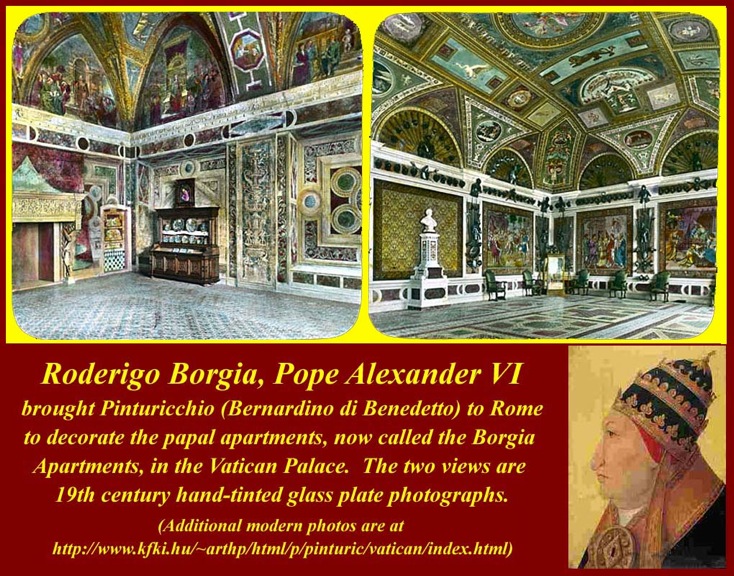
http://www.mmdtkw.org/RenRom0409-BorgiaApt.jpg
http://www.mmdtkw.org/RenRom0410-BorgiaResurectio.jpg
But some Borgias were definitely bad, and Roderigo -- Pope Alexander VI Borgia -- was one of those. His corruption and immorality was legendary (although even that was exagerated by his enemies and thier toady historians like Steffano Infessura.) Alexander VI did patronize artists, but his biggest project was to have Pinturicchio paint Alexander's own apartments in the Vatican. After the Reign of Alexander, Julius II della Rovere refused to live in the Vatican apartment which was the scene of Alexander's debauchery. Instead, he had Raphael design a completely new set of apartments, which are now known as the Raphael Vatican Stanze.
http://www.mmdtkw.org/RenRom0411-CesareLucrezia.jpg
The two most famous Borgias were Cesare and Lucrezia, a son and the only daughter of Pope Alexander VI. They were both, of course, illegitimate, but popes have often claimed the right to "legitimize" bastards including their own. Alexander first made Cesare a Cardinal, but, when Cesare's older brother died, Cesare gave up his red hat and became Alexander's military commander and hatchet-man. Poor little Lucrezia, not much more than a child, was made the pawn od Alexander and Cesare in a series of political engagements and marriages. Her first betrothal, to a Spaniard, was annulled. Her first husband died suddenly, shortly after becoming a political non-entity. Her second husband was killed by Cesare after an earlier botched attempt which left him wounded on the steps of St. Peter's Basilica. Her third marriage, to the D'Este Duke of Ferrara before she was 20, was long and happy, but only because her father had died and Cesare had been chased out of Italy by the succeeding Popes. Lucrezia became the much admired matron of the Ferarra duchy where she kept her salon for almost 20 years, becoming the patroness of Ariosto and becoming known as the Duchess of Music for her patronage of Renaissance composers and musicians. Her false reputation as a poisoner was made up by later literary hacks and scandal mongers. It's still used by similar folks to make a buck.
http://www.mmdtkw.org/RenRom0411a-LucreziaPoisonCartoon.jpg
That famous bare-breasted picture of Lucretia (see above), by the way, is another girl entirely. It is used, however, by the modern city fathers of Ferarra to attract tourists. We will look into Lucrezia again in the last unit of this course.
http://www.mmdtkw.org/RenRom0412-FrancisBorgia.jpg
As we have seen, there were good and bad Borgias, and, later, this late 16th century Borgia became the head, or "the General", of the Jesuits. The last notable Borgia was another one of the good ones.
http://www.mmdtkw.org/RenRom0413-SixtusV.jpg
Sixtus V, Felix Peretti, reigned from 1585 to 1590 and is considered an "Early Baroque" pope. He had been a Franciscan monk and was already old -- but still vigorous -- when elected. In his short five years as pope, he remodeled Rome by opening up wide straight avenues connecting the city's great pilgrimage churches. At each church he erected on of the fallen obelisks that the ancient Romans had looted from Egypt. The idea was that pilgrims would be able to look down the new roads and see the next church on the pilgrimage route, a circumstance that rendered redundant the crooked "Cicerone" guides, who had been swindling the pilgrims.
Sixtus V also knocked the bottom out of the local "indulgence" racket by declaring that anyone could get a plenary indulgence -- remission of all purgatorial punishment for him or herself of for a deceased friend or relative -- by uttering a few simple prayers in any one of Rome's numerous churches.
Finally, Sixtus V permanently destroyed the ability of any one Roman family to get control of the papal establishment. He did this by establishing the Church's 15 "congregations" -- bureaucratic divisions -- and handing them out piecemeal to those same families. Each family thereafter rigourously guarded its own piece of the action, and thereafter no single family could get control of enough congregations to monopolize curial patronage.
The Peretti family was extremely poor, and Felix was said to have been born in a hut so poorly thatched that sunlight streamed through to the inside. Sixtus later joked that he had therefore come from an "illustrious family".
See http://en.wikipedia.org/wiki/Pope_Sixtus_V and http://www.newadvent.org/cathen/14033a.htm and http://romeartlover.tripod.com/Sisto.html.
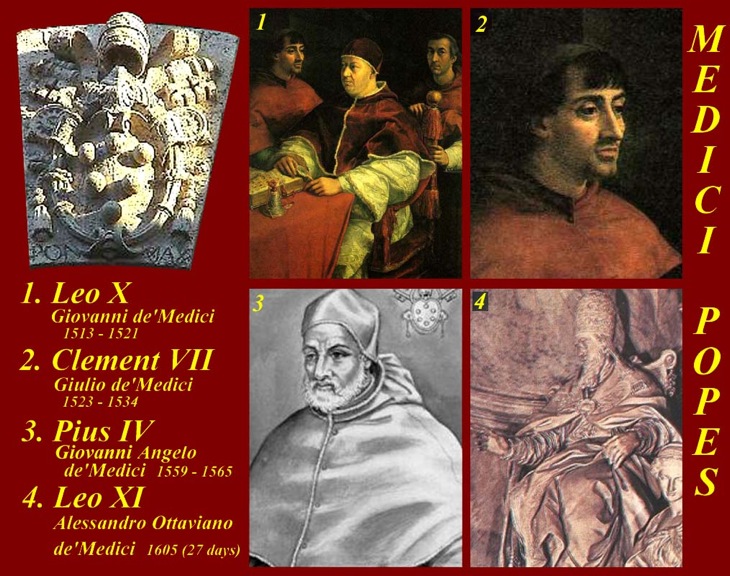
http://www.mmdtkw.org/RenRom0414-MediciPopes.JPG
http://www.mmdtkw.org/RenRom0415-VillaMedici.jpg
The Florentine bankers, including the Medici, opened branches on the Via dei Banchi in Rome and fairly quickly the center of their operations shifted from Florence to Rome. There were two reasons for this shift: there were bigger profits to be made in Rome after the Vatican regained control of and regularized taxation in the Papal States; and Rome was more secure as nascent European states started to push down into Italy. The Medici went for "the full monty" and moved thier whole establishment south even winning the papacy. There were four medici popes, but only the first two amounted to anything. Villa Medici on the Pincian Hill is now the French Academy in Rome.
"The full monty" comes from an Italian card gambling term "tutti il monte". A "monte" was any "heap" or "mound" or "amount" of money with a purpose. There were "montes secularis" and, later, "montes pietatis" -- funds set aside or "piled up" for secular or "pious" purposes. Some of the "montes" were endowed, some were supported by governments (either by taxes or from general funds), and some by organizations (e.g., guilds, fraternities, or confraternities. Fraternities, by the way, were set up to benefit their own members, while confraternities were membership organizations that were supposed to benefit persons other than the members.)
In gambling you could bet against part of the "monte" (the total that all players had piled in the middle of the table) or against "tutti il monte", i.e., "the full monty".
Similar terminology was involved in the governance of tontines, some of which provided for division of the "monte" among survivors after a certain number of years, others for decisions on whether to divide after a certain number of years had elapsed, and finally, some which continued until only one of the contracting members survived to receive "tutti il monte".
Monte, mountain, mound, amount (= Latin: ad montis) are, of course, all cognates.
http://www.mmdtkw.org/RenRom0416-JuliusII.jpg
Julius II, as mentioned above, is mostly remembered from Irving Stone's fiction The Agony and the Ecstasy and from the movie of the same name. He should really be remembered as the warrior pope who finally regained control of enough of the papal states to raise papal revenues (although he did spend a lot on military adventures). Like other art patrons, he liked to see himself in pictures.
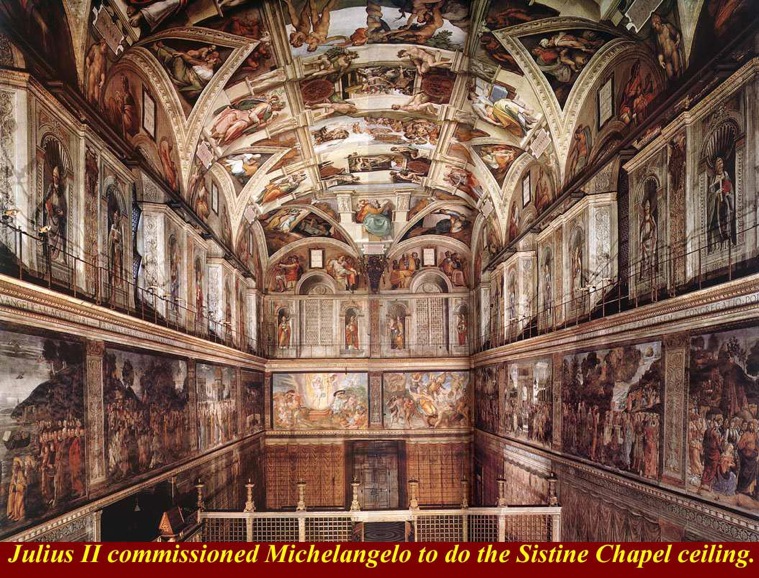
http://www.mmdtkw.org/RenRom0417-SistineCeiling.jpg
http://www.mmdtkw.org/RenRom0418-SistIsiahRosie.jpg
Julius had Michelangelo repaint the Sistine Chapel ceiling, and among the images surrounding the central biblical panels, Michelangelo painted Old Testament prophets and pagan Roman and Greek sibyls (prophetesses). The Sibyls were included, because, by careful if sometimes corkscrew interpretation, Renaissance humanists had convinced themselves that the pagan Sibyls had somehow been inspired to predict the arrival of Jesus and the rise of Christianity. It was akin to modern belief that Nostradamus predicted an airplane attack on the pentagon. (Of course, belief in Biblical prophecy much less dubious.) Accurate or not, because of their proto-Christian prophecy the sibyls became a feature of Renaissance art. The prophets and siblyls in the Sistine Chapel have been the inspiration for art ever since they were painted. As seen in the image above, Norman Rockwell's famous World War II Rosie the Riveter is closely modeled on Michelangelo's Sistine Prophet Isaiah.
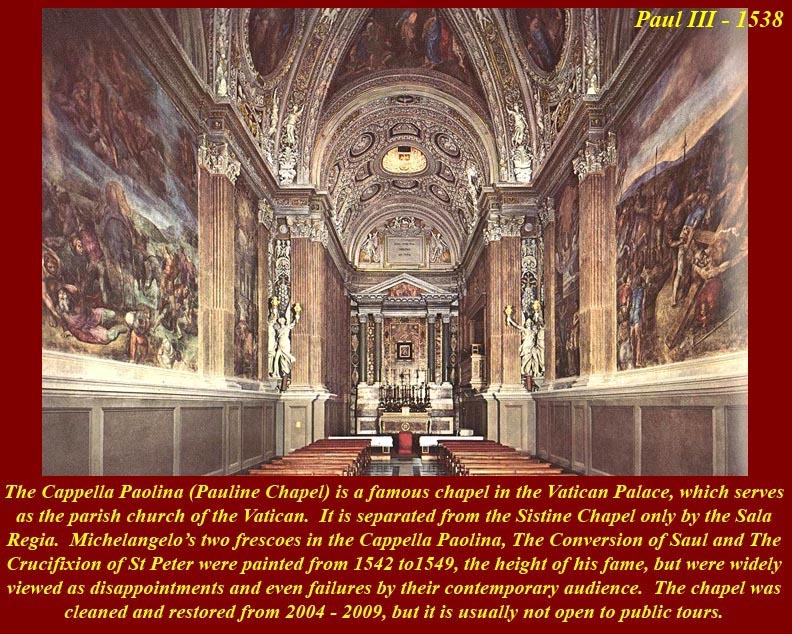
http://www.mmdtkw.org/RenRom0418a-Paolina.jpg
http://www.mmdtkw.org/RenRom0418b-MichelangeloPaulineFrescoes.jpg
Michelangelo's "agony " did not end when he finished the ceiling for Julius. His arm was later twisted to do the Last Judgment above the Sistine chapel alter and to provide the two major frescoes in the adjacent "Pauline" chapel. He did manage to insert himself into both of the "Paolino" frescoes as he had done with his earlier frescoes. The Paolino, which serves as the Vatican parish church has not been open to tourists. Its multi-year restoration was completed in 2009.
http://www.mmdtkw.org/RenRom0419-RaphaelMilvio.jpg
While Michelangelo was busy in the Sistine Chapel, Julius II kept Raphael at work in what are now known as the Vatican Stanze. Raphael's Battle of the Milvian Bridge (the defeat and death of Constantius and the triumph of Constantine) was painted to look like a tapestry, and it features muscular almost nude male figures, a convention adopted by Raphael and later mannerists after Raphael had seen Michelangelo's nude and semi-nude male and female figures in the Sistine chapel ceiling. (many of Michelangelo's and Raphael's ignudi were later clothed by painters working on the orders of Pope Paul IV and later prudish popes. That desecration has only recently been corrected during the recent restorations.
Papal Ceremonies
What the ancient Romans had done with "bread and circuses" the Renaissance popes did with papal ceremonies and carnivals. A large part of the expression of papal authority was the progression of papal ceremonies. To a great extent, this satisfied the Roman underclasses and provided spectacles for visiting dignitaries and pilgrims. This still works today.
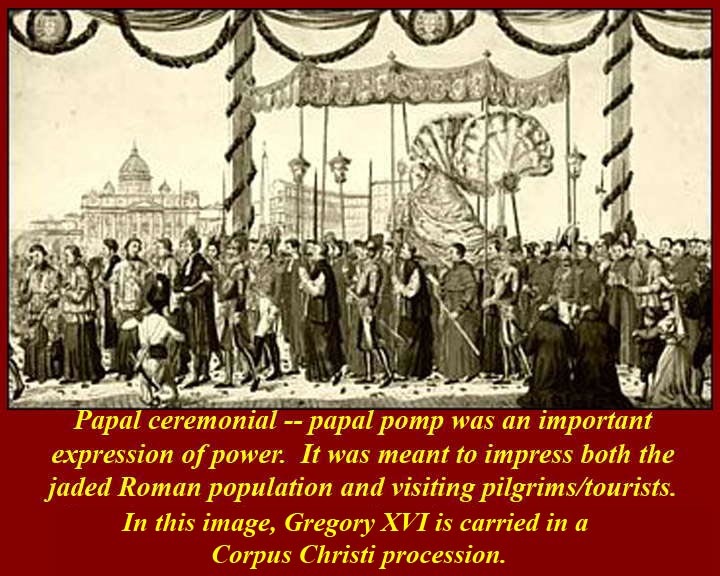
http://www.mmdtkw.org/RenRom0420-CorpusChristiGregoryXVI.jpg
http://www.mmdtkw.org/RenRom0421-PapalProcession.jpg
One of the important annual ceremonial spectacles on the papal calendar in the Renaissance was the Corpus Christi procession celebrated usually on the second Thursday in June in Rome (the feast is often moved to the Next Sunday in English speaking countries.) Pictures of modern Roman Corpus Christi spectacles are below.
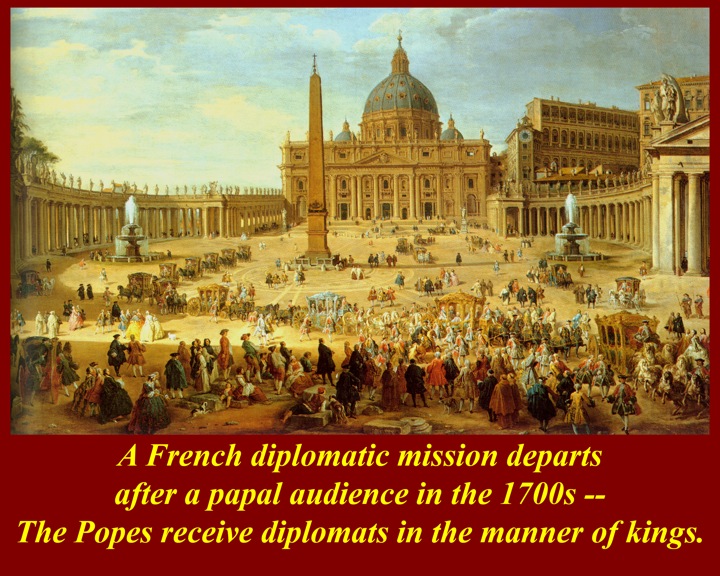
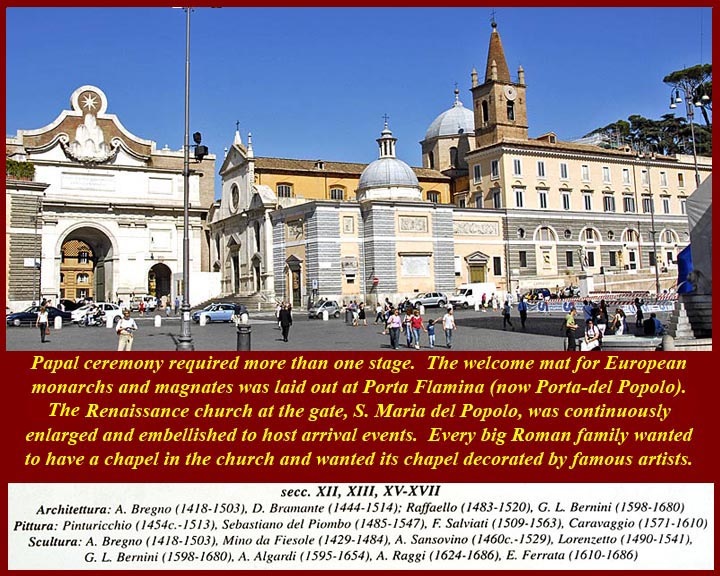
http://www.mmdtkw.org/RenRom0422-PopeReceivesEnvoy.jpg
http://www.mmdtkw.org/RenRom0423-SMdelPopolo.jpg
http://www.mmdtkw.org/RenRom0424-RephaelSMariaDelPopolo.jpg
Popes received diplomatic missions and visiting dignitaries with royal pomp. Papal dignitas always had to overshadow visitors -- even royal visitors. If the visitor was (is!) important or rich enough he or she would be greeted on arrival inside the Porta del Popolo at the northern edge of the Aurelian walled city (and, more rarely, even outside the gate). Santa Maria del Popolo church, just inside the gate, benefited from all the ceremony on its doorstep -- all the big Roman families wanted somehow to endow the church, and, if enough wealth was available. they wanted to enlarge the church with a family chapel. The most famous of the S. Maria del Popolo was designed and partially decorated by Raphael for his friend and patron Agostino Chigi, a Sienese banker (while he was simultaneously working on the Vatican Stanze for Julius II.) The entrance fresco features those pagan sibyls again. See http://en.wikipedia.org/wiki/Chigi_Chapel for the Chigi Chapel and the Popolo Project starting on page 690 (http://rubens.anu.edu.au/popolo/database/new/00690.html) for other S. M. del Popolo art and architecture in detail.
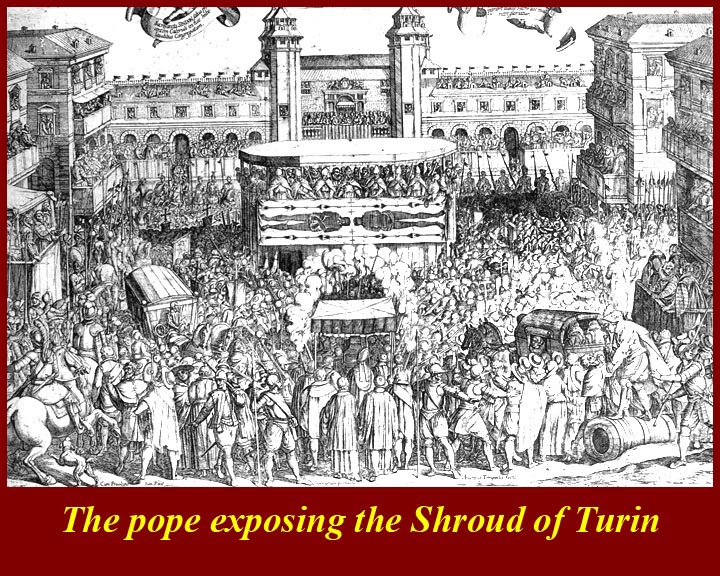
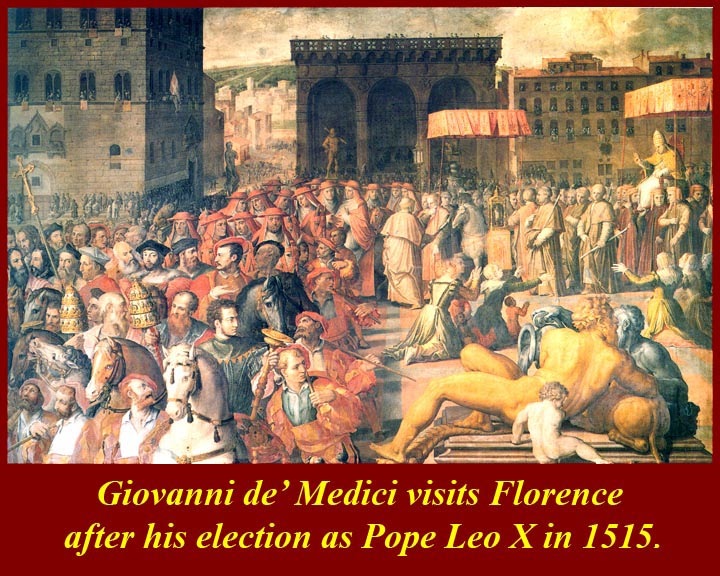
http://www.mmdtkw.org/RenRom0425-TurinShroud.jpg
http://www.mmdtkw.org/RenRom0426-LeoXMedici.jpg
http://www.mmdtkw.org/RenRom0427-TrueCrossVenice.jpg
There's always something to celebrate -- or "any excuse for a party". Exposure of the Shroud of Turin, Leo X Medici on his first trip home to Florence, and a piece of the True Cross arrives in Venice.
http://www.mmdtkw.org/RenRom0428-BenedictXmas2008.jpg
Benedict XVI at Xmas, 2008.
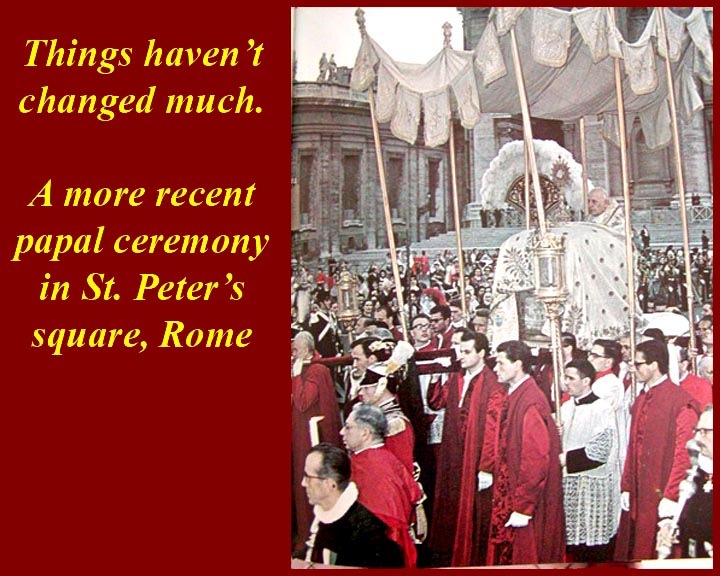
http://www.mmdtkw.org/RenRom0429-ModernCorpusChristi.jpg
http://www.mmdtkw.org/RenRom0430-PopeTruckCorpusChristi2009.jpg
The pope is still carried for short distances by man-power, but for longer distances his chair and canopy are motorized as in the images of his modern cross town Corpus Christi procession.
http://www.mmdtkw.org/RenRom0431-PopeLourdes.jpg
Papal foreign travel with accompanying pomp has become a commonplace in recent years. Here the Pope visits Lourdes in France.
http://www.mmdtkw.org/RenRom0431a-BullfightFarnese.jpg
Not all Renaissance spectacles were papal, although all certainly would have had papal sanction. Above is an image of a bull fight in front of the Palazzo Farnese (now the French Embassy in Rome). There were also horse races during the pre-Lenten Roman Carnivale from Piazza del Popolo to Piazza Venezia on the Via del Corso (= "Race Street") and, at various times prostitutes, Jews, cripples, and little people were made to run the same course (= corso) -- all in "good fun" for the edification of the people and the enjoyment of the Popes, who watched the ends of the races from the Palazzo Venezia.
What happened if you raised your head?
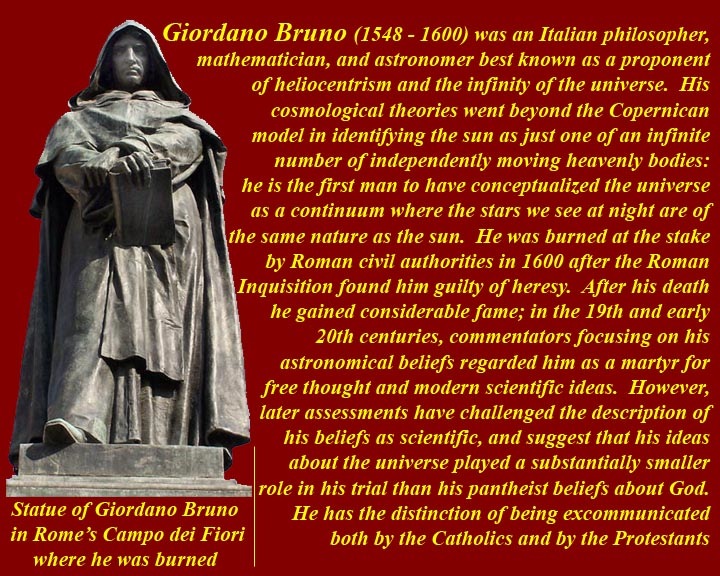
http://www.mmdtkw.org/RenRom0432GiordanoBruno.jpeg
http://www.mmdtkw.org/RenRom0433-Galileo.jpg
We will look into the burning of Giordano Bruno and the house arrest of Galileo in Unit 10. Suffice it to say, for now, that it was very dangerous to get crosswise of the popes and the Holy Inquisition.
http://www.mmdtkw.org/RenRom0434MoreBlueCartoon.jpg
Papal kibitzing was probably no worse than what all patrons have always done.
definition: kib·itz (kbts)
intr.v. kib·itzed, kib·itz·ing, kib·itz·es {Informal}
1. To look on and offer unwanted, usually meddlesome advice to others.
2. To chat; converse.
[Yiddish kibitsen, from German kiebitzen, from Kiebitz, pewit, kibitzer, from Middle High German gbitz, pewit, of imitative origin.]
RenRom0500-outline
Literature -- Unit 5http://www.mmdtkw.org/RenRomUnit05Literature.html
Above: one of the finest books printed in the Italian Renaissance, and indicative of the cosmopolitan spirit spreading from Rome. Dante's Divine Comedy -- Written by a Florentine, edited (=presented, i.e., made authentic and whole) by a Roman humanist (Pietro Bembo), and printed in Venice (at the Aldin Press of Aldo Pio Manuzio.) The intense colors are often referred to as "Venetian".
"Terze Rime" (in the box on the "cupids" page -- actually they are "putti") is a rhyming system involving "tercets" -- three line groups ( just as "couplets" have two lines). The rhyme system is ABA BCB CDC DED EFE FGF GHG HIH , etc.: The first and third lines of any tercet had to rhyme with the second line of the preceding tercet. Lines had ten or eleven syllables and consistency in the number of syllables was valued.
Topics for Unit 5
Philology = study of and commentary on ancient texts. In Rome, it was initially oriented toward biblical and patristic texts. The main idea was to strip away Medieval nonsense.Latin, Greek, and Hebrew linguistics. To get the texts right, you had to know the languages, and both denotation and connotation were important. To learn the languages you had to study other (non-religious) classical literature. And two things became apparent almost immediately: (1) Patristic language use was vastly substandard (Jerome's Vulgate (Latin) Bible, for example, was in really low class Latin, and it may have been intentionally so to make it more "accessable"); and (2) the non-religious classics were deeper and more interesting.
Sibyline parallels. It didn't take long before Sibyline prophecies had equal weight with biblical ones. Parallels were rife, and with imaginative interpretation (and a little squinting of the eyes) you could determine that the Sibyls had predicted the coming of Christ and many other religious events. This was immensely popular with the Romans and other Mediterranean types, but the northerners thought it was absurd and, ultimately heretical -- one of the complaints of the Protestant reformers.
Cicero's Latin. Whatever you wrote about, analyzed, recast, it had to be in correct and elegant Latin (initially -- later, equally "correct" and elegant Italian was needed) and the only really correct Latin was Cicero's. Why his? Because he had polished, re-edited (i.e., after delivery), and self-published and publicized every speech he had ever given. He was the consumate self-promoter, sending, for example, free copies of his emmissions to the rhetorical schools in Roman cities. Even in his own time he had been known as the standard in eloquent oratory.
Getting beyond the ancients. Some humanists decided early on that there were new, or at least more important, subjects worthy of their talents. This often amounted to whatever a patron might pay for.
Manuscript to print-run. First, writing in the author's own hand -- old books might be copied by a scribe, but interpretation, correction (i.e., removal of acretions and scribal errors) required a humanist philologist. Original material was written by the author and then handed to trusted scribes who could make presentation copies for the patron to have and hold or to distribute. The arrival of the printing press changed the dynamic. There were still commissioned books, but the commission might be for a work to be printed rather than copied by hand. Many more copies were available.
Aldo Pio Manuzio and the Aldine Press in Venice, and his competition.
Neo-Latin writings and high class vernacular.
Bessarion and the reintroduction of Platonism and other Greek stuff.
Pseudonymic writing to avoid the attention of the Inquisition. You could go too far, and if you did it was better to do so anonymously. Mysterious Palingenius, the "eastern mage". Burning Pierangelo Manzolli's bones.
Slipping into the back door of heaven: Pietro Bembo reformed and reinvented. After a raucous, sordid, "pagan" life and "indexed" (condemned) works, at 69 he is made a Cardinal and devotes his last years to religious subjects.
Raffaello Maffei: a type -- kept his nose clean and is unknown.
Women and poetry. Not content to be the subject of male poetry, some women wrote their own, and did it equally well: Veronica Gambara, Vittoria Colonna, and the "infamous" Veronica Franco.
Internet links for Unit 5
http://WWW.IntraText.COM/ITA/ the Catalog of Italian Language works from the IntraText digital library (The entire catalog is at http://WWW.IntraText.COM/Catalogo/
http://www.uni-mannheim.de/mateo/desbillons/aport.html Boissard/Bry engravings of Renaissance personages, including some of our literati.
http://math.dartmouth.edu/~matc/Readers/renaissance.astro/0.intro.html heliocentrism and its progress. one of the subjects of Renaissance literature -- Palengenius, for example, covered the subjec taking, essentially, the heliocentric line, and that's probably why they burned Manzolli's bones.
http://www.loc.gov/exhibits/vatican/humanism.html the Rome Reborn on-line exhibition of Renaissance books, mounted by the US Library of Congress and the Vatican Library.
http://andromeda.rutgers.edu/~jlynch/Papers/dict2.htmlFalse Refinement and Declension:Johnson on the History of the Language, a paper by Jack Lynch, delivered at Samuel Johnson and the Languages of Literature: The First Annual Conference of the Johnson Centre, 12 September 1997, Birmingham, UK.
http://www2.warwick.ac.uk/fac/arts/ren/snls/neolatintexts/ on-line Neo-Latin texts
Ariosto/Orlando
Furioso
http://www.newadvent.org/cathen/01712b.htm
http://WWW.IntraText.COM/Catalogo/Autori/AUT27.HTM
http://sunsite.berkeley.edu/OMACL/Orlando/
Boiardo/Orlando
Inamorato
-- of which the Furioso was the sequel
Bessarion
http://en.wikipedia.org/wiki/Basilios_Bessarion
http://www.newadvent.org/cathen/02527b.htm
Jacob Burckhardt:
Palingenius
http://www.archive.org/details/zodiacusvitaeofm00wats Zodiacus Vitae full text
http://math.dartmouth.edu/~matc/Readers/renaissance.astro/4.0.Palingenius.html
Women
Poets: http://home.infionline.net/~ddisse/index.html
-- links to passages from over 125 women writers. The
entries are on women who produced a substantial amount
of work before 1700, some or all of which has been
translated into modern English. Each entry will tell you
about the print sources from which the translated
passages are taken; it will also tell you of useful
secondary sources and Internet sites, when those are
available.
Veronica
Gambara
http://www.JimandEllen.org/vgpoetry/shady.hill.html
http://home.infionline.net/~ddisse/gambara.html
Vittoria
Colonna
http://www.jimandellen.org/vcpoetry/vctitle.htm
http://home.infionline.net/~ddisse/colonna.html
Renaissance Rome
Unit 5 Slides
http://www.mmdtkw.org/RenRomUnit0500-0PixList.html
Roman Renaissance Literature
Click on links or small images below to go to larger images for Unit 5.
Classical sources added to biblical and patristic sources
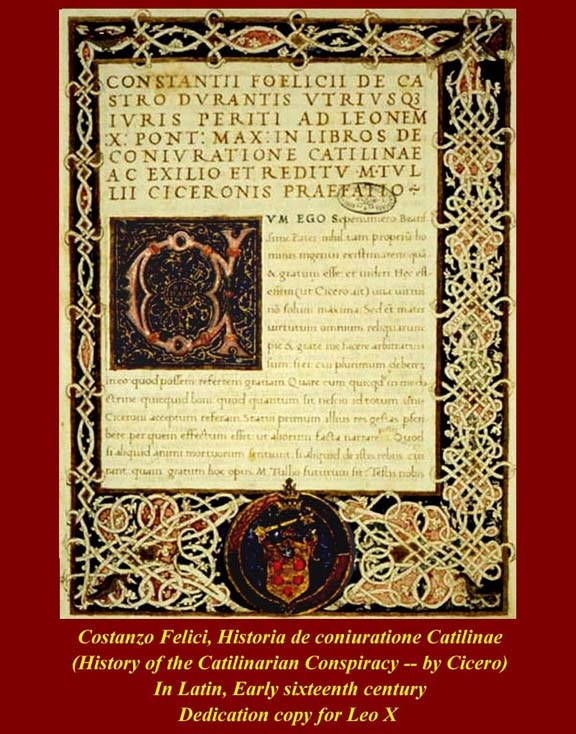
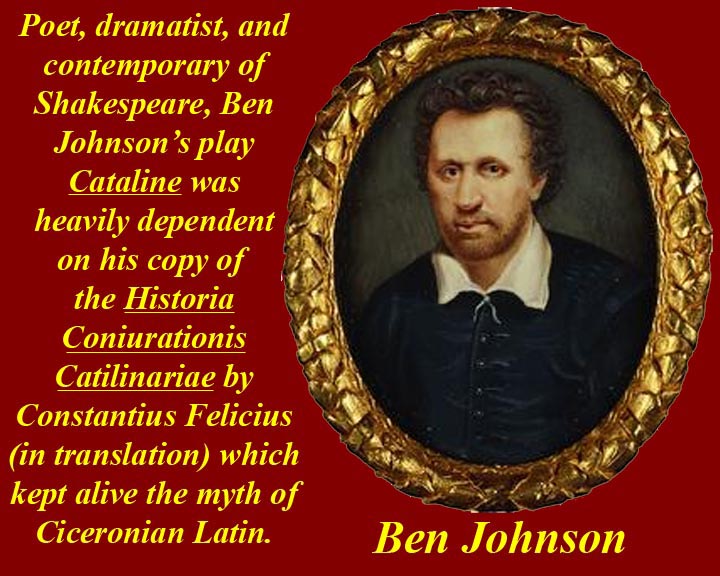
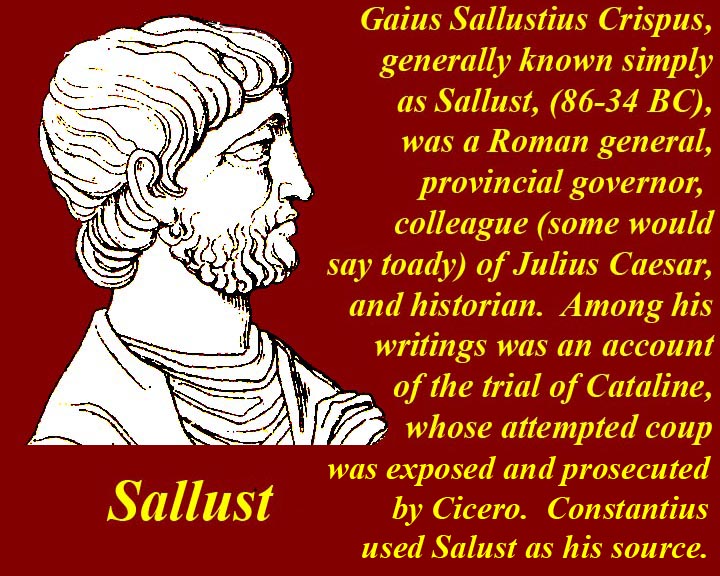
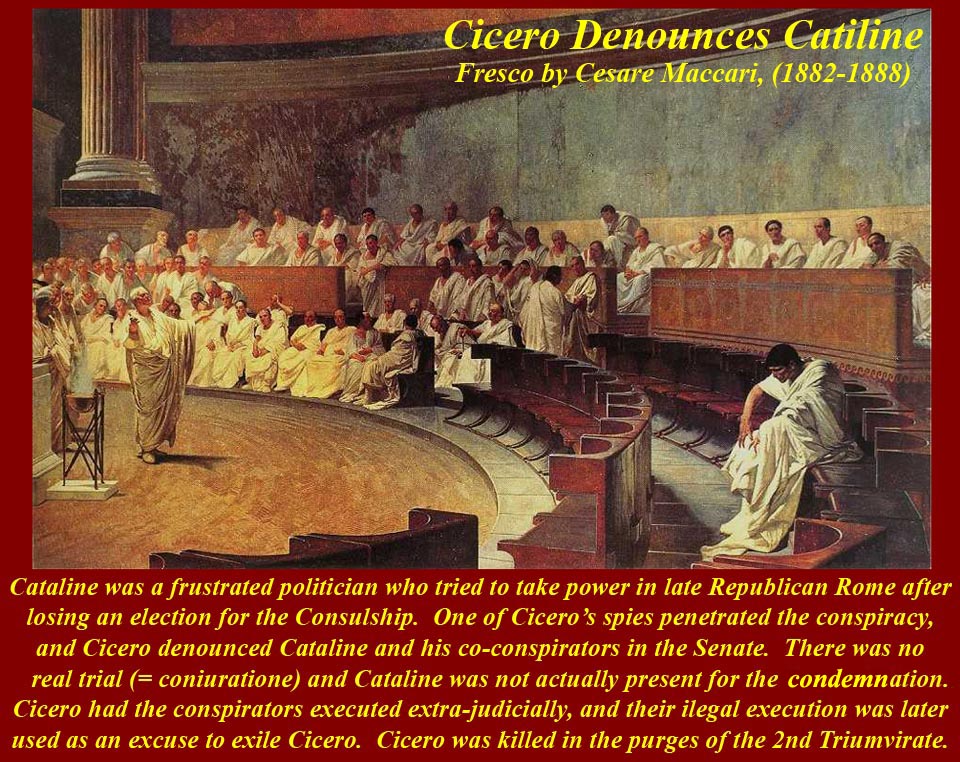
http://www.mmdtkw.org/RenRom0501-FeliciCiceroCata.jpg
http://www.mmdtkw.org/RenRom0501a-CiceroCatalineDenunciation.jpg
http://www.mmdtkw.org/Renrom0501b-Sallust.jpg
http://www.mmdtkw.org/RenRom0501c-CiceroCatalineMaccari-.jpg
http://www.mmdtkw.org/RenRom0501d-Cicero.jpg
Scholarship, before the arrival of humanist philologists (from Greek: philo=love [of the] logos=word), had concentrated on biblical and patristic sources ("patristic" meaning the works of the Greek and Latin "Fathers of the Church"). The humanists added classical Roman and Greek materials to the scholarly repertoire -- and Latin source materials dominated their initial efforts. Because Ciceronian Latin was considered the best and most elegant form of the language, there was a natural emphasis on ancient materials about Cicero himself. That's what was at work here with an account by "Constantius Felicius" of the prosecution by Cicero of Cataline, a failed coup-plotter, drawn from an earlier account of the same prosecution, which had been written by Cicero's contemporary, the historian Sallust. Constantio Felici, of course, emulated Cicero's own elegant Latin style -- Felici, in the style of his own humanist circle, even gave himself an elegant Latin name.
There is, of course, a circularity in "Ciceronianism", and it started with Cicero himself. Cicero was a notorious self promoter -- and a pompous speechifier, a shyster lawyer, and an ambitious politician. The reasons, during the Renaissance, for the availability, popularity, and respect for Cicero's highly rhetorical speeches and court appearances (prosecution and defense) and of his written works were that (a) he and his assistant, Tiro, re-edited after delivery his every public utterance to make sure it was elegant and error free (kind of like what our legislators do for the Congressional Record, but they do it less skillfully), and (b) he bought large runs of manuscript copies of his rhetorical and written output, and he distributed them to major centers around the Roman hegemony. He also gave copies to Roman grammar schools thus ensuring that they would be studied and copied by students. Cicero's own widespread distribution system and the existence of large initial numbers of copies made it inevitable that more copies of Ciceronian works would survive into the Renaissance period than copies of the speeches or works of other people. It would then also be inevitable that the starry-eyed humanists would think that the plethora of "Ciceronian" documentation that had survived and which the humanists were able to recover reflected an actual ancient Roman preference for Ciceronian Latin rather than being a reflection of Cicero's self promotion. The "Ciceronian" humanists may, in fact, have been correct; Ancient Rome really may have had great respect for Cicero's Latin and may have considered it as Latin's most elegant form -- certainly, rhetoricians who followed Cicero copied his style. But something else might also be at work here: Renaissance "language snobs" falling in line behind Ancient Roman rhetors of the same ilk.
Cicero's end: After delivering his Philippics -- speeches against Mark Antony -- Cicero witnessed and then felt the burden of the temporary alliance of Octavian (Augustus), Antony, and Lepidus in the Second Triumvirate. The Triumvirate initiated immediate purges, and Antony put Cicero's name on the proscription list. Cicero fled, but bounty hunters caught up with him on his way to his refuge/villa in Ostia. They brought his head and hands back to Rome where they were displayed and defiled on the rostrum in the city's Republican Forum.
We are no less guilty of language snobbery. We revere, but we seldom, if ever, use, Shakespearean English and "the King's English" (i.e., the English of the King James Bible).
Sibylline prophecies made equal to biblical prophecies
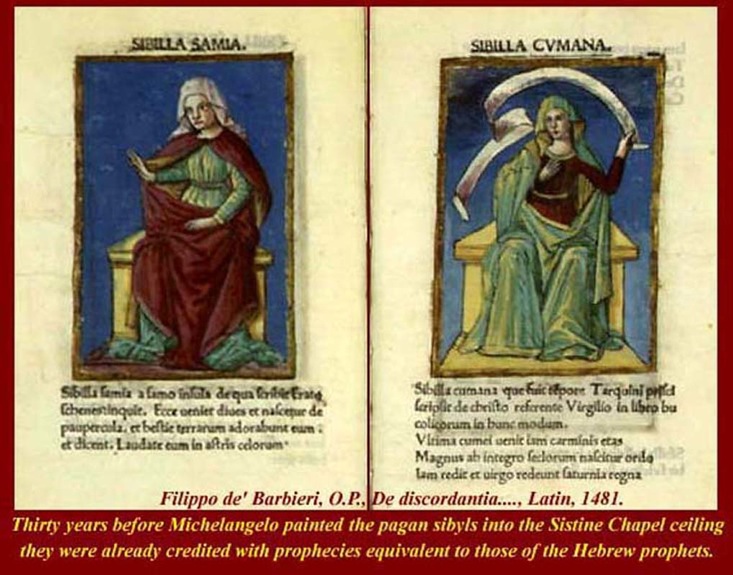
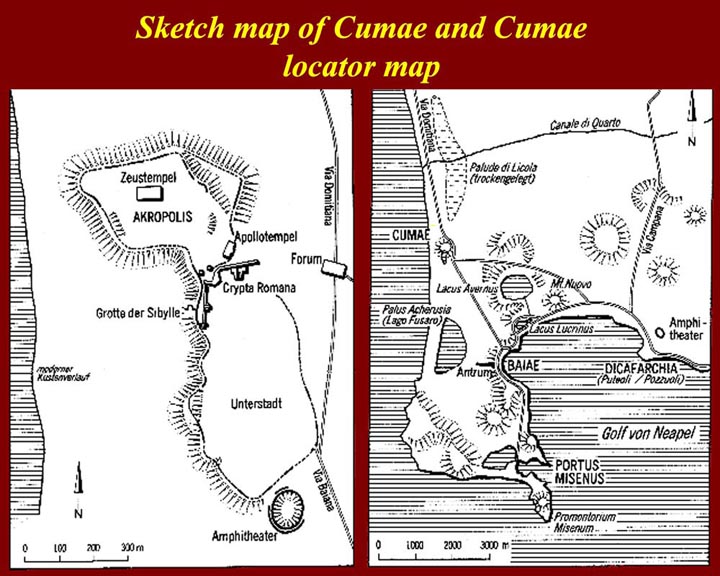
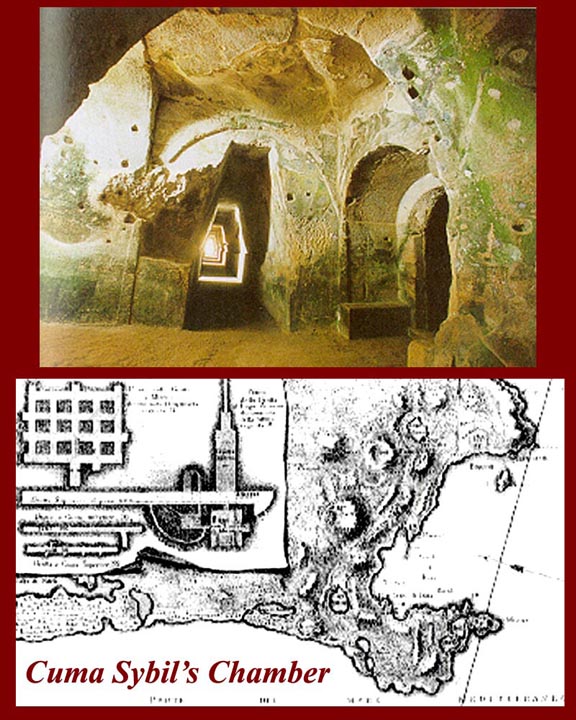
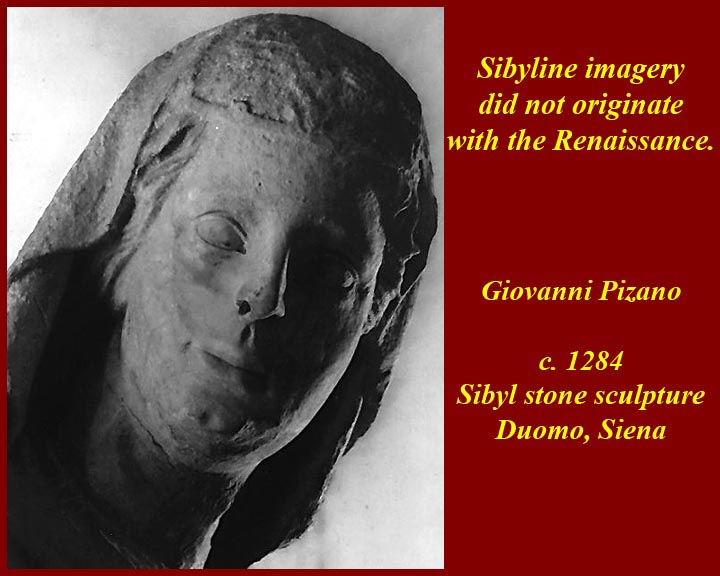
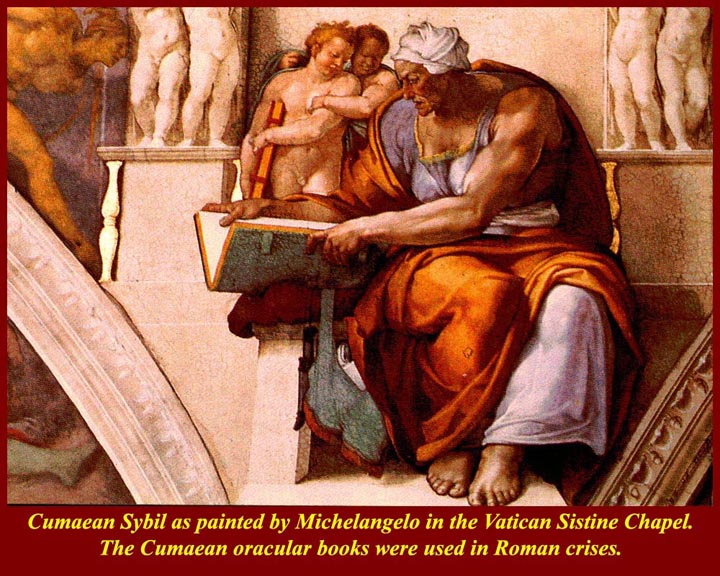
http://www.mmdtkw.org/RenRom0502-SibylineProphecy.jpg
http://www.mmdtkw.org/RenRom0502a-CumaeMaps.jpg
http://www.mmdtkw.org/RenRom0502b-CumaeSybilChamber.jpg
http://www.mmdtkw.org/RenRom0502c-CumaeSybilCave.jpg
http://www.mmdtkw.org/RenRom0502d-SienaDuomoSibyl.jpg
http://www.mmdtkw.org/RenRom0502e-CumaeSybilMichelangelo.jpg
http://www.mmdtkw.org/RenRom0502f-TiburtineSybil.jpg
As we noted in the last unit, the ancient Greek and Roman Sibyls were enshrined in Roman Renaissance art. But their supposed prophecies were also the subject of Renaissance humanist exegesis. The word "supposed" in the previous sentence is double-barreled: first you have to believe in their ability to prophesy at all and then you have to believe the provenance of the texts and glosses used by the humanists.
The story of the acquisition of the Sibylline Books by King Tarquinius is one of the famous mythic elements of Roman history. The Cumaean Sibyl (a Greek "colonial" Sibyl) offered to sell nine books of these prophecies to Tarquinius. He declined to purchase them, owing to the exorbitant price she demanded, so she burned three and offered the remaining six to Tarquinius at the same stiff price, which he again refused. She burned three more and repeated her offer. Tarquinius then relented and purchased the last three at the full original price and had them preserved in a vault beneath the temple of Jupiter Capitolinus. The books, however, were lost when the Temple burned in 83 BC, and, a few years later, envoys were sent out to collect "similar sayings" from Mediterranean oracular sites and from the local (as opposed to Greek) Sibyl at Tiburtina (modern Tivoli). She was being puffed by the Marcii clan that came from Tiburtina. "Experts" said the new set of oracular sayings matched up pretty well with the old set, so those collected prophecies became the Sibylline books. Those "new" books were finally burned by order of the Roman General Flavius Stilicho (365-408 C.E.). There were, of course, forgeries over the centuries, and the provenance of the prophecies discovered by the Renaissance humanists was more than extremely shaky. None of the "original" Sibylline books (or even any pages of them) ever surfaced; what the humanists had were supposed accounts of what ancient Romans did as a result of certain prophecies to which were attached paraphrases of what the prophecies were thought to have meant -- sorta, kinda, almost, just about.
So the humanists were on very shaky ground in their own interpretations of medieval interpretations of ancient Roman interpretations of even more ancient Greek interpretations of what the obscure and cryptic words of the Sibyls might mean. (Any deviation of what really happened after an interpretation was always due to an interpreter problem -- what today would be called an operator error.) But the humanist commentaries on prophecies could be relied upon to be "politically correct". All the ancient prophecies, whether by Biblical or by Sibylline prophets, were interpreted by the Italian Renaissance humanists, and particularly by those humanists in the papal Curia, as proving (a) the primacy of Christianity among religions, (b) the primacy of Peter among the Apostles, and therefore (c) the primacy of the Popes (and by extension the Papal bureaucracy) among possible other claimants, e.g., various patriarchs, bishops, emperors, monarchs, and any other possible authority figures, and, finally, (d) that the center of religious and secular authority rightly resided in Rome.
Did I say "finally"? After the Reformation, the same prophetic evidence proved that Catholicism trumped Protestantism. At least it did in Rome. There were Protestant interpretations that said otherwise.
For information on the Sibylline Books, see http://en.wikipedia.org/wiki/Sibylline_Books and http://www.newadvent.org/cathen/13770a.htm and on the Pseudo-Sibylline oracles -- the supposed but clearly forged ancient texts -- see http://www.sacred-texts.com/cla/sib/ where you can find Milton S. Terry's 1899 English translations and at http://www.earlychristianwritings.com/sibylline.html.
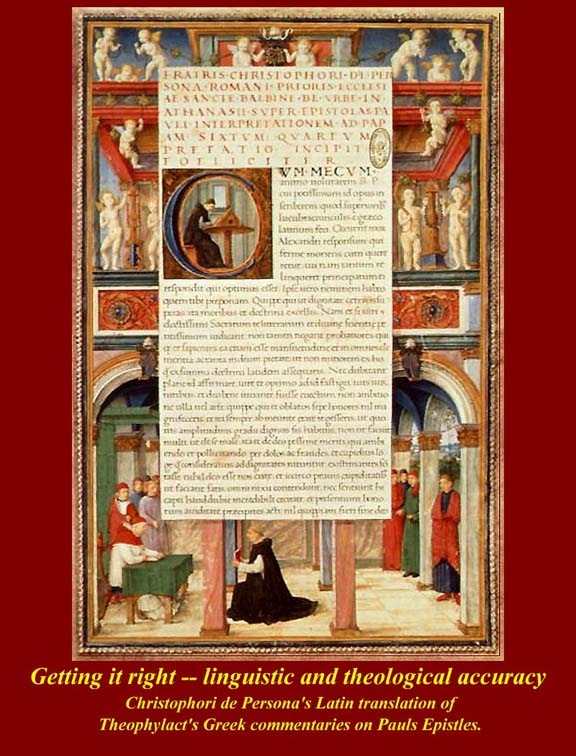
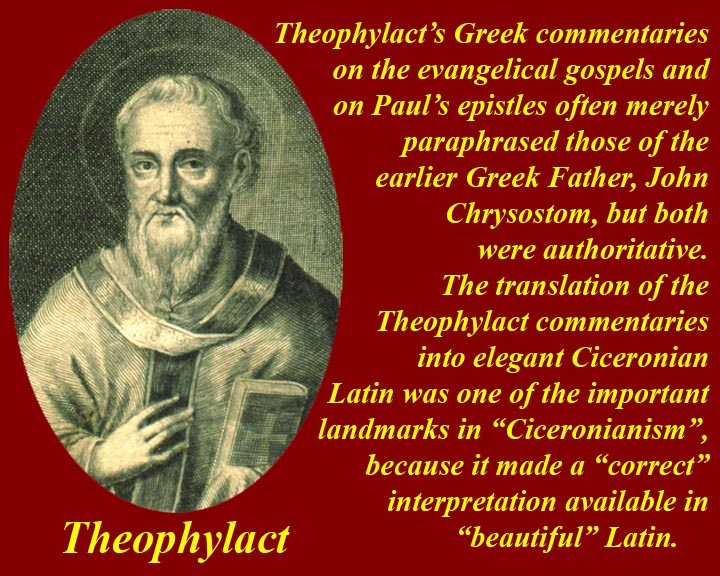
http://www.mmdtkw.org/RenRom0503-CorrectEloquent.jpg
http://www.mmdtkw.org/RenRom0503a-TheophylactTranslated.jpg
The Renaissance Humanists were infatuated with the idea of collating ancient non-Christian writings with supposed counterparts from the Christian biblical and patristic canon and with making everything available in correct and elegant Latin (and, of course, keeping everything in line with Christian dogma).
Theophylact's commentaries on Paul's writings were largely cribbed from similar commentaries by John Chrysostom, one of the "Greek Fathers" of Christianity. In fact, Theophylact's authenticity on Paul was considered to be proven by how well he he agreed with the "authoritative" works of his source, Chrysostom (who also commented on the Evangelical gospels). The problem, of course, was that both men wrote in Greek, and that the humanists wanted correct and elegant Ciceronian Latin translations. So they produced them.
The humanists not only translated Greek documents into Ciceronian Latin, they also translated non-Ciceronian Latin documents and Italian vernacular works into Ciceronian Latin. One of the notable books they worked up was Jerome's Vulgate Bible. The Vulgate is an early 5th-century Latin version of the Bible and is largely the result of the labors of Jerome, who was commissioned by Pope Damasus I in 382 to make a revision of the old Latin translations. By the 13th century this revision had come to be called the versio vulgata, that is, the "translation into common usage Latin", and ultimately it became the definitive and officially promulgated Latin version of the Bible in the Roman Catholic Church. Many supposed authoritative versions of the Vulgate, riddled with inconsistencies, were available by the time the first edition of the revised and corrected Sixto-Clementine Vulgate (the Biblia Sacra Vulgatæ Editionis Sixti Quinti Pontificis Maximi iussu recognita atque edita) was published by Clement VIII in 1592. There have been several revisions since, but most "Latinologists" agree that the lingua Latina of the Vulgate is still non-Ciceronian -- it's downright vulgar (meaning "of the common people, not the current meaning of "vulgar", which has diverged). See http://en.wikipedia.org/wiki/Vulgate and for a side-by-side comparison of "authoritative" Greek, English, and Latin Bible texts see http://www.newadvent.org/bible/gen001.htm. (Note that "authoritative" as used here really means current "Roman Catholic authoritative" -- we are, after all studying the Roman Renaissance.)
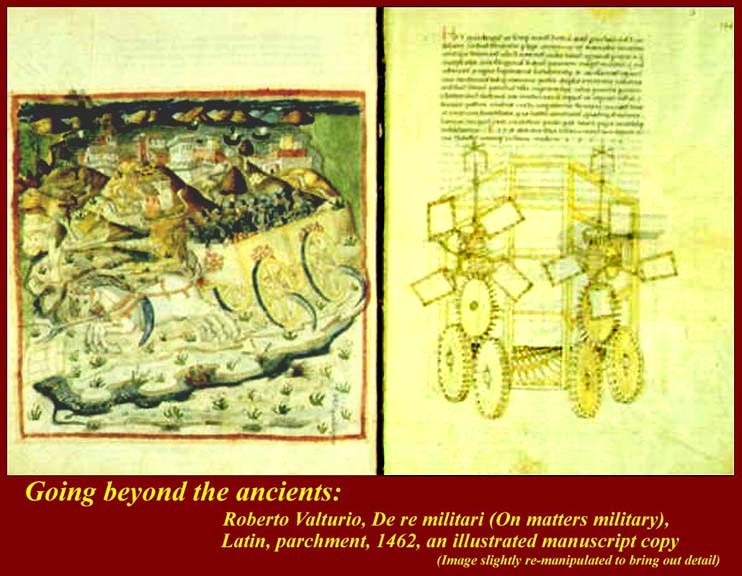
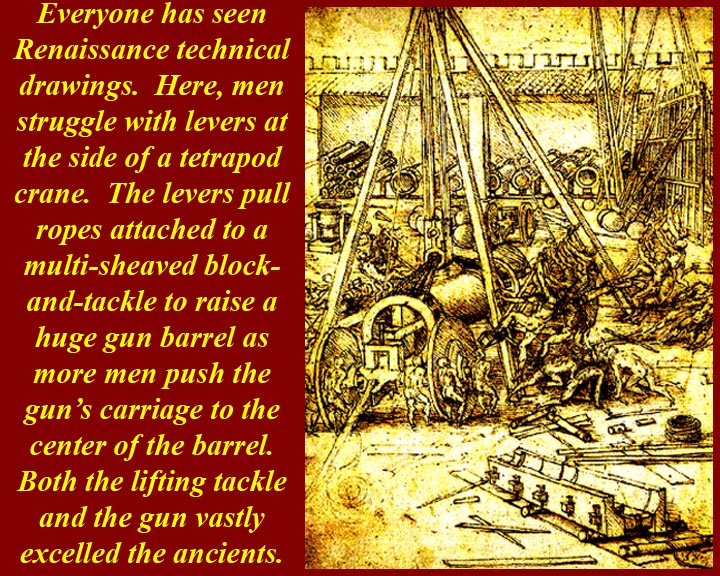
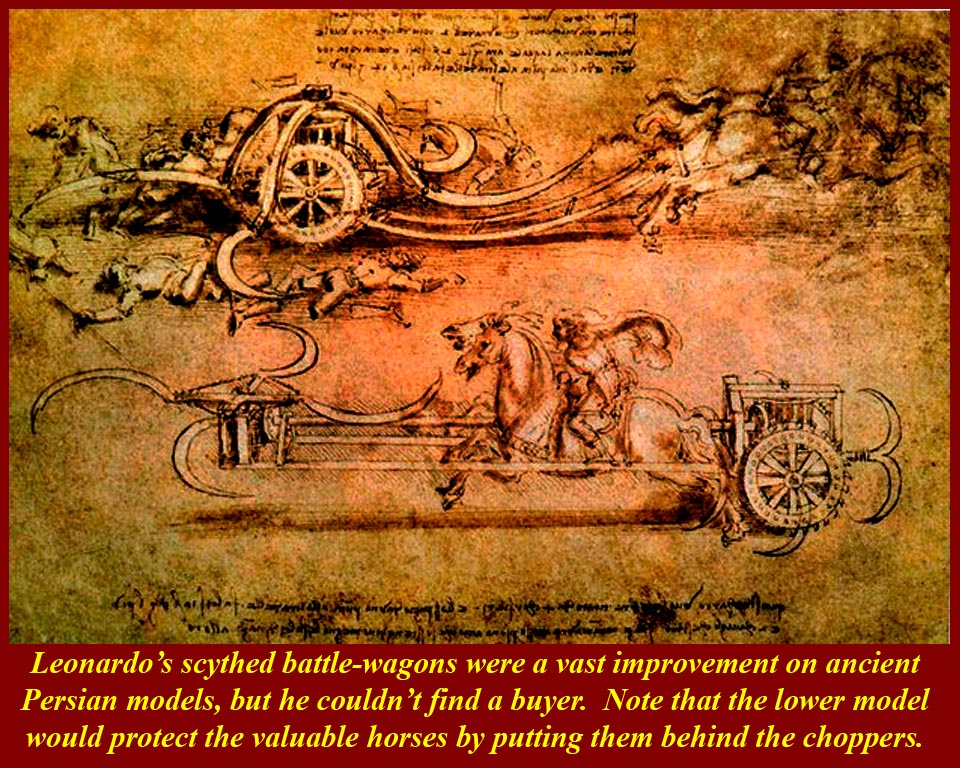
http://www.mmdtkw.org/RenRom0504-BeyondAncients.jpg
http://www.mmdtkw.org/RenRom0504a-ArtilleryArsenal.jpp
http://www.mmdtkw.org/RenRom0504b-DavinciScythedChariots1.jpg
http://www.mmdtkw.org/RenRom0504c-Weaponry.jpg
In addition to updating and "improving" ancient documents, humanist "Renaissance men" wanted to be artists, architects, and mechanical engineers. The engineering part was most often associated with design of weaponry to give their patron an edge in their constant warfare, but it could also be concerned with mills, with water movement (pumps and drains), or with construction equipment, especially for heavy lifting construction machines. All of this was considered to be part of the rebirth of ancient Rome, but Renaissance engineers wanted not just to equal ancient Roman accomplishments, but to surpass them in cleverness, in size, and perhaps even in usefulness. There were also new technologies to accommodate, and the most important of these was the use of explosive and incendiary powders, which had recently arrived from the orient. Gunpowder led to a race between explosive weapons (guns, rockets, mines, and mechanically delivered projectiles) and defensive fortifications.
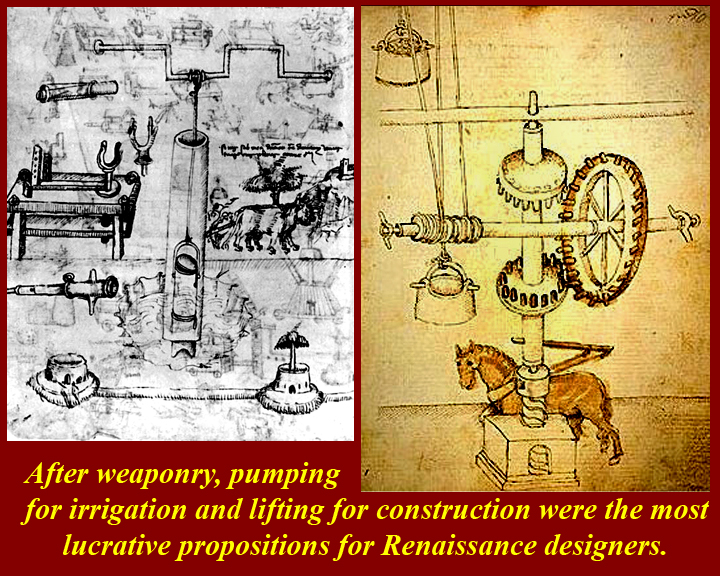
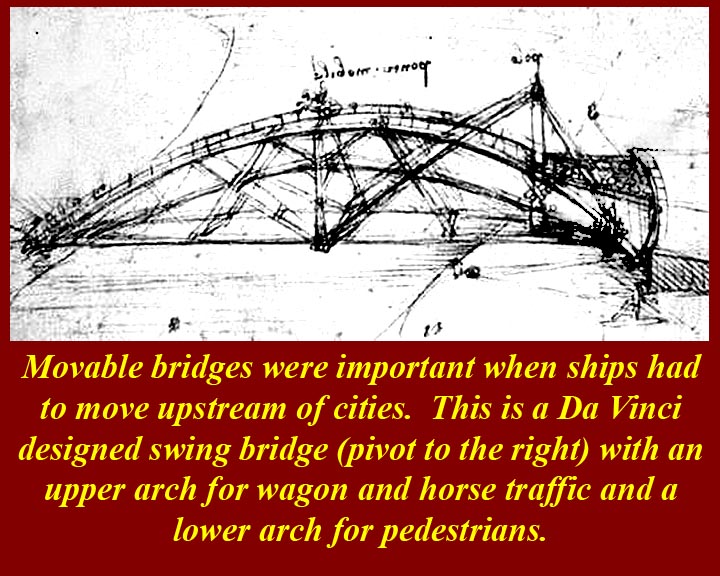
http://www.mmdtkw.org/RenRom0504d-PumpLift.jpg
http://www.mmdtkw.org/RenRom0504e-SwingBridge.jpg
http://www.mmdtkw.org/RenRom0504f-MartiniTreatise.jpg
Pumps, mills, bridges, and other non military mechanical devices all had one overriding purpose, the increase of wealth by the decrease of agricultural, manufacturing, or transportation costs. The most famous designer of such equipment during the Renaissance was -- no, not Leonardo, who we all know today from his ideas drawn in his notebooks but seldom brought to fruition -- no, it was a man named Francesco di Giorgio Martini, whose name is at the tip of nobody's tongue today.
Francesco was another Renaissance man -- painter, sculptor, architect, and military, civil, and mechanical engineer. The first six books of his Trattato di Architectura dealt with military and civil engineering. The seventh and last volume covered more prosaic mechanical devices and contains many small but clearly drawn images of cranes, mills, pumps, etc. (The whole work contains hundreds of such drawings.) What is important about Francesco is that, unlike Leonardo's, many of his devices came into common use. His disadvantage was that he was heavily plagiarized by more famous later men who took credit for his ideas. The plunder of his intellectual property must have begun during his own lifetime. Even though his Trattato was only circulated in a limited edition of manuscript copies, by the time he began writing the seventh book (20 years into his engineering literary project) he was lamenting in its prologue the plagiarism of his previous six books and the direct copying of his machines (ingengnio = engines) by
"...ignoramuses [who] adorn themselves with the labours of others and usurp the glory of an invention that is not theirs. For this reason the efforts of one who has true knowledge is often retarded. If in all epochs this vice has abounded, in our own it is more widespread than in any other."
And who were these usurpers? One of the men (it was always and only men) who got credit for Francesco's ideas was certainly Leonardo himself, although perhaps unwittingly and long after his own death. One of the few remaining manuscript copies of Francesco di Giorgio Martini's Trattato di Architectura has marginal notes in the distinctive handwriting of Leonardo -- he clearly once had the copy in his possession -- and several of Martini's drawings are copied uncredited into Leonardo's notes. Leonardo is today credited with these "invention".
Much of the information in this note and the partial Francesco quotation were derived from:
Francesco di Giorgio Martini's Treatise on Engineering and Its Plagiarists
by Ladislao Reti and Francesco di Giorgio Martini
Technology and Culture, Vol. 4, No. 3 (Summer, 1963), pp. 287-298
Published by: The Johns Hopkins University Press on behalf of the Society for the History of Technology.
The article also has pictures of Francesco's drawings and of the copies made by his plagiarists.
------- I wouldn't want to be accused of usurping! --TKW
You can have your own facsimile copy of Leonardo's copy of the Francesco di Giorgio Martini Trattato for only 1200 Euros (about $1740). Order from http://www.omifacsimiles.com/brochures/images/francesco.pdf.
http://www.mmdtkw.org/RenRom0504g-DaVinciAnatomical.jpg
If Leonardo's mechanical works were not all original, it is certain that his anatomical studies were his own. His human and animal life-studies have never been seen in works by earlier author/artists, and his studies of internal organs are definitely better than any contemporary and many later works. Leonardo clearly had access to body parts.
Printing press leads to wider readership
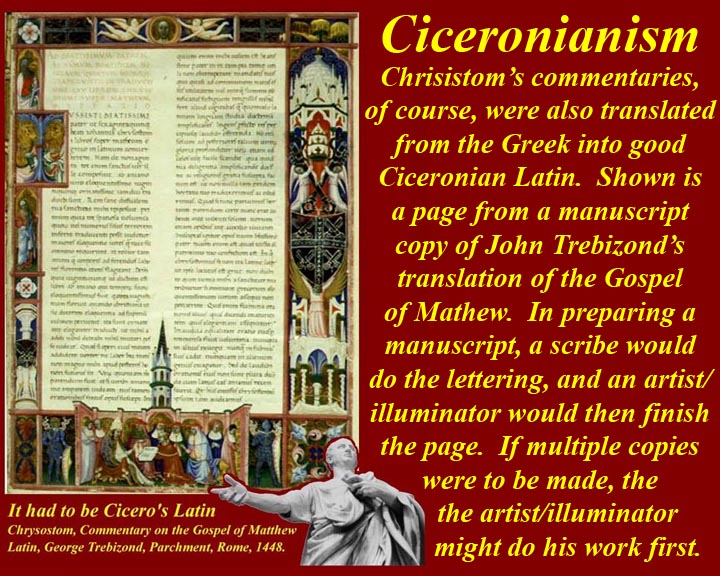
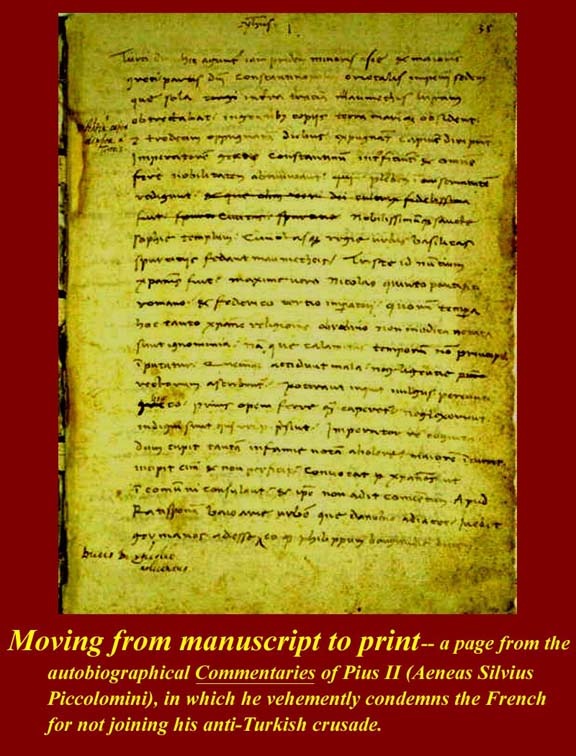
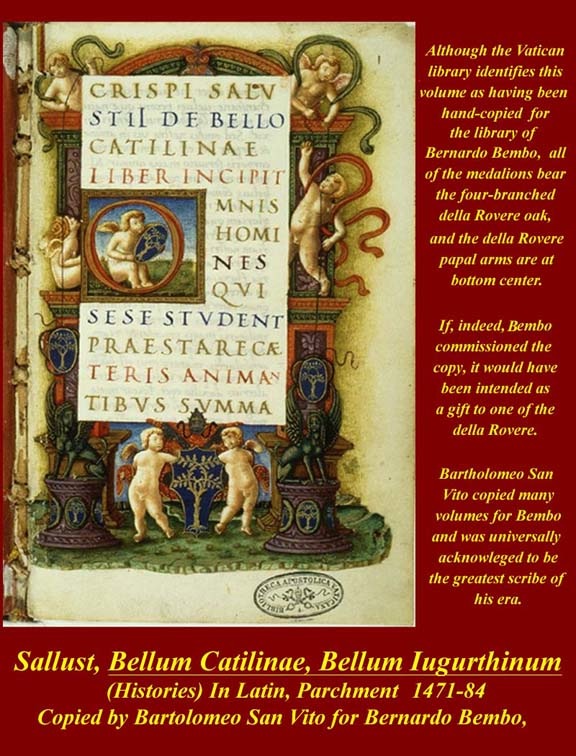
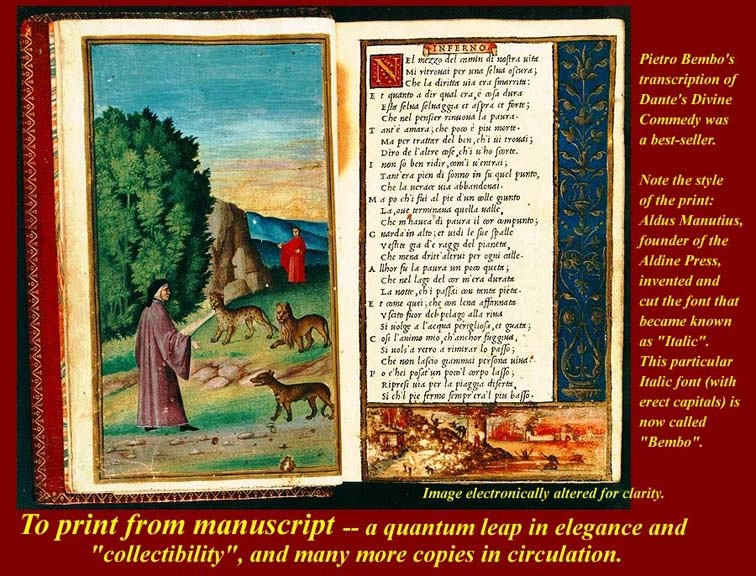
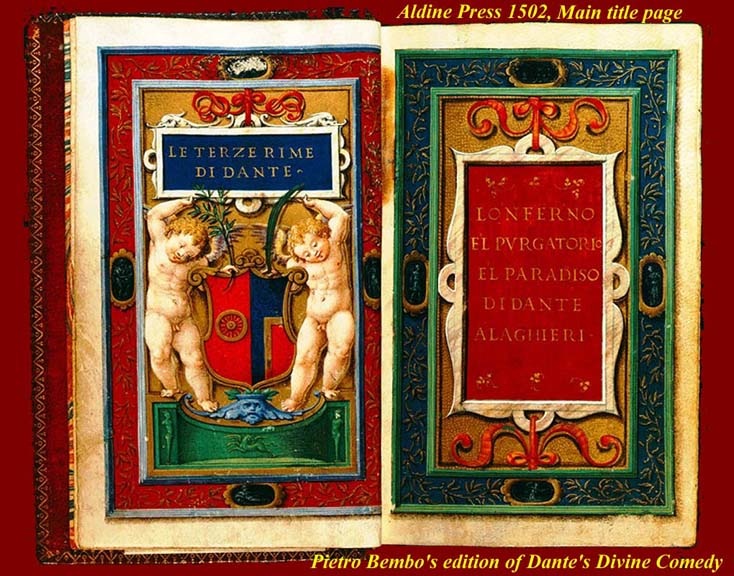
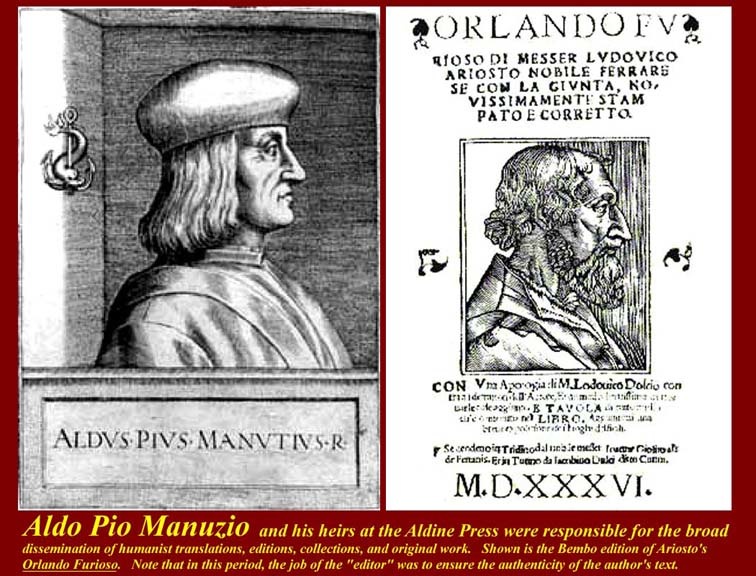
http://www.mmdtkw.org/RenRom0505-Ciceronianism.jpg
http://www.mmdtkw.org/RenRom0506-ManuscriptPrint1.jpg
http://www.mmdtkw.org/RenRom0507-ManuscriptPrint2.jpg
http://www.mmdtkw.org/RenRom0507a-AdventOfPrinting.jpg
http://www.mmdtkw.org/RenRom0508-ManuscriptPrint3.jpg
http://www.mmdtkw.org/RenRom0509-AldusBemboDante.jpg
http://www.mmdtkw.org/RenRom0510-AldoAldine.jpg
http://www.mmdtkw.org/RenRom0511-PrintingSpreads.jpg
At the beginning of the Roman Renaissance, only a few copies of original documents and translations from Latin and Greek could be disseminated in manuscript form -- literally hand written (Latin: manu, ablative of manus = by hand + scriptus, participle of scribere = written) by professional scribes. Works by individual scribes are often identifiable due to idiosyncratic styles (as is the case with document inscribed by Bartolomeo San Vito in the third image above), but just as often the scribe would proudly include his own name on the title page. By the end of the Renaissance, large printing houses were engaged in mass market distribution. Copyright did not really exist, although it might be a bit dangerous to steal from the bigger printing houses; their thugs might pay a visit to your shop and damage your presses if you stole too much. The bigger printers, on the other hand, stole with impunity from the smaller shops and from each other.
As printing spread, type "faces" had to be invented, and the most famous fonts were the Italics, whixh were carved by the workers of Aldo Pio Manuzio at his Venetian Aldine Press (founded in 1494). Among the Aldine Italic fonts was one called "Bembo", which was originally used exclusively for the works and translations of Pietro Bembo (1470-1547); it featured upright capital letters (or majuscule or upper case) and slanted small letters (or minuscule or lower case).
The papal curia's own printing house, now known as the Vatican Press but for several centuries known as the Propaganda Press -- i.e., the "Press for the Propagation of the Faith"-- wasn't founded until 1626. It is still responsible for all Vatican publications, and, theoretically, its parent organization, the curial "Congregation for the Doctrine of the Faith" (formerly known as the Inquisition) still has to give its permission (Latin: nihil obstat = "nothing stands in the way") and approval (Latin: imprimatur = "let it be pressed, i.e., impressed or printed") for all works printed and distributed by Catholic organizations world wide.
Before his election, Pope Benedict XVI, then Joseph Cardinal Ratzinger, was the head of the Vatican Press and Prefect of the Congregation for the Doctrine of the Faith, and he took great interest in new publications in Rome, often coming to initial book-signings to add his own prestige to the events. Pope Benedict also founded in November 2008 and is the patron of the Ratzinger Foundation, a charitable organization, which makes money from the sale of books and essays written by the Pope, in order to fund scholarships and bursaries for students across the world.
During the Second Vatican Council from 1962 to 1965, Ratzinger served as a peritus (theological consultant) to Josef Cardinal Frings of Cologne. He was viewed during the time of the Council as a reformer, cooperating with radical Modernist theologians like Hans Küng and Edward Schillebeeckx. Ratzinger became an admirer of Karl Rahner, a well-known academic theologian of the Nouvelle Théologie and a proponent of church reform.
In 1966, Joseph Ratzinger was appointed to a chair in dogmatic theology at the University of Tübingen, where he was a colleague of Hans Küng. In his 1968 book Introduction to Christianity, he wrote that the pope has a duty to hear differing voices within the Church before making a decision, and he downplayed the centrality of the papacy. During this time, he distanced himself from the atmosphere of Tübingen and the Marxist leanings of the student movement of the 1960s; despite his reformist bent, his views increasingly came to contrast with the liberal ideas gaining currency in theological circles. Some voices, among them Hans Küng, deemed this a turn towards Conservatism, while Ratzinger himself said in a 1993 interview, "I see no break in my views as a theologian [over the years]". Ratzinger has continued to defend the work of the Second Vatican Council, including Nostra Aetate, the document on respect of other religions, ecumenism and the declaration of the right to freedom of religion. Later, as the Prefect for the Congregation for the Doctrine of the Faith, Ratzinger most clearly spelled out the Catholic Church's position on other religions in the 2000 document Dominus Iesus which also talks about the Roman Catholic way to engage in ecumenical dialogue.
Neo-Latin poetry -- New works in Ciceronian Latin
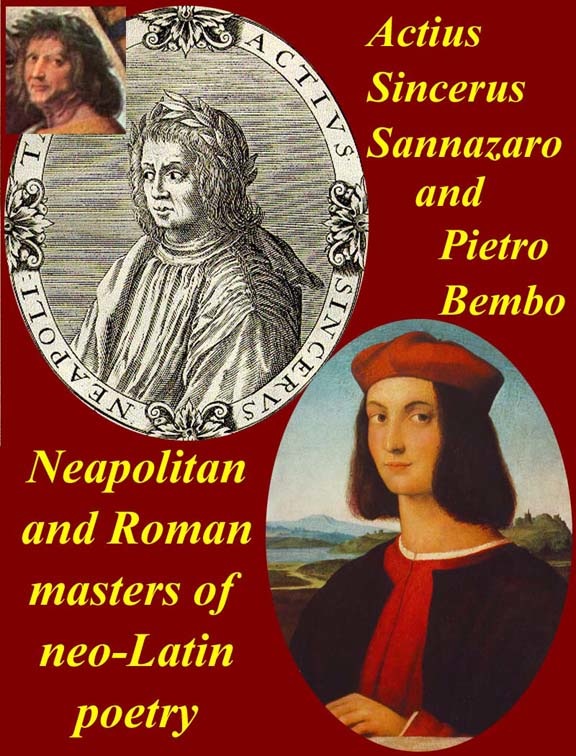
http://www.mmdtkw.org/RenRom0512-NeoLatinPoetry.jpp
http://www.mmdtkw.org/RenRom0512a-PietroBembo.jpg
After cutting their teeth on translating the ancients, some humanists began to emulate the ancient Latin Poets by writing "neo-Latin" poetry. The two greatest exponents of neo-Latinism were Actius Sincerus Sannazaro, pictured as the Poet Laureate of Naples. and Pietro Bembo of Rome. Bembo's early poems were modeled after the physical/sexual love poetry of the ancient Roman poets Catullus, Propertius, and Ovid, and, as might have been expected, his work was condemned by the church. But times and Bembo changed; he was a favorite of the Medici and was secretary to Pope Leo X Medici. He was made a cardinal in 1539 by Pope Paul III Farnese and for the remaining eight years of his life wrote almost entirely on religious subjects. He died at age 77.
Bembo was for many years the arbiter of Italian letters, insisting that classical traditions be preserved. He was responsible for editions of Petrarch and Dante and helped establish the language of Tuscany as the standard of literary Italian. He wrote the History of Venice (1551); a disquisition on platonic love, Gli Asolani (1505, tr. 1954), inspired by Plato's Symposium; a book of lyric verse (Rime, 1530) in Latin and Italian; and Prose della volgar lingua [prose in the vernacular] (1525). See http://en.wikipedia.org/wiki/Jacopo_Sannazaro and http://www.newadvent.org/cathen/13449d.htm for Sannazaro, and see http://en.wikipedia.org/wiki/Pietro_Bembo and http://www.newadvent.org/cathen/02425e.htm for Bembo.
From Greek to Ciceronian Latin -- Bessarion as translator
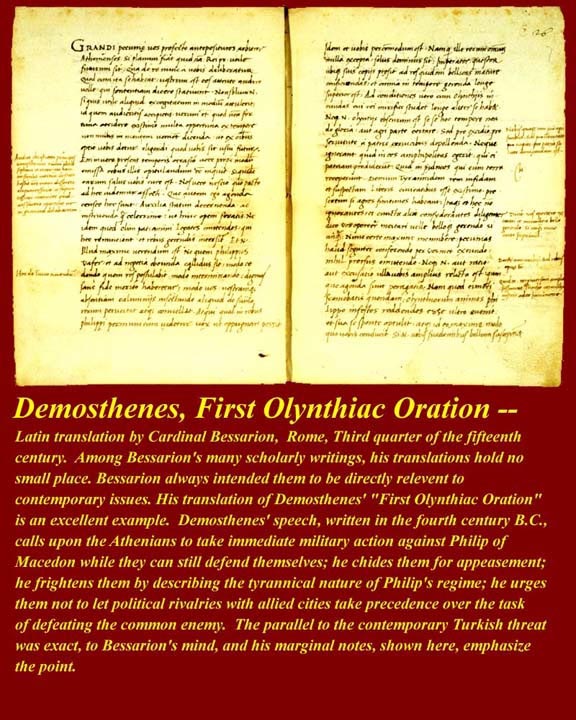
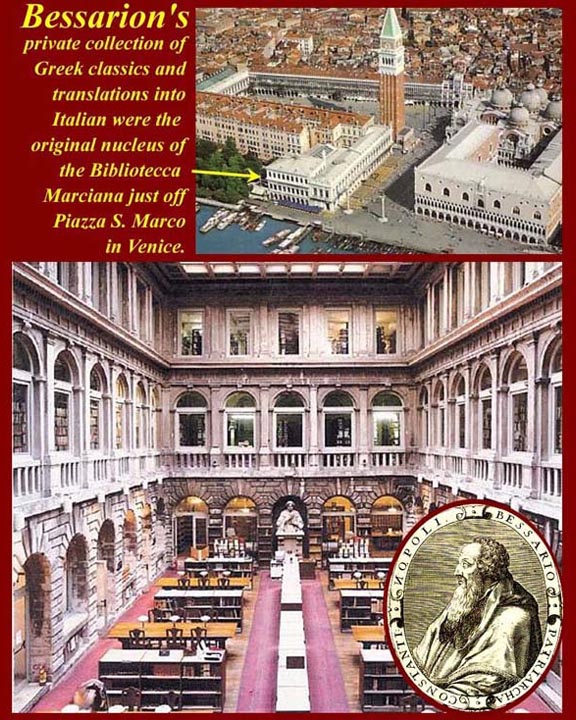
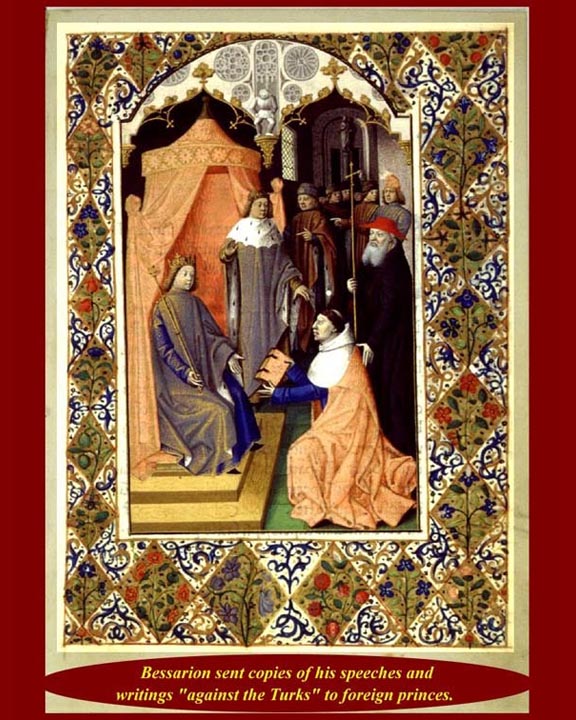
http://www.mmdtkw.org/RenRom0513-BessarDemosthene.jpg
http://www.mmdtkw.org/RenRom0514-BessarioMarciana.jpg
http://www.mmdtkw.org/RenRom0515-BessarContraTurk.jpg
Bessarion donated his collections to the Marciana (St. Mark's) library in Venice. Still an unmatched source for Greek classics and their translations. Bessarion's other issue (besides dissemination of Greek Classics): confronting Turkish Expansion -- correspondence with European princes (essentially a failed issue.)
Writing in the shadows -- pseudonymous humanist authors
http://www.mmdtkw.org/RenRom0516-Palingenius.jpg
Mysterious Palingenius -- Writing under a pseudonym to avoid the inquisition, the true identity of Palingenius was not discovered during his lifetime -- and perhaps was never discovered. The inquisition finally found what they said was an anagram in the initial letters of a Palingenius document and identified Pierangelo Manzolli as its author. But Manzolli was already dead and buried. No problem -- the inquisition dug him up and burned his bones.
Palingenius wrote Zodiacus Vitae, a Latin poem divided into 12 books, one for each sign of the zodiac, one edition of which was published at Basel in 1543, but first published perhaps as early as the early 1430s. It was dedicated to Ercole II d'Este, duke of Ferrara. The didactic poem addresses the subject of human happiness in connection with scientific knowledge, and combines metaphysical speculation with satirical attacks on ecclesiastical hypocrisy, and especially on the Popes and Martin Luther. It was translated into several languages, but fell under the ban of the Inquisition on the ground of its rationalizing tendencies. After Manzolli's death, the Catholic Church burned his "heretical" bones and Pope Paul IV placed his book in the first Index Librorum Prohibitorum in 1559.
Writing in the shadows -- forgotten authors
http://www.mmdtkw.org/RenRom0518-RaphMaffei.jpg
Raffaelo Maffei is the poster-boy for Renaissance humanists that were not notorious. Although very famous in his own day for his works and translations, he, and many others, were quickly forgotten: no scandal, so no lasting fame.
Writing in the shadows -- women poets
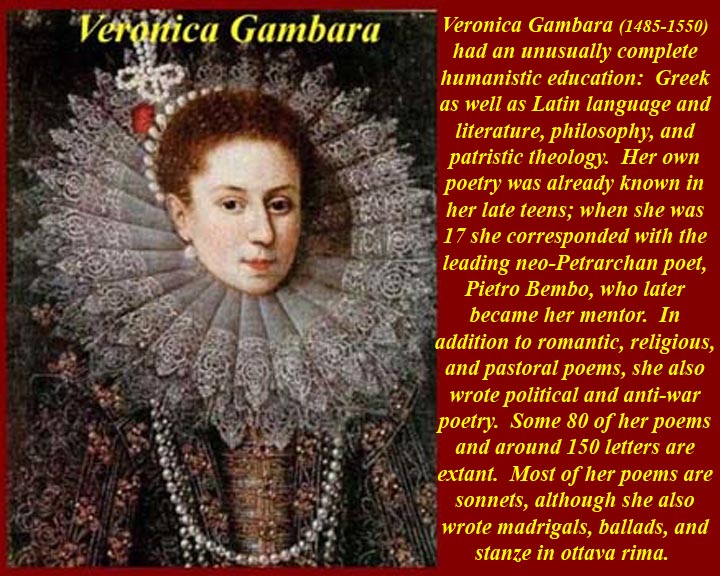
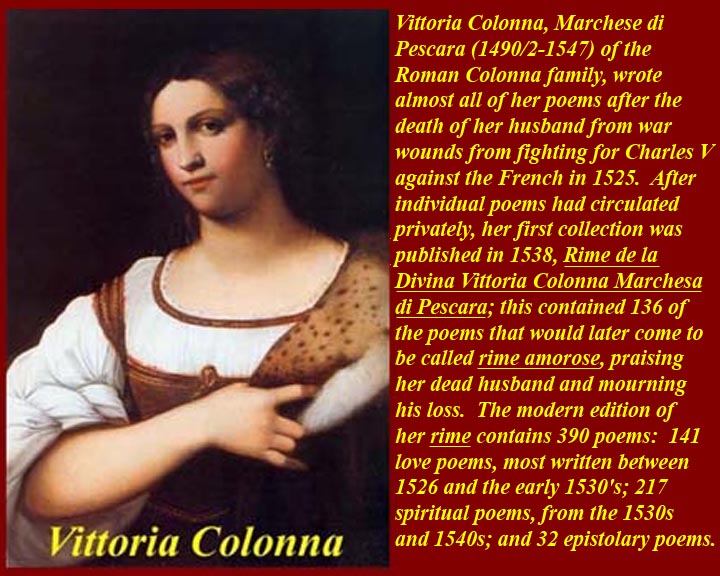
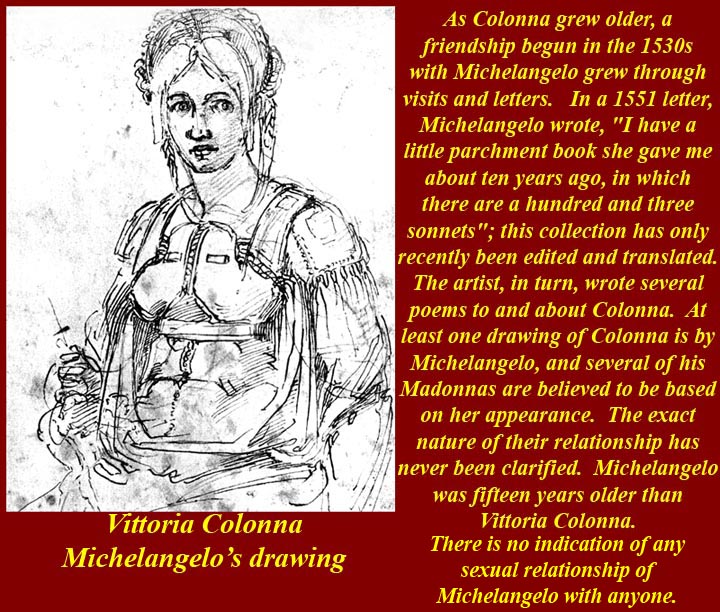
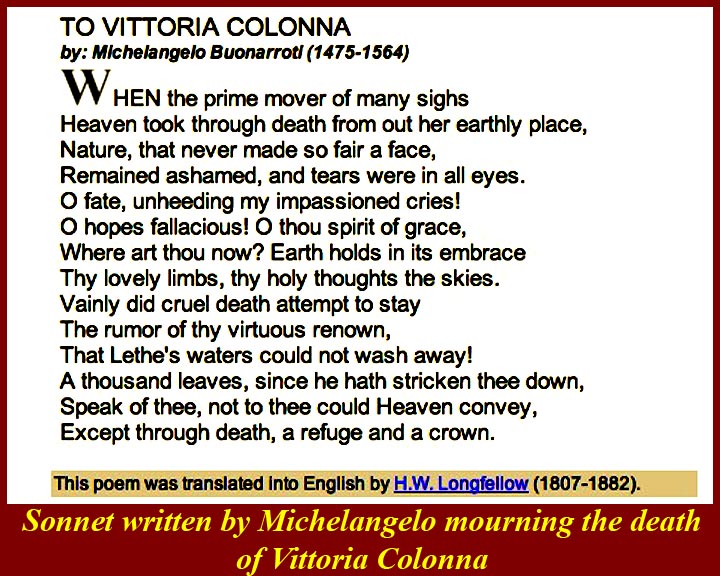
http://www.mmdtkw.org/RenRom0519-PoetessGambara.jpg
http://www.mmdtkw.org/RenRom0520-PoetessVittoriaColonna1.jpg
http://www.mmdtkw.org/RenRom0520a-MichelangeloVittoriaColonna.jpg
http://www.mmdtkw.org/RenRom0520c-ToVittoriaColonna.jpg
http://www.mmdtkw.org/RenRom0521-PoetessFranco.jpg
Women participated too. Veronica Gambara, Vittoria Colonna, and Veronica Franco -- two noblewomen and a courtesan are noted Renaissance poetesses.
Veronica Gambara tried --- for her own reasons --- to be a peacemaker. Her first concern were her sons and Correggio, the territory she inherited from her husband, and she had friends and relatives throughout northern Italy. She knew and liked Francis I; she admired (and came to know) Charles V; she had friends close to the pope. She addressed a number of her poems to whoever could contribute to the peace of the territories she loved. Of Gambara's writings some 80 poems and around 150 letters are extant. Most of her poems are sonnets, although she also wrote madrigals, ballads, and stanze in ottava rima. Besides her political poems, she wrote poems of love, religious devotion, and pastoral praise of Brescia and Correggio. There is no complete English translation of her poetry or correspondence, but the majority of her poems are now available online, and some poems and letters are available in print.
After individual poems had circulated privately, Vittoria Colonna's first collection was published in 1538, Rime de la Divina Vittoria Colonna Marchesa di Pescara; this contained 136 of the poems that would later come to be called rime amorose, praising her dead husband, Ferrante Francesco d'Avalos, Marquis of Pescara, and mourning his loss. But in an edition of the following year, 16 "sonetti spirituali" were advertised, and later editions included an ever-increasing number of rime spirituali, reflecting the shift of Colonna's focus. These editions were published apparently without Colonna's approval, and the arrangement of the poems were the editors. The modern edition of her Rime contains 390 poems: 141 love poems, most written between 1526 and the early 1530's; 217 spiritual poems, from the 1530s and 1540s; and 32 epistolary poems. Vittoria Colonna appears to have had a Platonic relationship with Michelangelo -- a man who appears to have had only that kind of relationship. Some modern psychologists seem to think Michelangelo was a repressed homosexual, although they admit they have little or no evidence that that was the case. Michelangelo wrote at least one sonnet to Colonna after her death, and several more of his poems may also have been for her.
Only Veronica Franco is remembered today -- and wildly inaccurately due to a movie called Dangerous Beauty, which the producers said was based on a fairly accurate study of Franco called The Honest Courtesan. The producers misrepresented the case, but the book went to the best-seller list, so the author, Margaret F. Rosenthal, shouldn't be to unhappy. Both movie, although it inaccurately portrays Franco, has wonderful costumery, background shots (Venice), and cinematography. It's good in the way that the Gladiator movie is -- little fact, but plenty of accurate atmospherics and good fun.
For information on Veronica Gambara, see http://home.infionline.net/~ddisse/gambara.html and http://digilib.gmu.edu:8080/xmlui/html/1920/769/index.html.
For information on Vittoria Colonna, see http://www.lib.uchicago.edu/efts/IWW/BIOS/A0011.html and http://www.lib.uchicago.edu/efts/IWW/Portraits/HTML/A0011.html, which includes a painting of Michelangelo at her catafalque, and http://home.infionline.net/~ddisse/colonna.html and http://faculty.ed.umuc.edu/~jmatthew/naples/colonna.html.
For information on Veronica Franco, see http://www.lib.uchicago.edu/efts/IWW/BIOS/A0017.html and http://en.wikipedia.org/wiki/Veronica_Franco. For a film clip from Dangerous Beauty, see http://www.youtube.com/watch?v=d2Hrei0AtV8.
For information on 46 Italian women authors, many of whom wrote during the Italian Renaissance, see http://colet.uchicago.edu/cgi-bin/iww/authoridx.pl?auth_biography=1.
Ephemera
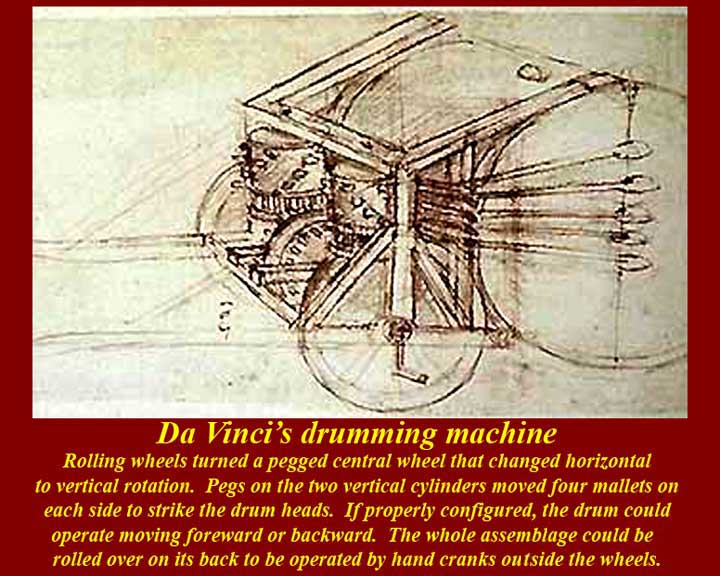
http://www.mmdtkw.org/RenRom0522-DrumMachine.jpg
http://www.mmdtkw.org/RenRom0523-AnimusicDrumMachine.jpg
Not every machine designed during the Renaissance had a practical use. A favorite, even if it never was built, is Leonardo's rolling drum machine. Eight mallets, four per side, struck the two drum heads as the machine rolled along. It could also be rolled over like a turtle on its back and be operated by two hand cranks. A newer drum machine drawing (Animusic - "Drum Machine" -- Image copyright © 2004-2006 Animusic) is shown for comparison. See http://www.animusic.com/popups/clip-drum-flash.html to see the modern drum machine animated. The Animusic internet home page is at http://www.animusic.com/index.php.
Renaissance Rome Unit 06 -- Architecture
This is http://www.mmdtkw.org/RenRom0600-ArchitectIntro.html
Renaissance Roman Architecture -- Unit 6As was the case with other aspects of the Renaissance, Roman Renaissance architecture was "different" in that it was centered on Religion. Family ambition was aimed at procuring Cardinals' hats -- maybe even a Papal tiara later -- and most of Rome's grand structures were part of these ambitious programs. As in Ancient Roman times, the social, political, and religious organization was based on patronage, and, in particular, the ancient institution of the "familia" (Italian , "famiglia" was revived. All of the "old" families and the new merchant and immigrant families wanted to have appropriate structures to in which to house their higher level clientage.
Some Medieval structures survived into the Renaissance (in fact, much of the Trastevere district and some of the Campus Martius are still Medieval) but large areas were built over -- or built into -- Renaissance Palazzo compounds. In addition, some areas inside the walls that had been unused since ancient times were now rebuilt with huge Renaissance residential buildings.
Civic buildings were not neglected. The saddle between the two peaks of the Ancient Roman Capitoline Hill, which throughout the Medieval period had been a civic center, was rebuilt over a period of centuries with grand new Renaissance civic palaces following an architectural plan drawn up by Michelangelo. Although not as large as the Vatican compound pictured above, Rome's new civic center buildings were no less impressive. (Note that the pavement in the central Piazza was not completed until 1930 -- black reversed for white, but precisely according to Michelangelo's plan.) The central building with the Medieval clock tower is the Palazzo Senatorio, Rome's city hall, and the two buildings on the side of the Piazza are the Campidoglio Museums, both of which were completely renovated during the 1990s
Religious buildings -- churches and oratories -- were also rebuilt or renovated and expanded during the Renaissance, and some new churches were built. The biggest project was, of course, St. Peter's in the Vatican, which was completely rebuilt. There was strong local feeling to preserve the "Old St. Peters", the Constantinian basilica, but if was soon clear that centuries of neglect had brought it to a disastrous state. The process took generations to complete -- both of popes and of architects -- but it was once again Michelangelo's plan that was eventually followed. Bernini's grand curving colonnades were added toward the end of the period. S. Maria Maggiore evolved as a new façade and loggia were added. The Lateran Papal compound was greatly changed -- the church vastly expanded and the old Lateran Palace rebuilt on a smaller scale after the old structure was ravaged by fire and after the new "Apostolic Palace" was built in the Vatican. Among others, Bernini and Borromini designed new churches, but it was those two who ushered in the new "Baroque" architecture, the last wave of Roman and Italian Renaissance architecture that washed over Europe. Invariably, the patrons of church construction, whether rebuilt, expanded, or new, were the same families (famiglie) that built the grand palazzos, and in many cases the churches were actually incorporated in the palazzos.
Topics for discussion
Some of the millions of Internet links for Roman Architecture (the best way to find something is to use your Internet search engine and search for Rome, architecture, and the name of the structure or architect.) Great Roman Architects How Medieval evolved into Renaissance
Housing the familia
The Campidoglio
The Eclesiatical Familia Residences
St. Peters and the Vatican
Churches
General Roman Renaissance Architecture links
http://www.mmdtkw.org/arch.html
http://www.romeartlover.it/Rena.htm
http://www.romeartlover.it/Facades.html
http://www.loc.gov/exhibits/vatican/arch.html
Information on any of the artists listed below or on any other Roman Renaissance artists can be found with a searsh at http://www.google.com/ig?hl=en or at http://images.google.com/imghp.
Berninihttp://www.kfki.hu/~arthp/bio/b/bernini/gianlore/biograph.html
http://rubens.anu.edu.au/htdocs/bycountry/italy/rome/popolo/midjpg/alphabetical/index15.html
Borromini
http://intranet.arc.miami.edu/rjohn/ARC%20267/Borromini2002.htm
http://www.greatbuildings.com/architects/Francesco_Borromini.html
http://www.borromini.at/e/index.html
http://www.bluffton.edu/~sullivanm/carlo/carlo.html
http://www.math.nus.edu.sg/aslaksen/projects/perspective/spada.htm
Bramante
http://www.newadvent.org/cathen/02736a.hthttp://www2.siba.fi/~kkoskim/rooma/pages/PCANCELL.HTM
http://www.romeartlover.it/Vasi74.html
http://members.tripod.com/romeartlover/Juv3.html
Campidoglio
http://www.romeartlover.it/Vasi80.htm
http://www2.siba.fi/~kkoskim/rooma/pages/PCAMPIDO.HTM
Paladio
http://www.greatbuildings.com/architects/Andrea_Palladio.html
Pictures for this Unit are on the Internet at
Renaissance Rome
Unit 6 Slides
http://www.mmdtkw.org/RenRomUnit0600-0PixList.html
Roman Renaissance ArchitectureClick on links or small images below to go to large images for Unit 6.
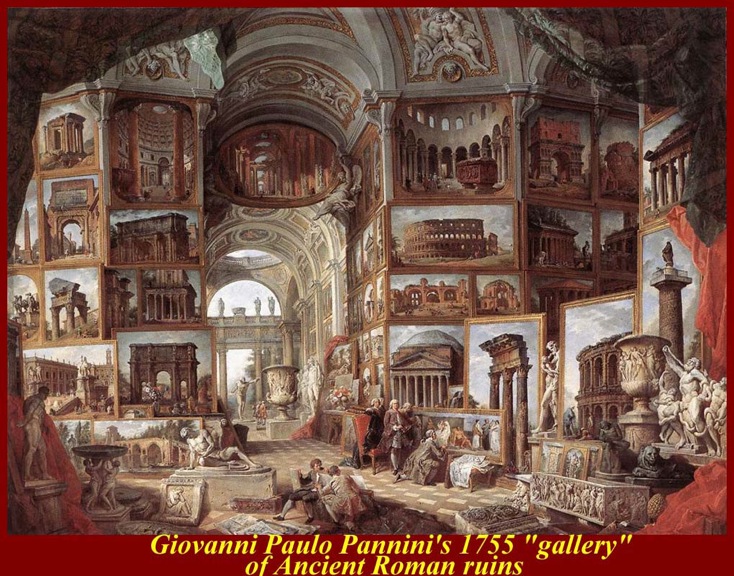
http://www.mmdtkw.org/RenRom0600a-PanniniAncGalle.jpg
http://www.mmdtkw.org/RenRom0600b-PanniniRenGalle.jpg
Giovanni Paolo Pannini or Panini (June 17, 1691 – Rome, October 21, 1765) was an Italian painter and architect, mainly known as one of the vedutisti or "view painters". As a painter, Pannini is best known for his vistas of Rome, in which he took a particular interest in the city's antiquities. Among his most famous works are the interior of the Pantheon (at http://upload.wikimedia.org/wikipedia/commons/6/69/Pantheon-panini.jpg), and his vedute — paintings of picture galleries containing views of Ancient Rome (1757) and Renaissance Rome (1759). Most of his works, specially those of ruins have a substantial fanciful and unreal embellishment characteristic of capriccio themes.
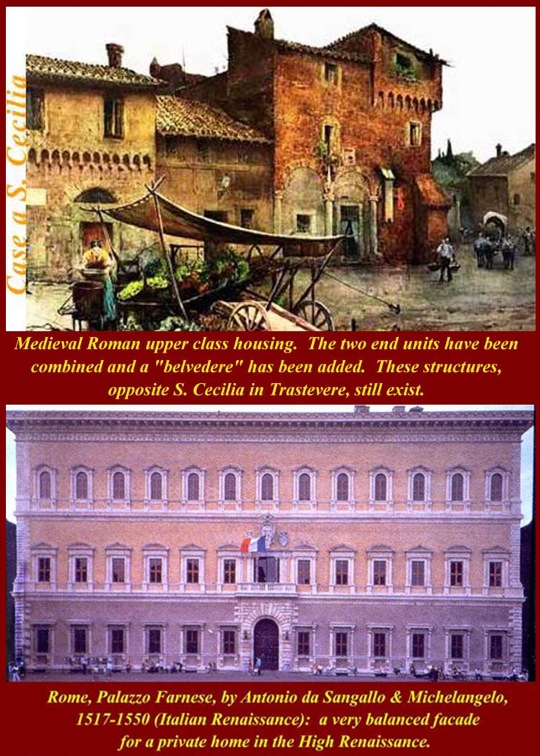
http://www.mmdtkw.org/RenRom0601-MedievalVsRenais.jpg
http://www.mmdtkw.org/RenRom0602-ScimmiaColonna.jpg
The qualitative and size differences between medieval and renaissance Roman structures is clear, and the driving force behind the change is, obviously, the wealth of the patrons. Both the medieval and the renaissance structures in the two images are still in use; the medieval Trastevere houses opposite Santa Cecila have been converted into very expensive condos.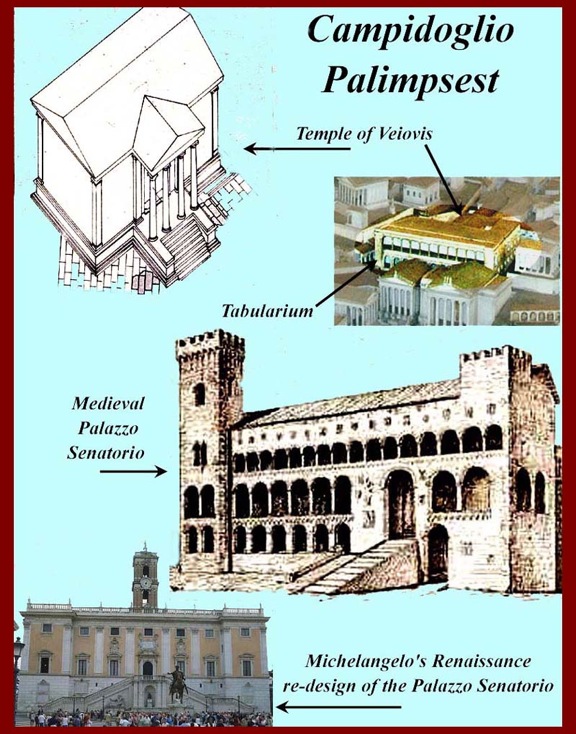
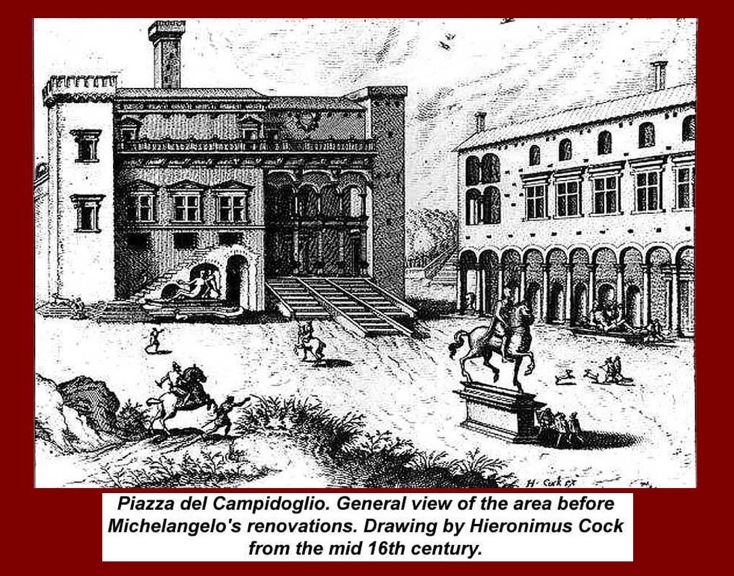
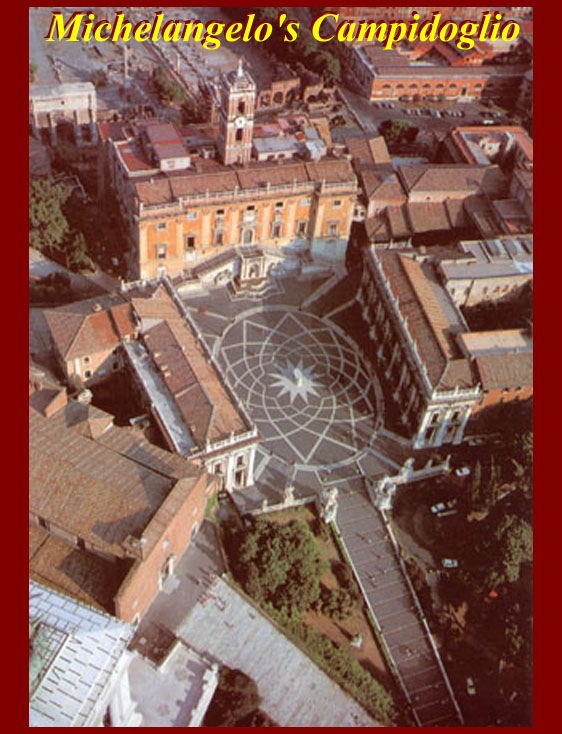
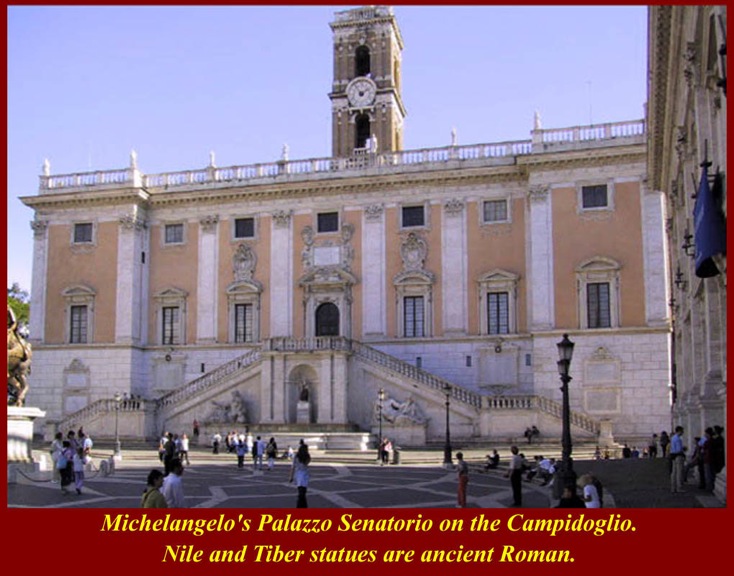
http://www.mmdtkw.org/RenRom0603CampidoPalimpsest.jpg
http://www.mmdtkw.org/RenRom0604-Campidoglio1550.jpg
http://www.mmdtkw.org/RenRom0605-AerialCampidogli.jpg
http://www.mmdtkw.org/RenRom0606-PalSenatorio.jpg
http://www.mmdtkw.org/RenRom0607-CampidScalinata.jpg
Rome's Campidoglio (the Capitoline Hill) is a veritable palimpsest of structures. A pre-Roman temple to Veiovis, built is the saddle between the two Capitoline peaks, is still in the lowest level below the Roman Republican Tabularium (archive). Built above the tabularium was built a fortified medieval residence, that, in Renaissance times, was restyled by Michelangelo into the Palazzo Senatorio. That iteration still stands and is used for modern Roman municipal functions. The Ancient Roman Temple of the Capitoline Triad (Jupiter, Juno, and Minerva), also known as the Temple of Jupiter Optimus Maximus stood on one of the two peaks and is now partially covered by the Renaissance Palazzo dei Conservatori (1563) redesigned by Michelangelo, part of the current Campidoglio Museums. The ancient Arx, the outdoor temple where ancient Roman auguries were taken, was first covered by the temple of Juno Moneta and later by the church of S. Maria in Aracoeli. Beside that church, covering part of the saddle, is Michelangelo's Palazzo Nuovo also designed by Michelangelo and also part of the Capitoline Museums. Michelangelo also designed the grand staircase (Cordonata Capitolina) facing the Campus Martius.
Definition: a cordonata (Italian noun, from cordone, meaning "lineal architectonic element which emphasizes a limit") is a sloping road composed of transversal stripes ("cordoni"), which are made with stone or bricks. It has a form almost similar to a flight of steps, but allows the transit of horses and donkeys. Famous Italian cordonate are in Rome leading to the Piazza del Campidoglio (the cordonata capitolina, work of Michelangelo) and, also in Rome, a cordonata leading to the Piazza del Quirinale, and gives the name to the Via della Cordonata).
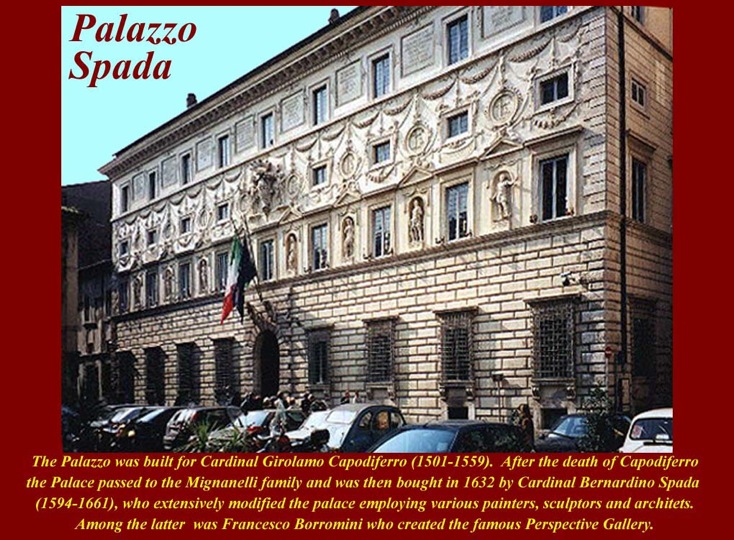
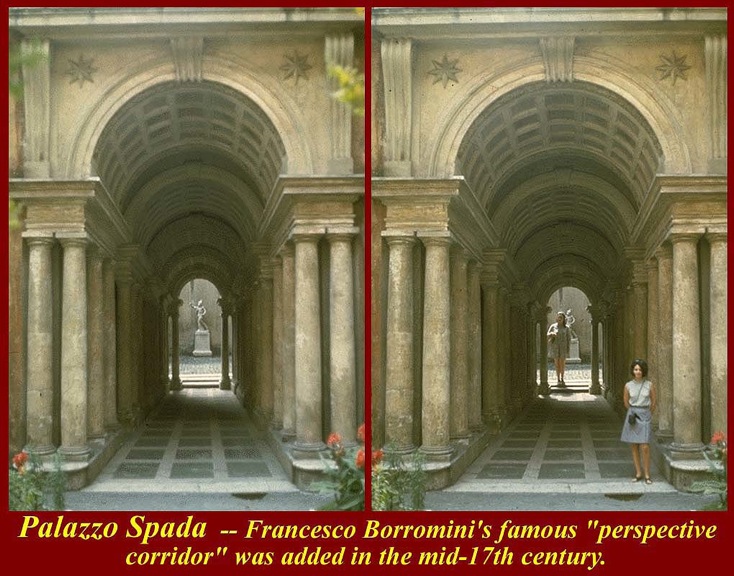
http://www.mmdtkw.org/RenRom0608-PalazzoSpada.jpg
http://www.mmdtkw.org/RenRom0609-SpadaPerspective.jpg
http://www.mmdtkw.org/RenRom0609a-BerniniScalaRegiaVatican.jpg
The Palazzo Spada houses a grand art collection, the Galleria Spada. The collection was originally assembled by Cardinal Bernardino Spada in the 17th century and added to by his grandnephew Cardinal Fabrizio Spada (1643-1717), and by Virginio Spada (1596-1662).
The palace is located in the rione Regola, at Piazza Capo di Ferro, 13, with a garden facing the Tiber, very close to the Palazzo Farnese. It was originally built in 1540 for Cardinal Girolamo Capodiferro. Bartolomeo Baronino, of Casale Monferrato, was the architect, while Giulio Mazzoni and a team provided lavish stucco work inside and out. The palazzo was purchased by Cardinal Spada in 1632. He commissioned Francesco Borromini to modify it for him, and it was Borromini who created the masterpiece of trompe-l'oeil false perspective in the arcaded courtyard, in which diminishing rows of columns and a rising floor create the optical illusion of a gallery 37 meters long (it is 8 meters) with a life size sculpture in daylight beyond: the sculpture is 60 cm high. Borromini was aided in his perspective trick by a mathematician.
The Mannerist stucco sculptural decor of the palazzo's front and its courtyard facades feature sculptures crowded into niches and fruit and flower swags, grotesches and vignettes of symbolic devices (impresi) in bas-relief among the small framed windows of a mezzanine, the richest cinquecento facades in Rome.
The third image shows Rome's other famous trompe-l'oeil false perspective the Vatican scala Regia by Borromini's rival Gian Lorenzo Bernini (1663-66).
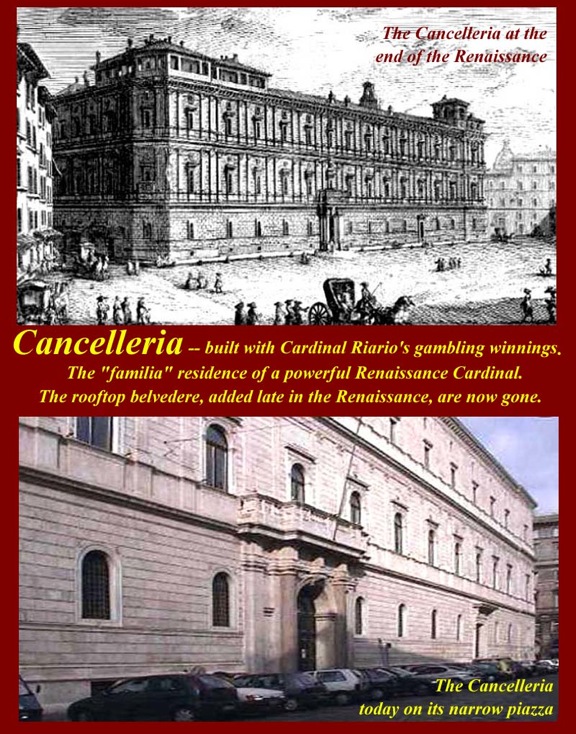
http://www.mmdtkw.org/RenRom0610-CancelleriaExt.jpg
http://www.mmdtkw.org/RenRom0611-CancelleriaCorti.jpg
The papal Cancelleria was constructed between 1489–1513 and was the first palazzo in Rome to be built from the ground up in the new Renaissance style supposedly paid for with the winnings of one night's gambling by Cardinal Raffaele Riario, who held the post of Cardinal Camierlengo to his powerful uncle, Pope Sixtus IV. The long facade with its rhythm of flat doubled pilasters between the arch-headed windows is Florentine in conception, comparable to Leone Battista Alberti's Palazzo Rucellai, although though the concept of drafted masonry is ancient Roman in its origin. The grand doorway was added in the 16th century by Domenico Fontana on the orders of Cardinal Alessandro Farnese.
The building's exterior bone-colored travertine was scavenged from the nearby Roman ruins of the Theatre of Pompey. The forty-four Egyptian granite columns of the inner courtyard are from the porticoes of the theatre's upper covered seating, however they were originally taken from the theatre to build the old Basilica of S. Lorenzo in Damaso. (A newer S. Lorenzo is incorporated in the Palazzo.) In the central rectangular courtyard, the two lower floors are two open ambulatories/loggias. While opinion of the identity of the palazzo's architect is divided, Francesco di Giorgio Martini and Baccio Pontelli may have been involved in the early stages of design. The traditional attribution to Bramante and Andrea Bregno have been largely discredited, though many guidebooks still attribute it to Bramante.
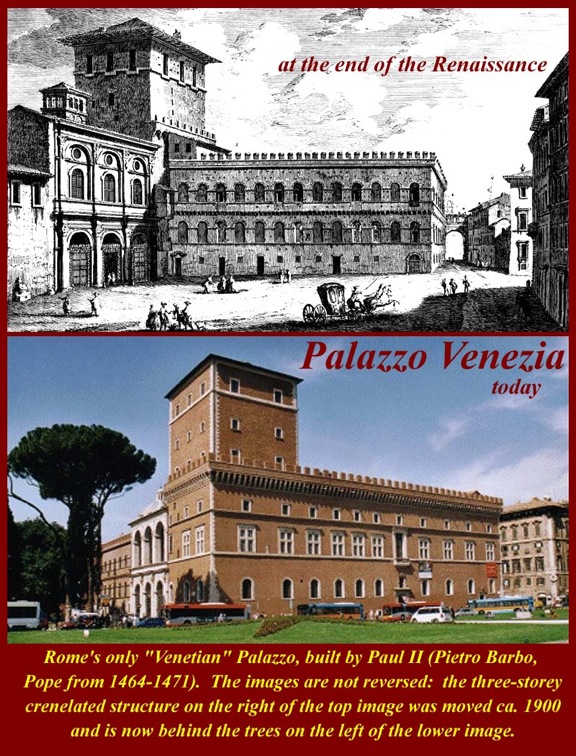
http://www.mmdtkw.org/RenRom0612-PalazzoDeVenezia.jpg
http://www.mmdtkw.org/RenRom0613VeneziaFascist.jpg
The Palazzo di Venezia (formerly Palace of St. Mark) is just north of the Capitoline Hill at the southern side of the Campo Marzio. The palazzo faces Piazza Venezia and Via del Plebiscito. It currently houses the National Museum of the Palazzo Venezia. The original structure of this great architectural complex consisted of a modest medieval house intended as the residence of the cardinals appointed to the Roman church of San Marco. In 1469 it became a residential papal palace, having undergone a massive extension, and in 1564, Pope Pius IV, to win the sympathies of the Republic of Venice, gave the mansion to the Venetian ambassadors on condition that a part of the building should be kept as a residence for the cardinals--the Apartment Cibo--and that the Venetian Republic should provide for the building's maintenance and future restoration. The Palazzo thus was the Embassy of Venice in Rome.
It took on a new layout when, in 1451, Pietro Barbo, son of one of the sisters of Pope Eugenius IV, became cardinal. It was a fortified building, composed of a half- basement and a mezzanine that functioned as a piano nobile, extending over a small area between the basilica and the gate of the present palazzo overlooking the piazza, with a small external tower. It was a building of no exceptional size but was sufficiently dignified as a cardinal's residence so that, even in 1455, Pietro Barbo could proudly boast of it, having a commemorative medal struck in its honor. In 1455, the building manifested some of the first Renaissance architectural features in Rome; although the overall aspect is of a massive, defensible medieval structure with battlemented crown.
It was built around the medieval tower at the right of its facade and incorporated within its mass the ancient Church of San Marco founded by Pope Marcus in 336 and dedicated to the Evangelist who would become protector of Venice. The complex was completely rebuilt in in 833 and often modified since.
Much of the stone to build the palazzo was quarried from the nearby Colosseum, a common practice in Rome until the 19th century. The design is traditionally attributed to Leone Battista Alberti, the Venetian cardinal, Pietro Barbo, who later became Pope Paul II was the patron: he continued to inhabit it even as pope.
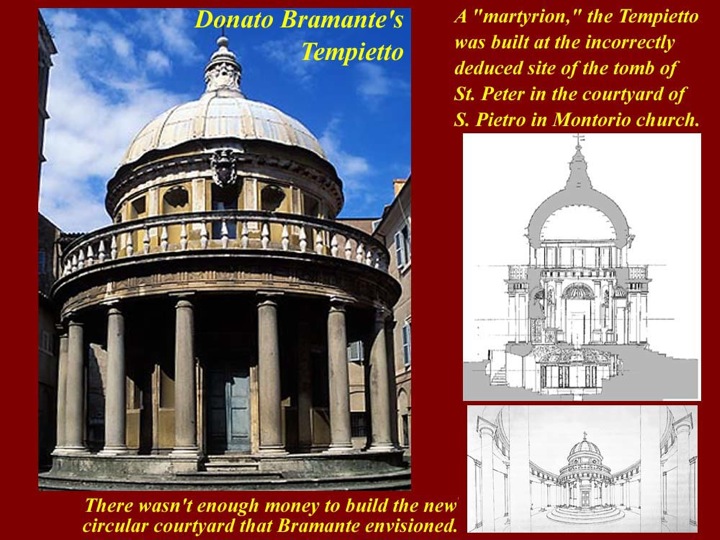
http://www.mmdtkw.org/RenRom0614-BramanteTempiet.jpg
http://www.mmdtkw.org/RenRom0614a-BramanteTempie.jpg
Donato Bramante's Tempieto in the cloister of San Pietro in Montorio, modeled after ancient Roman circular temples, was built by Bramante after 1502, on the commission of the Ferdinand of Aragon and Isabella of Castile. The emphasis here is on the harmony of proportions, the simplicity of volumes (cylinder, hemisphere) and the sobriety of the Doric Order. The circular plan symbolizes divine perfection. Inspired by ancient temples, the Tempietto is both a homage to antiquity and a Christian memorial. Its location was on the incorrectly identified site of the martyrdom of the apostle Peter. The original plan to make the cloister round and to install an outer ring of columns. A bio of Bramante is at http://en.wikipedia.org/wiki/Donato_Bramante.
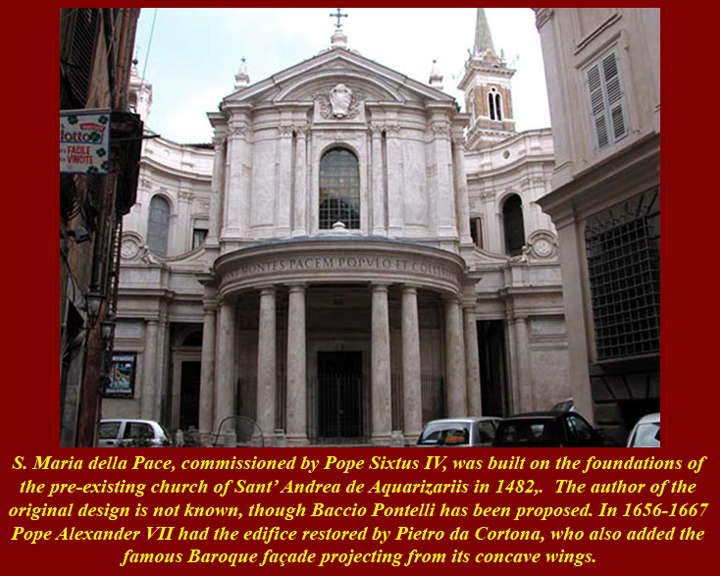
http://www.mmdtkw.org/RenRom0614b-Santa Maria della Pace.jpg
http://www.mmdtkw.org/RenRom0614cMariaPace.jpg
Santa Maria della Pace was known as Sant'Andrea de Aquarizariis until it was rebuilt and a new facade was added in 1482 by Pietro da Cortona on a commission from Alexander VII. The cloister, built from 1500-1504 for Cardinal Oliviero Carafa, was Bramante's first independent architectural work in Rome. A biography of Pietro da Cortona is at http://en.wikipedia.org/wiki/Pietro_da_Cortona.
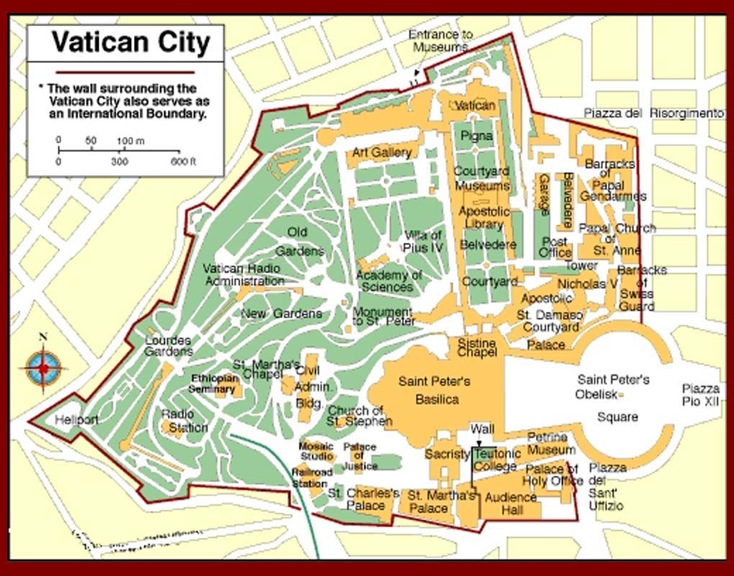
http://www.mmdtkw.org/RenRom0615-VaticanMap.jpg
Vatican City, officially the State of the Vatican City is a landlocked sovereign city-state whose territory consists of a walled enclave within the city of Rome, the capital city of Italy. It has an area of approximately 44 hectares (110 acres) (0.44 km2), and a population of barely over 800. Vatican City as a city-state came into existence in 1929. The Lateran Treaty of that year, which brought the city-state into existence, spoke of it as a new creation and not as a vestige of the much larger Papal States (756-1870) that had previously encompassed central Italy. Most of the papal State territory was absorbed into the Kingdom of Italy in 1860, and the final portion, namely the city of Rome with a small area close to it, ten years later in 1870, (at which time Italian Bersaglieri mountain troops blasted a hole through the ancient Aurelian walls just northwest of the Porta Pia; they easily could have fought their way through that gate, but they did not want to damage Michelangelo's last monumental work, the internal facade of the gate.)
St. Peter's church, the greatest architectural project of the Roman renaissance, lies at the southeast corner of the Vatican.
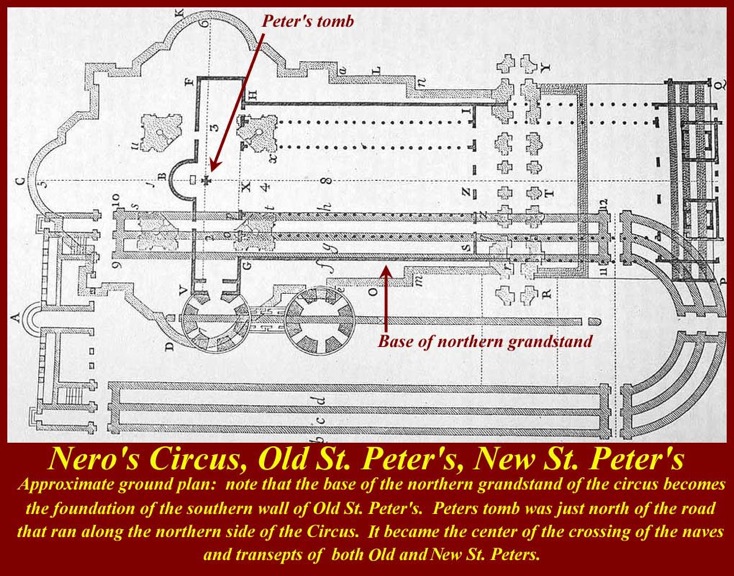
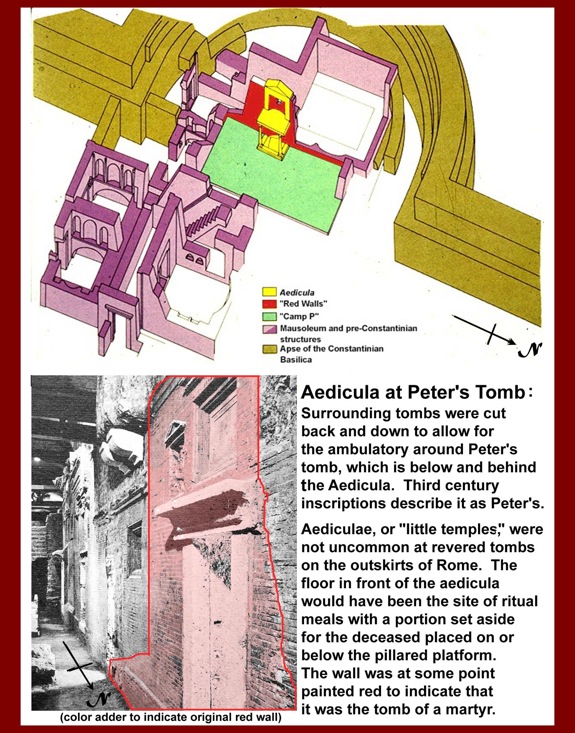
http://www.mmdtkw.org/RenRom0616-SPeter'sGrndPlan.jpg
http://www.mmdtkw.org/RenRom0617-SPetersTomb.jpg
Both "old" (Constantinian) basilica of Peter and the "new"(renaissance) basilica purport to be martyrions, that is, churches built at the site of the entombment of martyrs. Most Christian church historians now believe that Peter was killed at the base of an Egyptian obelisk that Nero had installed at the center of the spina of his circus in the Vatican Hill on the west side of the Tiber. That obelisk was eventually moved to the center of Michelangelo's Vatican square. The cemetery in which Peter was said to have been buried was along a road north of the circus. Cemeteries normally were outside the city's sacred boundary and the Vatican side of the Tiber was where adherents of non-Roman religions lived. In the Christian era, a number of Christian burials were carried out in this area, clustered around a small aedes or temple structure said to mark the tomb of Peter. The wall adjacent to the aedes still retains the red paint that indicated martyrdom and a nearby 2nd century graffito identifies a loculus as that of Peter. For more on the supposed tomb of Peter and the archeological controversies surrounding it, see
(1) http://en.wikipedia.org/wiki/Saint_Peter's_tomb and
(2) http://www.saintpetersbasilica.org/Necropolis/MG/TheTombofStPeter-1.htm and
(3) http://www.saintpetersbasilica.org/Necropolis/JW/TheBonesofStPeter-1.htm.
A map of the Vatican necropolis (cemetery) is at http://www.saintpetersbasilica.org/Necropolis/Scavi-map.htm.
For much more on the St. Peter's Basilica, see http://www.saintpetersbasilica.org/index.htm.
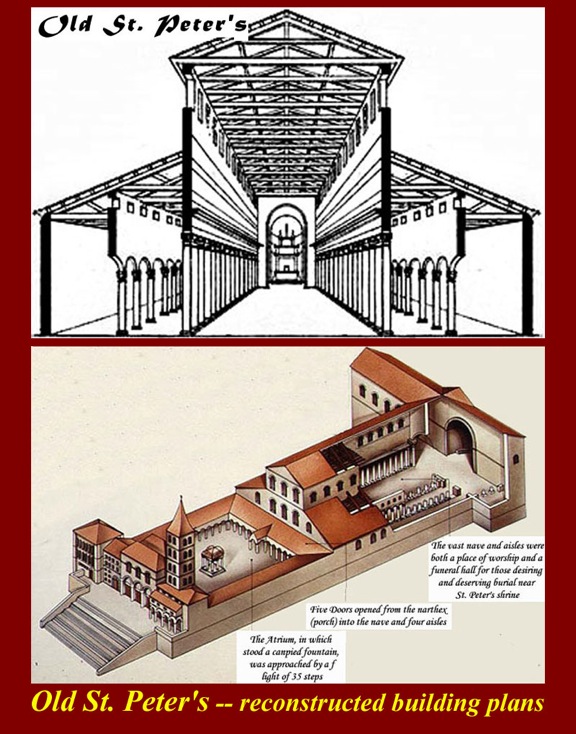
http://www.mmdtkw.org/RenRom0618-SPReconst.jpg
http://www.mmdtkw.org/RenRom0618aOldStPetersCa1450.jpg
By the time of the Renaissance, Old St. Peter's was crumbling and ready to collapse. As can be seen from the images, the old basilica was shaped like a T and it had a large courtyard (of the catechumens) in which candidate members of the church could attend service and ceremonies. The second image is by Marten Jacobszoon Heemskerk van Veen whose bio is at http://en.wikipedia.org/wiki/Marten_Jacobszoon_Heemskerk_van_Veen.
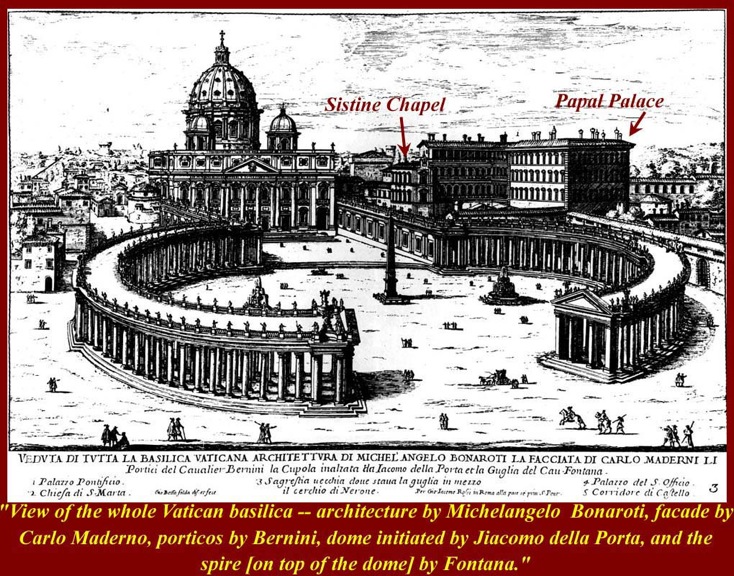
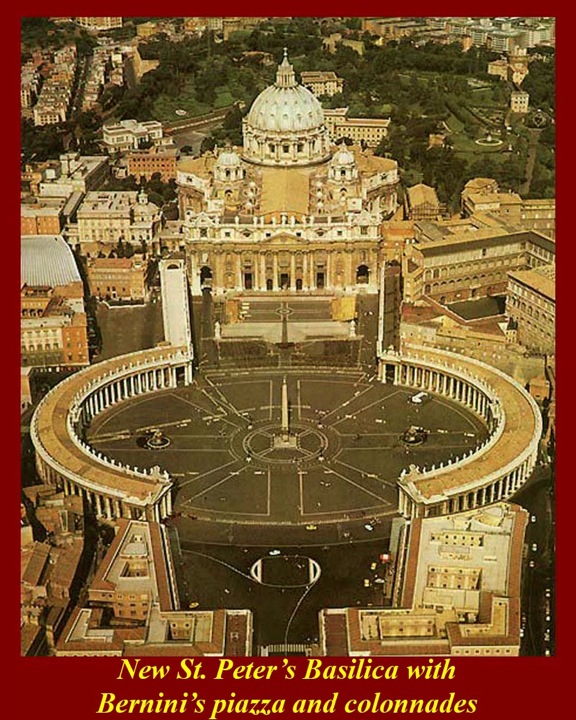
http://www.mmdtkw.org/RenRom0620-FaldaNewStPeters.jpg
http://www.mmdtkw.org/RenRom0621-NewSPetersToday.jpg
The first image is a Giovanni Battista Falda print from an etching made around 1669, about 40 years after the completion of the new basilica. It was one of a series of caption labeled etchings of Roman churches. The second image is, of course, a modern overhead view.
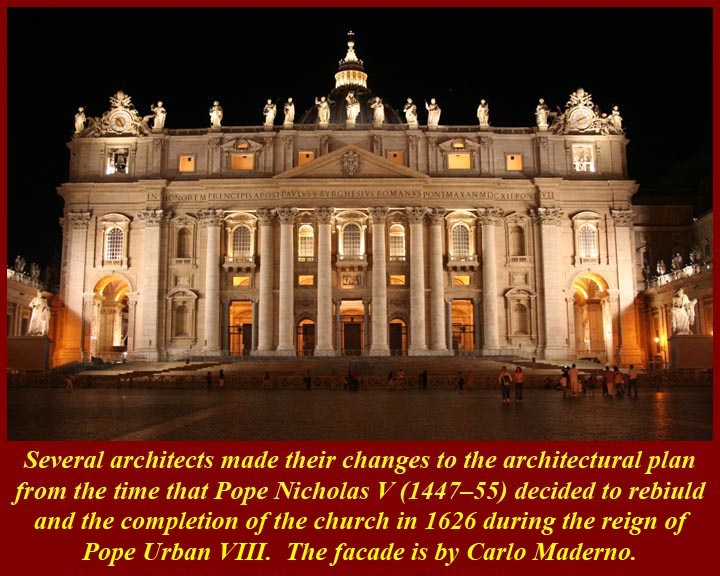
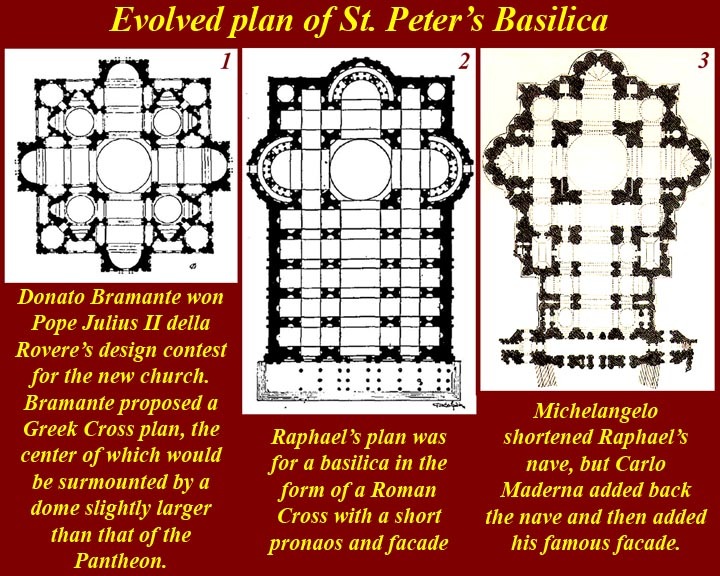
http://www.mmdtkw.org/RenRom0621a-BasilicaPeter.jpeg
http://www.mmdtkw.org/RenRom0621a1-StPetersPlans.jpg
http://www.mmdtkw.org/RenRom0621b-BasilicaPeter.jpg
When Carlo Maderno started to build the facade, he was bound to the already existing Michelangelo wings flanking the central classical element. He just put the attic all around the building, as planned by Michelangelo. That creation looks mighty and dynamic along the west side of the Basilica but is disharmonious in the facade. For this reason, at the far sides of the facade, Maderno planned two bell towers, but 1621, at the death of Paul V, the ground subsided and the building of the two bell towers had to be stopped. Working to Maderno's plan, Bernini tried to erect the bell towers again in 1646 but had to demolish the left-hand side bell tower because of cracks in the facade. Only the bases of the bell towers remain, two archways at the sides of the facade that seem to form part of it while they should have been separated. This was remedied in 1790 by the installation of two clocks designed by Giuseppe Valadier.
The eight gigantic columns of the facade are almost 10ft wide and 90 feet high. For more information on the facade, see http://saintpetersbasilica.org/Exterior/Facade/Facade.htm.
The first image shows the view from St. Peter's Square; although the facade is very wide and defies the canons of classical architecture, it is still high enough to block the view of the Michelangelo's dome. Michelangelo became chief architect of the Basilica in 1546. At the time of his death (1564), the dome was finished as far as the drum, the base on which dome sits. It was vaulted between 1585 and 1590 by the architect Giacomo della Porta with the assistance of Domenico Fontana, who was probably the best engineer of the day. Fontana built the lantern the following year, and the ball was placed in 1593. Only from further back is the majestic dome visible. The third view is from the upper level of Castel Sant'Angelo, which is high enough to give a full view of the facade and the dome over the intervening buildings.
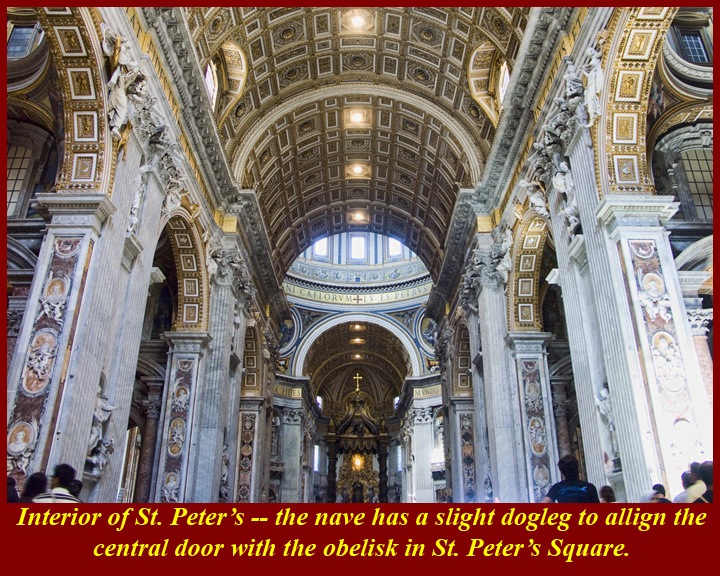
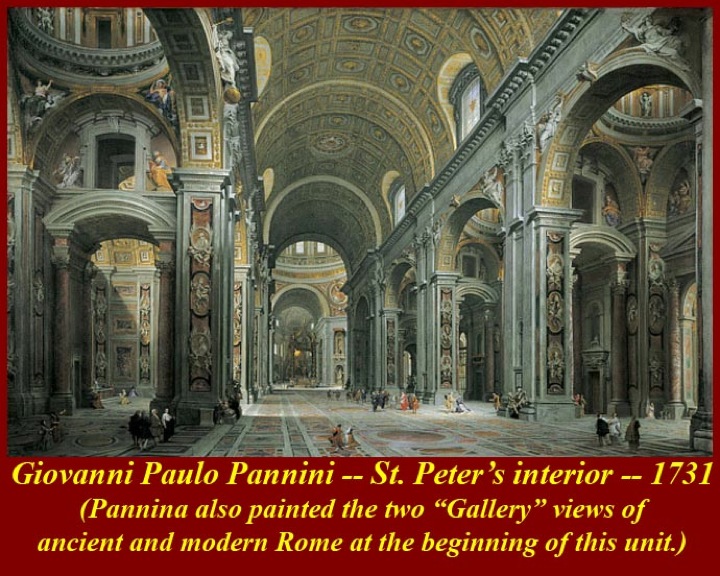
http://www.mmdtkw.org/RenRom0621c-StPetersInterior.jpg
http://www.mmdtkw.org/RenRom0621d-PaniniPetersRome.jpg
http://www.mmdtkw.org/RenRom0621eBaldachinBerniniStPeters.jpg
The interior space of St. Peters is larger than that of any other Christian church. A detailed interactive floor plan is available at http://saintpetersbasilica.org/floorplan.htm. This is undoubtedly the best Internet site for what is inside the Basilica with links to explanations and large scale images, some of which give much better views than those that can be had on an actual visit to the Basilica. If you are planning to visit the Basilica, you should visit this Internet site first.
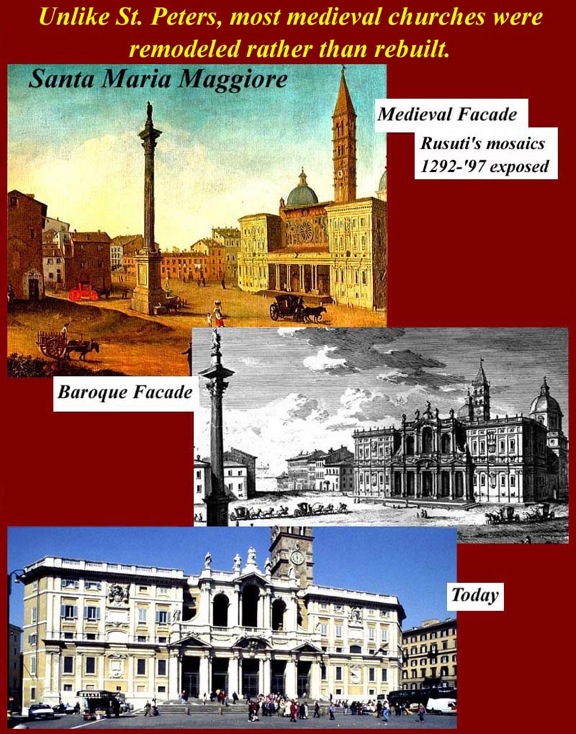
http://www.mmdtkw.org/RenRom0622-MariaMaggioreEvo.jpg
http://www.mmdtkw.org/RenRom0623-John Lateran.jpg
"Rome is said to have more than 500 churches and all but one are Catholic churches." That is no longer precisely true, since the city boundaries now officially take in all the suburbs and a lot of the surrounding countryside. The "only", at least the first, Protestant Church in Rome, St. Paul's Within the Walls, an American Episcopal Church of the Anglican Communion is beyond the purview of this course since it was built in 1873.
Many of Rome's churches have long histories, and the original structures of some of the larger and more important churches have long since seen multiple remodelings into "new" churches -- and by new, we most often mean Renaissance churches, often with even newer Baroque facades. As mentioned earlier, this course will treat the Baroque architectural period as an extension of the Renaissance.
Two of Rome's largest and most important churches are shown in the images above. For information on the Basilica di Santa Maria Maggiore, see
http://en.wikipedia.org/wiki/Basilica_di_Santa_Maria_Maggiore and
http://www.sacred-destinations.com/italy/rome-santa-maria-maggiore and
http://www.vatican.va/various/sm_maggiore/index_en.html and
http://www.panoramas.dk/fullscreen/fullscreen46.html and
http://romeartlover.tripod.com/Vasi48.html and
http://www.ewtn.com/library/CHRIST/MAGGIORE.TXT. (This last link is the text of an article by June Hager, an American woman who as Managing Director of Inside the Vatican, a magazine based in Rome had unparalleled access to the churches of Rome. Several of her articles, along with lavish images by a papal photographer, Grzegorz Galazka, were put together into a book, Pilgrimage: A Chronicle of Christianity through the Churches of Rome, in 1999. (http://www.amazon.com/Pilgrimage-Chronicle-Christianity-through-Churches/dp/1841880671/)For information on San Giovanni in Laterano (St. John Lateran), see http://www.sacred-destinations.com/italy/rome-san-giovanni-laterano and
http://en.wikipedia.org/wiki/Basilica_of_St._John_Lateran and
http://www.newadvent.org/cathen/09014b.htm and
http://sights.seindal.dk/sight/981_San_Giovanni_in_Laterano.html and
http://www.vatican.va/various/basiliche/san_giovanni/vr_tour/index-en.html and
http://www.ewtn.com/library/CHRIST/LATERAN.HTM. (This last link is another article by June Hager.)
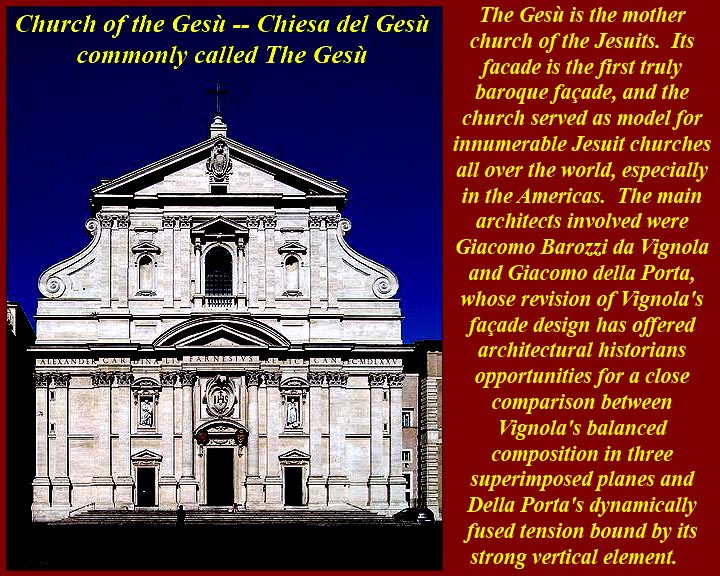
http://www.mmdtkw.org/RenRom0623d-GesuFacade.jpg
The Gesu, the headquarters church of the Jesuits, sits on Piazza della Gesu in Rome. Before the Church was built, the area was famous for its brothels but Ignatius Loyola, the founder of the Jesuits, insisted that the small local church of Sant'Andrea was a suitable church for the home of his newly accredited order. Later cynics and enemies of the Jesuits were later to point out that the site is on the route of Papal processions through the city, and all the Popes since Paul III (Alessandro Farnese, Pope from 1534 to 1549), who authorized the structure, has had ample time to contemplate the Gesu and the Jesuits on their long progresses down the avenue that is now called Corso Vittorio Emanuele III.
The grandiose baroque Gesu church was not the idea of Ignatius Loyola, the founder of the Jesuits. His own much smaller church of Sant'Andrea was replaced by his successors after his death. It is said that the Jesuit taste for grand structures sprung from their experience in the far east where they quickly came to believe that the Christian church could not attract Asiatic congregations unless Christian church structures were bigger and more opulent than the Asiatic temples that were their competition. Among the most opulent features of the Gesu church in Rome is the altar dedicated to Ignatius himself, which is constructed of Gold, silver lapis lazuli and two precious marbles, giallo antico and verde antico. The large ball of lapis at the top of the Ignatius altar is the biggest single piece of lapis in the world. For more on the Ignatius altar, see http://commons.wikimedia.org/wiki/Category:Altar_of_St._Ignatius_in_the_Gesù_(Rome)
There's an old Roman fable about the force and constancy of the wind in front of the Gesu Church. It goes like this.
The Devil and the Wind were walking from the Campidoglio to the Pantheon, and, as they were passing the Gesu, the devil heard preaching inside. Satan told the Wind to wait outside until he returned -- he just wanted to hear the end of the sermon. In went the Devil. And the Wind is still out in front of the Church waiting for that Jesuit preacher to finish.
The facade of the Gesu is the first truly Baroque facade anywhere, and it served as a model for numerous churches around the world, especially for Jesuit churches in the Americas. Its architects were, first, Giacomo Barozzi da Vignola and then Giacomo della Porta who added the strong vertical elements.
The Baroque period made marked changes in Renaissance architecture and some architectural historians say it should not be considered part of the Roman renaissance (but those guys are mostly Baroque architecture specialists who never learned how to share as children). The problem, of course, in not treating Baroque architecture in a course on the Roman Renaissance is that so many of Rome's Renaissance architectural projects were not completed until the Baroque period started with St. Peter's being one of the prima examples; Maderno's facade is Baroque as is Bernini's great piazza in front of the Church.
For more on the Gesu, see http://en.wikipedia.org/wiki/Church_of_the_Gesu and http://www.absoluteastronomy.com/topics/Church_of_the_Gesu.
For more on examples of Baroque architecture in Rome, see http://www.arthist.umn.edu/aict/html/renbrq/brqarch.html.
For more on the Baroque in general, see http://en.wikipedia.org/wiki/Baroque.
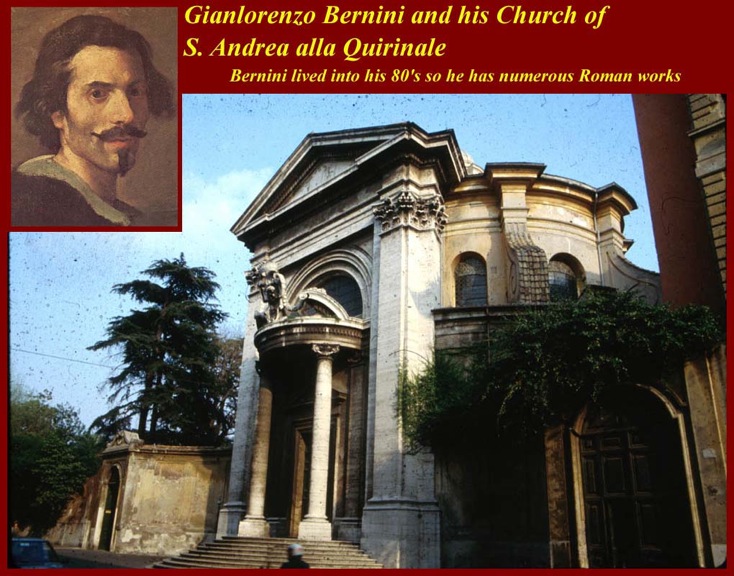
http://www.mmdtkw.org/RenRom0623e-AndreaQuiBernini.jpg
http://www.mmdtkw.org/RenRom0623f-GianLorenzoBernini.jpg
After Vignola and Laporta and Bernini, the next important exponents of Baroque architecture were the rivals, Gian Lorenzo Bernini and Francesco Borromini. Bernini always had the advantage in their conflicting quests for great architectural commissions; he was dapper, suave, ingratiating, and clean. Borromini was the opposite.
Although he is justly most famous as a sculptor, Bernini had numerous architectural commissions in his long life of 82 years. Among them was the architectural gem, Sant'Andrea al Quirinale, across the street from the Palazzo Quirinale, now the residence of the Italian President (the Papal residence until 1870, when, in the days after the Bersaglieri mountain troops of the Italian states blasted their way into Rome, Pius IX legged it for the Vatican). For more information on S. Andrea al Quirinale, see http://www.bluffton.edu/~sullivanm/andrea/andrea.html and http://en.wikipedia.org/wiki/Sant'Andrea_al_Quirinale.
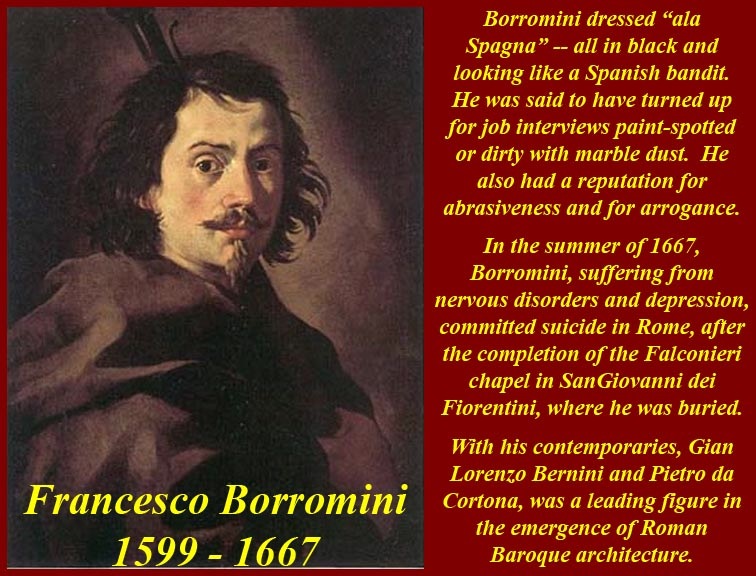
http://www.mmdtkw.org/RenRom0623g-Borromini.jpg
http://www.mmdtkw.org/RenRom0623h-BorrominiBarberiniSpiral.jpg
Although Borromini was less successful than Bernini at getting large architectural commissions in Rome, his work has always been considered more innovative than Bernini's, and, of course, that was also part of his problem. After he and Bernini parted ways (they had worked together on early commissions), Bernini apparently made it a point to advertise the oddness of some of Boromini's architecture. But some of Borromini's work set patterns that were followed elsewhere in Rome, in Italy, and further afield -- like the helicoid spiral staircase he designed early in his career in the Palazzo Barberini. Barberini's staircase in the other wing of the Palazzo is just single straight flights of stairs around an air shaft. Barberini's air shaft now houses the elevators of the Barberini Museum in the Palazzo, while the Borromini helix is preserved in pristine condition as one of the main attractions of the Palazzo. For more information on Borromini, see http://en.wikipedia.org/wiki/Francesco_Borromini and http://www.greatbuildings.com/architects/Francesco_Borromini.html.
For the Barberini Palace, see http://romeartlover.tripod.com/Vasi36.html.
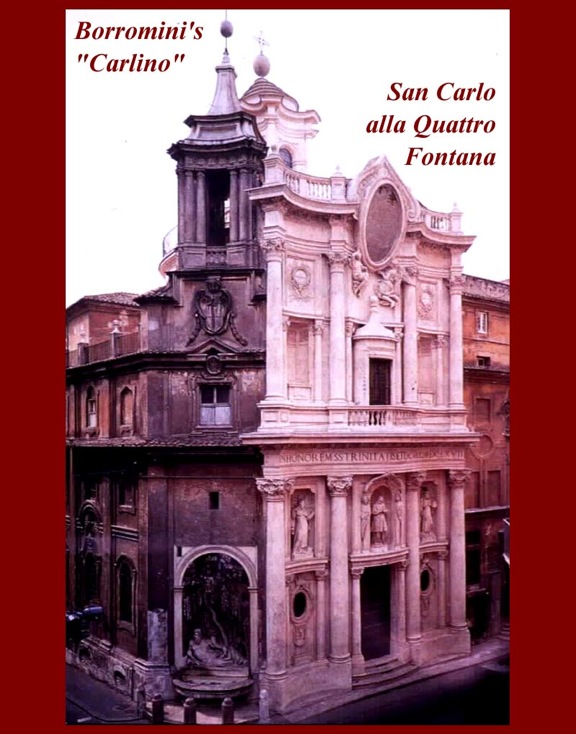
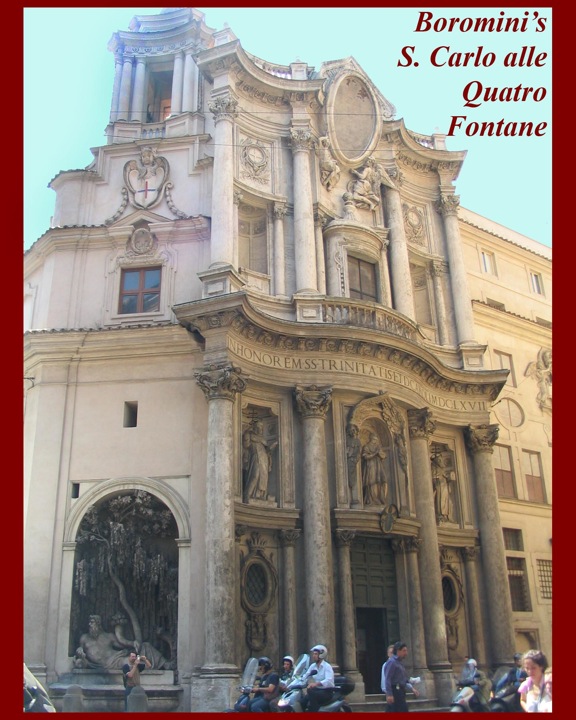
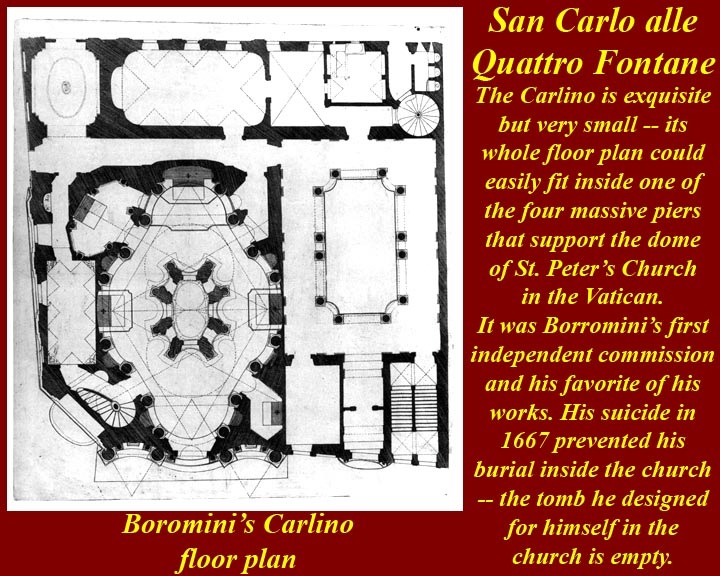
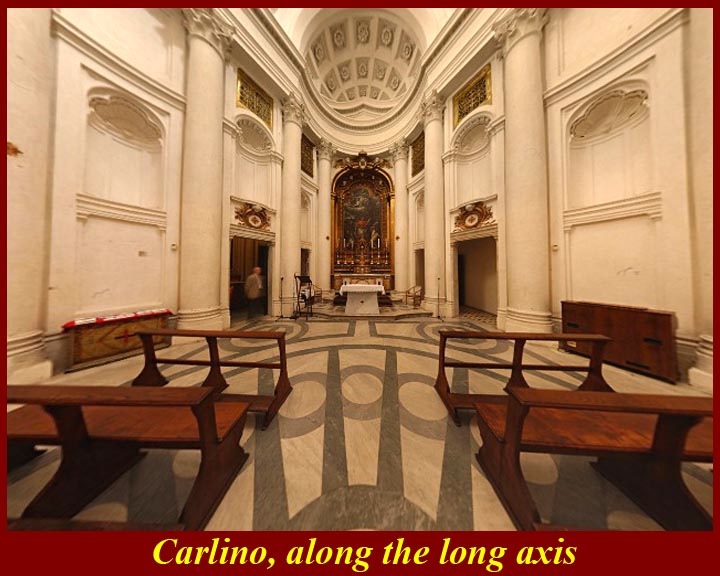
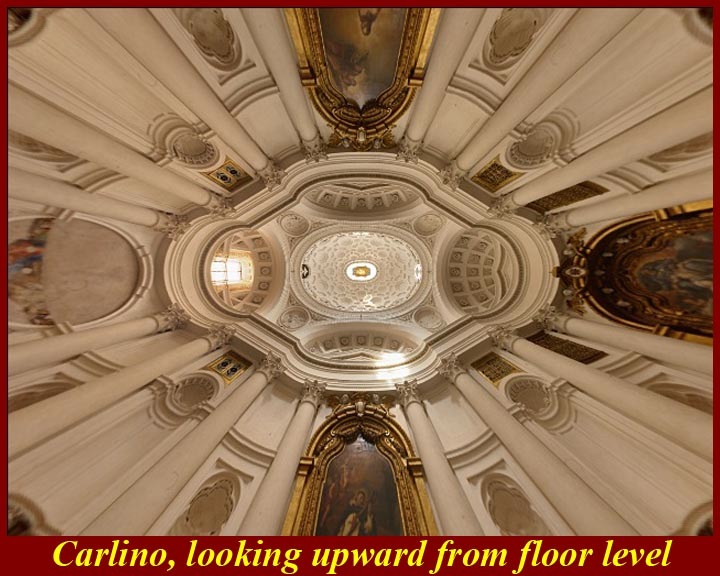
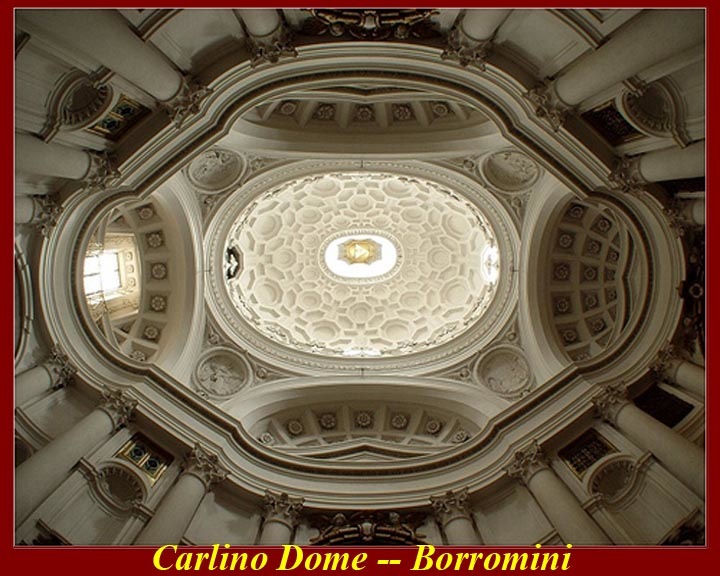
http://www.mmdtkw.org/RenRom0624-CarlinoBorromini.jpg
http://www.mmdtkw.org/RenRom0625-Carlino.jpg
http://www.mmdtkw.org/RenRom0625a-BorrominiCarlinoPlan.jpg
http://www.mmdtkw.org/RenRom0625b-CarlinoInterior.jpg
http://www.mmdtkw.org/RenRom0625c-CarlinoUpward.jpg
http://www.mmdtkw.org/RenRom0625d-CarlinoDome.jpg
http://www.mmdtkw.org/RenRom0625e-Carlino.jpg
Francesco Borromini's first independent architectural work was the Church of San Carlo (Boromeo) alle Quattro Fontane, so named because it occupied one corner of an intersection that had a fountain built into each of the buildings on the intersection's corners. It is also known as the "Carlino" because of its diminutive size.
Borromini's commission for the Carlino came on the recommendation of Barberini, who had recently taken over the project at St. Peter's Basilica. Some said that Barberini had sought the commission for Borromini to get Borromini off the St. Peter's work site where he had become a nuisance. Borromini had worked as a stonemasory foreman for his distant relative, Carlo Maderno, at St. Peter's, and, when Maderno died in 1629, Borromini joined the group under Gian Lorenzo Bernini completing the St Peter's facade. But, the gossips said, Borromini really thought that he, rather than Bernini, should have been been the successor of his "godfather", Maderno. At any rate, it was said that in 1634 Borromini immediately became engrossed in his new project and turned it into a little gem; the Carlino could easily fit inside the footprint of any of the four massive piers that support the dome of St. Peter's. It's almost as if Borromini squeezed in the sides of the Carlino to allow himself to design both a church and a cloister on the small property of the Spanish Trinitarians, an order dedicated to freeing Christian slaves.
Among Borromini's innovations on this project were the undulating facade, the quirky lantern on the top of the dome, and the squeezed oval dome itself, clearly an expedient to raise a credible dome over a narrow space. (Bernini copied the idea, turned 90 degrees, in 1668 in his Sant' Andrea al Quirinale just down the street from the Carlino.)
See http://en.wikipedia.org/wiki/San_Carlo_alle_Quattro_Fontane and http://www.greatbuildings.com/buildings/S_Carlo_Alle_Quattro_Fonta.html.
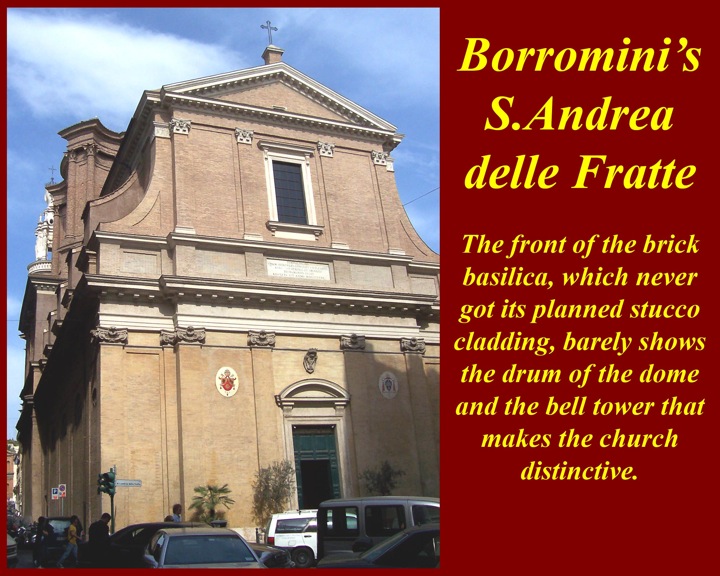
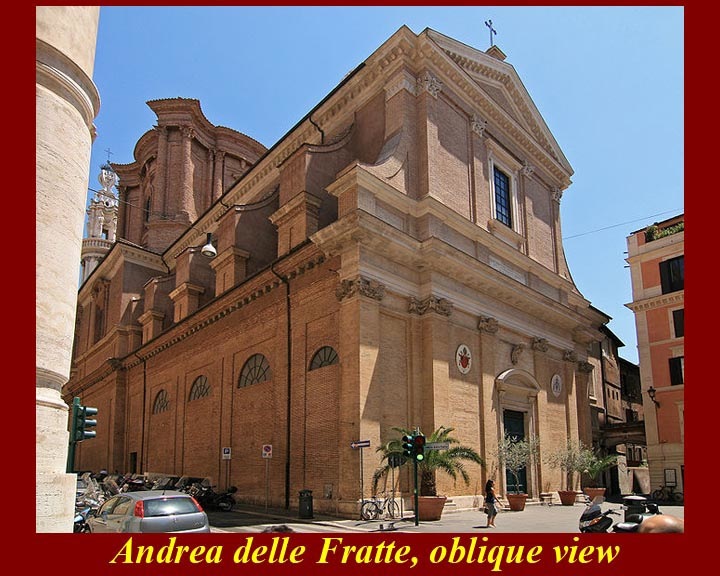
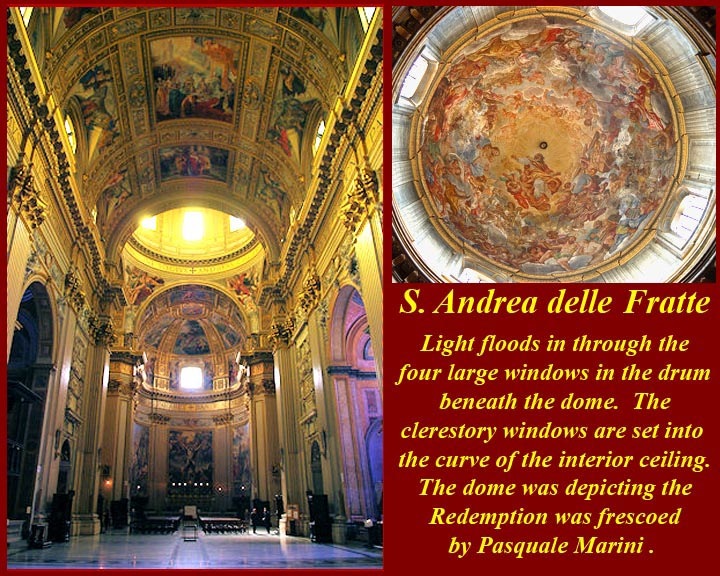
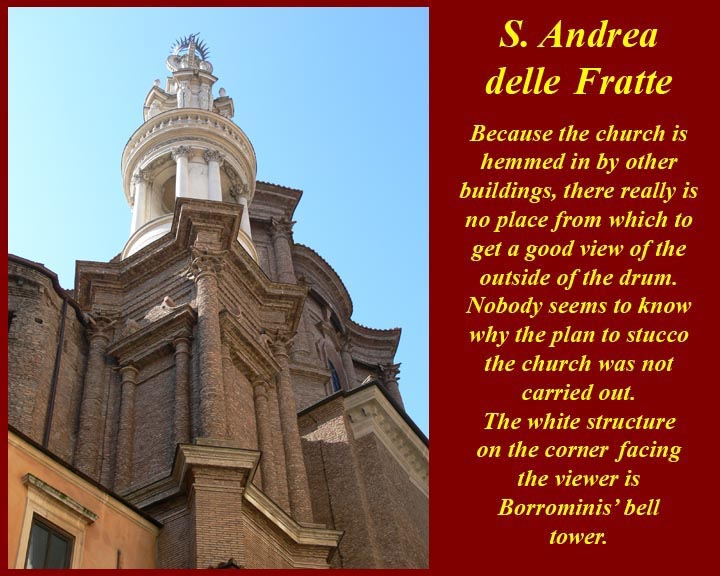
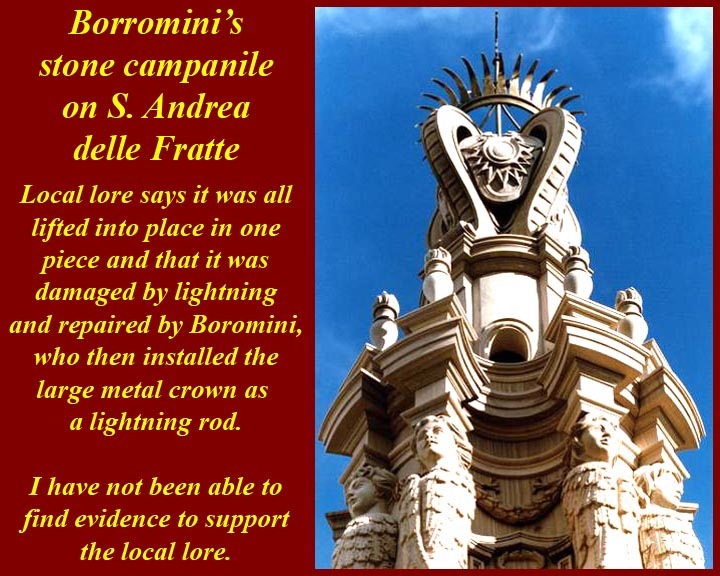
http://www.mmdtkw.org/RenRom0626-AndreaDelleFratte.jpg
http://www.mmdtkw.org/RenRom0626a-AndreaFratteExt.jpg
http://www.mmdtkw.org/RenRom0626b-AndreaFratteInterior.jpg
http://www.mmdtkw.org/RenRom0626c-AndreaFratteTambour.jpg
http://www.mmdtkw.org/RenRom0626d-CampanileAndreaDelleFratte.jpg
http://www.mmdtkw.org/RenRom0626e-AndreaFratteOverhead.jpg
Borromini's Sant'Anfrea delle Fratte looks like a normal enough Baroque church from the front, but an oblique view allows us to see that there is some innovative -- some have said strange -- architecture in its roof. The inside appears to be almost standard -- a long high nave, a drum supporting a dome over the intersection of the nave and the transept arms, clerestory windows set into the curvature of the vault over the nave. From behind the church you can see the huge brick drum, but no dome protrudes above it -- it's all inside as is clear from the overhead view. The stone campanile, said to have been designed and carved by Borromini, is also said to have been lifted to its tall brick base in one piece. And local lore says it was almost immediately struck by lightning and that Borromini repaired it and emplaced the huge coronal lightning rod on top. There's no telling whether what is said is actually true. It does appear that the huge buttresses were a later addition; from inside the attic above the interior vault, it's possible to see traces of earlier windows where each buttress now is. Borromini wanted to stucco the whole exterior of the brick structure, but no trace of plasterwork has ever been found.
Two marble angels made by Gian Lorenzo Bernini for the Ponte Sant'Angelo are kept here, near the high altar. They are the only angels for that project that were made by him; the ones on the bridge were made by his pupils. As do the angels on the bridge, Bernini's angels hold two symbols of Christ's Passion, the scroll and the Crown of Thorns. As might be expected, Bernini's angels are the tourist draw for this church rather than Borromini's Architecture.
For more on this church, see http://romanchurches.wikia.com/wiki/Sant'Andrea_delle_Fratte. You can see Bernini's angels (and other Roman Baroque angels) at http://www.romeartlover.it/Angels.html.
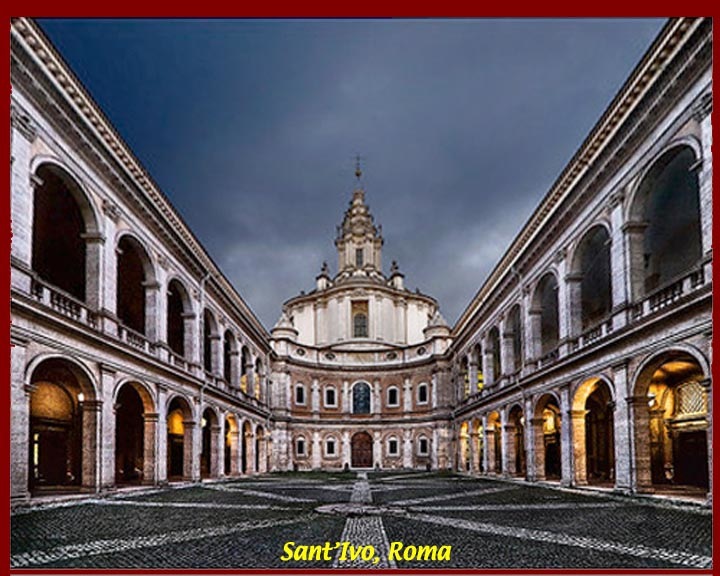
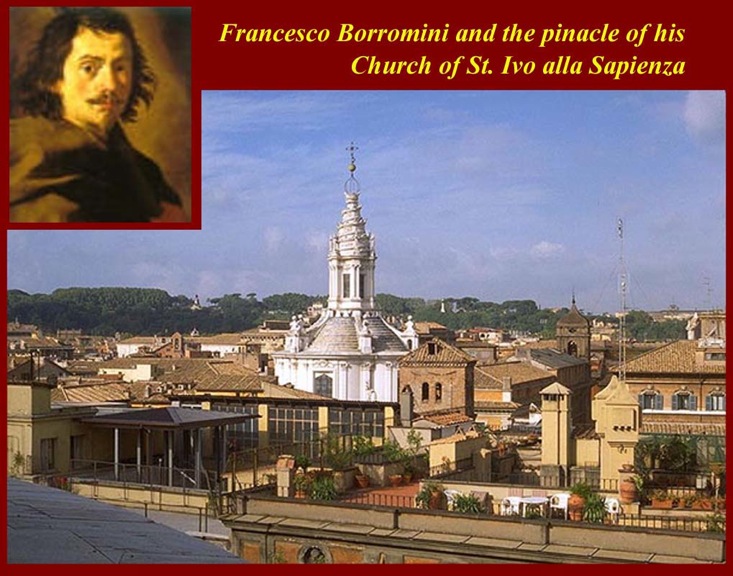
http://www.mmdtkw.org/RenRom0627-BorominiSantIvo.jpg
http://www.mmdtkw.org/RenRom0627a-SIvoBorromini.jpg
http://www.mmdtkw.org/RenRom0627b-SantiIvoIntDome.jpg
At Rome's La Sapienza University, officially Sapienza - Università di Roma (founded 1303), Borromini was again forced to design a church that would fit into a pre-defined space in a pre-existing palazzo. He choose a plan resembling a star of David, and merged the facade of the church with the courtyard of the palace. The dome, with its corkscrew lantern, is remarkable in its novelty. The complex rhythms of the interior have a dazzling geometry to them. It is a rational architecture- intricate to view, but on paper the overlap of a circle on two superimposed equilateral triangles creates a basis for a hexagonal array of chapels and altar in a centralized church. The undulations, both concave and convex of the interiors, create a jarring yet stunning appeal. The decoration is a mixture of novel organic (six-winged cherubic heads) and geometric (stars), more platonic than the contemporary gilded and plaster excesses of Bernini. Rising along the base of three of the dome's pillars are the symbol of the papal Chigi family, the "six mountain beneath a star". The main artwork of the interior is the altarpiece by Pietro da Cortona, portraying St. Yves.
For more information including Borromini's interlocking geometric plans for Sant'Ivo, see http://www.greatbuildings.com/buildings/S._Ivo_della_Sapienza.html.
For more information on La Sapienza University see http://en.wikipedia.org/wiki/Sapienza_University_of_Rome.
For the world's oldest universities see http://en.wikipedia.org/wiki/List_of_oldest_universities_in_continuous_operation.
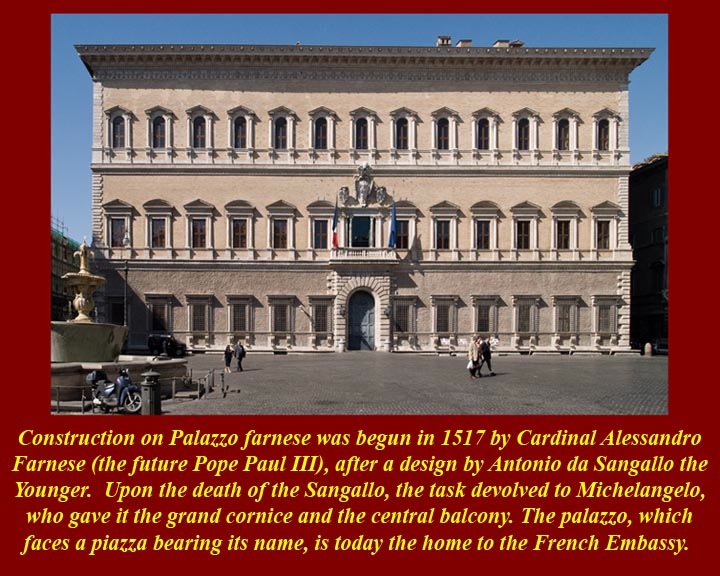
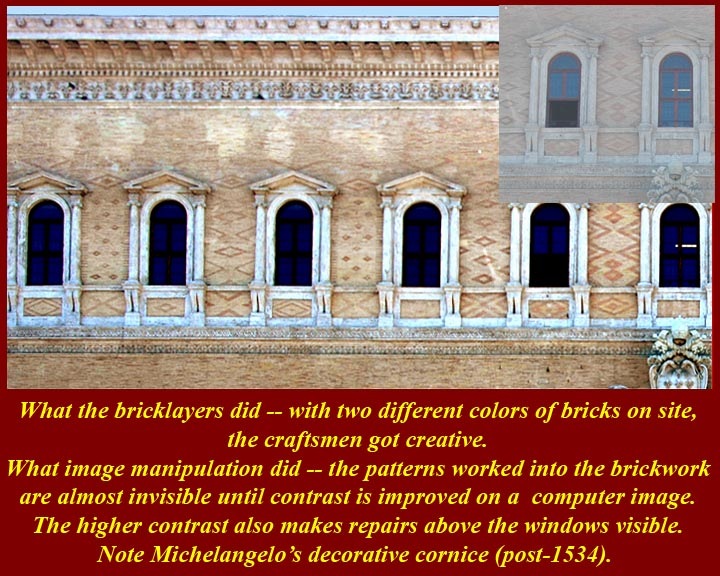
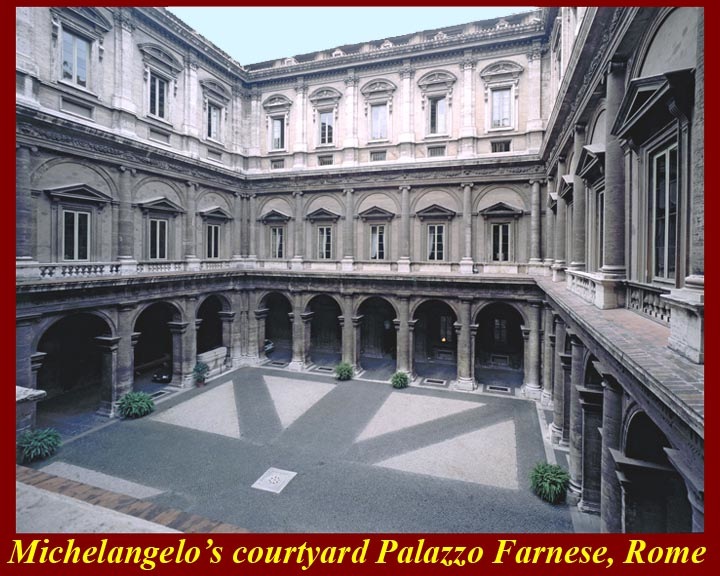
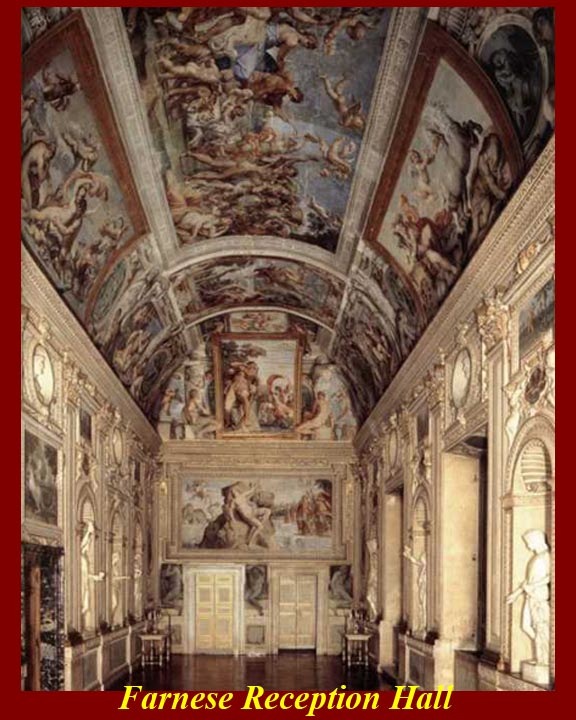
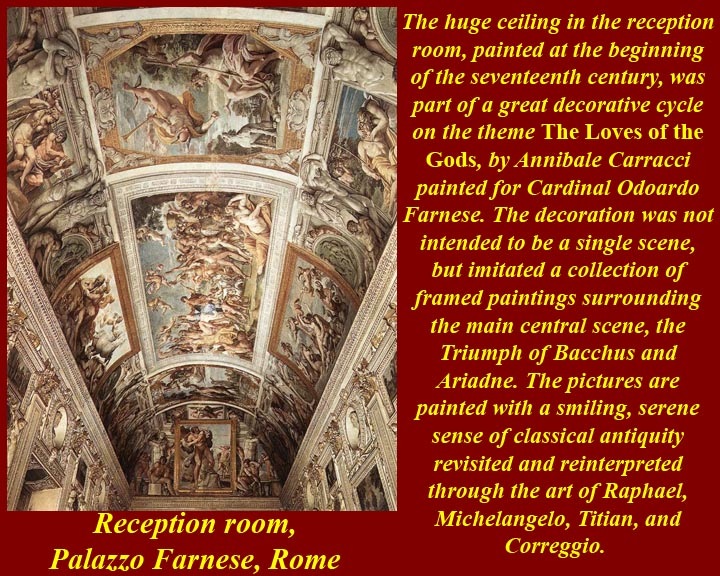
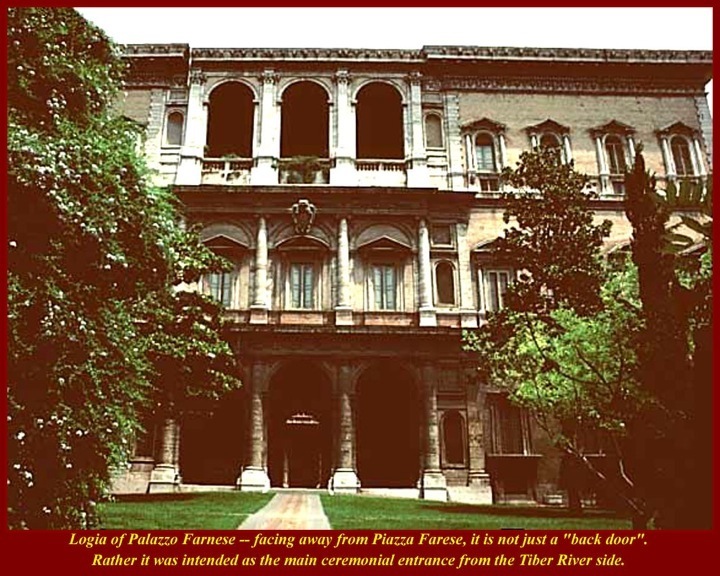
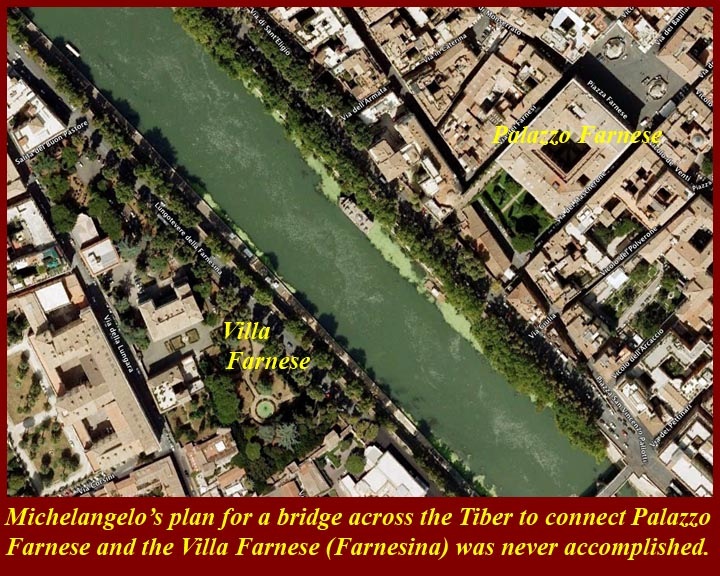
http://www.mmdtkw.org/RenRom0628-PalazzoFarnese.jpg
http://www.mmdtkw.org/RenRom0628a-PalFarneseBricks.jpg
http://www.mmdtkw.org/RenRom0628b-FarneseMichelangeloCourtyard.jpg
http://www.mmdtkw.org/RenRom0628c-FarneseReceptionCarracci1.jpg
http://www.mmdtkw.org/RenRom0628d-FarneseReceptionCarracci.jpg
http://www.mmdtkw.org/RenRom0628e-LoggiaFarnese.jpg
http://www.mmdtkw.org/RenRom0628f-FarneseBridge.jpg
http://www.mmdtkw.org/RenRom0628g-FarneseCapralola-.jpg
The Farnese family was an influential family in Renaissance Italy. Its most important members included Pope Paul III (Alessandro Farnese) and his grandson, Cardinal Alessandro Farnese, and the titles of Duke of Parma and Piacenza and of Castro were held by various members of the family. There is much confusion about the Farnese, because for several generations many of the important men were named Alessandro. Farnese women later married into the Bourbon line that ruled Naples and then into Napoleon's family thereby giving a slight semblance of legitimacy to Joseph, Napoleon's brother, during his two year reign as King of Naples.
A number of important architectural works and antiquities are associated with the Farnese family, either through construction or acquisition. Some of the Roman/Italian antiquities retained by the Louvre in Paris were "inherited" from the Neapolitan Farnese -- but were seized by Napoleon. Buildings include the Palazzo Farnese in Rome and the Villa Farnese at Caprarola.
Palazzo Farnese was designed by Antonio da Sangallo the Younger (1484-1546), one of Bramante's assistants in the design of St. Peter's. Construction began in 1515 after one or two years of preparation, commissioned by Alessandro Farnese, who had been appointed as a Cardinal in 1493 at age 25 (thanks to his sister, who was Pope Alexander VI Borgia's official mistress) and was living a princely lifestyle. Work was interrupted by the Sack of Rome in 1527.
In January 1534, Cardinal Alessandro became Pope Paul III, and the size of the palace was increased significantly. He employed Michelangelo who completed the redesigned third story with its deep cornice and revised the courtyard as well. The post-1534 developments were not only a reflection of Alessandro's change in status but employed architecture to express the power of the Farnese family, much as at their Villa Farnese at Caprarola.
Notable features of the Palazzo Farnese's facade, facing Piazza Farnese, are the alternating rounded and peaked pediments above the windows of the piano nobile, (the second level, which held the ceremonial rooms and important apartments), the rusticated central portal, and Michelangelo's projecting cornice. Michelangelo revised the central window of the piano nobile after Paul III became pope, adding an architrave to support the largest coat-of-arms with papal tiara that Rome had ever seen. When Paul stepped to the balcony, the entire facade became a setting for his person. The two fountains in the Piazza are granite tubs that the Farnese brought from the Baths of Caracalla in the 16th century. They commissioned the architect Girolamo Rainaldi to fashion them into two fountains (http://www.italian-architecture.info/ROME/006b.jpg). The Palazzo's "back porch", an imposing three level loggia, was actually its ceremonial entrance for guests arriving via the Tiber. The Cardinal would normally stand in the middle of the second level (which was not closed off by windows during the Renaissance), on the level of the piano nobile, and greet visitors from above. Only for the most important visitors would he descend to ground level.
Coming off the western corner of the Palazzo is Michelangelo's bridge which spans the Via Giulia and connect the palace to an outbuilding closer to the Tiber. During his papacy, Paul III would cross the bridge to his private retreat. Michelangelo had planned that the bridge would extend all the way across the Tiber to the Farnese Villa on the western bank (the "Farnesina"), but that project was never carried out.
In Puccini's opera Tosca, (1900), set in Napoleonic Rome, the heroine's confrontation with the malevolent Chief of Police, Scarpia, takes place in Palazzo Farnese. One filmed version of Tosca, available on DVD, was actually made in the three locations in which th opera was set: Act 1 is filmed in the Roman church of Sant'Andrea della Valle, Act 2 in Palazzo Farnese, and Act 3 is on the roof of Castel Sant'Angelo.
DVD: http://www.amazon.com/Puccini-Kabaivanska-Luccardi-Mariotti-Bartoletti/dp/B0007P0LOI
Sant'Andrea: http://en.wikipedia.org/wiki/Sant%27Andrea_della_Valle
Palazzo Farnese: http://en.wikipedia.org/wiki/Palazzo_Farnese,_Rome
Castel Sant'Angelo: http://en.wikipedia.org/wiki/Castel_Sant%27Angelo
--------------------
The Palazzo was inherited from the Farnese by the Bourbon kings of Naples, from whom the French government purchased it in 1874. Though the government of Mussolini ransomed it in 1936, the French Embassy remains, under a 99-year lease. For the Villa Farnese, see http://www.italian-architecture.info/ROME/RO-006.htm and http://en.wikipedia.org/wiki/Palazzo_Farnese,_Rome and http://www.romeartlover.it/Vasi73.htm.
For Villa Farnese at Caprarola, see http://www.greatbuildings.com/buildings/Villa_Farnese.html (which has pictures and plans) and http://en.wikipedia.org/wiki/Villa_Farnese.
For Paul III, see http://en.wikipedia.org/wiki/Pope_Paul_III and http://www.newadvent.org/cathen/11579a.htm.
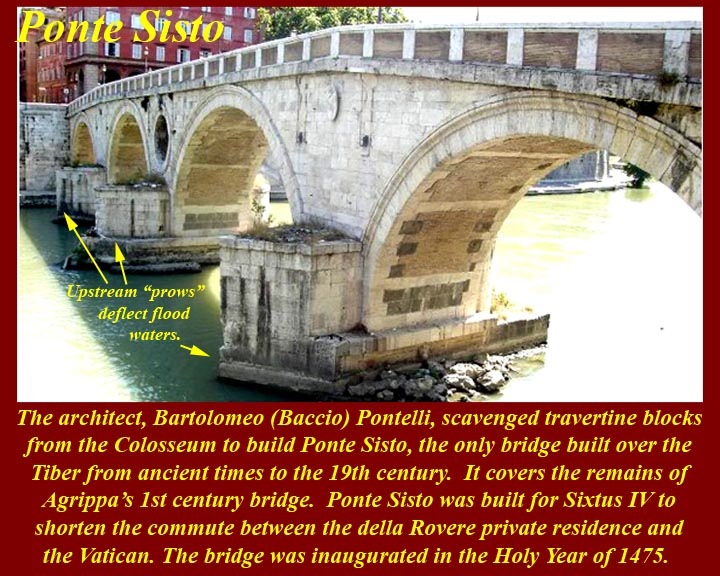
http://www.mmdtkw.org/RenRom0629-PonteSisto.jpg
The Ponte Sisto is a bridge built by architect Bartolomeo ("Baccio") Pontelli of scavenged travertine from the Colosseum. Opened in 1475, its main purpose was to shorten the commute of Sixtus IV della Rovere. Remains of a 1st century AD bridge built by Marcus Agrippa for Augustus are incorporated -- the darker stones under the arches in the image. It is now a pedestrian bridge. See http://en.wikipedia.org/wiki/Ponte_Sisto. For images of all of Rome's bridges, see http://catholic-resources.org/AncientRome/Tiber.htm.
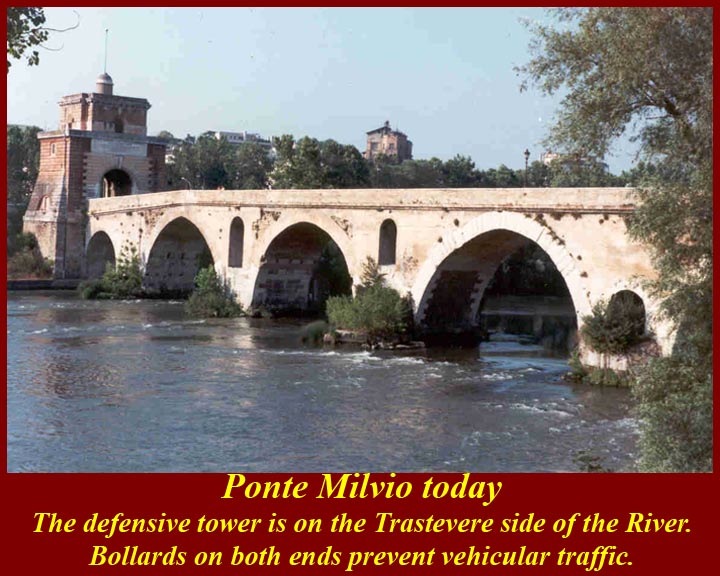
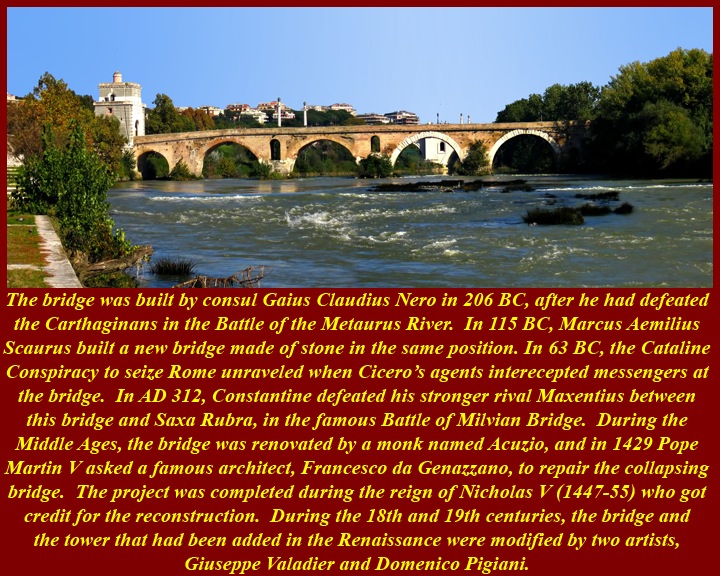
http://www.mmdtkw.org/RenRom0629a-Ponte-Milvio.jpg
http://www.mmdtkw.org/RenRom0629b-MilvioDownStream.jpg
http://www.mmdtkw.org/RenRom0629c-Piranesi-Ponte-Milvio.jpg
Famous battles, conspiracies, monks, popes all provided the history of the Ponte Milvio. The Bridge was rebuilt by Francesco da Ganazzano on a 1429 commission from Pope Martin V, but the job was not completed until the reign of Nicholas V (1447-55) so Nicholas was credited with the project, which included the large defensive tower on the Trastevere end of the bridge. It is now open for pedestrian traffic only. See http://en.wikipedia.org/wiki/Ponte_Milvio and http://en.wikipedia.org/wiki/Battle_of_the_Milvian_Bridge and http://www.romeartlover.it/Vasi84.htm.
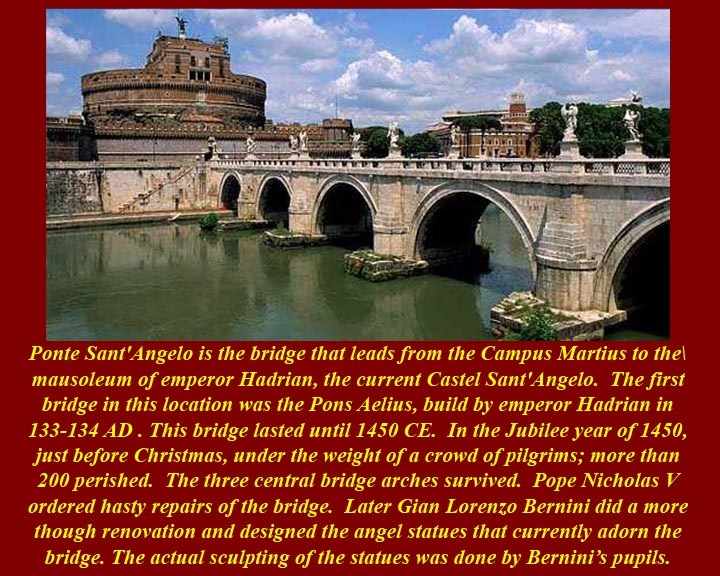
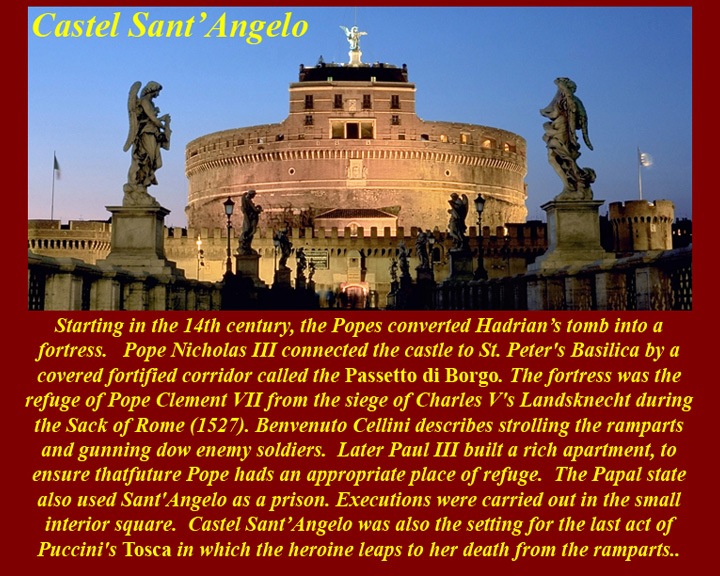
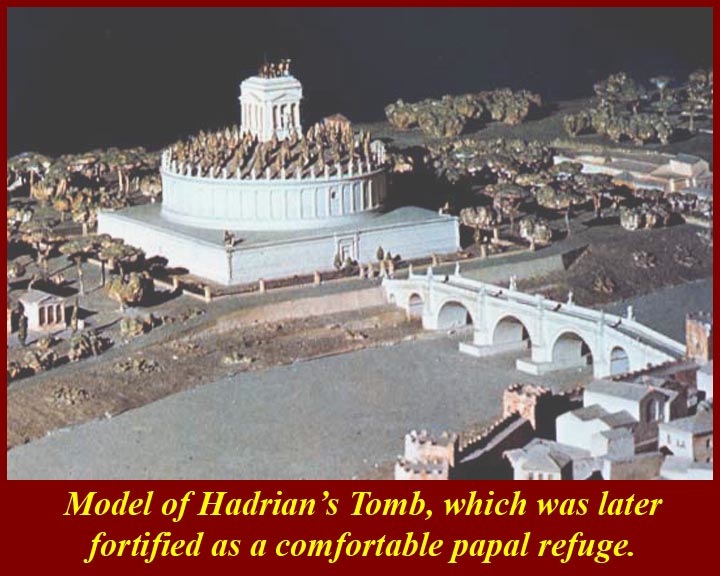
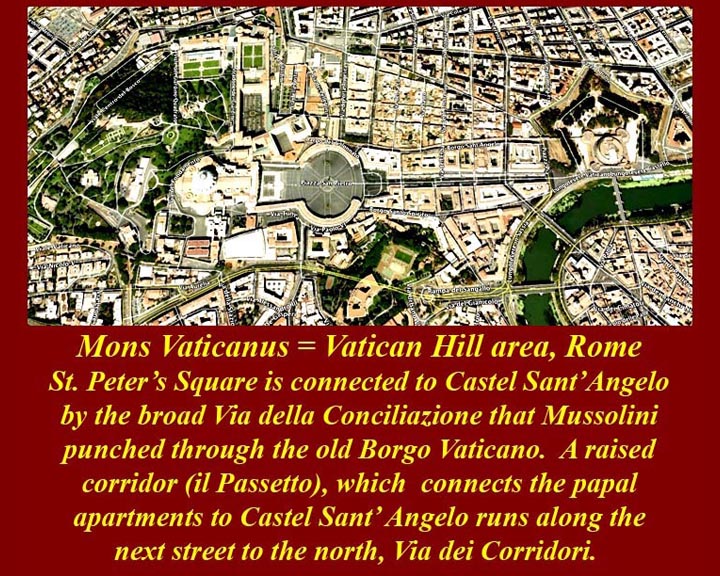
http://www.mmdtkw.org/RenRom0629d-PonteSantAngelo.jpg
http://www.mmdtkw.org/RenRom0629e-CastelSantAngelo-2.jpg
http://www.mmdtkw.org/RenRom0629f-HadrianTomb.jpg
http://www.mmdtkw.org/RenRom0629g-SantAngeloPassetto.jpg
http://www.mmdtkw.org/RenRom0629h-Passetto.jpg
In 1450 Pope Nicholas promoted the first great Jubilee Year after the end of the Great Western Schism, and crowds of pilgrims responded. An almost inevitable result was an outbreak of plague in overcrowded Rome. and that was followed by the deaths of almost 200 pilgrims either in a collapse or a crush of the crowd on the ancient Roman Pons Aelius. The Pons Aelius had originally been built across the Tiber for Hadrian (whose family name was attached to the bridge) in 133-34 AD to give access to his mausoleum on the Trans Tiber (Trastevere) side of the River. Whether the bridge actually collapsed or not, orders were immediately given to widen and rebuild the bridge to provide access to St. Peter's and the Vatican from the eastern side where the other pilgrimage churches were located. Later, the Bridge was decorated with angels sculpted by Gian Lorenzo Bernini and his students. Only two were actually done by Bernini himself, and they were ultimately moved to the inside of the church of Sant'Andrea delle Fratte. Replicas were placed on the bridge to replace Bernini's angels.
Starting already in the the fourteenth century the popes had begun to rebuild Hadrian's tomb as a fortified retreat. It was called Castel Sant'Angelo because of the supposed appearance of the Archangel Michael appeared atop the mausoleum, sheathing his sword as a sign of the end of the plague of 590.
Much of the tomb contents and decoration has been lost since the building's conversion into a military fortress in 401 and inclusion by Flavius Augustus Honorius in the Aurelian Walls. The urns and ashes were scattered by Visigothic looters in Alaric's sack of Rome in 410, and the original decorative bronze and stone statuary was thrown down upon the attacking Goths when they besieged Rome in 537. Pope Nicholas III, in 1277 connected the fortress to the papal palace by building the passetto, and his foresight enabled pope Clement VII to escape the Kandsknechts of Charles V during the 1527 Sack of Rome. Throughout the Renaissance, improvements were made to the papal refuge to increase the comfort of potential papal refugees and to provide less comfortable quarters for papal prisoners.
As mentioned above, the last act of Puccini's opera Tosca takes place on the roof of Castel Sant'Angelo, which for centuries was a convenient place for the execution of political and religious prisoners. The Castel Sant'Angelo is now a museum and a convenient place for taking pictures of Rome.
For a history of the Jubilees, see http://www.newadvent.org/cathen/08531c.htm.
For Pons Aelius/Ponte Sant'Angelo, see http://penelope.uchicago.edu/Thayer/E/Gazetteer/Places/Europe/Italy/Lazio/Roma/Rome/_Texts/PLATOP*/Pons_Aelius.html and http://en.wikipedia.org/wiki/Ponte_Sant'Angelo and http://www.romeartlover.it/Vasi85a.htm and http://en.wikipedia.org/wiki/Ponte_Sant'Angelo, which has the best pictures of the angels on the bridge. (The two angels sculpted by Bernini himself can be see at http://www.romeartlover.it/Angandr1.jpg.)
For more information on the passetto, see http://saintpetersbasilica.org/Exterior/Passetto/Passetto.htm and for the Sack of Rome, see http://www.mmdtkw.org/VSackRome.html and http://www.mmdtkw.org/RenRom0800-Sack1527Intro.html.
Unit 8 of this course will be devoted to the sack and its aftermath -- see http://www.mmdtkw.org/RenRomUnit0800-0PixList.html.
Bad timing, Henry VIII. When William Knight, the King's secretary and the emissary of Henry VIII, arrived in Rome to seek the annulment of Henry's marriage to Catherine of Aragon, he found Clement VII holed up in Castel Sant'Angelo where he had taken refuge from the rebellious army of Landsknecht of Charles V. After Rome fell, Clement was, in fact, a prisoner in the Castel Sant'Angelo. Clement had every reason to fear Charles and did not want to do anything to make his situation even more fearsome. Under the circumstances it was difficult for Knight even to gain access to Clement, and, in the end, he had to return to England with a conditional dispensation. Cardinal Wolsey ruled that a conditional dispensation was technically insufficient. A few months earlier, things might have gone differently.
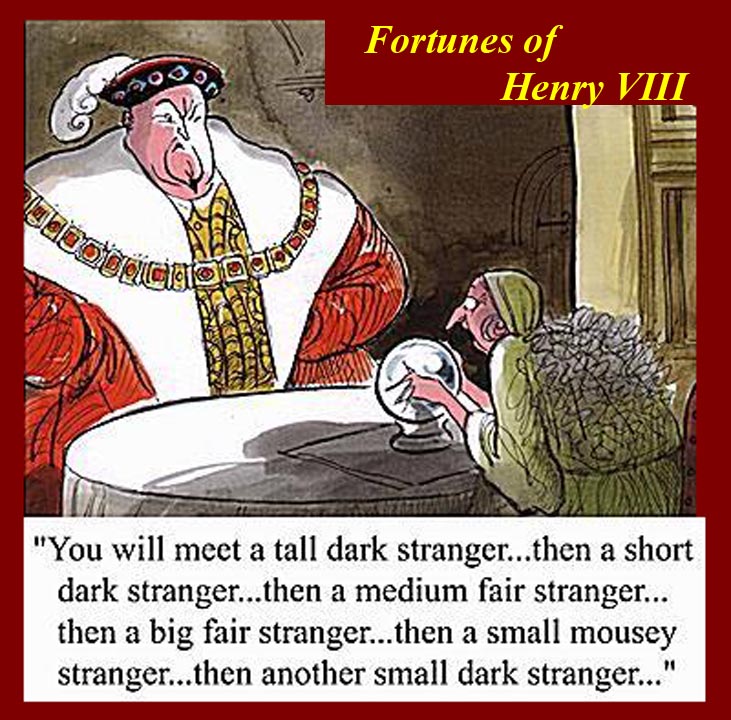
http://www.mmdtkw.org/RenRom0630-HenryVIIIFortune.jpg
Art in Renaissance Rome --
Unit 7Who? There were, of course, hundreds of artists -- maybe thousands, if you count all the self-identified "artists" -- in Rome during the Renaissance. We can only deal with some of those who have traditionally identified as major artists or trend-setters by art historians.The artists we will discuss are:What? Our focus will be on paintings (mostly frescoes, but a few easel works) and on sculpture (and the sculpture will almost invariably be large scale).
When? Our period starts with Fra Angelico (ca.1400 - 1455), although the work we will look at is from 1549. Fra Angelico, in some ways, has more in common with Medieval artist than with later Renaissance artists, but his painting of the Nicholas Chapel in the Vatican Papal Palace started the great redecoration surge in the Vatican apartments, which was then emulated by ecclesiastic and non-ecclesiastic familiae. We will continue through Bernini, Caravaggio, and Gaulli, whose art is often considered part of a "next" or different artistic movement, the baroque. We will deal with the artists in the order of their birth, for no other reason than that it's convenient, even though the overlaps are sometimes strange because of longevity or lack of it: Michelangelo was born before Raphael, but outlived him and was therefore productive for many years after Raphael's dissolute death.
Where? It's Rome, of course: even if the artists were not born there they were attracted there by the largesse of the popes, cardinals, and civic lords. Attracted, in fact, may be a too benign word: more often than not, artists were summoned or sent to Rome by patrons -- almost the way players of major sports teams are traded. There were very few "free agents". And inside Rome, the artists routinely went where the biggest money and commissions were, which often meant the Vatican.
How? Commissions, large and small, were the order of the day. It was possible to make a small living by painting or sculpting for the open market -- Caravaggio sold small paintings in the Campo de' Fiori for a few years before he joined the openly homosexual salon of Cardinal Francesco del Monte and was thereafter directed toward larger commissions. The ambition of every artist who came to or was summoned to Rome was to get long-term employment through large commission -- everyone except Michelangelo who was kept for years in semi-involuntary servitude to Julius II and other Popes.
There is, of course, one more question: Why? It is doubtful that, through some genetic accident, numerous great artists appeared during the Italian Renaissance and at no other time. The answer seems to be environment, and, specifically, a wealthy environment in which those with wealth were willing to subsidize the training and keeping of many of those who had artistic talent and who appeared in the in the normal distribution of talents among the population. In short, no more artists than usual showed up, but those who did were encouraged and paid for their efforts.
VasariInternet links for this Unit:Fra Anglico
Pinturicchio
Michelangelo
Raphael
Cellini
Carracci
Caravaggio
Reni
Bernini
Gaulli
Orazio Gentileschi
Artemesia Gentileschi (Orazio's daughter and the first woman to become a member of the Accademia di Arte del Disegno (http://www.absoluteastronomy.com/topics/Accademia_di_Belle_Arti_Firenze) in Florence.
By far the most useful Internet source of information on Italian (Roman) Renaissance art and artists is the Web Gallery of Art hosted by the Hungarian Academy of Sciences in Budapest, Hungary. It is located on the Internet at http://www.wga.hu/index1.html, but actually it is often easier to simply use the Google search engine and to search for the name of the artist and the letters "kfki" (without the quotes), those letters being the acronym for the name of the academy in Hungarian (for example, type this in the Google search box: raphael kfki.) Several of the images used in this unit are downloads from the Web Gallery of Art, and most of the handouts prepared for the unit are also partially derived from the Gallery.See also:The Catholic Encyclopedia provides biographies for most well known Italian Renaissance artists, especially those who were active in Rome. The Internet address is http://www.newadvent.org/cathen/. Once on that page either type in the name of the artist or click on the first letter of the artists name to pull up the alphabetic index.
For art in the Vatican (Sistine Chapel, Papal apartments, Vatican Museums, and several other categories, go to the Christus Rex Internet site at http://www.christusrex.org/, being careful to bypass the obvious political and religious propaganda.
http://www.artrenewal.org/ a huge database that can take some time to load between pages, but worth the wait -- thousands of large scale images along with biographical informationhttp://witcombe.sbc.edu/ARTHLinks.html
http://www.teacheroz.com/renaissance.htm
Thousands of images of the works of our artists (and numerous others) can be found using Google "image search". Go to http://images.google.com/ and simply type in the name of the artist. A simple Google search for the name of the artist or work will also yield ample results. Go to http://www.google.com/.
Renaissance Rome
Unit 7 Slides
http://www.mmdtkw.org/RenRomUnit0700-0PixList.html
Art and ArtistsClick on small images or links below to view larger images for Unit 7
In this unit, as in the last, we will go beyond what particularist "experts" call the Renaissance. We will delve into the great artistic movements that followed: "mannerism" and "Caravaggism".
http://www.mmdtkw.org/RenRom0700c-RadGirls.jpg
Arlington high school girls with an inadvertent Roman Baroque (Caravagisti) look.
Roman Renaissance Mosaics -- a shortage
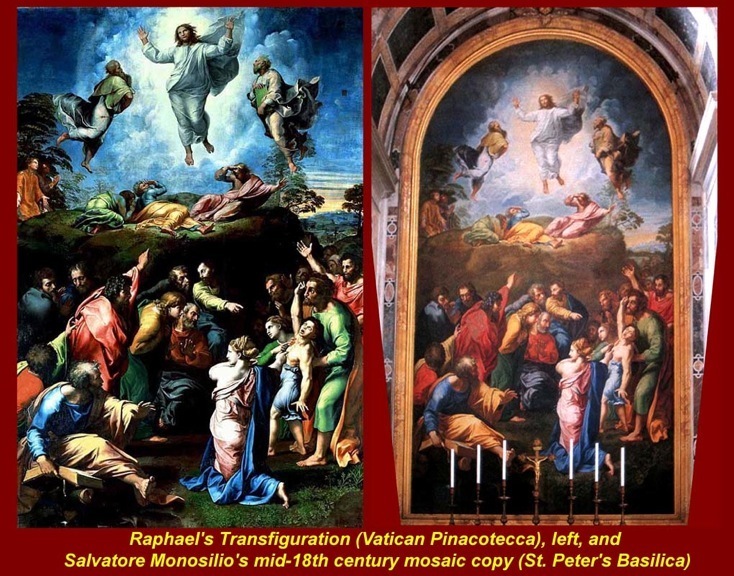
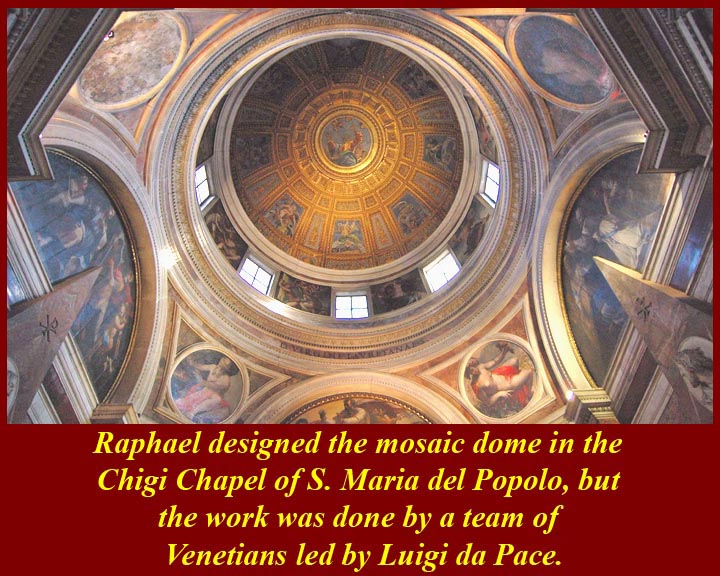
http://www.mmdtkw.org/RenRom0700d-Transfig.jpg
http://www.mmdtkw.org/RenRom0700e-ChigiChapelPopoloMosaic.jpg
http://www.mmdtkw.org/RenRom0700f-PetersDomeMosaic.jpg
Raphael's Transfiguration (1516-1520, oil on wood, 405 cm × 278 cm, Pinacoteca Vaticana) and its mosaic copy in St. Peter's Basilica.
Renaissance artists produced very large scale frescoes and smaller board paintings and canvasses, using the same techniques that had been used by the ancient Romans. To the ancient repertoire of "classical" historic and mythic subject matter, they added, of course, Christian religious and Old Testament subjects. (Oddly, they included the pagan Mediterranean Sibyls along with the Old Testament prophets, based on tortured readings of fake Sibylline prophecies -- see below). What were not produced in the Roman renaissance were very many large scale mosaics comparable to those produced in the ancient and byzantine periods. The reasons for the paucity of mosaics are given in the following excerpt from the Encyclopedia Britannica:
"With the downfall of Byzantium in the 15th century, there perished that milieu in which mosaic had been constantly cultivated and had undergone continuous renewal in response to changing patterns of religious and cultural life. The art lost another foothold in Italy at the beginning of the same century, when changing attitudes about the world and about the function of art eliminated the very bases upon which mosaic had been built. One of the conventions against which the artists of the Renaissance, who were striving for pictorial realism, most strongly rebelled was the use of gold, the other-worldly element most typical of mosaic art.
"Although mosaic continued to be used to a certain extent as church decoration, it was a changed art. Some of its traditional glitter was retained, but essentially mosaics became imitations of painting. These imitative intentions were disastrous and led to the loss of knowledge of how to blend colors and handle materials. In earlier mosaics, there undoubtedly had been a distinction between the leading artist of the project, who drew the composition and oversaw the execution, and the ordinary setters of the tesserae. The leading artist, however, almost certainly took a hand in the setting of special parts and was thoroughly trained in the technical side of the production. Now the preparatory work was divorced from the execution: the artist submitted his cartoon and left its transposition into mosaic to artisans. This drew the lifeblood from the art and caused its degradation.
"In Italy, many of the great painters of the 15th and 16th centuries delivered designs for decorations in mosaic. Best known among these decorations are the works of the Venetian Luigi da Pace after Raphael’s cartoon, in the dome of the Chigi Chapel in Sta. Maria del Popolo (http://www.mmdtkw.org/RenRom0700e-ChigiChapelPopoloMosaic.jpg)in Rome (1516), and the mosaics made after the cartoons of Titian, Tintoretto, Giuseppe Salviati, and Paolo Veronese to complete the decoration of St. Mark’s in Venice. Among the greatest single undertakings of this kind was the decoration of the dome of St. Peter’s (http://www.mmdtkw.org/RenRom0700f-PetersDomeMosaic.jpg) in Rome, executed in the last quarter of the 16th century from the cartoons of Cavalier d’Arpino. St. Peter’s also displays some of the most technically striking mosaic reproductions of paintings ever executed—the much admired altar pictures after originals by 16th- and 17th-century masters. Created for the completion and care of the large mosaics of the two great churches, the workshops attached to St. Peter’s and to St. Mark’s gradually became centres for the manufacture of mosaics. From them, artists were summoned for decorative work in all parts of Europe. The school of mosaics in the Vatican and the workshops in Venice still have a considerable share in the field, together with the school more recently set up for the restoration of the mosaics at Ravenna."
("mosaic." Encyclopædia Britannica. 2010. Encyclopædia Britannica Online. 26 Jan. 2010 <http://www.britannica.com/EBchecked/topic/393310/mosaic>.)
Giorgio Vasari (30 July 1511 – 27 June 1574)
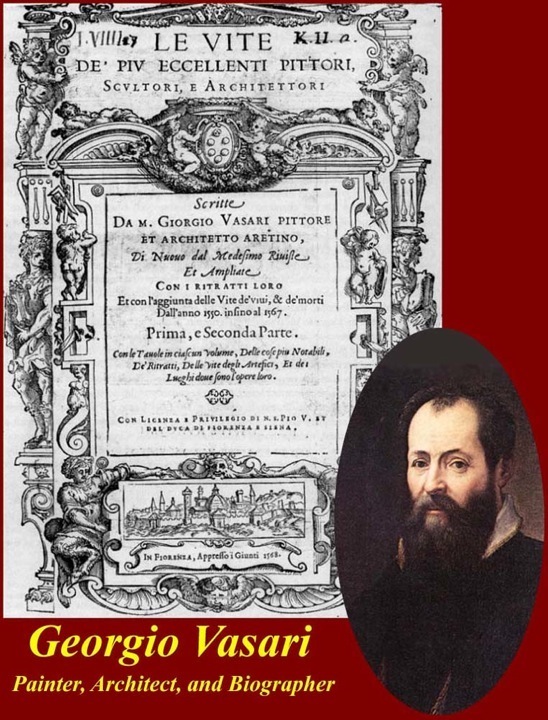
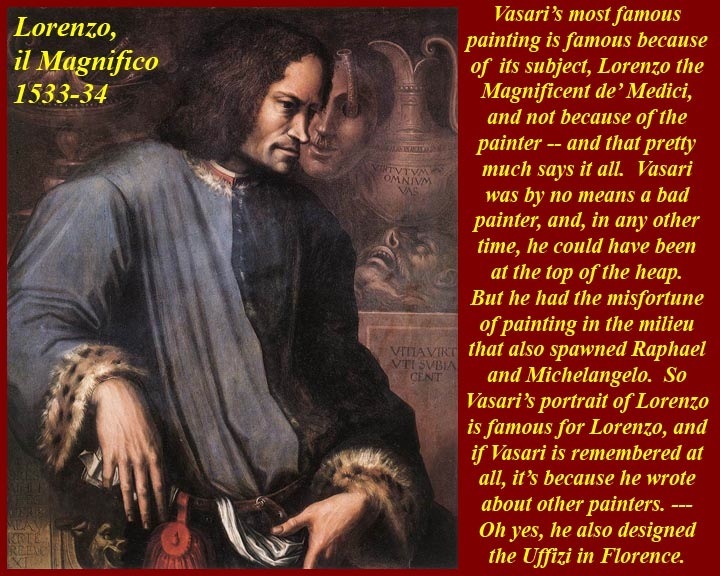
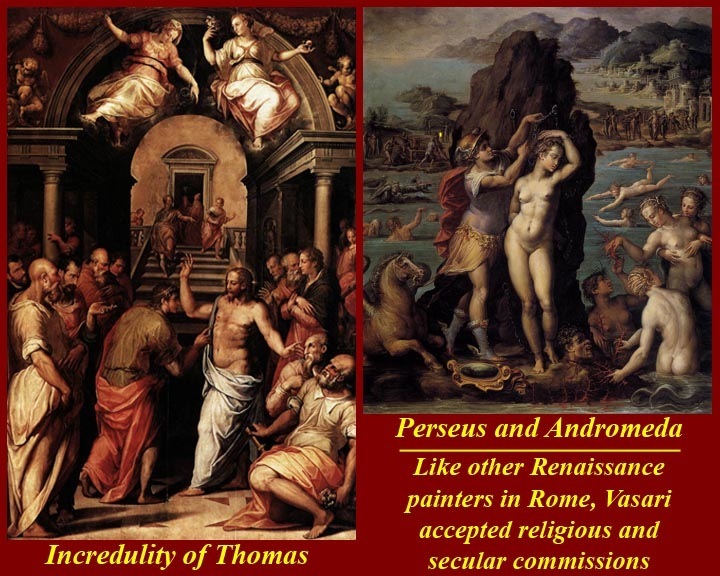
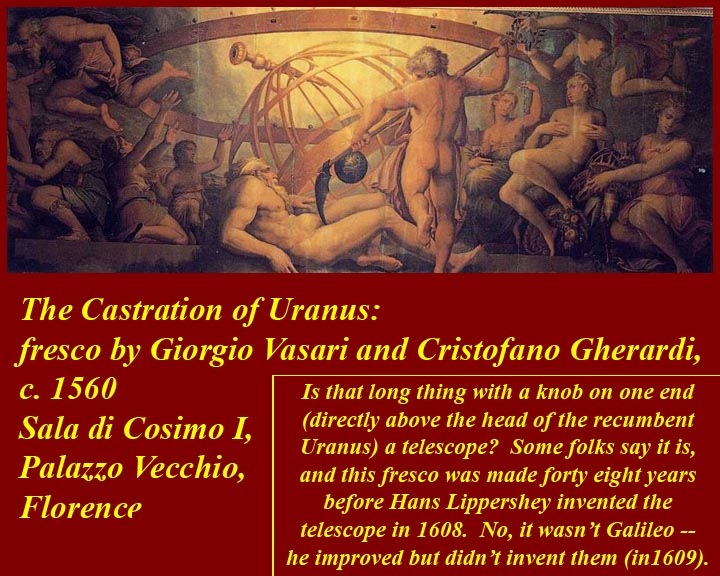
http://www.mmdtkw.org/RenRom0701-VasariLives.jpg
http://www.mmdtkw.org/RenRom0701a-VasariLorenzoMagnifico.jpg
http://www.mmdtkw.org/RenRom0702a-VasariIncredulityThomas.jpg
http://www.mmdtkw.org/RenRom0702b-CastrationOfUranus.jpg
http://www.mmdtkw.org/RenRom0702c-CentoGiorniCancelleria.jpg
Vasari was a second-rate Florentine painter. But he was only second because of the overwhelming mastery of the top three, Leonardo, Michelangelo, and Raphael; any other time or place and he would have been in the top echelon. Only one of his paintings, that of Lorenzo the Magnificent, might be said to be famous, but almost no one would be able to tell you the name of the painter -- it's Lorenzo, the subject, that attracts atention. (The same holds true of his architecture: everyone recognizes the name of the Uffizi Art Museum in Florence, but the same can't be said for the name of its architect, Giorgio Vasari.) So why is Vasari in our list of influential Roman renaissance artists? It's the same story; it's not for his art or architecture, but for what he wrote about other artists and architects in his Le Vite de' Piu Eccellenti Pittori, Scultori, e Architettori, his "Lives". He emulated Plutarch (http://www.e-classics.com/plutarch.htm) and achieved the same kind of second-hand fame. What we know about the renaissance artists that preceded Vasari often comes from Vasari's Lives. Unfortunately, like Plutarch, Vasari often included myths and bables about his heroes, and like Plutarch, he was a chauvinist (http://en.wikipedia.org/wiki/Nicolas_Chauvin), who ignored artists with no Florentine connections and adulated the Florentines. Vasari virtually worshipped Michelangelo, his sometimes master, but when he sought Michelangelo's praise for having completed the frescoes of the great salon of the Cancelleria in Rome in only 100 days, Michelangelo was said to have replied, "Si vede" -- "It shows".
For information on the Vasari's Lives, see http://en.wikipedia.org/wiki/Lives_of_the_Most_Excellent_Painters,_Sculptors,_and_Architects and for many of the Lives in English translation, see http://www.efn.org/~acd/vite/VasariLives.html.
Fra Angelico (c. 1395 – February 18, 1455)
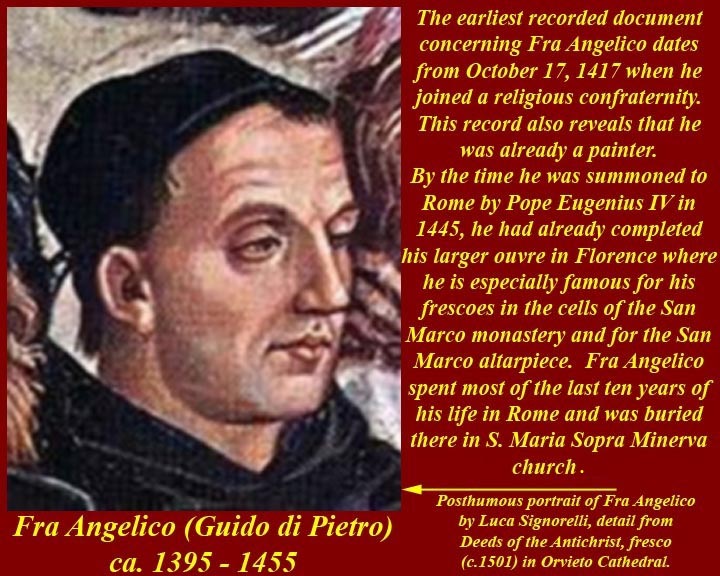
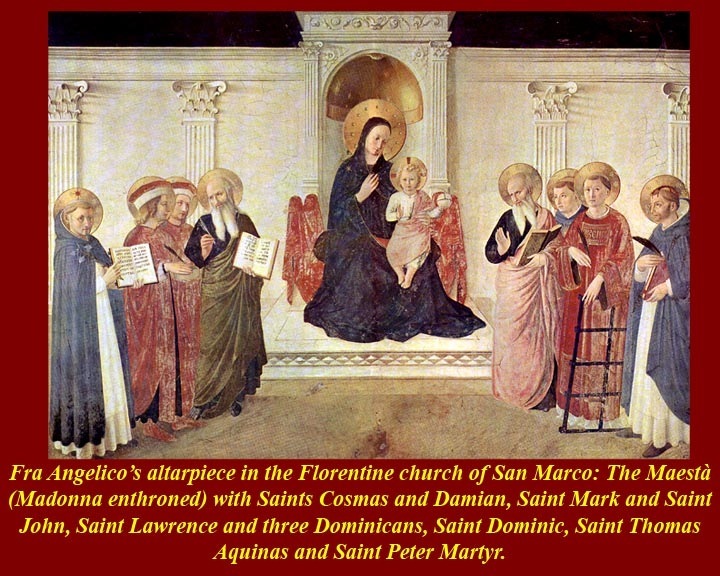
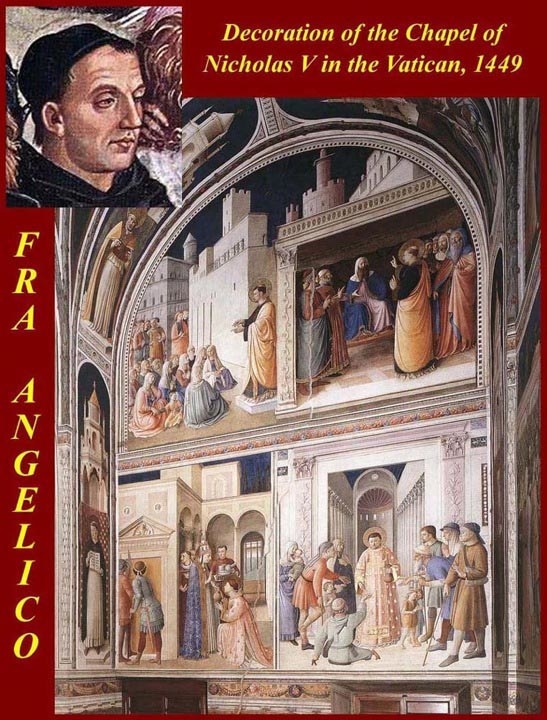
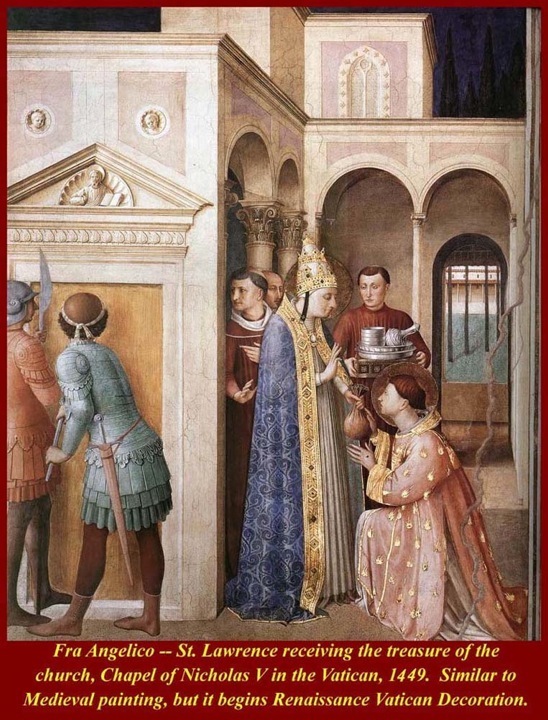
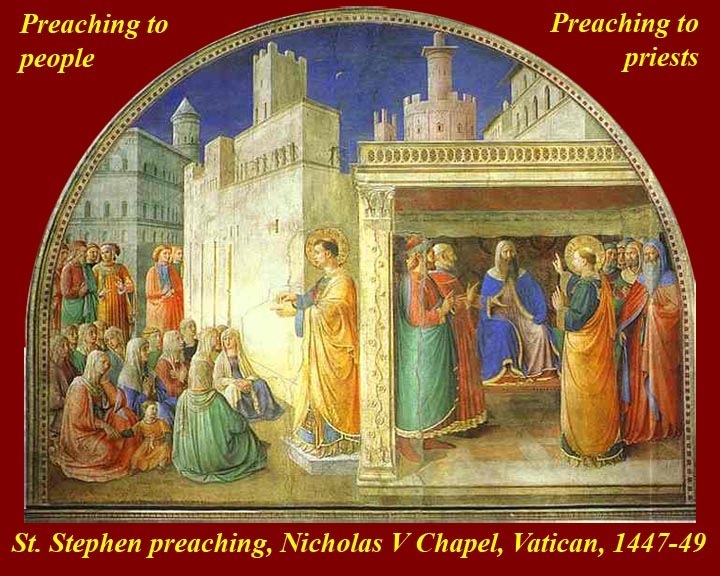
http://www.mmdtkw.org/RenRom0703-FraAngelico.jpg
http://www.mmdtkw.org/RenRom0703a-FraAngelicoSMarcoAltarpiece.jpg
http://www.mmdtkw.org/RenRom0703b-NicholasChapelA.jpg
http://www.mmdtkw.org/RenRom0704-NicholasChapelB.jpg
http://www.mmdtkw.org/RenRom0704a-StephenPerachingNicholas.jpg
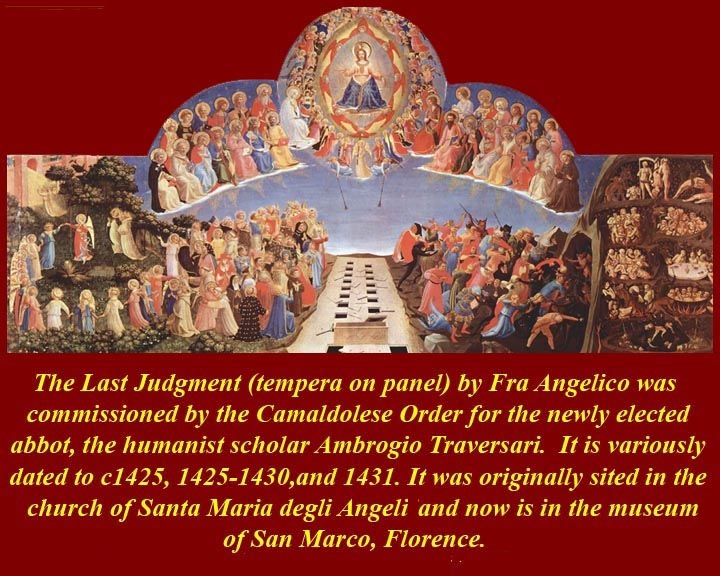
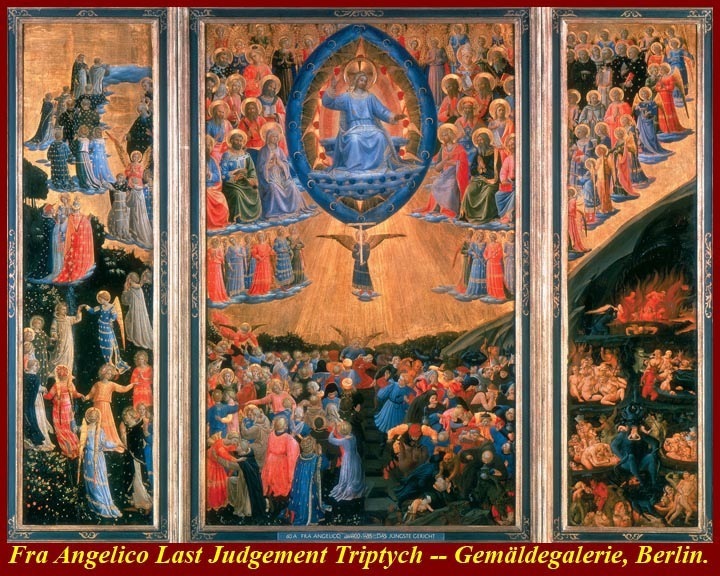
http://www.mmdtkw.org/RenRom0704c-LastJudgement.jpg
http://www.mmdtkw.org/RenRom0704d-LastJudgementTriptych.jpg
http://www.mmdtkw.org/RenRom0704e-FraAngelicoAngel.jpg
Fra Angelico did most of his work in Florence, but he also had a respectable Roman oevre including his frescoes in the Chapel of Pope Nicholas V. He may have completed as many as four fresco cycles in the Vatican between 1445 and 1455, but three of the four are lost. One Painting attributed to him is in S. Maria Sopra Minerva. He he died in Romein 1455 while resident in the Dominican monastery beside S. Maria Sopra Minerva and is entombed in that church. Fra angelico included numerous angels with multicolored wings in his paintings, and they are still featured in many Christmas cards. For more information on Fra Angelico, see http://en.wikipedia.org/wiki/Fra_Angelico and http://www.wga.hu/frames-e.html?/html/a/angelico/index.html. For images of many of his paintings, see http://www.wga.hu/frames-e.html?/html/a/angelico/index.html. For an English translation of Vasari's Life of Fran Angelico, see http://www.efn.org/~acd/vite/VasariFraA.html.
Bernardino di Betto, called Pintoricchio or Pinturicchio (1454 – 1513)
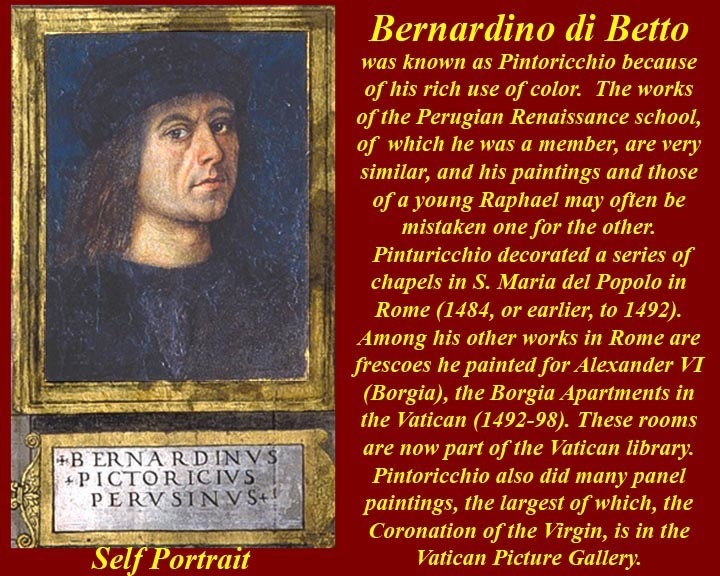
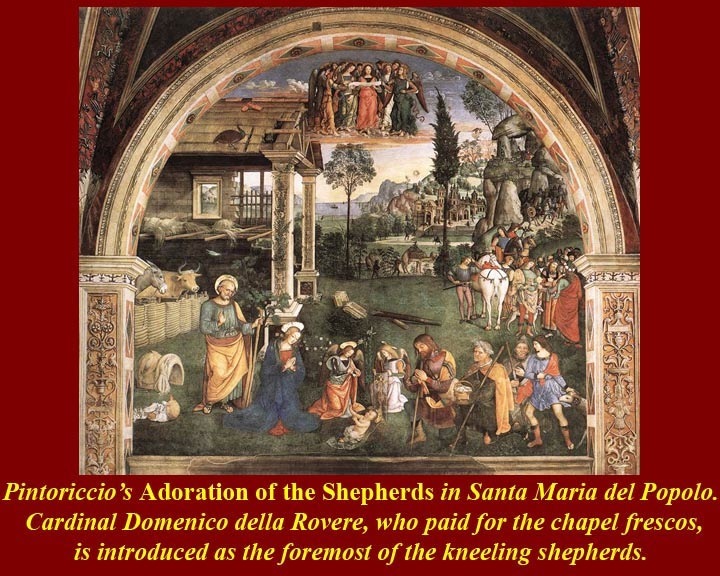
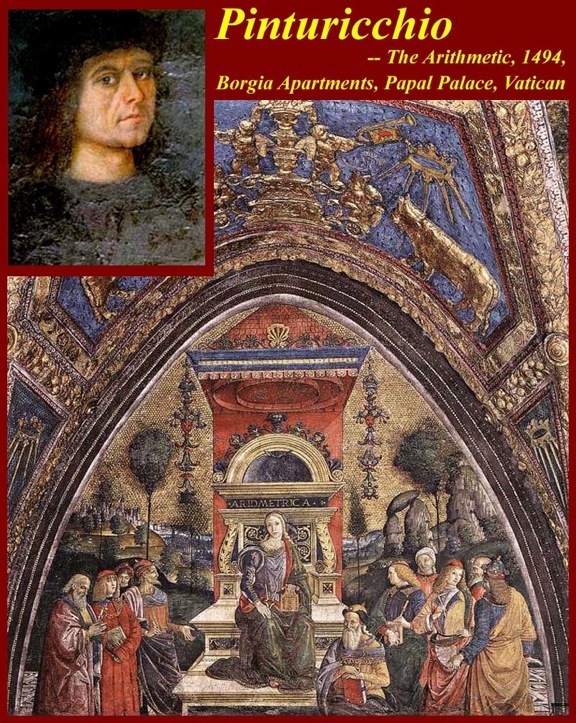
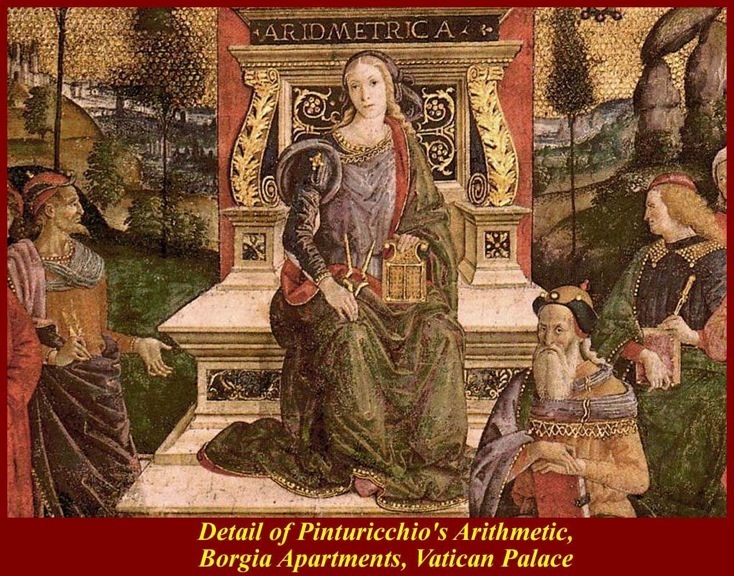
http://www.mmdtkw.org/RenRom0705-PinturicchioSelfPortrait.jpg
http://www.mmdtkw.org/RenRom0705a-AdorationSMPopolo1490.jpg
http://www.mmdtkw.org/RenRom0706-PinturicchioArit.jpg
http://www.mmdtkw.org/RenRom0706a-ArithmeticDetail.jpg
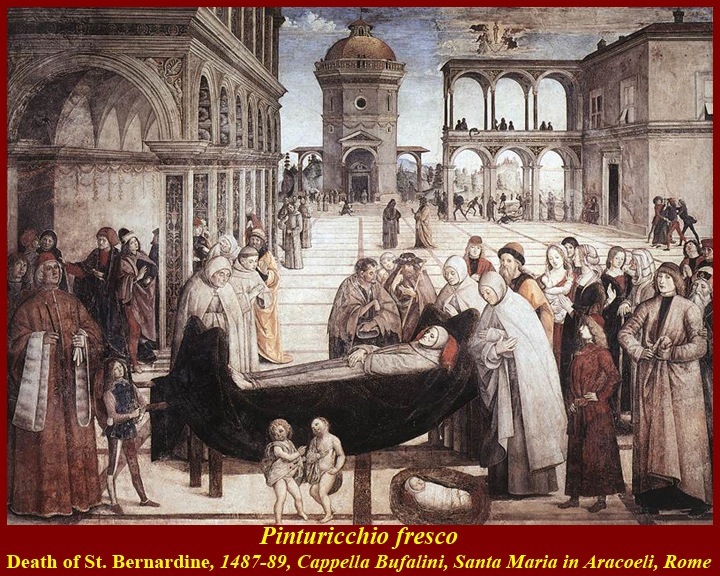
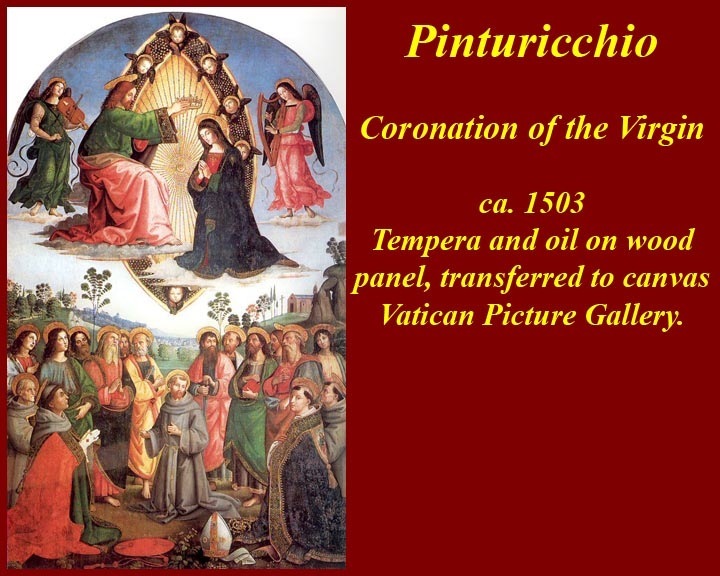
http://www.mmdtkw.org/RenRom0706b-BernardineDeathMariaAracoeli1487.jpg
http://www.mmdtkw.org/RenRom0706c-CoronationVirgin.jpg
http://www.mmdtkw.org/RenRom0706d-Crucifixion.jpg
Bernardino was called Pinturicchio because of his rich use of color, richer even than the use of colors by other members of the Umbrian group of Renaissance painters. The leader of this group, Pietro Vannucci (usually known as Pietro Perugino), at one point, employed Pinturiccho and the styles of those two, along with Giovanni di Pietro ("Lo Spagno") and the young Raphael were so similar that their works are often confused. After assisting Perugino in his frescoes on the walls of the Sistine Chapel, Pinturicchio was employed by various members of the Della Rovere family and others to decorate a series of chapels in the church of Santa Maria del Popolo in Rome, where he appears to have worked from 1484, or earlier, to 1492. The earliest of these is an altarpiece of the Adoration of the Shepherds. After a sojourn in Orvieto, where he painted in the Cathedral, he returned to Rome and was employed by Pope Alexander VI (Borgia) to decorate a recently built suite of six rooms, the Appartamenti Borgia (http://www.wga.hu/frames-e.html?/html/p/pinturic/vatican/index.html) in the Vatican. These rooms now form part of the Vatican library, and five still retain a series of Pinturicchio frescoes. (The sixth was repainted later by another artist.) The Vatican picture gallery has the largest of Pinturicchio's panels — the Coronation of the Virgin, with the apostles and other saints below. Several well-executed portraits occur among the kneeling saints.
For information on Pinturicchio see http://en.wikipedia.org/wiki/Pinturicchio and http://www.wga.hu/frames-e.html?/bio/p/pinturic/biograph.html. For images of some of his paintings, including those in the Borgia apartments in the Vatican, see http://www.wga.hu/frames-e.html?/bio/p/pinturic/biograph.html. For Vasari's biography, see http://www.efn.org/~acd/vite/VasariPinturicchio.html.
Michelangelo di Lodovico Buonarroti Simoni (6 March 1475 – 18 February 1564)
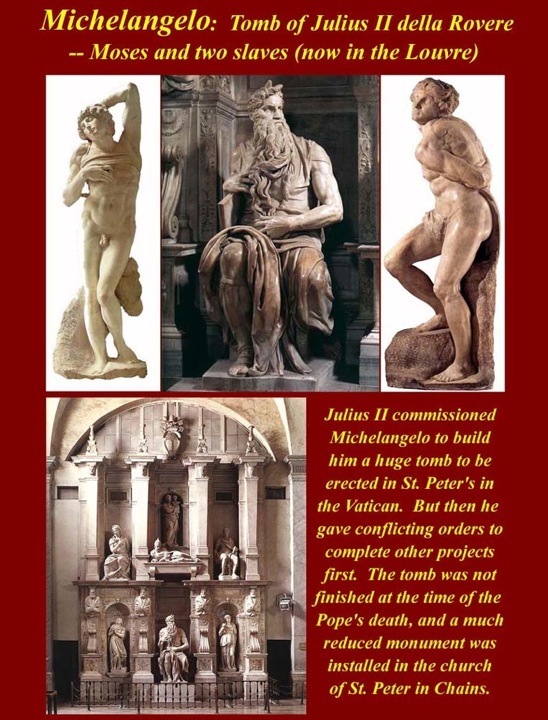
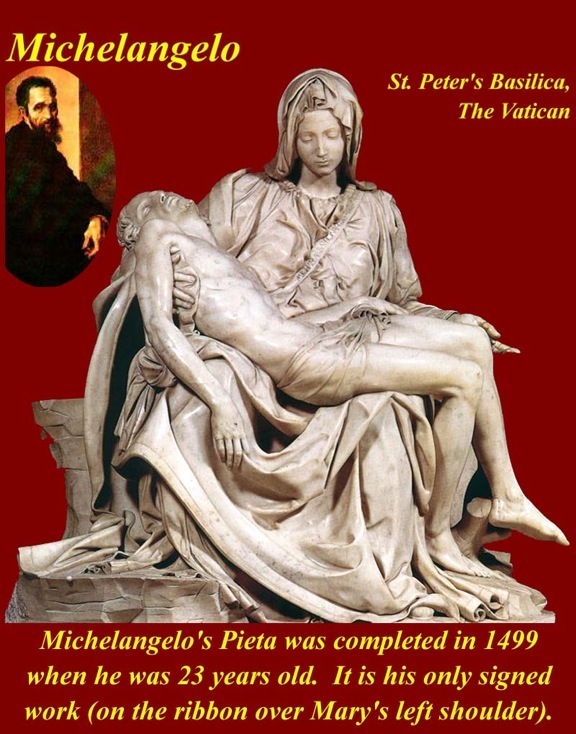
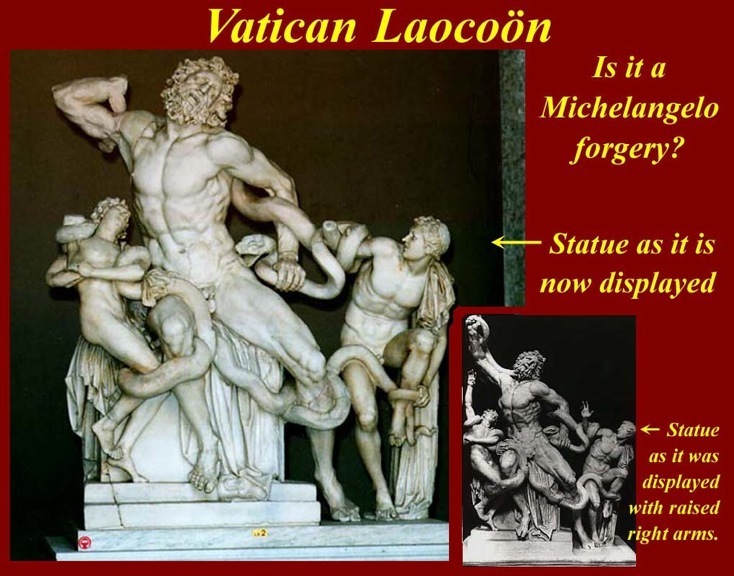
http://www.mmdtkw.org/RenRom0707-MichelangeloMose.jpg
http://www.mmdtkw.org/RenRom0708-MichelangeloPiet.jpg
http://www.mmdtkw.org/RenRom0708a-Laocoon.jpg
http://www.mmdtkw.org/RenRom0708b-MichelangeloChristRedeemSMMinerva.jpg
Michelangelo always seems to have considered himself a sculptor (not a painter) and his Roman sculptures are exquisite. He was working on a huge tomb for Julius II when Julius assigned him the distracting task of painting the Sistine Chapel -- so distracting that the tomb was curtailed and only a much smaller version, featuring Michelangelo's Moses http://en.wikipedia.org/wiki/Moses_%28Michelangelo%29), was completed after the death of Julius.
His Pieta in St. Peters (http://en.wikipedia.org/wiki/Piet%E0_%28Michelangelo%29), completed in 1499 when the sculptor was just 23 years old, is justly famous as is his David in Florence, which he finished in 1504. The Vatican Laocoon (http://en.wikipedia.org/wiki/Laoco%F6n_and_His_Sons) was a discovered rather than a sculpted statue -- maybe.
A statue of Laocoon is attributed by the Roman author Pliny the Elder to three Rhodian sculptors: Agesander, Athenodoros and Polyclitus. It showed, according to Pliny, the Trojan priest Laocoön and his sons Antiphantes and Thymbraeus being strangled by sea serpents (because he had warned the Trojans about "Greeks bearing gifts" -- http://en.wikipedia.org/wiki/Timeo_Danaos_et_dona_ferentes). In 2005 Lynn Catterson argued that the sculpture was a forgery created by Michelangelo. Richard Brilliant, author of My Laocoön, described Catterson's claims as "noncredible on any count". Michelangelo was involved in discussions about needed restorations, but Raphael provided the new upraised right arm (http://en.wikipedia.org/wiki/File:Laocoonphoto.jpg) that was attached to Laocoon. It wasn't until the 1950s that the original arm, discovered in 1906, was installed in place of Raphael's arm (which is now attached to the back of the base of the statue). As Michelangelo had surmised, the original arm was bent back (http://en.wikipedia.org/wiki/File:Laoconte.jpg) toward the head of Laocoon.
Michelangelo's Christo del Minerva (http://en.wikipedia.org/wiki/Cristo_della_Minerva) statue is Michelangelo's own replacement for a statue of a nude Christ the Redeemer, which he abandoned uncompleted after finding a black streak in the marble of the face of his first effort. The original streaked statue was rediscovered in 2000. Both versions suffer from reworking by less able sculptors, but the Christo del Minerva (http://en.wikipedia.org/wiki/Cristo_della_Minerva) in Rome's Santa Maria Sopra Minerva (http://romanchurches.wikia.com/wiki/Santa_Maria_sopra_Minerva) church is less damaged -- attachment of a silver loincloth in the 17th century damaged the sttue's right hip and genitals.
Michelangelo's work in the Sistine Chapel
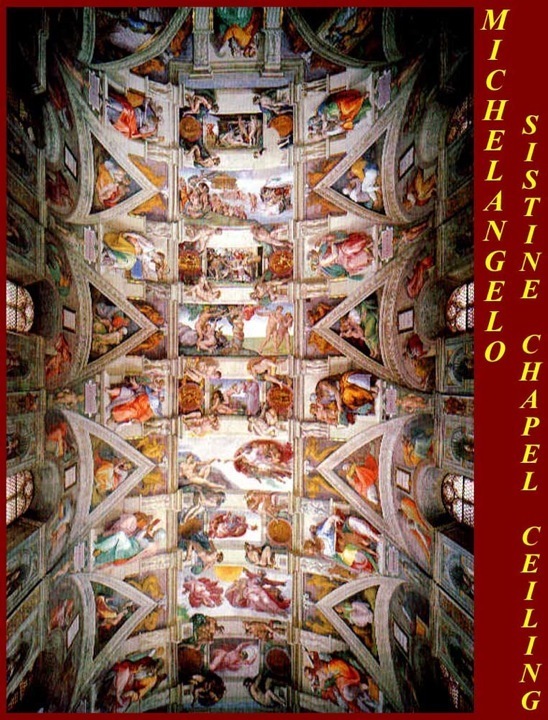
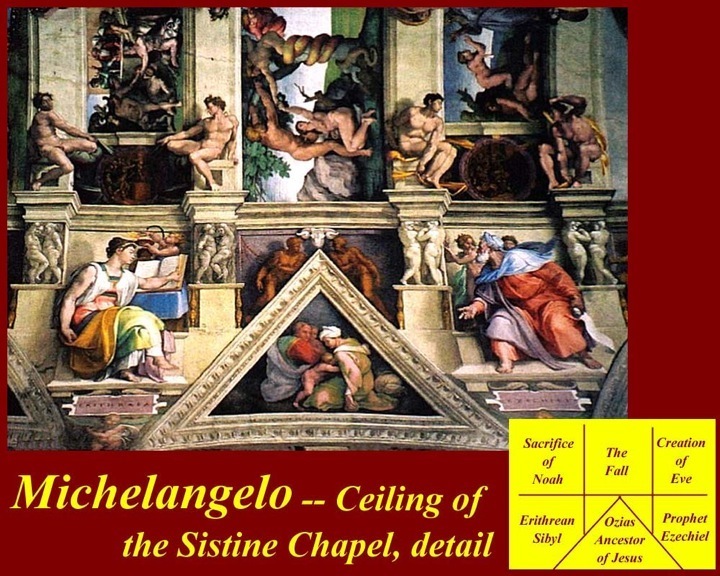
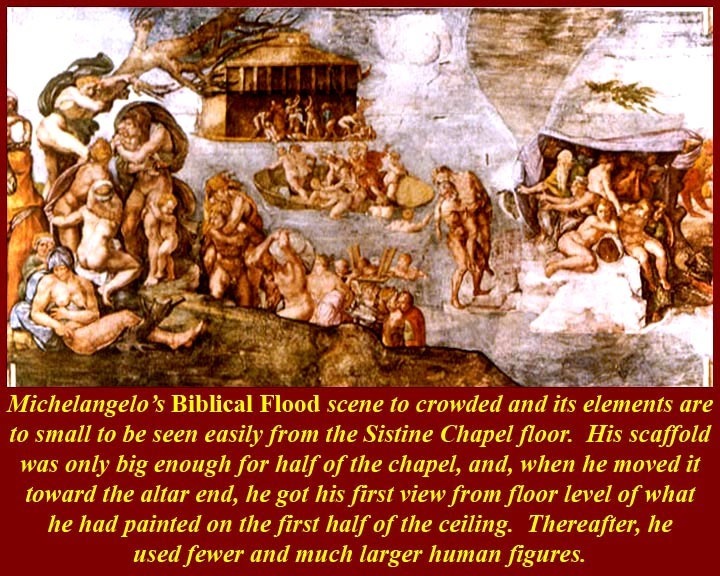
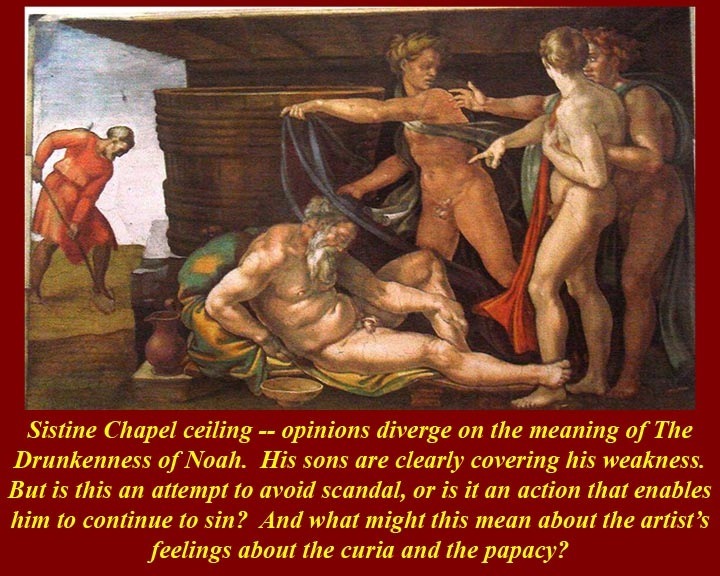
http://www.mmdtkw.org/RenRom0709-SistineCeil1512.jpg
http://www.mmdtkw.org/RenRom0709a-SistineCeilDeta.jpg
http://www.mmdtkw.org/RenRom0709b-BiblicalFlood.jpg
http://www.mmdtkw.org/RenRom0709c-DrunkenNoah.jpg
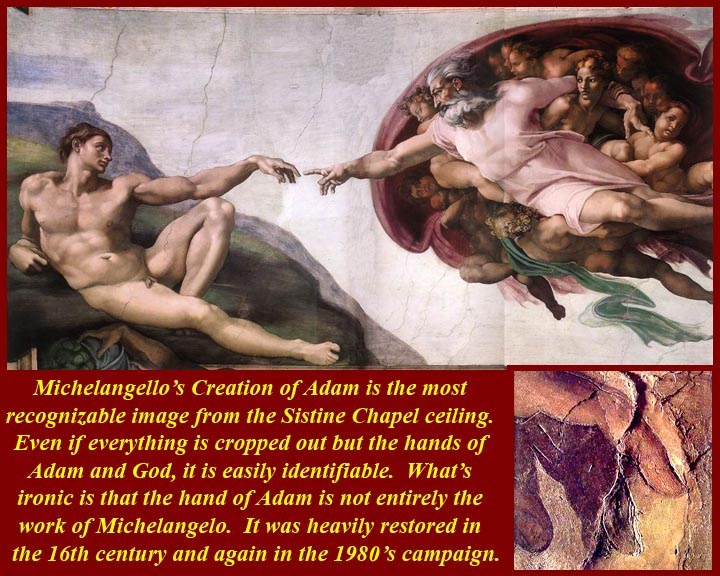
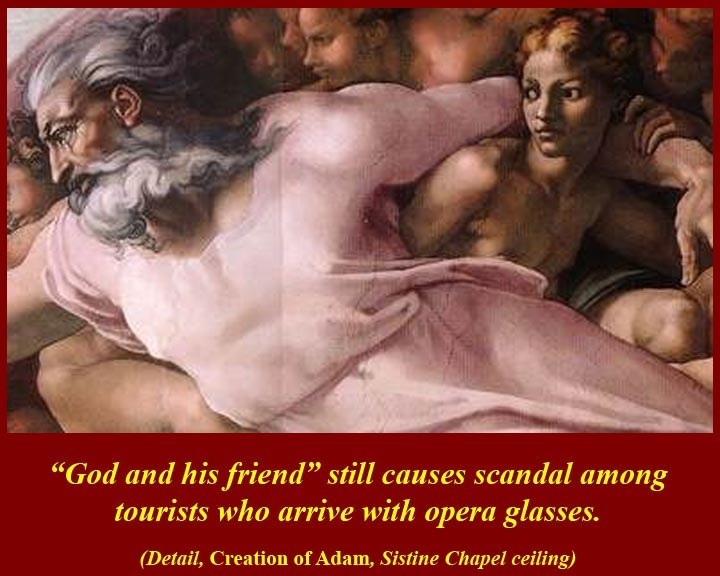
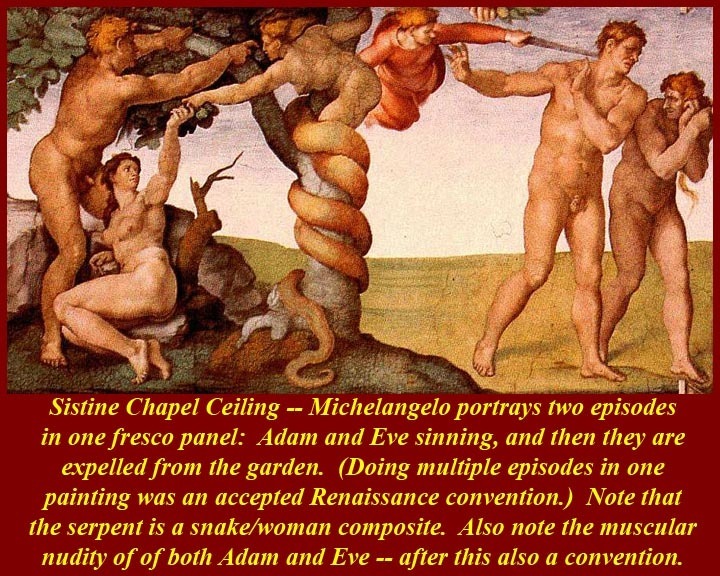
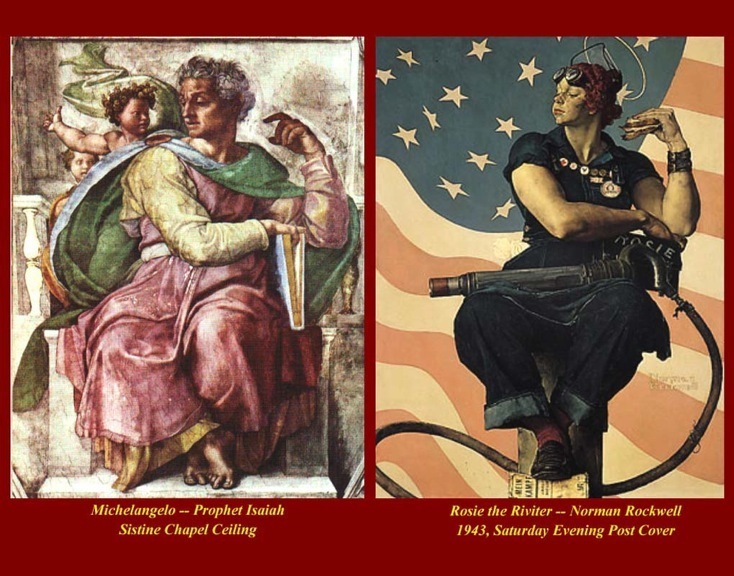
http://www.mmdtkw.org/RenRom0709d-CreationofAdam.jpg
http://www.mmdtkw.org/RenRom0709d1-GodAndFriend.jpg
http://www.mmdtkw.org/RenRom0709e-AdamEve.jpg
http://www.mmdtkw.org/RenRom0709f-IsaiahRosie.jpg
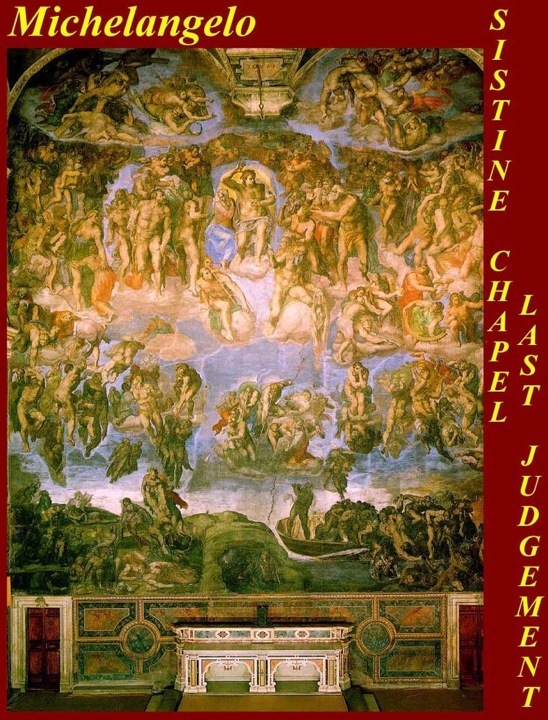
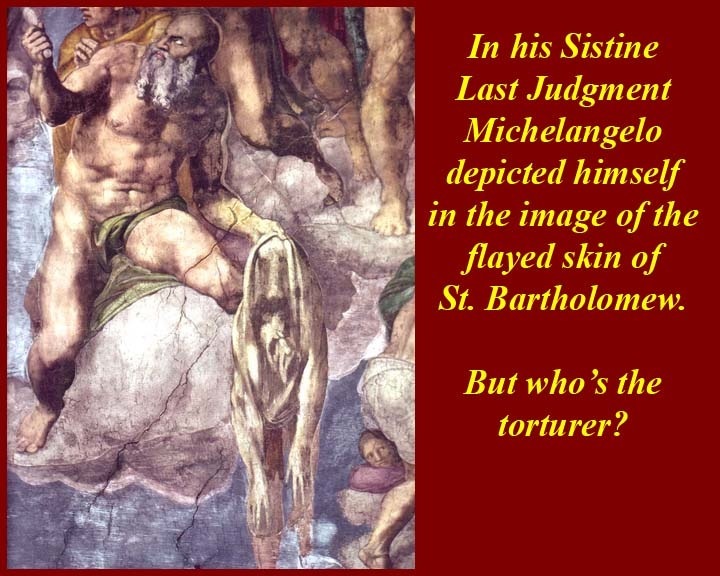
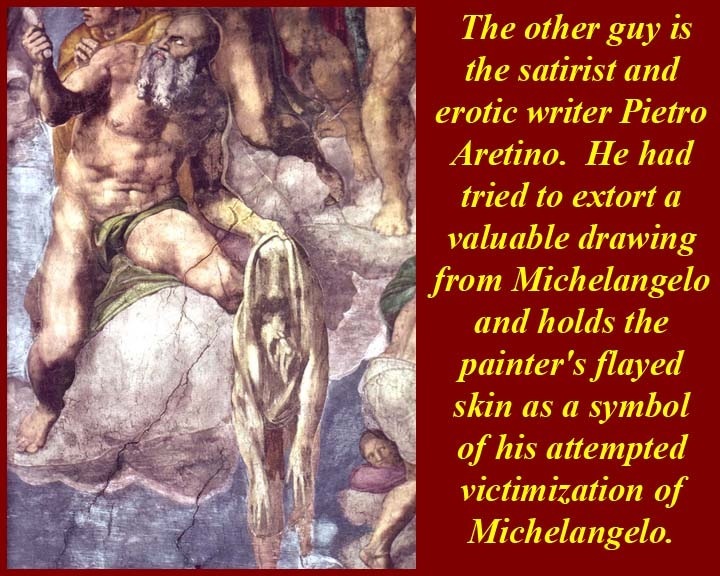
http://www.mmdtkw.org/RenRom0710-LastJudge1536.jpg
http://www.mmdtkw.org/RenRom0710a-LastjudgementBatholomewMichelangelo.jpg
http://www.mmdtkw.org/RenRom0710b-LastJudgementBartHolder.jpg
http://www.mmdtkw.org/RenRom0710c-BiagioDaCasena.jpg
Michelangelo's work on the Sistine Chapel ceiling (1508 - 1512) for Julius II is well known from Irving Stone's "biographical novel" The Agony and the Ecstasy and from Hollywood's adaptation of the novel with Charlton Heston and Rex Harrison. Unfortunately, almost everything in the book and the movie was much more novel than biography -- no, Pope Julius did not have a Brittish accent. There are a few hints of fact about the painting of the Sistine Chapel ceiling, but if you want the real story, read Michelangelo and the Pope's Ceiling by Ross King (who also wrote about Brunelleschi's Dome on the Florence Duomo).
When Michelangelo painted the ceiling, his scaffold was not built up from the floor, but rather it was suspended from the tops of the walls; the floor had to be kept clear for important papal religious ceremonies. Since wood in the quantities needed was expensive, the scaffold only stretched for half the length of the chapel. Michelangelo and his crew (no, he wasn't the lone painter from the movie) didn't have a floor level view of the completed first half until the scaffold was disassembled and rebuilt to paint the second half of the ceiling. Their view was revealing -- the central panels in the first half were to crowded with small human figures (http://www.mmdtkw.org/RenRom0709b-BiblicalFlood.jpg). When Michelangelo painted the central panels of the second half they only had a few large protagonists (http://www.mmdtkw.org/RenRom0709e-AdamEve.jpg).
It should also be noted that our image of Michelangelo painting the ceiling lying on his back with paint dripping on his face is innacurate. He and his helpers always painted standing upright, and, in fact, in letters writen to his brother, Michelangelo complained about the severe pain of arching his back for hours as he reached overhead to apply the pigments; in one letter he even incuded a sketch of himself in that painful position. Perhaps he would have been much more comfortable in a prone position.
Michelangelo also frescoed the end wall behind the altar in the Sistine Chapel for Paul III. His Last Judgement (1537 - 1541) is a depiction of the second coming of Christ and the apocalypse. The souls of humans rise and descend to their fates, as judged by Christ surrounded by his saints. Unlike the ceiling of the chapel, this extended altarpiece (13.7 x 12 meters) is a single picture. The nudity of the characters on the painting brought much controversey during Michelangelo's lifetime, and after his death, many genitals in the fresco were covered by the artist Daniele da Volterra, whom history remembers by the derogatory nickname "Il Braghettone" ("the breeches-painter").
The "mannereist" school of painting which swept through Rome at the end of our period was based on the sometimes exaggerated human forms painted by Michelangelo, a convention copied in Raphaels later works andd often ascribed solely to him. In fact the works of both artists inspired the mannerists, and the 19th century "Pre-Raphaelites" used Raphael's name in rejecting mannerism (-- they probably didn't want to be called the "pre-Michelangelo-ite brotherhood"). For mor information on mannerism, see http://en.wikipedia.org/wiki/Mannerism and http://wwar.com/masters/movements/mannerism.html.
For more information on Michelangelo's Sistine Chapel works, see http://www.artbible.info/art/sistine-chapel.html and http://en.wikipedia.org/wiki/Sistine_Chapel and http://mv.vatican.va/3_EN/pages/CSN/CSN_Main.html. The best site for Sistine Chapel frescoes images is http://www.christusrex.org/www1/sistine/0-Tour.html. There are hundreds of thousands of Internet sites concerned with Michelangelo's work in the Sistine chapel.
For a brief biography of Michelangelo, see http://en.wikipedia.org/wiki/Michelangelo or http://www.wga.hu/frames-e.html?/bio/m/michelan/biograph.html or http://www.michelangelo.com/buon/bio-index2.html. For Vasari's Life of Michelangelo see http://www.efn.org/~acd/vite/VasariMA.html (short version) and http://www.efn.org/~acd/vite/VasariMAngelo.html (long version).
Raffaello Sanzio da Urbino (April 6 or March 28, 1483 – April 6, 1520
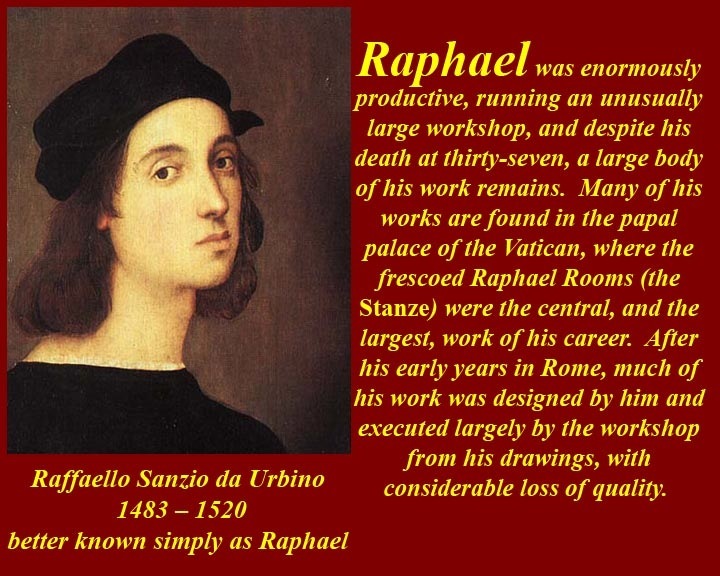
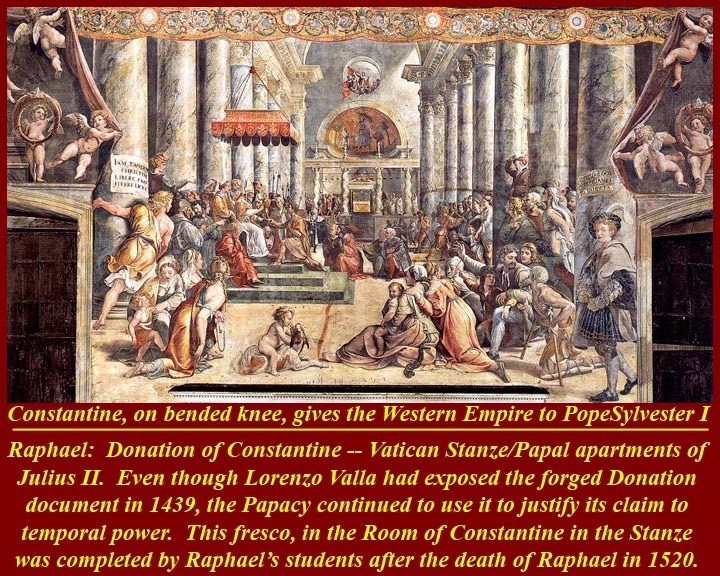
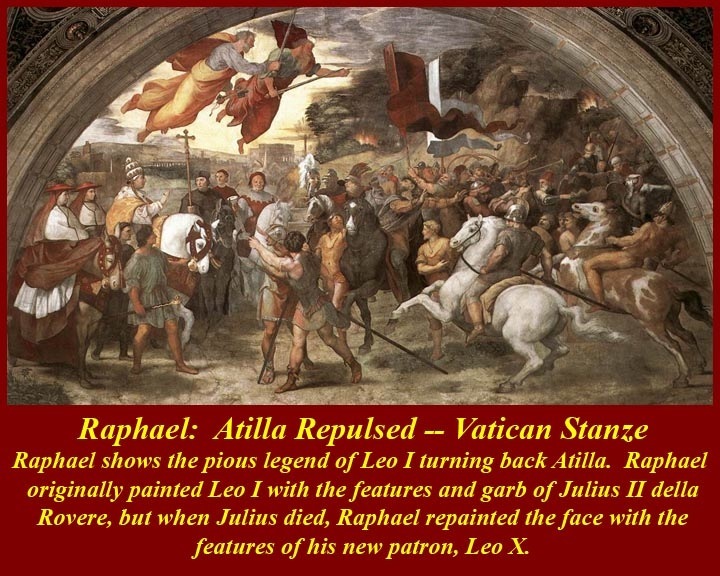
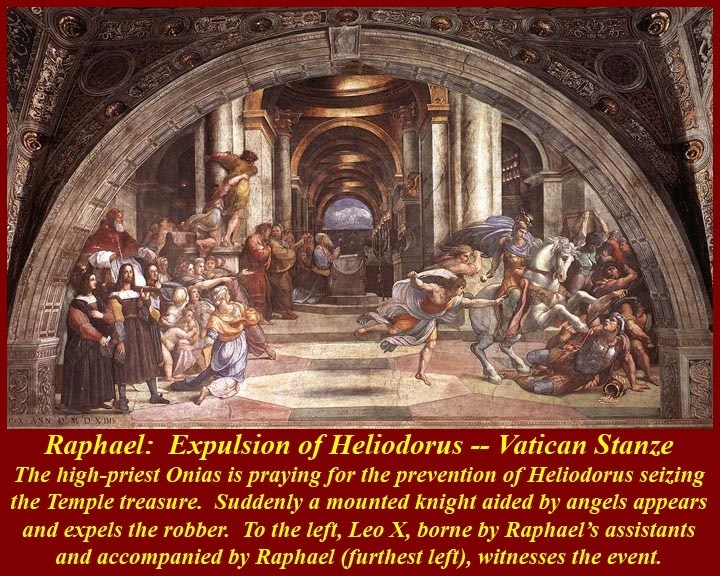
http://www.mmdtkw.org/RenRom0711-Raphael.jpg
http://www.mmdtkw.org/RenRom0711a-Donationconstantine.jpg
http://www.mmdtkw.org/RenRom0711b-LeoAttila.jpg
http://www.mmdtkw.org/RenRom0711c-Heliodorus.jpg
http://www.mmdtkw.org/RenRom0711d-RaphaelAthens.jpg
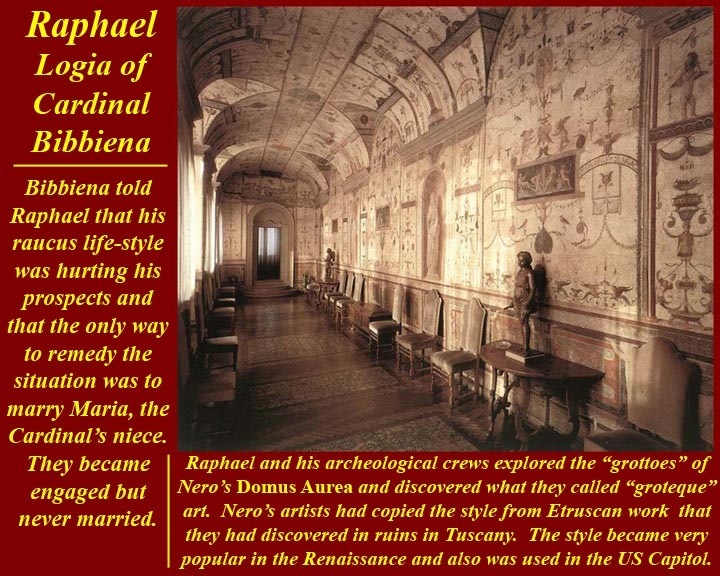
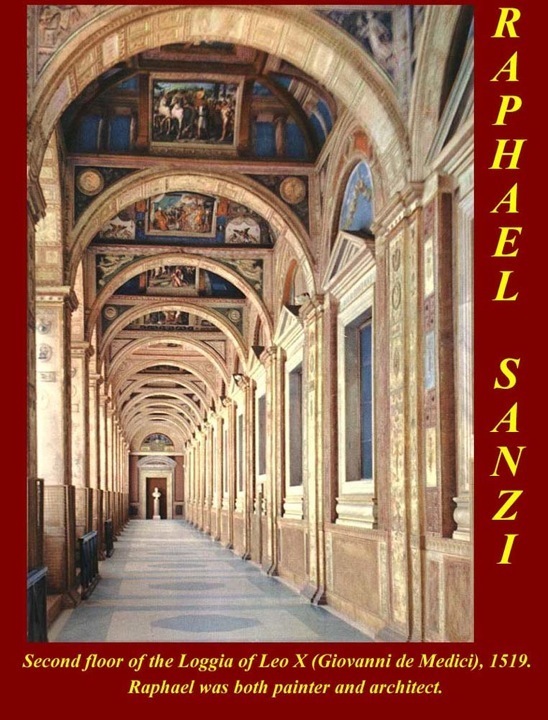
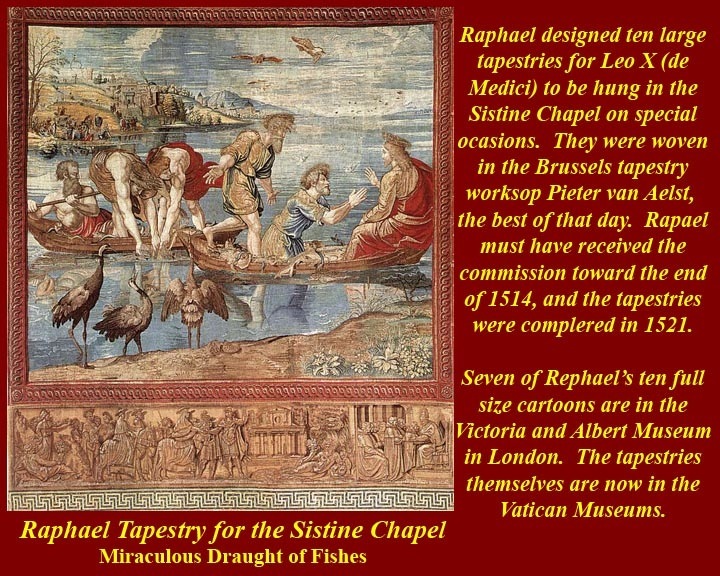
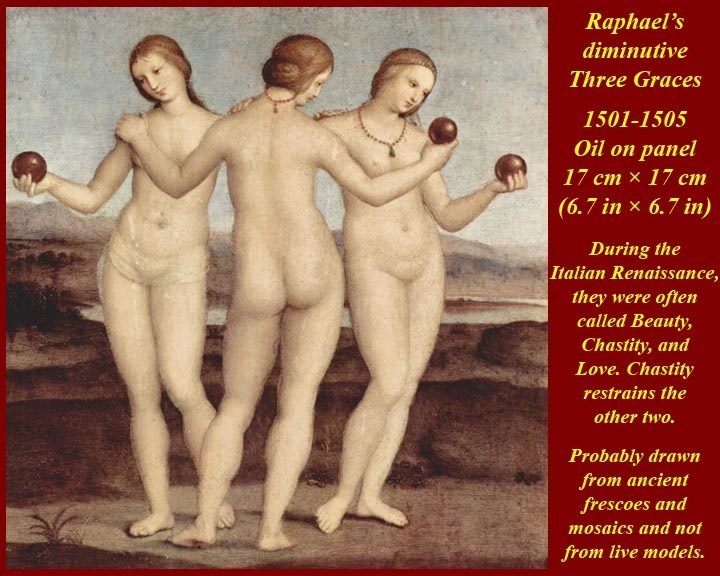
http://www.mmdtkw.org/RenRom0712-RaphaelLoggetta.jpg
http://www.mmdtkw.org/RenRom0712a-RaphaelLoggia.jpg
http://www.mmdtkw.org/RenRom0712b-RaphaelSistineTapestry.jpg
http://www.mmdtkw.org/RenRom0713-ThreeGraces.jpg
http://www.mmdtkw.org/RenRom0713a-LeoX.jpg
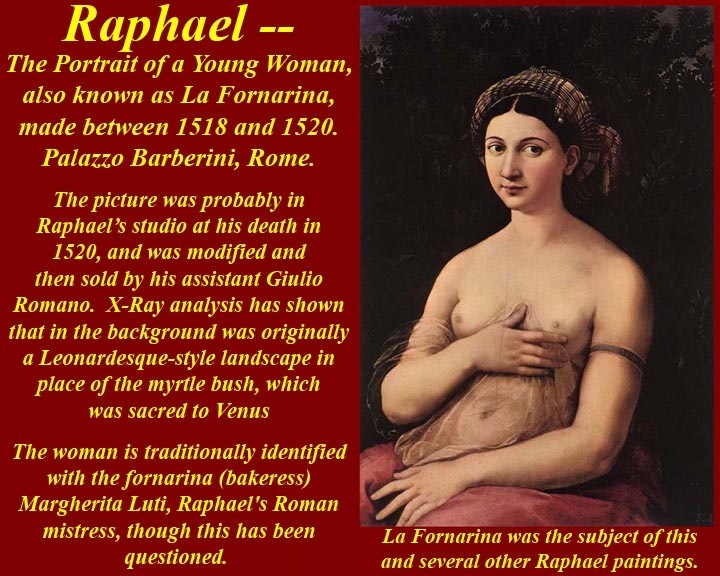
http://www.mmdtkw.org/RenRom0714-RaphaelFornarina.jpg
http://www.mmdtkw.org/RenRom0714a-RaphaelFornar2.jpg
If Michelangelo was a semi-recluse, Raphael was a playboy/man-about-town. His Roman patron and "protector" (and he needed one of those) was Bernardo Dovizi (Cardinal Bibbiena (http://en.wikipedia.org/wiki/Bernardo_Dovizi), who, fearing that Raphael's carousing and womanizing would get him kicked out of his Vatican commissions, arranged Raphael's engagement to his niece, Maria Bibbiena. The marriage never took place, because Raphael kept putting it off until she died -- some said of a broken heart. When Raphael died young (due to his debauchery) and was entombed in the Pantheon (Santa Maria ad Martyres Church -- http://romanchurches.wikia.com/wiki/Santa_Maria_ad_Martyres) in Rome, his will requested that she be disinterred and entombed beside him. His act of belated conscience was honored.
The most important of Raphael's Vatican commissions was for the Stanze ("rooms" or apartment) of Julius II della Rovere. There was already a suite of rooms, the Borgia Apartments, but Julius so hated Alexander VI Borgia Borgia and his reputation that he refused to inhabit the same space as his predecessor. He also painted a loggia for Cardinal Bibbiena, in which he introduced to the Roman canon of art the "Grotesque" style that he and his crews had found while exploring the "grottoes" of Nero's Domus Aurea. He designed and executed another loggia for Leo X de'Medici using grotesque and other styles from the Domus Aurea. Other artists and architects immediately copied this style, which was also emulated in US Government buildings by Constantino Brumidi in the 19th century.
While engaged to Maria Bibbiena, Raphael continued his public affair with his mistress, "La Fornarina" (http://www.slate.com/id/2113044/), traditionally identified as Margherita Luti, the daughter of a Trastevere baker.
The "mannereist" school of painting which swept through Rome at the end of our period was based on the sometimes exaggerated human forms painted by Michelangelo, a convention copied in Raphaels later works andd often ascribed solely to him. In fact the works of both artists inspired the mannerists, and the 19th century "Pre-Raphaelites" used Raphael's name in rejecting mannerism (-- they probably didn't want to be called the "pre-Michelangelo-ite brotherhood"). For mor information on mannerism, see http://en.wikipedia.org/wiki/Mannerism and http://wwar.com/masters/movements/mannerism.html.
For more information on Raphael, see http://en.wikipedia.org/wiki/Raphael and http://www.artchive.com/artchive/R/raphael.html and http://www.artcyclopedia.com/artists/raphael.html and http://www.newadvent.org/cathen/12640c.htm.
Raphael's known works can be viewed at http://www.wga.hu/frames-e.html?/html/r/raphael/index.html and his Vatican works are available at http://www.christusrex.org/www1/stanzas/0-Raphael.html.
Benvenuto Cellini (3 November 1500 – 13 February 1571)
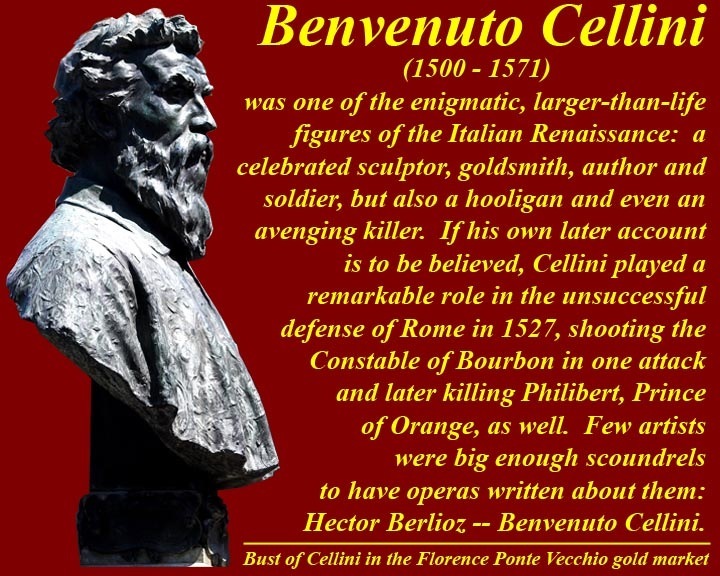
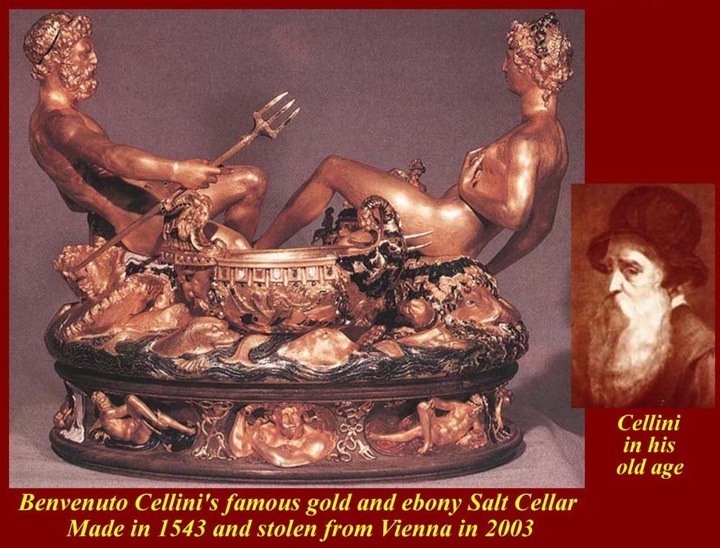
http://www.mmdtkw.org/RenRom0715-CelliniBust.jpg
http://www.mmdtkw.org/RenRom0715a-CelliniSaltCell.jpg
http://www.mmdtkw.org/RenRom0715bSaltcellRecov.jpg
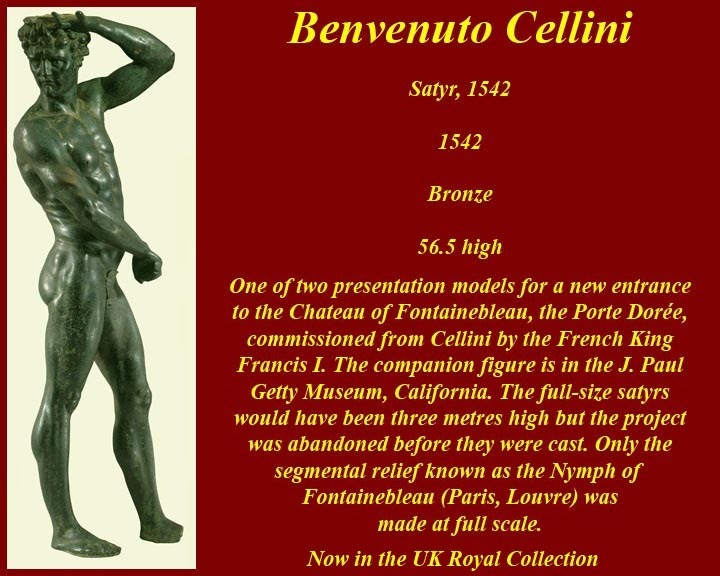
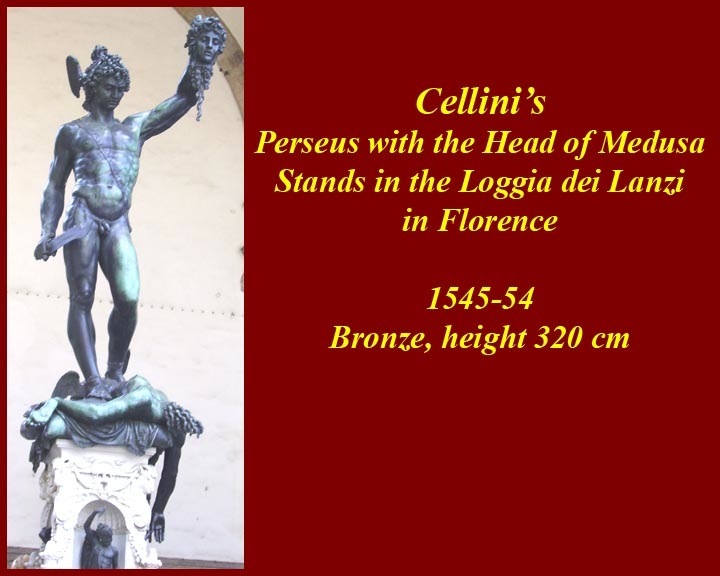
http://www.mmdtkw.org/RenRom0715c-Satyr1542.jpeg
http://www.mmdtkw.org/RenRom0715d-PerseusMedusaLoggiaLanzi.jpg
http://www.mmdtkw.org/RenRom0715e-HermesBargello.jpg
http://www.mmdtkw.org/RenRom0715f-CelliniAutobiography.jpg
Benvenuto Cellini was a sociopath. He was a braggart, a liar, a thief, and, by his own account, a serial murderer. He only managed to escape the headsman's axe because of his talent as a metalsmith and his ability to flatter various cardinals, popes, and monarchs with commemorative medals, coins, and statues. His patrons probably saw something of themselves in him.
In his own time his greatest reputation was as a goldsmith (aside from his criminal reputation), but only one of his works in gold has survived, the celebrated gold, enamel, and ivory salt-cellar (known as la Saliera -- http://en.wikipedia.org/wiki/Cellini_Salt_Cellar) made for Francis I of France in 1543. In 2000, this piece was stolen from its glass case at the the Vienna Art History Museum, but, surprisingly, it was recovered undamaged in 2006.
Three of Cellini's bronzes are shown. Because multiple authorized copies in multiple sizes were cast by Cellini and by foundries that he used, and because even more unauthorized fakes were made later, there is a flourishing market for these and other Cellini statues. There are usually several "authentic" and "signed" Cellinis available in on-line sales; caveat emptor.
Cellini and the defense of Castel Sant'Angelo: Benvenuto Cellini, Florentine goldsmith, talented sculptor, and insufferable braggart, happened to be on hand during the defense of Castel Sant'Angelo after the landsknechts of Charles V occupied and sacked Rome in 1527. He wrote about the ensuing battle in his swashbucklingly entertaining Autobiography. If he's to be believed, Cellini single-handedly saved the Pope Clement VII de' Medici, the castle, and indeed the city of Rome itself, taking control of the cannon and firing away when he saw that the Roman bombardiers, fearful they might hit their own homes, were cowering and sobbing. If his autobiography is to be believed, he also used a harquebus to shoot landesknecht's commander, the Constable of Bourbon, in one attack and later killing Philibert, Prince of Orange, as well.
Several versions of the Autobiography of Benvenuto Cellini, which he began to write in 1558, are available on the Internet. Hector Berlioz wrote an opera loosely based on the Autobiograph. The video recording of the opera is very strange (http://www.amazon.com/Berlioz-Benvenuto-Cellini-Laurent-Naouri/dp/B002QXI2OK).
For information on Cellini, see http://en.wikipedia.org/wiki/Benvenuto_Cellini and http://www.visual-arts-cork.com/sculpture/benvenuto-cellini.htm and http://www.nndb.com/people/909/000084657/ and http://oce.catholic.com/index.php?title=Benvenuto_Cellini.
For Cellini's works, see http://www.artcyclopedia.com/artists/cellini_benvenuto.html and http://www.wga.hu/frames-e.html?/html/c/cellini/ and
Annibale Carracci (November 3, 1560 - July 15, 1609)
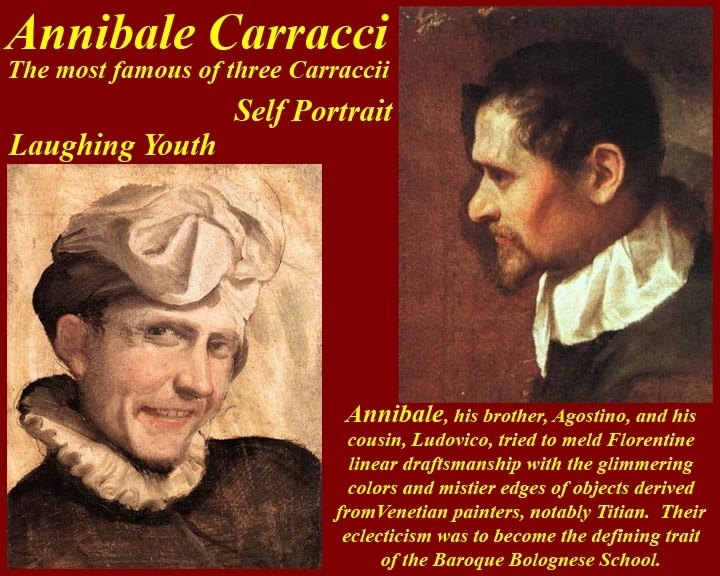
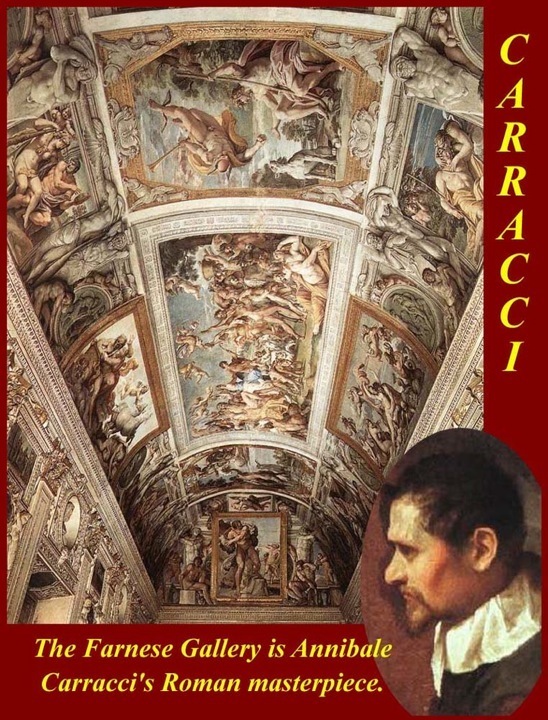
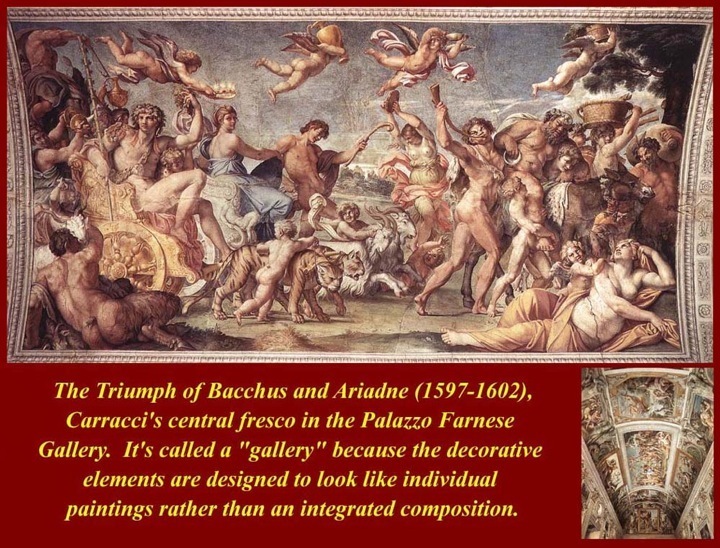
http://www.mmdtkw.org/RenRom0716-CarracciSelf.jpg
http://www.mmdtkw.org/RenRom0717-CarracciFarnese.jpg
http://www.mmdtkw.org/RenRom0717a-CarracciBacchus.jpg
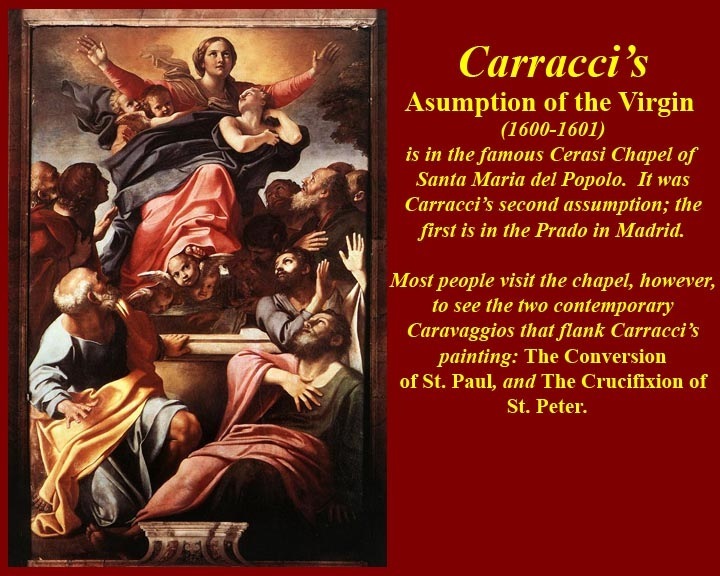
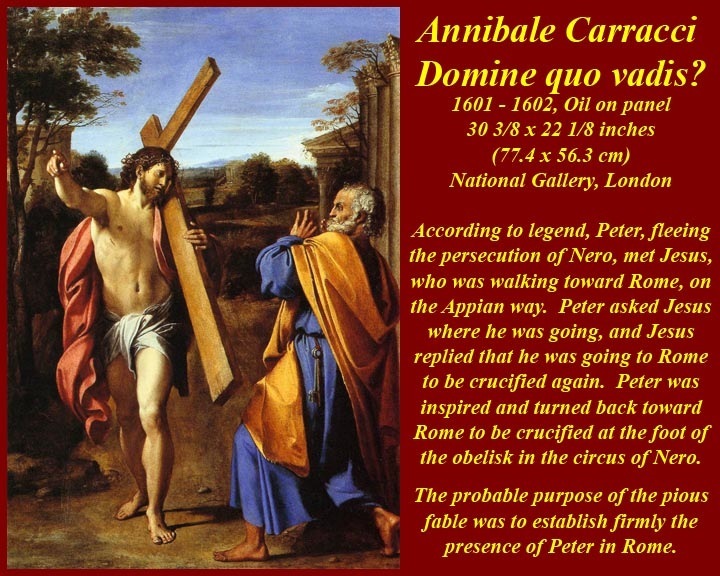
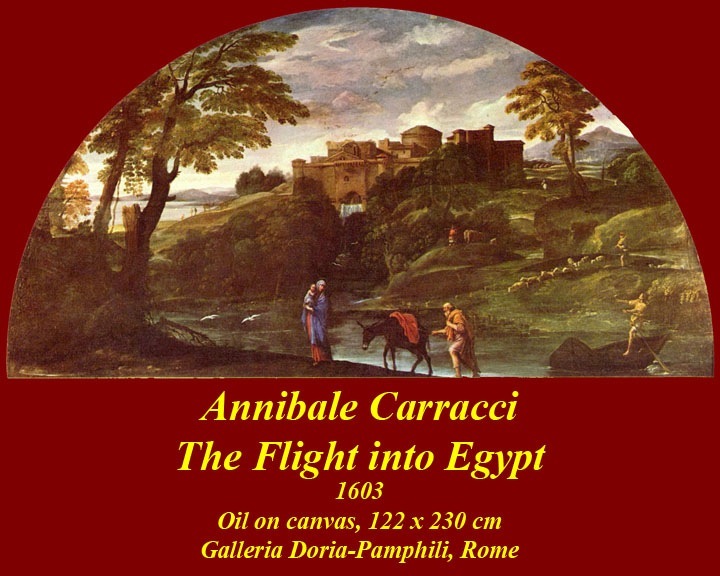
http://www.mmdtkw.org/RenRom0717b-Carracci-AssumptionPopolo.jpg
http://www.mmdtkw.org/RenRom0717c-CarracciQuoVadis.jpg
http://www.mmdtkw.org/RenRom0717d-FlightEgypt1603DoriaPamphili.jpg
http://www.mmdtkw.org/RenRom0717e-RiverLandscapeUSNatGallery.jpg
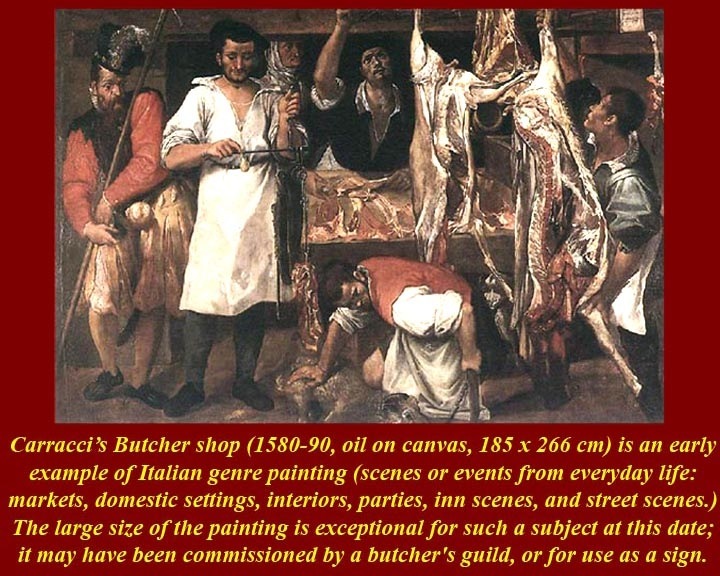
http://www.mmdtkw.org/RenRom0717f-CarracciButcherShop.jpg
http://www.mmdtkw.org/RenRom0717g-AnnibaleCarracciBeaneaterGalColonna.jpg
Annibale Carracci and his brother Agostina and his cousin Ludovico Carracci opened a painters' studio, initially called by some the Academy of the Desiderosi (desirous of fame and learning) and subsequently the Incamminati (progressives; literally "of those opening a new way" (http://belluzzi.scuole.bo.it/progetti/restauro2000/chiostro/htmlen/accinc.html)). While the Carraccis laid emphasis on the typically Florentine linear draftsmanship, as exemplified by Raphael and Andrea del Sarto, their interest in the glimmering colors and mistier edges of objects derived from the Venetian painters, notably the works of Venetian Oil Painter Titian. This eclecticism was to become the defining trait of the artists of the Baroque Emilian or Bolognese School. Based on the prolific and masterful frescoes by the Carracci in Bologna, Annibale was recommended to Cardinal Odoardo Farnese, who wished to decorate the piano nobile of the cavernous Roman Palazzo Farnese.
In November-December of 1595, Annibale and Agostino traveled to Rome to begin decorating the Camerino with stories of Hercules, appropriate since the room housed the famous Greco-Roman antique sculpture of the hypermuscular Farnese Hercules (http://www.mmdtkw.org/RenRom0717a-CarracciBacchus.jpg). Annibale's Triumph of Bacchus and Ariadne (at http://www.mmdtkw.org/RenRom0717-CarracciFarnese.jpg) (1597-1602) is the main element of the ceiling he frescoed in the large reception hall of Palazzo Farnese (The room is called the Gallery Farnese because the decorative elements were designed to look like individual paintings rather than an integrated composition).
Some of Annibale's paintings look like standard (if somewhat sparkly) mannerist productions, but he also panted some intriguing scenes putting some landscape elements far into the foreground and placing the light source far behind the plane of the picture -- just as Carravaggio was doing with his paintings of people. The Carraccis were the heirs and transmitters of Mannerism (http://wwar.com/masters/movements/mannerism.html) in Rome while Caravaggio and the Caravaggio spread tenebrismo (http://en.wikipedia.org/wiki/Tenebrism) through Europe (it expired in Rome shortly after Caravagio fled Rome with the police in pursuit).
Annibale Carracci also pioneered a style which would come to be called "genre painting" (http://www.visual-arts-cork.com/genres/genre-painting.htm), the realistic portrayal of scenes and events from everyday life and with common people. Two of Annibale's archetypical genre paintings are shown. The Bean Eater is another of Annibale's self portraits.
For more information on Annibale Carracci, see http://www.metmuseum.org/TOAH/hd/carr/hd_carr.htm and http://en.wikipedia.org/wiki/Annibale_Carracci and http://www.wga.hu/frames-e.html?/bio/c/carracci/annibale/biograph.html.
For Annibale's paintings and frescoes, see http://www.artcyclopedia.com/artists/carracci_annibale.html and http://www.wga.hu/frames-e.html?/html/c/carracci/annibale/index.html and http://commons.wikimedia.org/wiki/Category:Annibale_Carracci.
Caravaggio (Michelangelo Merisi), (29 September 1571–18 July 1610)
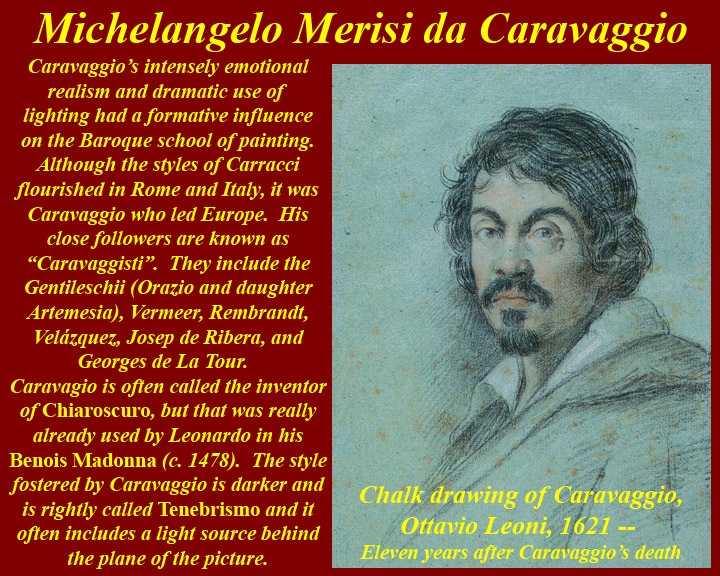
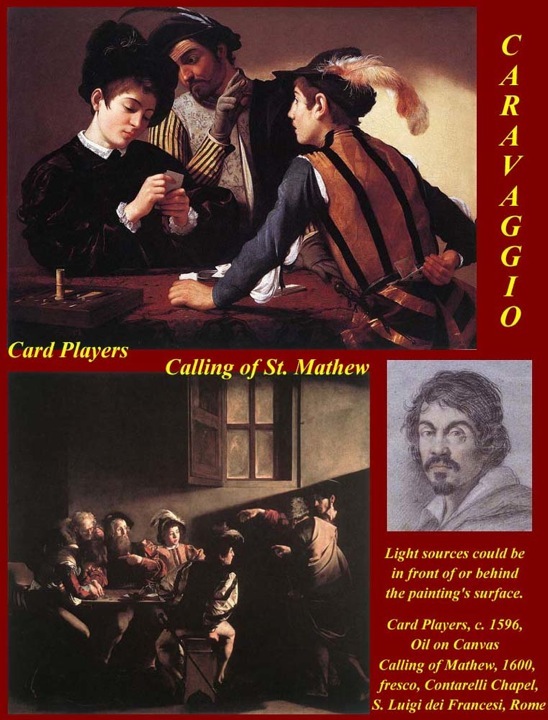
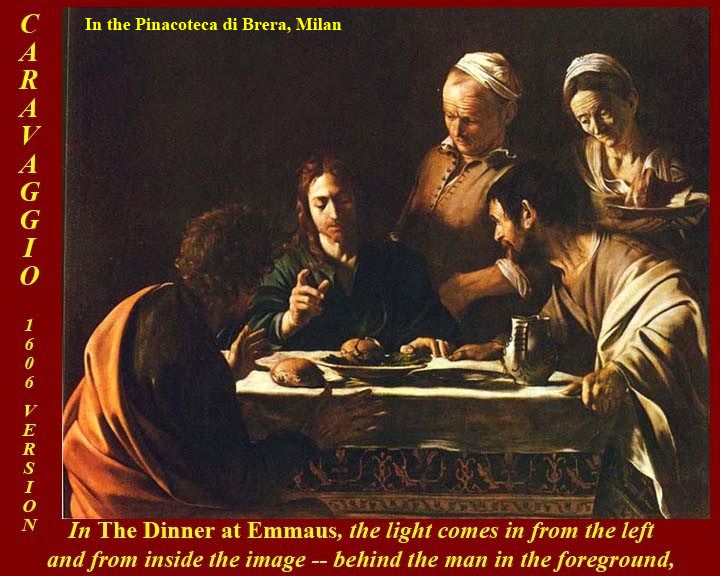
http://www.mmdtkw.org/RenRom0718-1OttavioLeoniCaravaggio1621.jpg
http://www.mmdtkw.org/RenRom0718-2CaravCardsMathew.jpg
http://www.mmdtkw.org/RenRom0718-3CaravaggioEmmaus1606.jpg
http://www.mmdtkw.org/RenRom0718a-CaravaggioSacrificeIsaac1603.jpg
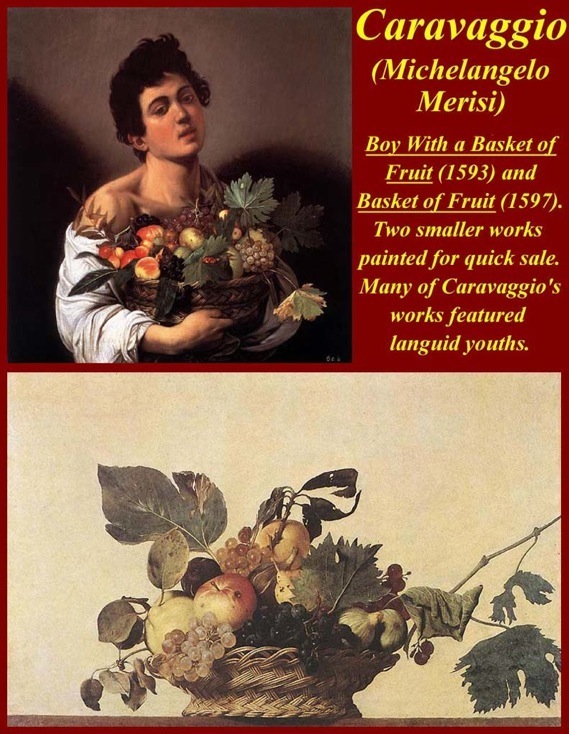
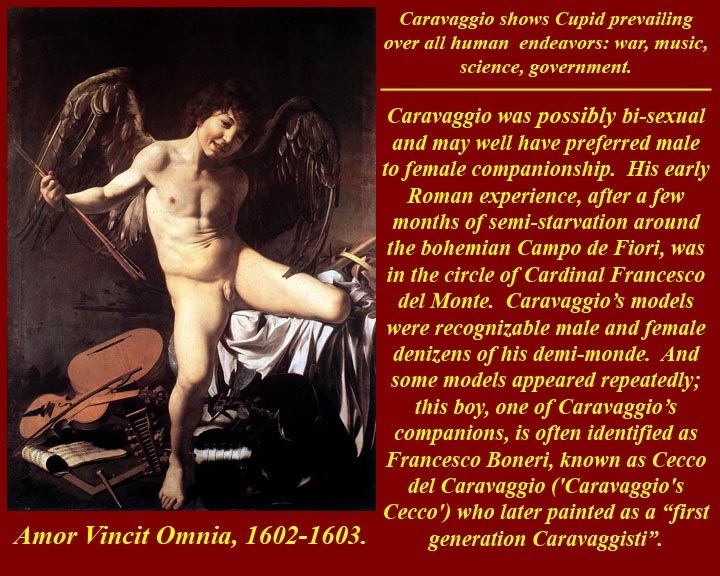
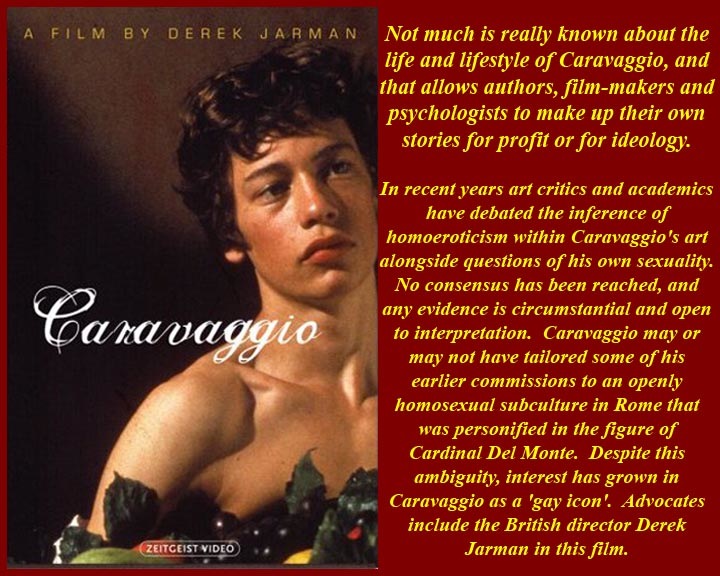
http://www.mmdtkw.org/RenRom0718b-CaravaggBoyFruit.jpg
http://www.mmdtkw.org/RenRom0718c-AmorVictorious.jpg
http://www.mmdtkw.org/RenRom0718c1-CaravaggioJarmanFilm.jpg
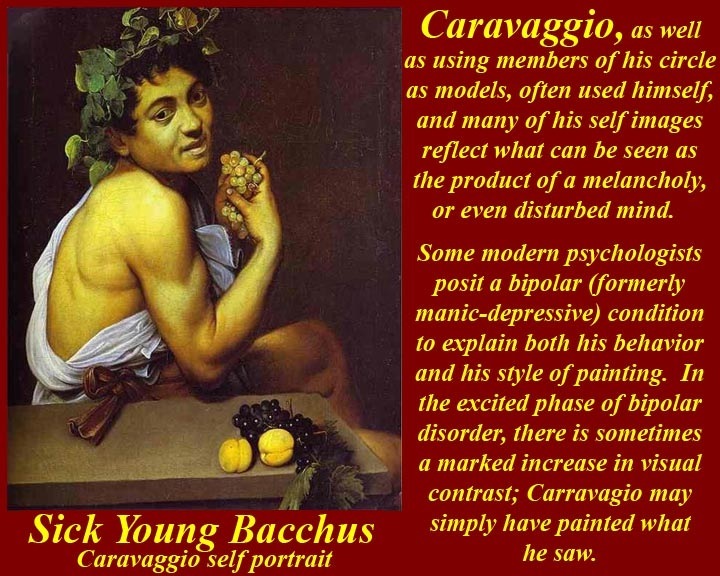
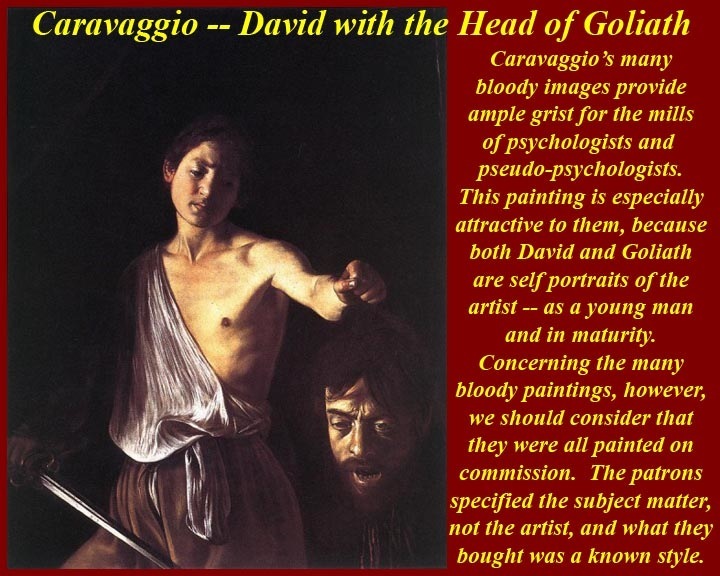
http://www.mmdtkw.org/RenRom0718d-CaravaggioBacchus-self.jpg
http://www.mmdtkw.org/RenRom0718e-CarravaggioBothDavidAndGoliath.jpg
http://www.mmdtkw.org/RenRom0720-CaravaggioCrucifixionConversionSMPopolo1601.jpg
Caravaggio just couldn't stay out of trouble. When he came to Rome in 1592 he settled uneasily into the "artist's life" of drinking, brawling, and starving in the colony of similar men (and their molls) around Campo de Fiori. An early published notice on him, dating from 1604 and describing his lifestyle three years previously, tells how "after a fortnight's work he will swagger about for a month or two with a sword at his side and a servant following him, from one ball-court to the next, ever ready to engage in a fight or an argument, so that it is most awkward to get along with him". Caravaggio seemed to fancy himself as a "bravo" of the kind that Shakespeare parodied in the very first scene of Romeo and Juliet -- but most of that type were either killed or grew out of it. Caravaggio continued to be a bravo for all of his short 39 year life.
In his earliest Roman years Caravaggio eked out a living by painting small still lifes and small paintings of street boys to be sold on the Campo. Nobody knows if Caravaggio patronized the boys himself or if he merely painted them to sell to the homosexuals who frequented the area. He then worked as an assistant in a number of studios, but never stayed in any one very long -- his bad reputation and quarrelsomeness didn't work in his favor. Somebody needed to take the young man in hand. In 1595, he decided to set out on his own and began to sell his pictures through a dealer, a certain Maestro Valentino, who brought Caravaggio's work to the attention of Cardinal Francesco del Monte, a prelate of great influence in the papal court. Caravaggio soon came under the protection of Del Monte and was invited to receive board, lodging, and a pension in the house of the cardinal. The cardinal "kept" several young men, and rumors of his own homosexuality abounded. Again, we don't know whether if Caravaggio (or the good cardinal)
really participated in that lifestyle -- it's still argued vigorously on the Internet as the gay community tries to claim both men as celebrity members of their fraternity and others try to deny it. (e.g., here -- gay -- http://www.glbtq.com/arts/patronage_1,5.html, and here -- not gay -- http://ranciere.blogspot.com/2008/02/adrian-rifkin-on-cultural-studies.html).
Caravaggio is often considered to be the father of the tenebroso or tenebrismo (http://en.wikipedia.org/wiki/Tenebrism) style of exaggerated chiaroscuro (http://en.wikipedia.org/wiki/Chiaroscuro) painting. One of the characteristics of Caravaggio's tenebrism is placing the pictures light source behind the plane of the painting. This meant that some of his human subjects might be "back lighted", i.e., the side of of the subject facing the viewer of the picture is in the darke and the side away from the viewer is lighted. See the examples in the first row of images above.
Caravaggio's personality has been described as melancholy, depressed, disturbed, or manic-depressive (or to be more politically correct, suffering from bipolar disorder); both his behavior and his paintings are cited as evidence. His behavior is documented in accounts of contemporary colleagues, friends, former friends, and enemies -- and on police blotters from Milan to Sicily and Malta. Now envy, fear, bias, and anger may color some of these accounts -- we have no way of really knowing -- but there does appear to be a pattern of bad behavior here. Regardless of what we can gather from accounts of his behavior and personality, we still do have his paintings. They are, as the psychologists say, loaded with clues. There are, in particular, many self portraits that show him ill, drunk, decapitated, decapitating (http://www.mmdtkw.org/RenRom0718d-CaravaggioBacchus-self.jpg and http://www.mmdtkw.org/RenRom0718e-CarravaggioBothDavidAndGoliath.jpg). Two examples are shown. Some psychologists see his tenebrismo as a sign of bipolar disorder; one of the symptoms visible in the "active" (formerly "manic") phase of bipolar disorder is, according to some psychologists, is a change in visual acuity and perceived visible contrast levels. Their argument seems to be that Caravaggio's vision was "different" and so he saw differently and he painted what he saw (which was different from what other people saw) and therefore he was different. There is a distressing circularity here, which is often the case in psychology and that's distressing, if you want to get circular.
In the section on Carracci above it is mentioned that people go to the Cerasi Chapel in Santa Maria del Popolo church to see the Caravaggios rather than the Carracci Asumption (at http://www.mmdtkw.org/RenRom0717b-Carracci-AssumptionPopolo.jpg). The two Carravaggios in the chapel are in the last image in this section.
Caravaggio died, possibly of malaria, on the beach at Port Ercole south of Rome on July 18, 1610. He had missed his boat, which was carrying his posessions and most of his paintings that he still posessed, after being questioned by the police (for once, mistaken identity). Read about it in one of the bio notes below.
For short bio notes on Caravaggio, see http://en.wikipedia.org/wiki/Caravaggio and http://www.wga.hu/frames-e.html?/bio/c/caravagg/biograph.html and http://www.artchive.com/artchive/C/caravaggio.html and http://www.bergerfoundation.ch/Home/Ahigh_caravage.html.
His paintings can be viewed on the Internet at http://en.wikipedia.org/wiki/Chronology_of_works_by_Caravaggio and http://caravaggio.com/# and http://www.christusrex.org/www2/art/caravaggio.htm. Caravaggio's supposed self portraits are at http://sexualityinart.wordpress.com/2009/09/03/caravaggios-self-portrait-as-both-david-and-goliath/.
Orazio Lomi Gentileschi (1563 - 1639) and his daughter,
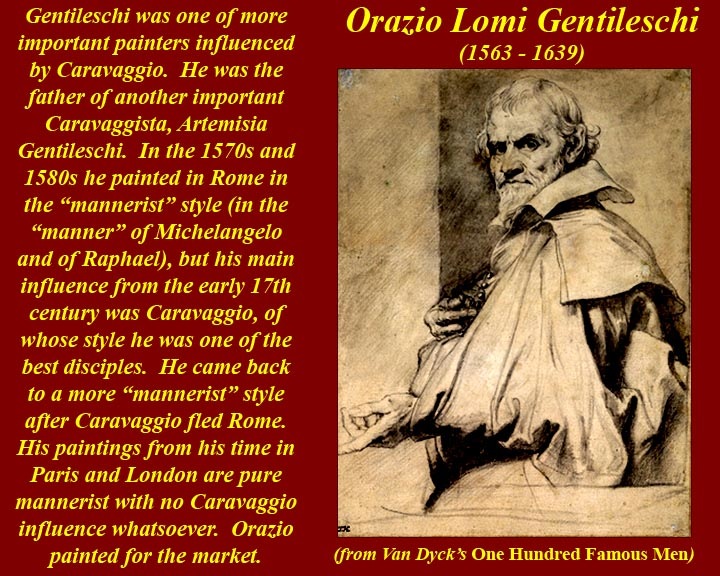
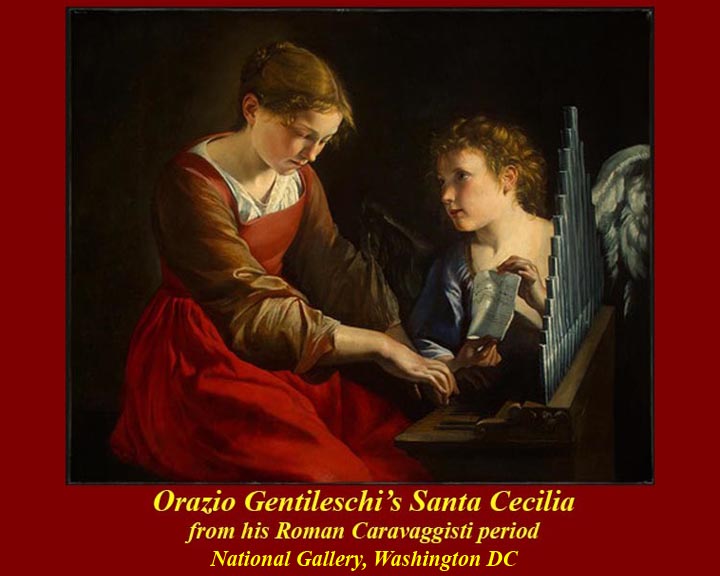
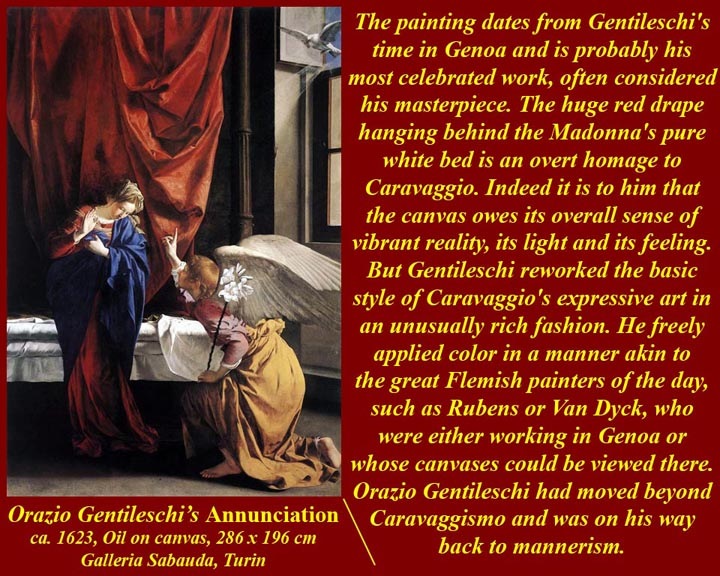
http://www.mmdtkw.org/RenRom0720a-OrazioGentileschi.jpg
http://www.mmdtkw.org/RenRom0720b-OrazioGentileschiStCecilia.jpg
http://www.mmdtkw.org/RenRom0720c-OrazioGentileschiAnnunciation.jpeg
http://www.mmdtkw.org/RenRom0720d-GentileschiPeaceTheArts_c1638-9.jpg
Artemisia Gentileschi (July 8, 1593–ca. 1656)
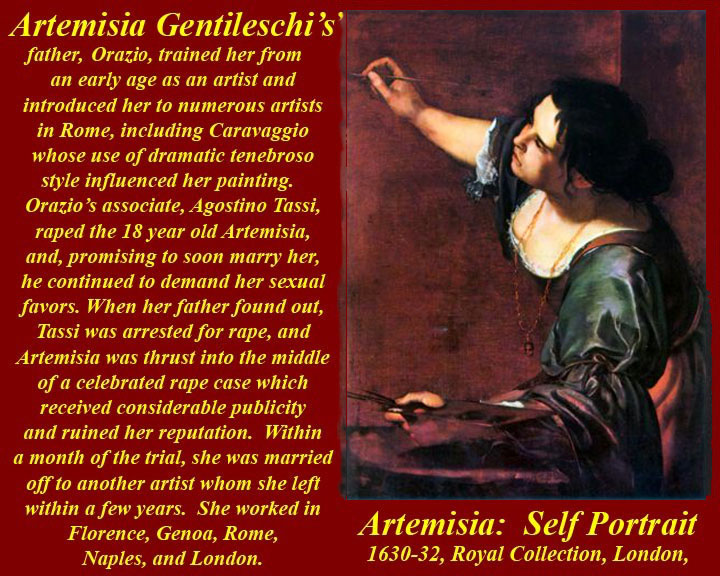
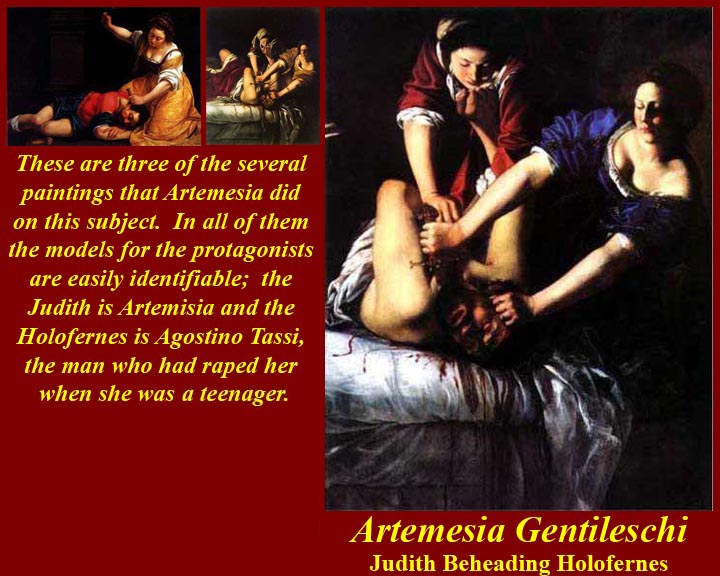
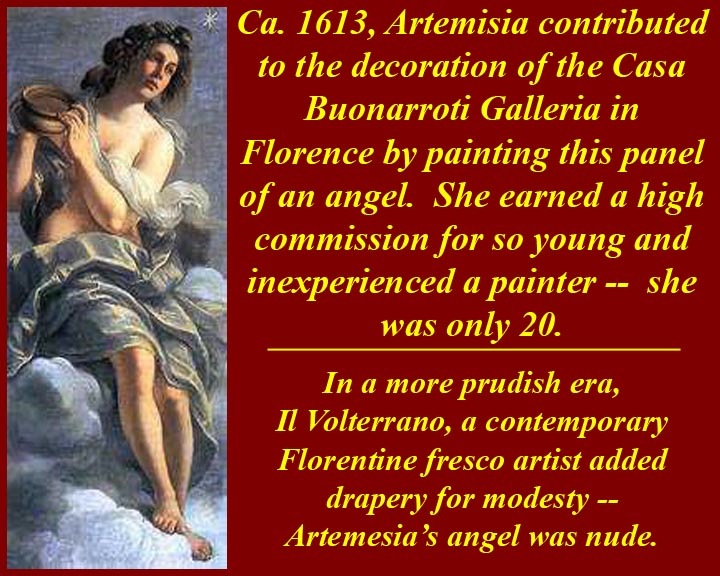
http://www.mmdtkw.org/RenRom0720e-ArtemisiaSelfP.jpg
http://www.mmdtkw.org/RenRom0720f-ArtemisiaJudithCapodimonte.jpg
http://www.mmdtkw.org/RenRom0720g-ArtemisiaAngel.jpg
http://www.mmdtkw.org/RenRom0720hArtemisiaMovie.jpg
Orazio Gentileschi and his daughter Artemisia were two of the most able "first generation" Caravaggio, e.g., followers of Caravaggio's painting style who lived at the same time that Caravaggio did and who (usually) actually knew the painter.
In the late 1570s or early 1580s Orazio Gentileschi moved to Rome, and was associated with the landscape-painter Agostino Tassi (http://en.wikipedia.org/wiki/Agostino_Tassi), executing the figures for the landscape backgrounds of this artist in the Palazzo Rospigliosi, and it is said in the great hall of the Quirinal Palace, although by some authorities the figures in the last-named building are ascribed to Giovanni Lanfranco. He worked also in the churches of Santa Maria Maggiore, San Nicola in Carcere, Santa Maria della Pace and San Giovanni in Laterano. This work was firmly in the mannerist tradition, which emulated the styles of Michelangelo and Raphael. Orazio's daughter Artemisia was born in Rome in 1593.
However, Orazio's main artistic influence starting from the early 17th century was Caravaggio (http://www.mmdtkw.org/RenRomUnit0700-0PixList.html#caravaggio), also in Rome at the time, of whose style he was one of the best followers. He took part in several of Caravaggio's misadventures in Rome's streets, and in 1603 he was called as a witness in the proceedings against Caravaggio.
In 1612 Orazio was again called to the Tribunal of Rome, this time to speak against Tassi, charged with the rape of his daughter Artemisia Gentileschi.
After Caravaggio's flight from Rome, Gentileschi developed a more personal Tuscan lyricism, characterized by lighter colors and precision in detail, reminiscent of his Mannerist beginnings. After a long sojourn in the Marche, in the early 1620s Gentileschi went to Genoa, and then to Paris, at the court of Marie de Medici.
In 1626 he left France to work for Charles I of England, where he remained for the rest of his life. His works became increasingly conventional and decorative, but were appreciated by the local aristocracy for their classicism. Van Dyck included Orazio (above and at http://www.mmdtkw.org/RenRom0720a-OrazioGentileschi.jpg) in his portrait drawings of one hundred illustrious men.
Orazio Gentileschi died in 1639 in London.
Artemisia Gentileschi, Orazio's daughter, is today considered one of the most accomplished painters in the generation influenced by Caravaggio. In an era when women painters were not easily accepted by the artistic community, she was the first female painter to become a member of the Accademia di Arte del Disegno in Florence.
She was one of the first female artists to paint historical and religious paintings, at a time when such heroic themes were considered beyond a woman's reach.
Artemisia Gentileschi was born in Rome, July 8, 1593, the first child of the Tuscan painter Orazio Gentileschi. Her mother died when Artemisia was twelve and Artemisia was was raised by her father, who introduced her to painting in his workshop. She showed much more talent than her brothers, who worked alongside her and excelled in drawing, mixing color, and painting. Since her father's style took inspiration from Caravaggio during that period, her style was just as heavily influenced in the same direction. But her approach to subject matter was different from her father's, as her paintings are highly naturalistic, where Orazio's are idealized.
Because, as a woman, she was denied access to the artistic academies, her father hired Tassi to instruct her. Tassi, with the help of a friend, raped Artemisia and then coopted her into a continuing sexual relationship by promising to marry her. When it became obvious that Tassi marriage promise was false, Artemisia's father prosecuted Tassi for rape (and for theft of a painting) in 1613. In the seven month trial , which centered on the rape, Tassi denied the charges and tried to destroy her reputation, but he was convicted after it was shown that he also had planned to murder his wife, had engaged in a sexual affair with his sister-in-law (who testified against him), and had planned to steal several paintings from Orazio. Artemisia was tortured during her testimony against Tassi -- on the theory that testimony under torture was more likely to be true than simple testimony.
After the trial, Artemisia was quickly married off to a Florentine artist, and the couple moved to Florence where they had five children. Artemisia was a great artistic success in Florence where she was the first woman accepted into the Accademia delle Arti del Disegno (Academy of the Arts of Drawing). Despite her success, monetary problems prompted a move back to Rome in 1621. This was the start of a peripatetic life during which she shed her husband, had a daughter out of wedlock, and, at some point, rejoined her father. The painting styles of Orazio and Artemisia gradually merged to the point that it is difficult to discriminate and ascribe their works. One identifying characteristic of Artemisia's paintings, many of which illustrate the bloody demise of villains, is her inclusion of images of Tassi as the villain and herself as the woman who killed him.
During their travels, which included cities in Italy and then Paris and London, the styles of father and daughter gradually shifted from Caravaggio back to mannerism, but it is not known whether that was their decision or that of their patrons and commissioners -- like most artists they would have been greatly influenced by their market.
Orazio suddenly died in 1639. Artemisia had her own commissions to fulfill after her father's death, although there are no known works assignable with certainty to this period. It is known that Artemisia had already left England by 1642, when the civil war was just starting. Nothing much is known about her subsequent movements. Historians know that in 1649 she was in Naples again, corresponding with Don Antonio Ruffo of Sicily who became her mentor during this, her second, Neapolitan period. The last known letter to Ruffo is dated 1650 and makes clear that she was still fully active. Artemisia was once thought to have died in 1652/1653. Recent evidence, however, has shown that she was still accepting commissions in 1654 -- though she was apparently increasingly dependent on her assistant, Onofrio Palumbo. Thus it might be speculated that she died in the devastating plague that swept Naples in 1656 and virtually wiped out an entire generation of Neapolitan artists.
The 1997 film Artemisia, directed by Agnès Merlet is full if blatant falsehoods. It is loosely based on the painter's life, but its portrayal of the relationship between Agostino Tassi and Artemisia Gentileschi as a passionate affair rather than as rape is wildly inaccurate. It also shows Artemisia denying under torture that she had been raped and Tassi chivalrously taking the blame for the affair -- precisely the opposite of what the trial documents show. For a more detailed description of the films inaccuracies, see http://songweaver.com/art/artemesia.html. An important international exhibition (http://www.metmuseum.org/special/se_event.asp?OccurrenceId=%7B694886C4-280A-11D5-93F2-00902786BF44%7D) of the works of Orazio and Artemisia Gentileschi was held at the Metropolitan Museum of Art in New York in 2002. Two worksby Orazio are in the Washington DC National Gallery (at http://www.nga.gov/cgi-bin/tsearch?oldartistid=11850&imageset=1).
Biographic information on Orazio Gentileschi is on the Internet at http://en.wikipedia.org/wiki/Orazio_Gentileschi and http://arts.jrank.org/pages/15352/Gentileschi-father-daughter.html (with Artemisia). His art can be viewed at http://www.wga.hu/frames-e.html?/html/g/gentiles/orazio/index.html and at http://www.artcyclopedia.com/artists/gentileschi_orazio.html.
Biographic information on Artemisia is available at http://www.artemisia-gentileschi.com/index.shtml and http://www.ic.arizona.edu/ic/mcbride/ws200/gentil.htm and http://en.wikipedia.org/wiki/Artemisia_Gentileschi. Her works can be seen at http://www.artemisia-gentileschi.com/index.shtml and at http://www.svreeland.com/image-gal.html and http://www.arthistoryarchive.com/arthistory/baroque/Artemisia-Gentileschi.html.
Guido Reni (4 November 1575 – 18 August 1642)
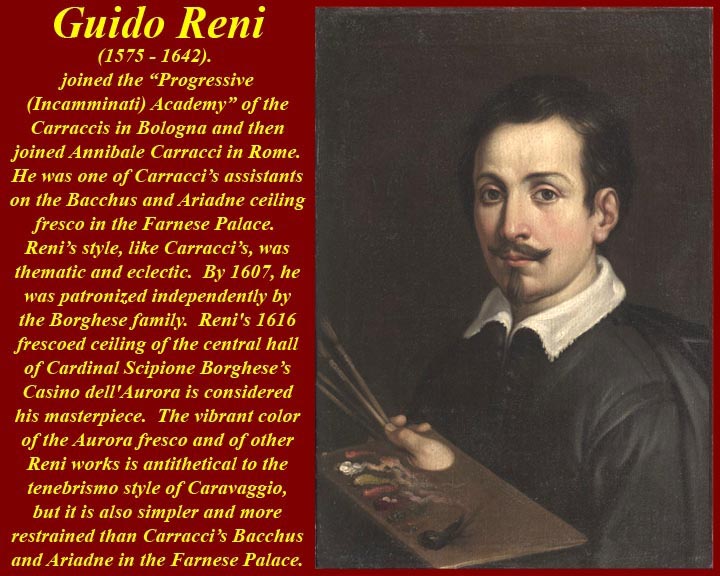
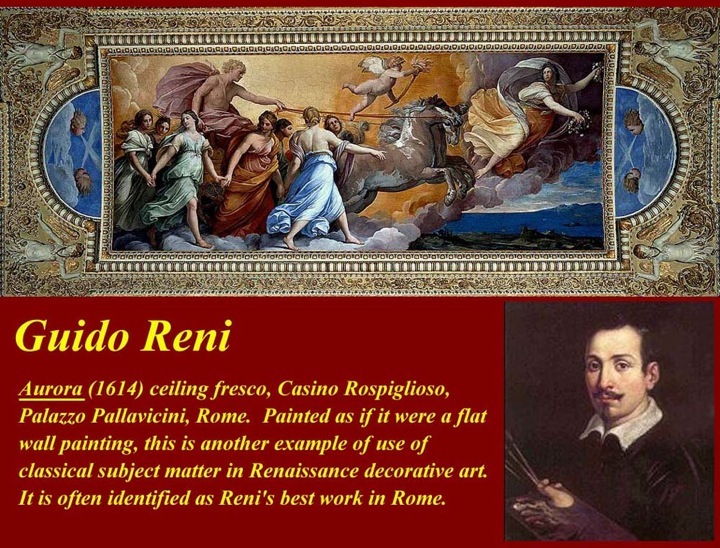
http://www.mmdtkw.org/RenRom0721-Renisp.jpg
http://www.mmdtkw.org/RenRom0721a-ReniAurora.jpg
http://www.mmdtkw.org/RenRom0722-ReniMichael.jpg
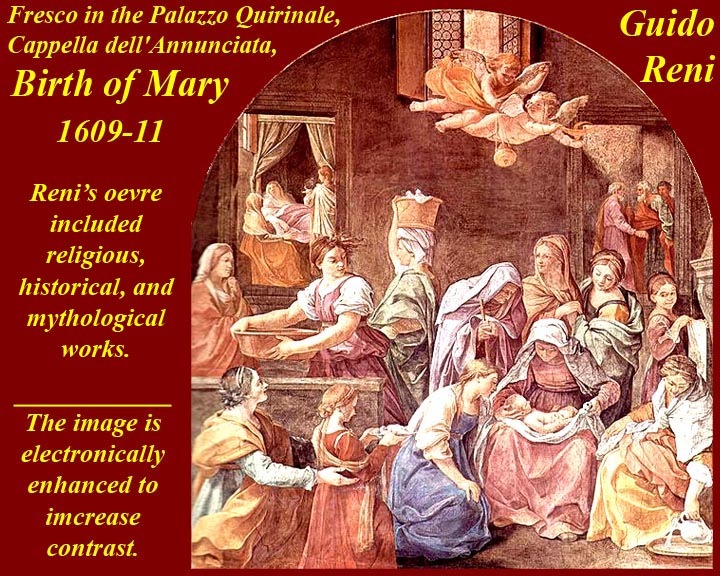
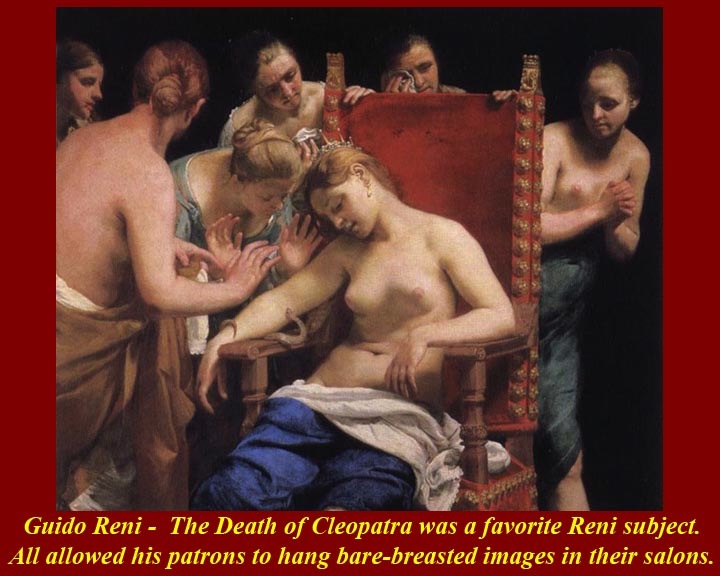
http://www.mmdtkw.org/RenRom0722a-ReniBirthMaryQuirinale.jpg
http://www.mmdtkw.org/RenRom0722b-ReniCleopatra.jpg
http://www.mmdtkw.org/RenRom0722c-ReniAbductionDeianira1621.jpg
Guido Reni was born in Bologna into a family of musicians. After a Bolognese apprenticeship he had moved to Rome to work with the teams led by Annibale Carracci in fresco decoration of the Farnese Palace. He quickly acquired a patron and by 1604 he had his first independent commission. From 1607-1614, he was one of the painters patronized by the Borghese family. Reni was soon at work on the frescoed ceiling of the large central hall of the garden reception building of Cardinal Scipione Borghese, now known as the Casino dell'Aurora and located in what are now the grounds of the Palazzo Pallavicini-Rospigliosi. The large central picture in the ceiling, cumbersomely entitled Apollo in his Chariot Preceded by Dawn [Aurora] Bringing Light to the World (http://www.mmdtkw.org/RenRom0721a-ReniAurora.jpg), is considered Reni's masterpiece. It shows far more simplicity and restraint than Carracci's riotous Triumph of Bacchus and Ariadne (http://www.mmdtkw.org/RenRom0717a-CarracciBacchus.jpg) in the Farnese. There is little concession to perspective, and the vibrantly colored style is antithetical to the tenebrism of Caravaggio's followers. Reni, like the Carracci's carried the mannerist tradition in Rome while Caravaggio's tenebrismo inspired artists elsewhere in Europe. His subject matter was almost entirely religious and ancient mythological. After a short sojourn in Naples (where he was harassed by jealous local artists), he returned to a successful career in Bologna where he died in 1642.
See http://en.wikipedia.org/wiki/Guido_Reni for bio information and for his art see http://www.artcyclopedia.com/artists/reni_guido.html. The US National Gallery of Art has four of his etchings and one chalk drawing; see http://www.nga.gov/cgi-bin/tsearch?oldartistid=203750&imageset=1
Gian Lorenzo Bernini; 7 December 1598 — 28 November 1680)
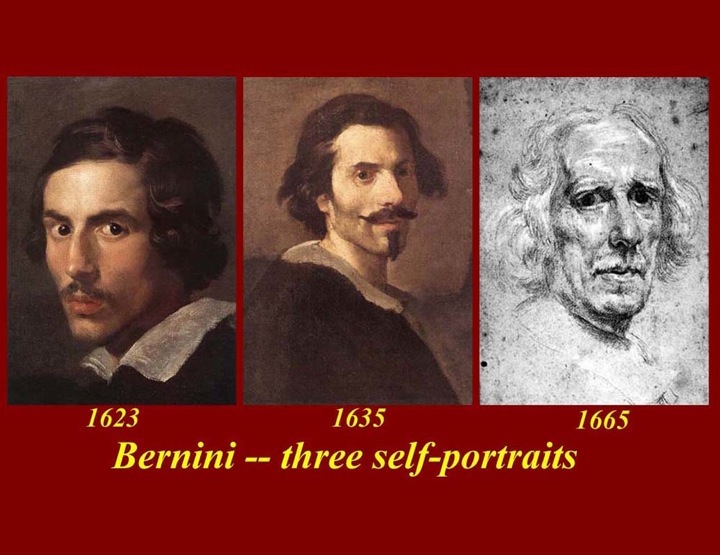
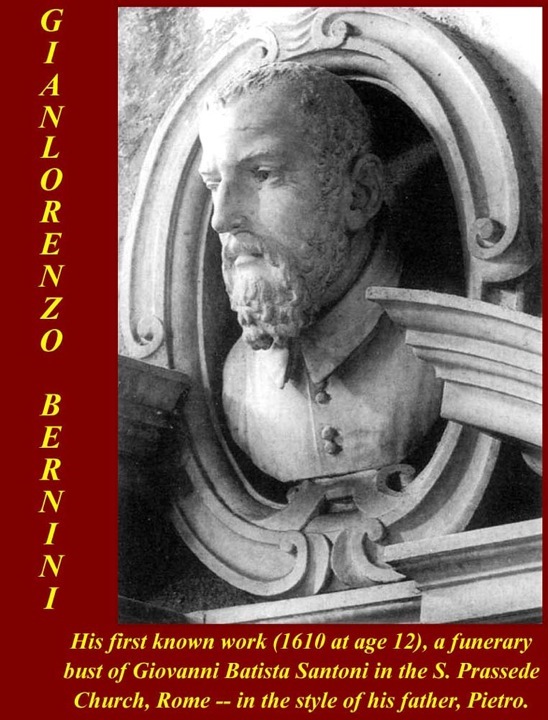
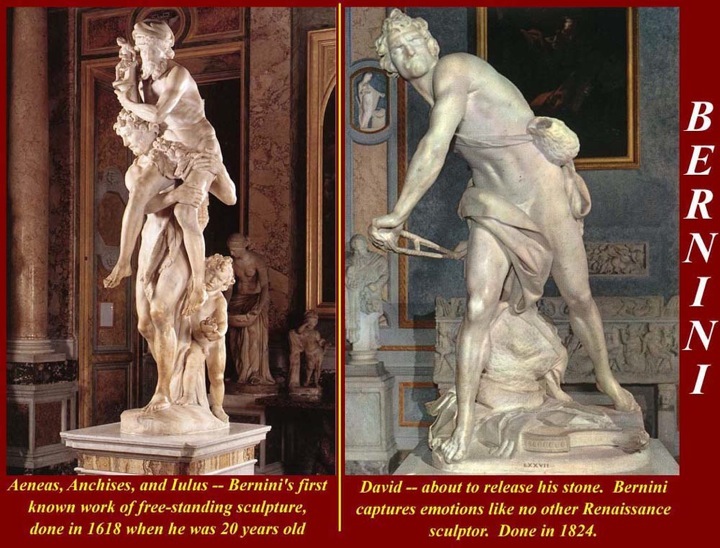
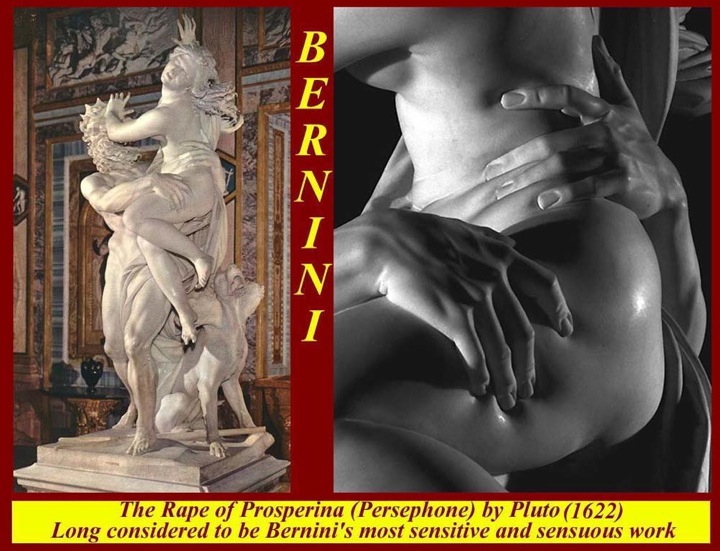
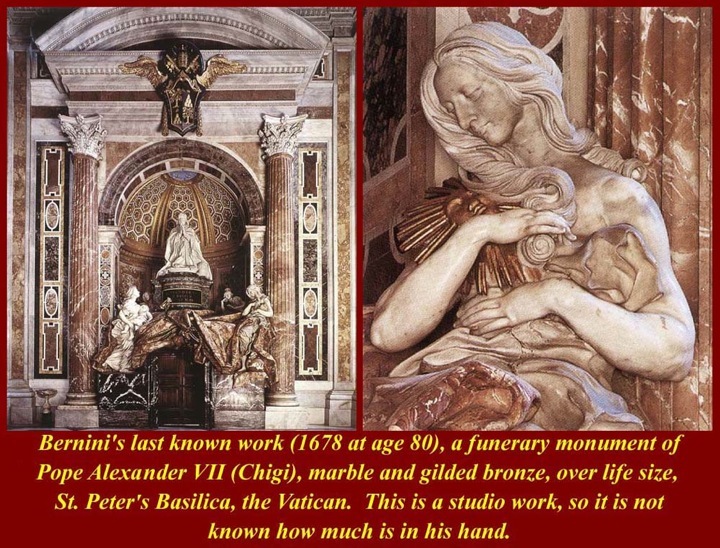
http://www.mmdtkw.org/RenRom0723-BerniniSelfPorts.jpg
http://www.mmdtkw.org/RenRom0724-BerniniFirstWork.jpg
http://www.mmdtkw.org/RenRom0725-BerniniAeneDavid.jpg
http://www.mmdtkw.org/RenRom0726-BerniniProspPlut.jpg
http://www.mmdtkw.org/RenRom0727-BerniniLastWork.jpg
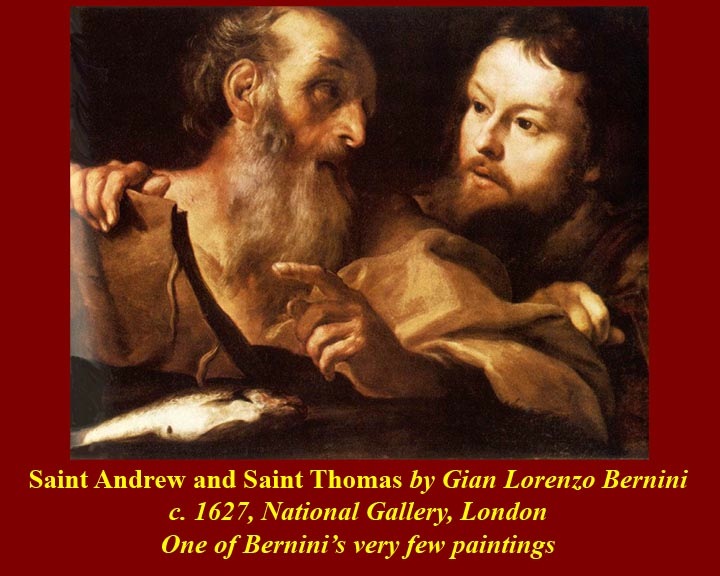
http://www.mmdtkw.org/RenRom0727a-BerniniAndrewThomas.jpg
http://www.mmdtkw.org/RenRom0727b-BerniniApostle.jpg
Bernini worked principally in Rome. He was the leading sculptor of his age and also a prominent architect. In addition he painted, wrote plays, and designed metalwork and stage sets. As a student of Classical sculpture, Bernini possessed the unique ability to capture, in marble, the essence of a narrative moment with a dramatic naturalistic realism which was almost shocking. This ensured that he became the successor of Michelangelo, far outshining other sculptors of his generation. His talent extended beyond the confines of his sculpture to consideration of the setting in which it would be situated; his ability to be able to synthesize sculpture, painting and architecture into a coherent conceptual and visual whole has been termed by the art historian, Irving Lavin, the ‘unity of the visual arts’.
Bernini created the Baroque style of sculpture and developed it to such an extent that other artists are of only minor importance in a discussion of that style. In his long life -- 82 years -- Bernini decorated most of Rome with fountains, buildings, churches, monuments, tombs and excellent marble statuary. Some of his architecture and his rivalry with Borromini were covered in the last unit. His sculptural output began with a funerary portrait head when he was 12 years old and continued for another 68 years when he completed (perhaps only supervising his studio) another tomb. In between there were wonders. His first known full scale free standing statue was of Aeneas (http://www.mmdtkw.org/RenRom0725-BerniniAeneDavid.jpg) carrying his father out of Troy, done in 1618 when he was 20. Four years later, he delivered his David in an extremely tensioned pose about to release the stone that would kill Goliath. Most art historians agree that Bernini carved his own features for the face of David. Both the Aeneas and the David are in the Galleria Borghese in Rome as are four other full scale works, all of which illustrate myths from Ovid's Metamorphoses. The most amazing of the four, the Rape of Prosperina by Pluto (http://www.mmdtkw.org/RenRom0726-BerniniProspPlut.jpg), is shown above. Note how Bernini shows the impressions of the fingers of Pluto in the thigh and side of Prosperina.
Only a few of Bernini's paintings are known. He appears only to have painted a few, including his self portraits. It is noteworthy that his Apostle, the last image above (http://www.mmdtkw.org/RenRom0727b-BerniniApostle.jpg), anticipates impressionism by two centuries and is "a brilliant example of Bernini’s ability to render a face with a few confident brushstrokes." The oil sketch is dated by some to the late 1620 and by others to 1655. An further appreciation of Bernini as a painter is in an exhibition review from 2007 in the Art Tribune (at http://www.thearttribune.com/2007-A-Bernini-year-in-Rome.html).
Bio information on Bernini is at http://en.wikipedia.org/wiki/Gian_Lorenzo_Bernini and http://www.artchive.com/artchive/B/bernini.html (which also has links to some of his works including some of his Roman fountains) and http://www.wga.hu/frames-e.html?/bio/b/bernini/gianlore/biograph.html.
Many of his works are also available at http://www.wga.hu/frames-e.html?/bio/b/bernini/gianlore/biograph.html (click on "works") and at http://www.artcyclopedia.com/artists/bernini_gianlorenzo.html.
The national Gallery in Washington DC has two Bernini works, a chalk drawing of a boy and portrait bust of Monsignor Francesco Barberini.
Giovanni Battista Gaulli (May 8, 1639 – April 2, 1709), also known as Baciccio
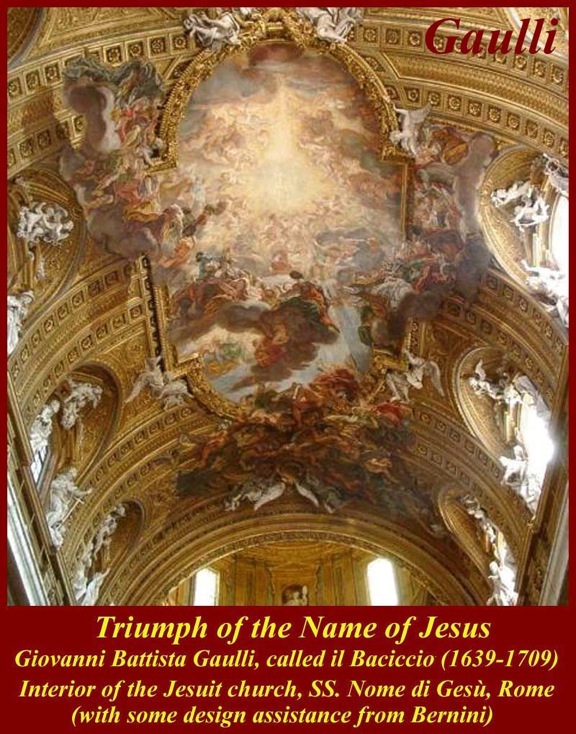
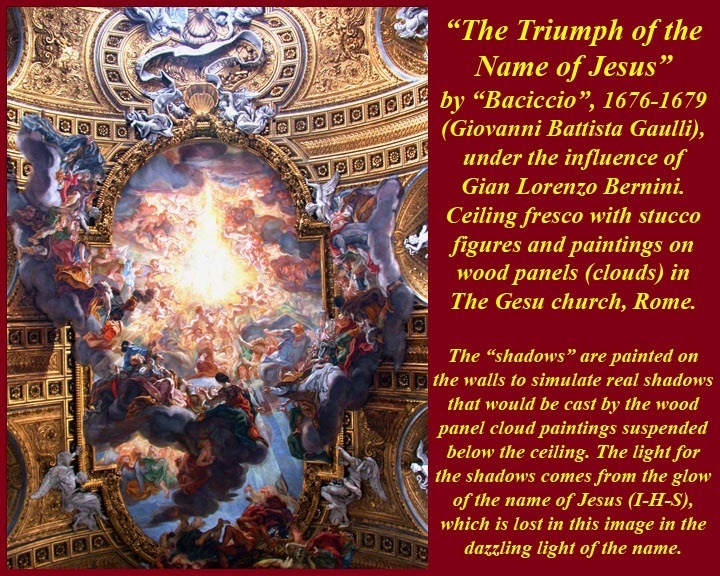
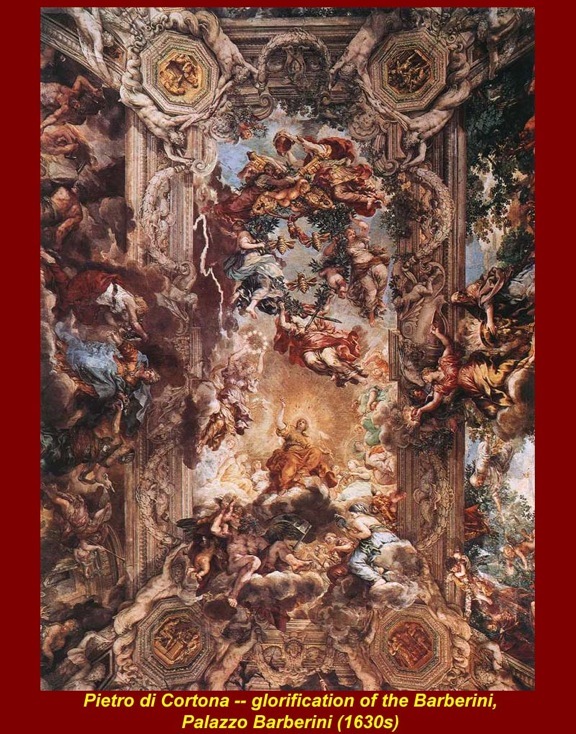
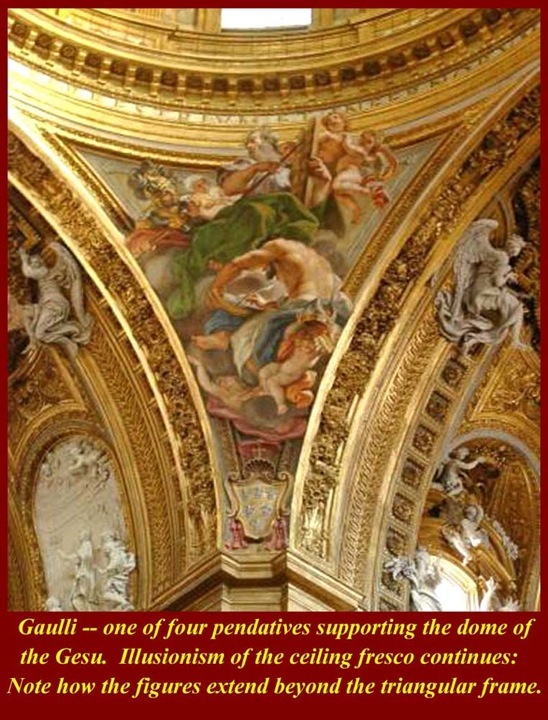
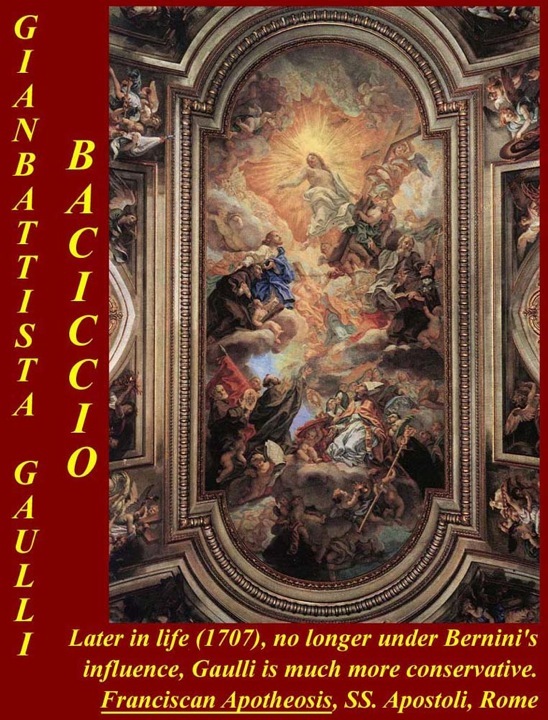
http://www.mmdtkw.org/RenRom0728-GaulliGesuCeil.jpg
http://www.mmdtkw.org/RenRom0728a-NameJesusGaulli.jpg
http://www.mmdtkw.org/RenRom0728b-CortonaBarberi.jpg
http://www.mmdtkw.org/RenRom0729-GaulliPendatGesu.jpg
http://www.mmdtkw.org/RenRom0730-GaulliSApostoli.jpg
http://www.mmdtkw.org/RenRom0731-GaulliJoseph.jpg
Gaulli was from Genoa, an artistic center in those times, and there he saw many different styles of art. He moved to Rome. and in 1662 and became a member of the the Roman artists' guild, the Accademia di San Luca (Academy of Saint Luke), where he was to later hold several offices. At age 22, with the strong support of Bernini, he won the commission to decorate the cavernous and still unpainted Gesu Church of the Jesuits. Bernini participated at least to the extent of encouraging Gaulli to be adventurous. The result is a multimedia extravaganza including stucco angels, hanging panel paintings and a vast ceiling fresco in the nave. In 1999, when the scaffolds were taken down after years of restoration and cleaning, Gaulli's genius (and perhaps Bernini's) was revealed.
The center of the fresco, features the Western Christogram (IHS -- http://en.wikipedia.org/wiki/Christogram) in gold and white on a backsgound so bright that the Christogram is almost invisible. Everything else is illuminated by the brightness from the center; as in the tenebrist works of Caravaggio, the light is behind the plane of the picture. But this "picture" includes the hanging stucco putti (baby angels -- http://images.google.com/images?client=safari&rls=en&q=putti&oe=UTF-8&um=1&ie=UTF-8&sa=N&hl=en&tab=wi) and the panel paintings, which are all "back lighted" by the glare of the Christogram. Not only are they back lighted, but they also cast "shadows" on the downward curve of the vault and further down on the walls of the church. During the restoration, cleaners strove mightily and unsuccessfully to scrub off those shadows -- until they realized that they were part of the frescoes and intended by the painter.
Some illusionist elements were already in use in a number of other ceiling vaults in Roman churches and reception halls in Roman Palazzi. Shown is the Allegory of Divine Providence and Barberini Power (http://www.mmdtkw.org/RenRom0728b-CortonaBarberi.jpg), a 1639 fresco Pietro da Cortona (almost an apotheosis) in Sala Grande of Palazzo Barberini (http://en.wikipedia.org/wiki/Palazzo_Barberini). In the Gesu itself the illusion caries over from the nave ceiling into other decorative elements; the three dimensional elements in the pendatives supporting the dome are a combination of real 3-D and paint on the triangular curved surfaces. Later in life, after Bernini's influence was ended by his death, Gaulli reverted to a much more conservative style -- everything is "back inside the box" in his ceiling painting, The Triumph of the Franciscan Order (http://www.mmdtkw.org/RenRom0730-GaulliSApostoli.jpg), for the Santi Apostoli church (http://en.wikipedia.org/wiki/Santi_Apostoli) in Rome.
Before Gaulli used the IHS Christogram in his ceiling of the Gesu, perhaps at the instigation of the Jesuits and Barberini, it had been much used as a Protestant emblem and therefore fell into disfavor in the Roman Church. The Jesuits coopted the symbol, just as they took over other Protestant elements as a way of deflating the Reformation.
Gaulli's painting of St. Joseph and Jesus (http://www.mmdtkw.org/RenRom0731-GaulliJoseph.jpg) is representative of his mannerist easel paintings. It is an uncommon subject; Mary, not Joseph, is usually shown holding the child. The old Joseph is clearly pleased to have his infant son play with his beard.
See http://en.wikipedia.org/wiki/Giovanni_Battista_Gaulli and http://www.answers.com/topic/gaulli-giovanni-battista. Gaulli's art can be found at with the Google Image search engine.
Constantino Brumidi (July 26, 1805 – February 19, 1880) -- Mannerism on the Mall
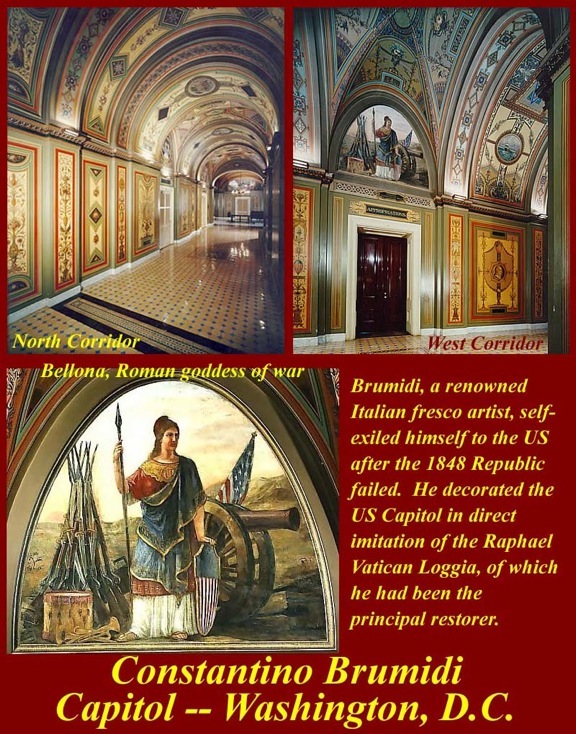
http://www.mmdtkw.org/RenRom0732-BrumidiCapitol.jpg
http://www.mmdtkw.org/RenRom0733-BrumidiGrotesque.jpg
Brumidi was an Italian/Greek-American historical painter, best known and honored for his mannerist 19th century fresco work in the Capitol Building in Washington, DC.
He was busy restoring Raphael's stanze in the Vatican when Garibaldi's and Mazzini's 1848 Roman Republic (http://en.wikipedia.org/wiki/Roman_Republic_%2819th_century%29) was thrown out by the French who were acting as protectors of the Papacy. The occupation of Rome by French forces in 1849 apparently persuaded Brumidi to emigrate; he had joined the short-lived risorgimental Roman Republic. He sailed for the United States, where he became a naturalized citizen in 1852. He painted a number of portraits and bigger works in New York, before he went to Mexico to take up a commission in the Mexico City Cathedral of the Holy Trinity. On his way back to New York, he stopped in Washington DC where he saw the large unpainted surfaces of the Capitol. He offered his services and was hired by Quartermaster General Montgomery C. Meigs (http://en.wikipedia.org/wiki/Montgomery_C._Meigs). His Capitol frescoes are very much in the post -Renaissance Roman mannerist tradition. His grotesques, however are very much American -- native American creatures climbing native American vines rather than the European animals and vines that he saw in Raphael s grotesques.
Brumidi's Corridors in the Capitol are at http://en.wikipedia.org/wiki/Brumidi_Corridors, and his allegorical Apotheosis of George Washington in the central dome is at http://www.aoc.gov/cc/art/rotunda/apotheosis/index.cfm. Additional Capitol art by Brumidi and others is at http://www.aoc.gov/cc/art/index.cfm.
Sir Edward Coley Burne-Jones, 1st Baronet (28 August 1833 – 17 June 1898)
http://www.mmdtkw.org/RenRom0734-BurneJonesSPauls.jpg
Sir Edward Coley Burne-Jones, 1st Baronet (28 August 1833 – 17 June 1898) was a British artist and designer closely associated with the later phase of the Pre-Raphaelite movement, who worked closely with William Morris on a wide range of decorative arts. In addition to painting and stained glass, Burne-Jones worked in a variety of crafts; including designing ceramic tiles, jewelery, tapestries, mosaics and book illustration. In the 1870, shortly after the addition of Rome to unified Italy Burne-Jones was chosen to decorate the new American Episcopal Church in Rome, St. Paul's Within the Walls, the first ever Protestant church in the city. Burne-Jones designed Pre-Raphaelite mosaics which were assembled in Venice, dismantled, and the reassembled in the Church -- mad to measure. Like earlier Roman art, these mosaics -- especially the "heroes" section in the lower register behind the altar -- used the features of contemporary notables. In the section shown are Grant, Garibaldi, and Lincoln. Banker J.P. Morgan, and explosives manufacturer Alfred Nobel are said to be in there too, but I haven't been able to identify them.
A short bio of Burne-Jones is at http://en.wikipedia.org/wiki/Edward_Burne-Jones.
Images of the Mosaic are at http://www.victorianweb.org/painting/bj/mosaic/.
Other Burne-Jones art is at http://www.artcyclopedia.com/artists/burne-jones_edward.html and http://www.abcgallery.com/B/burne-jones/burnejones.html.
Leonardo di ser Piero da Vinci, (April 15, 1452 – May 2, 1519)
http://www.mmdtkw.org/RenRom0735-MonaTellsLeonardo.jpg
Mona tells Leon. Leonardo was not a particularly active artist in his few years in Rome (1513-16), but we just can't leave him out.
Renaissance Rome Unit 08
This page is: http://www.mmdtkw.org/RenRom0800-Sack1527Intro.html
1527 -- The Sack of Rome --
Unit 8
Landesnechts conduct a mock Papal progress during the Sack of RomeThe 1527 Sack of Rome was a result of a unique set of circumstances involving the leaders of emerging European powers and Pope Clement VII Medici. The Protagonists were:
Pope Clement VII Medici, usually considered to have been a brilliant Church bureaucrat before his elevation and a vacillating, unimaginative Pope who was well over his head in dealing with the other protagonists. Our information about the Sack and its causes and aftermath come mostly from the writings of the Florentine historian Luigi Guicciardini, who witnessed the Sack of Rome and is regarded as a reliable source, and the autobiography of Benvenuto Cellini, a notorious braggart and self-aggrandizer. Catholic Church records are voluminous as are archives of the Roman families and of European royal and aristocratic houses. Some of these sources are suspected of bias, but modern historians are fairly certain that they have worked out what happened and who was "responsible".Emperor Charles V, who was also Charles I, King of Spain.
King Francis I Valois of France.
Charles, the 8th Duc de Bourbon, a cousin of Francis I of France and for a while, the commander of his armies. Later he changed sides and was the commander of the Armies of Charles V in Northern Italy.
Henry VIII Tudor, King of England, a sometimes ally of Charles V against the French, Married at the time of the Sack to Catherine of Aragon, an aunt of Charles V.
Suleyman the Magnificent, Sultan of the Ottomans and a constant threat to the eastern end of the Empire of Charles V, sometimes conspiring with the French against Charles V.
Benvenuto Cellini, the volatile commander of the Papal defenses in Castel Sant'Angelo, who claimed in his autobiography to have fired the shot that killed the Duc de Bourbon as Sack began.
Pompeo Colonna, the Cardinal who lost the Papal election that elected Clement VII in 1523 -- he led a looting raid on the Vatican in 1526 and initially shared in the 1527 Sack.
Members of the Frangipani family in Croatia, who were the go-betweens for Suleyman and Francis I of France.
Note that alliances and arrangements were constantly shifting as the protagonists struggled for advantage.Did the Sack of 1527 close out the Renaissance in Rome?
Many Art Historians say it did, but they are the ones who focus in on the school that Raphael left behind when he died: Raphael's studio -- his successors -- broke up the school and fled to the courts of Europe. Therefore, they say, the Renaissance (or at very least Rome's "High Renaissance") was at an end. The fact that a new period, called the "Late Renaissance" followed immediately and that the Baroque period (which Art Historians pretty much loath) produced some of Rome's most highly and intricately decorated churches and palaces does not impress these critics. In fact, art and architecture flourished in Rome in the years after the sack, and the Baroque style spread through Europe from Rome and became the new currency in both fields.
Many of the great humanists were already dead by the time of the Sack, and many more fled while and after it happened. But there was another flowering in Rome, based on the Counter Reformation, but that was too Catholic and much too Jesuit and therefore, even until today, anathema to politically correct European and American academics and art critics.
The Sack caused much destruction and looting of portable art and artifacts, but a simple inventory will show that much of the stationary decorative art survived -- the great pre-Sack frescoes and altarpieces in churches and chapels and palaces are still there today, and they were mightily augmented in the century after the sack.
Certainly some statuary was torn down, but Rome's greatest ever sculptor, GianLorenzo Berini was still to come -- his father, himself a great sculptor and artist and GianLorenzo's teacher, wasn't even born until 1562. Bernini stood so far above his Roman Baroque contemporaries that they are often forgotten, but their work is everywhere in Rome. One of the long-lived GianLorenzo's young students -- still under the master's influence -- produced the "multimedia" illusionist extravaganza on the ceiling of the Gesu (Exaltation of the Name of Jesus) in the 1670s, a century and a half after the Sack.
Giambologna and other great Mannerists also came well after the Sack -- even though Raphael's immediate successors had left Rome, This new Mannerist School was founded shortly thereafter.
Caravaggio was born in 1573 and started seriously painting after 1593. Between then and 1610, when he died alone on the beach at Port'Ercole, he founded another new school to rival the mannerists. First there were Roman "Caravaggisti", and then there were Caravaggisti everywhere. Caravaggio's influence in Rome itself was remarkable but short-lived, lasting only until the 1620s. His foremost followers elsewhere in Italy were Orazio Gentileschi, Artemisia Gentileschi, and the Spaniard José de Ribera. Outside Italy, the Dutch painters Hendrick Terbrugghen, Gerrit van Honthorst, and Dirck van Baburen made the city of Utrecht the foremost northern centre of Caravaggism. The single most important painter in the tradition was the Frenchman Georges de La Tour, though echoes of Caravaggio's style can also be found in the works of such giants as Rembrandt van Rijn and Diego Velázquez.
With all this -- and much more -- going in after 1527, it's hard to carry the case that the artistic lights went out in Rome in 1527. So the answer is: No, the Roman Renaissance did not end with the Sack of Rome.
Renaissance Rome
Unit 8 Slides
http://www.mmdtkw.org/RenRomUnit0800-0PixList.html
The Sack of Rome -- 1527Click Links or small images below to go to larger images for Unit 8.
http://www.mmdtkw.org/RenRom0800-Italy1494.jpg
The papacy's problems started years before: Europe's big powers, Spain, France, the Holy Roman Empire, England, and the Ottomans jostled each other for power and territory, and Italy, with its assortment of small states, offered some easily snatched territorial prizes. The popes, overestimating their own power and the power of alliances that they either crafted or joined, tried to expand their own power and territory on the Italian peninsula or at least to prevent or minimize losses. Some of the popes may have realized the danger involved, but their choices were limited: either play the game or watch passively while others nibbled away at papal power and territory. The popes played, and they made it through the first four wars, but then came the War of the League of Cognac. Unfortunately for the papacy, the incumbent pope at that time was the incompetent Clement VII Medici.
Money problems on other European fronts kept Holy Roman Emperor ("Elect" = not yet crowned) Charles VI from paying his troops in northern Italy, and their commander allowed the troops to start "foraging" for food and loot. They quickly got out of control and rushed toward Rome and "sacked" the poorly defended city.
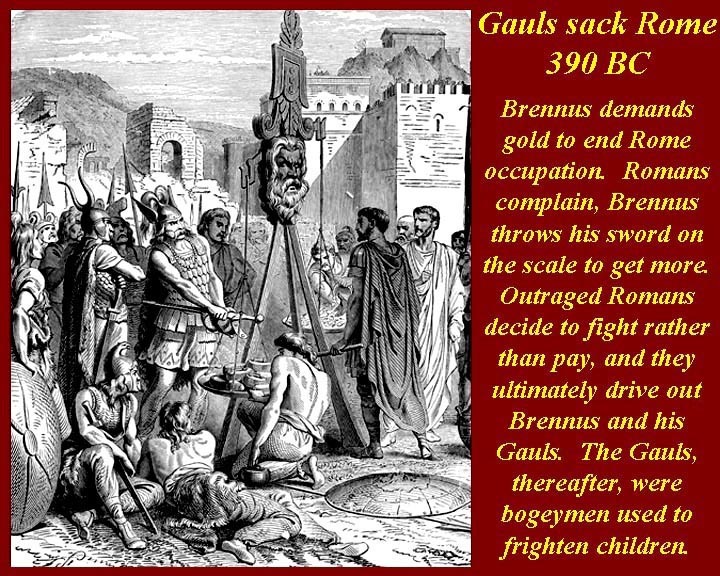
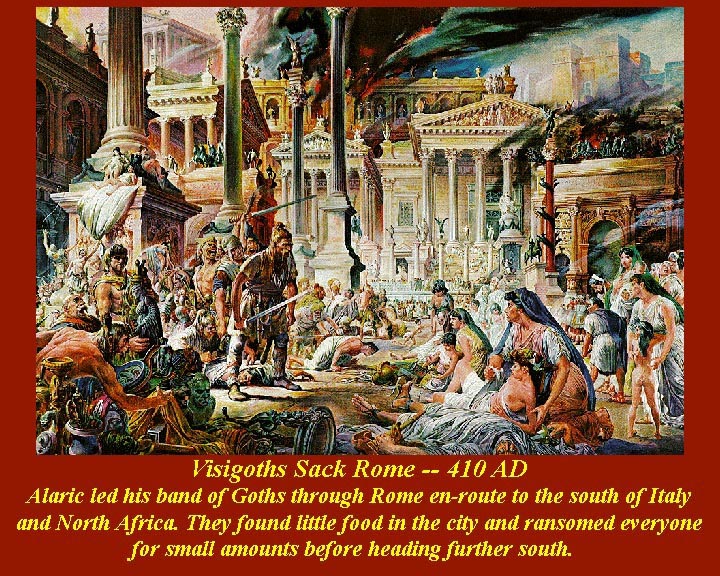
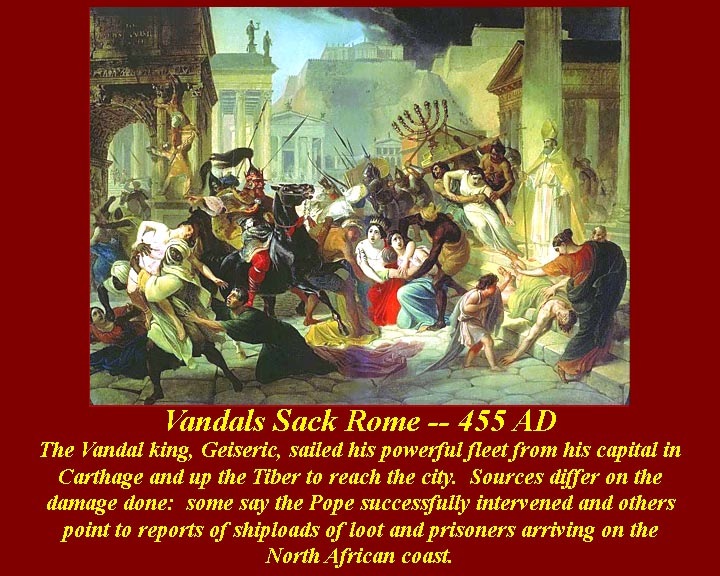
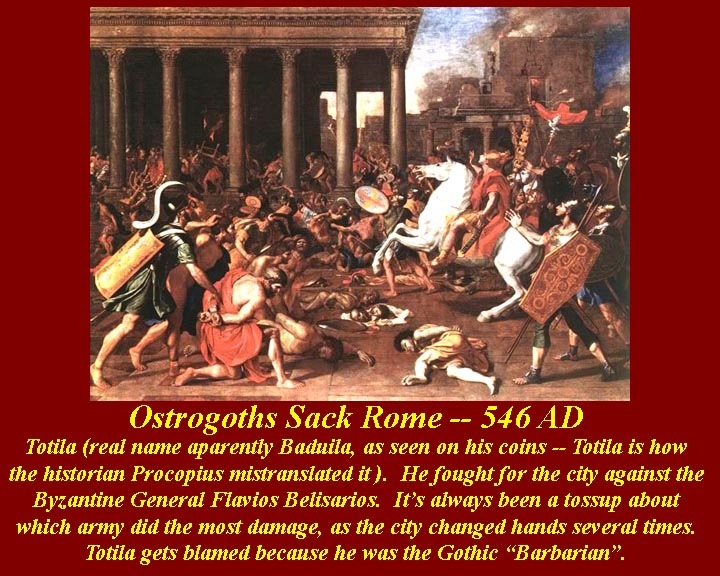
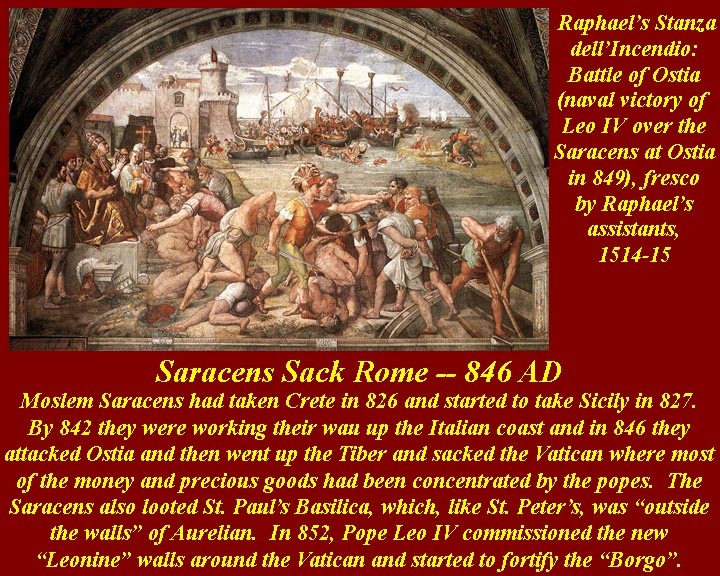
http://www.mmdtkw.org/RenRom0800a-390BCGaulsBrennus.jpg
http://www.mmdtkw.org/RenRom0800b-410ADAlaricVisigothSack.jpg
http://www.mmdtkw.org/RenRom0800c-455VandalsSack.jpg
http://www.mmdtkw.org/RenRom0800d-546OstrogothsSack.jpg
http://www.mmdtkw.org/RenRom0800e-846ADSaracensSack.jpg
http://www.mmdtkw.org/RenRom0800f-1084NormansSackRome.jpg
The Sack of Rome by the marauding troops of the Holy Roman Empire was not the first time that the city was looted. Six previous episodes are recorded.
In 390 BC Brennus led his Gauls south over the Alps and took the city demanding a large ransom for its release. The Romans balked at paying and eventually drove him out, but not before a lot of bloodshed, arson, rape, and looting. Until the end of the Western Roman Empire, the Gauls remained the bogeymen that Roman parents used to frighten their children into submission -- "If you do that, the Gauls will get you."
By 410 AD, Constantine had long ago departed Rome for his new capital, Constantinople, and had taken the Roman bureaucracy and, more importantly, its effective military forces along with him. This allowed barbarians to get easy access to the peninsula and to Rome itself. The first wave, the Visigoths, was led by a disaffected former Roman Army Auxiliary commander named Alaric. The weak Western emperor had failed to deliver on promises to Alaric and his Visigoths, so the moved on Rome. After a long siege, someone in the starving city opened the northern Salaria (now Pincian) Gate and the Visigoths poured in -- looking for food and loot. They found little food, of course, and left with what loot they had gathered through the southern gates only three days later -- slill looking for food.
They also took with them the sister of the Western Emperor (who was also the daughter of the Eastern Emperor) Galla Placidia. The Visigoths hoped to eventually get to North Africa, the breadbasket of the Empire. On their way south, true love happened, and Galla married Alaric. But Alaric died in southern Italy and the Visigoths headed back north (with Galla now on the arm of Atawulf [ = Adolph] the former second-in-command.) The Visigoths moved into southern France with Atawulf and his new bride, Galla, as monarchs in the Visigoth Kingdom (in Aquitaine). After Atawulf was murdered, Galla refused a proposal from his successor and returned to Italy where she married the Roman military commander. Her son became the next Western Emperor. For much more detail on Galla and her multi-generational imperial connections, see http://www.mmdtkw.org/VGallaPlacida.html. In 455, the Vandals came by sea from their headquarters in Carthage. They had originated centuries earlier in Scandanavia (yes they were Vikings) and worked their way down through Europe, crossed into Africa via Spain and Gibraltar, and then moved eastward along the North Aftican coast until they stopped in the Carthage metropolis. They emulated the earlier Carthaginian Empire by becoming first sea traders, then commerce "regulators", and finally pirates. Thier piracy included coastal raiding, and eventually, they sailed up the Tiber and sacked Rome. They took what they wanted and left. The Vandals, years later in 534 AD, had gotten so soft and comfortable in their North African haven that they were soon conquered by the Byzantines led by General Flavios Belisarios.
The next barbarian attack on Rome was in 546 when Totila led his Ostrogoth band south and took the city. By this time, the weak Western Emperors had evacuated to Ravenna and it fell to the forces of the Eastern Empire, led by Count Belisarios. to dispute the Ostrogoth hold on the city. Rome changed hands several times over a period of a few years, and the Ostrogoths eventually were kicked out. Both the Ostrogoths and the Eastern Empire forces heavily damaged an looted the city when they held it, but the successor of Belisarios eventually won, so all the damage and looting was blamed on the Ostrogoths sacking Rome.
A condensed history of Belisarios and his campaigns agains the Vandals and the Ostrogoths (and others) is available at http://en.wikipedia.org/wiki/Belisarius. Several "novelizations" have been written about the life of Belisarios, the best known of which is Count Belisarius by Robert Graves, who also wrote I, Claudius. Like I, Claudius, Count Belisarius has some glaring errors and strange interpretations, but, also like I,Claudius, it's a good read. The Saracens came in 846. Moslems had conquered North Africa in the 7th century and by 846 they, like their Vandal and Carthaginian forebears, turned to sea and coastal piracy. They conquered Malta and then Sicily and began moving up the western coast of the Italian peninsula. By 846 they were in Ostia and movong upriver to Rome. Previously, the papal authorities had concentrated the wealth and relics from Rome's churches to the Vatican "for safety", but that just made it easier for the Saracens to carry the wealth off in large quantities; the Vatican was outside of the Aurelian Walls that surrounded municipal Rome. (What could the papal authorities have been thinking?) The Saracens, as it turned out, didn't even try to penetrate the Aurelian Walls, having taken everything they wanted from the Vatican and from the Basilica of St. Paul, which was also "extra muros" ( = outside the walls). The Saracens left after their raids without doing serious damage, although some reports said that they arrived back in North Africa with shiploads of loot and slaves.
Closing the barn door after the horses are out: The Leonine Wall, which defines the Leonine City, was constructed following the sack of Old St. Peter's Basilica by Saracens in 846. Built from 848 to 852 as the only extension ever made to the walls of Rome, the three-kilometre wall encircled the Vatican area (Civitas Leoniana). An abortive start had been made by Leo III, but disturbances in the city over the cost of the new walls had suspended work, and the good citizens of Rome had dismantled the sections that had been begun and used them in private construction. In 1084, Robert Guiscard, who had earlier consolidated Norman power in southern Italy and was embarked on an expedition toward Constantinople, came back to Italy to save Pope Gregory VII from an attack by Holy Roman Emperor Henry IV. Guiscard's forces occupied the city and (being the displaced Vikings that they were -- yes, Vikings again: Norman = Norsemen) then ran riot. This led to a citizen revolt and a Norman sack of the city; the Roman citizens were killed or enslaved. Henry fled northward and Guiscard took the now very unpopular Pope to safety in Salerno.
Guiscard then resumed his campaign to take Constantinople. He defeated a Venetian fleet to recover Corfu, but died of a fever at Kephalonia.
Guiscard's name, which means "wise guy" (really!) was a play on the name of his family's place of origin, Haute ville la Guichard.
All of this by way of prelude to the 1527 Sack of Rome
-------------------------------------
How do we know what we know?
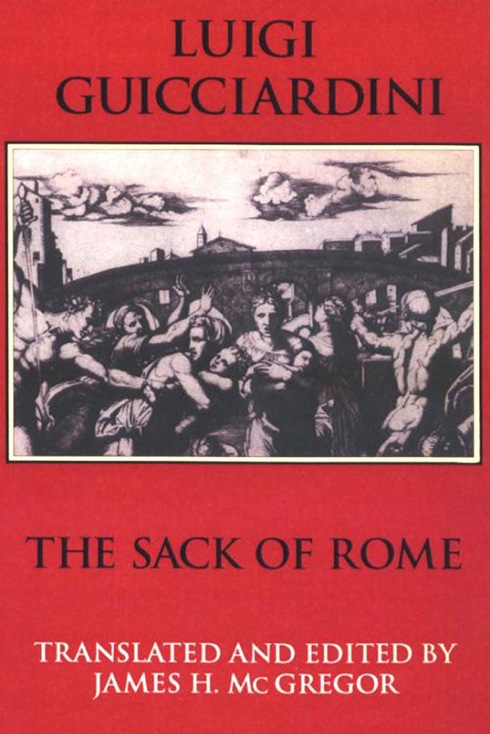
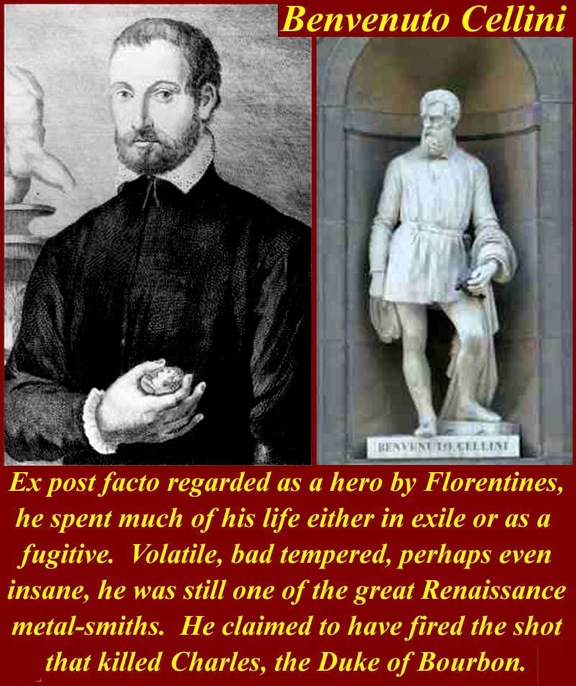
http://www.mmdtkw.org/RenRom0801-Guicciardini.jpg
http://www.mmdtkw.org/RenRom0802-Cellini1.jpg
http://www.mmdtkw.org/RenRom0803-Cellini2.jpg
How do we know what we know? It turns out that a well known and reliable historian was present for the Sack of Rome by the Imperial forces; Luigi Guicciardini wrote a vivid contemporary account of the Sack.
Also present, but a much less reliable reporter, was the goldsmith/metalsmith and adventurer Benvenuto Celini. He had been hired on by Clement VII for two jobs: he was to cast cannon from bronze from melted down statuary, and he was to melt down papal treasure (altar goods and papal jewelery) to make it easier to hide. Gemstones were to be salvaged and sequestered. Because of his cannon-making expertise, he was, by his account, given command of the defense of Castel Sant'Angelo. He wrote up his adventures diring the Sack as part of his famous autobiography. We have no way of knowing which parts of his account, if, indeed, any parts, are factual. Many other claims in his autobiography are patently false, so his Sack episodes may also be highly fictional. We do not, for example, know that the boastful Cellini was really in charge of the Castel Sant'Angelo defense. We do have evidence that he was present, but it is in the form of an indictment for stealing some of those sequestered gems and hidden gold. He claimed in his autobiography that he had confessed to the Pope that he had found about one and one-half pounds of gold (worth about 140 ducats) in the ashes of the fire he used to melt the Pope's gold and had taken it with every intention of paying it back to cover his expenses and "to comfort his poor old father. He said the Pope absolved him."
Cellini was a well known sociopath and was almost constantly in hiding or on the run from the Florentine authorities as a thief, a rowdy, and a serial killer (five, by his own account). He was convicted of sodomy. Now he is idolized as the "patron saint" of the gold market on the Florence Ponte Vecchio -- fitting, since any tourist can tell you that the merchants there are cut from the same pattern as Cellini was. Cellini claimed to have fired the crossbow, whose bolt penetrated the eye and brain of Charles III, Duke of Bourbon. The death of Charles removed any restraint there might have been on the behavior of the Imperial forces, so we can blame the sack on Cellini. He would have loved it.
Players in the Drama:
http://www.mmdtkw.org/RenRom0804-ClementVIIMedici.jpg
Pope Clement VII Medici was just not able to compete either intellectually or militarily with the big powers that were grabbing pieces of Italy. The Sack of Rome and his imprisonment in the Castel Sant'Angelo (for six months, including the month before he surrendered) proved to the world and probably to him that he and everyone else in Italy were simply outclassed.
http://www.mmdtkw.org/RenRom0805-CharlesV.jpg
Charles V Hapsburg, Holy Roman Emperor (Elect) was also Charles I of Spain. For Charles, Italy was only a side-show as proved by the fact that he failed to even fund his armies headquartered in Milan. That lack of funding is what set those amries on the road to plunder, first in northern Italy and eventually (and ultimately, embarassingly) in
Rome. Although Charles clearly had not planned that his mutinous troops should sack Rome, he probably was gratified that the Pope had been taken down a notch. Within three years, that same Pope had to appeal to Charles to use those same forces to reinstate the Medici in their home city of Florence. Shortly thereafter, Charles got the official coronation by the Pope that he had hoped for. He could now be Holy Roman Emperor without the "Elect" qualifier.
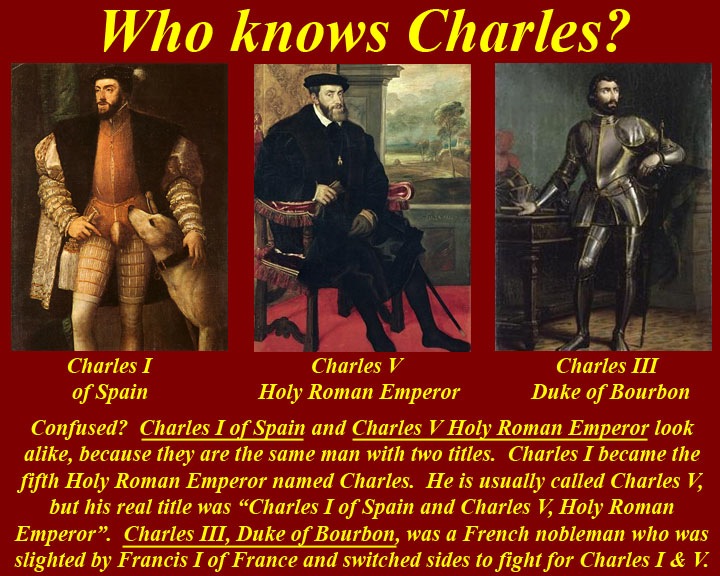
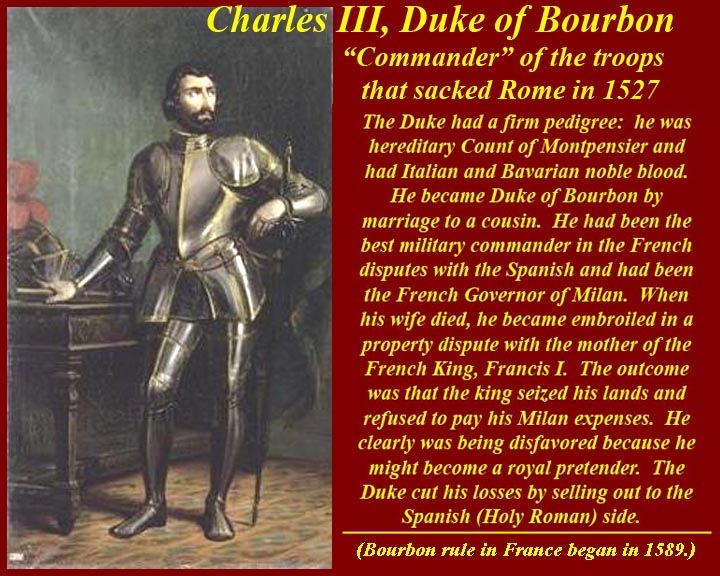
http://www.mmdtkw.org/RenRom0805a-WhoKnowsCharles.jpg
http://www.mmdtkw.org/RenRom0805b-CharlesIIIBourbon1.jpg
http://www.mmdtkw.org/RenRom0805c-CharlesIIIBourbon2.jpg
Just to make the situation more confusing, there was another Charles involved in the Sack of Rome. Charles III, the Duke of Bourbon, was a cousin of Francis I of France, and the two had literally grown up together. Francis made Charles his military commander, and Charles led French forces into Italy and became the French Governor of Milan. Trouble began between them Francis recalled the proud and wealthy Duke from Milan and refused to pay French bills there, for which Charles would then be responsible. A final break came when the wife of Charles, another Bourbon heir, died in 1521 and left all Bourbon properties in France to Charles. This meant that Charles was richer and more propertied than the King.
But the King's mother, Louise of Savoy, claimed the Bourbon properties as heir in proximity in blood, due to their previous entailments. She proposed to settle the property question by marrying Charles; but he refused her proposal (aparently insulting he looks in the process). On behalf of his mother, Francis then confiscated a portion of the Bourbon estates before the lawsuit had even been settled. Seeing no hope of prevailing, Charles made a secret agreement to betray his King and offer his services to Emperor Charles V.
The Emperor, Duke Charles III, and King Henry VIII of England devised a grand plan to partition France, which came to nothing; the plot was discovered and Charles was stripped of his offices and fled into Italy in 1523. In 1524, as commander of an imperial force in northern Italy, he drove the French under Bonnivet from Lombardy, and fought at the Battle of Pavia. The Emperor then gave Duke Charles command of a mixed Spanish-German army (which included a number of Lutherans) sent to chastise Pope Clement VII. He neglected to supply this army with money or food, and Charles was only able to keep it together by promises of loot. Though Clement arranged a truce with the Emperor, the army continued its advance, reaching Rome in May, 1527. The death of Duke Charles — the artist and goldsmith Benvenuto Cellini claimed that he fired the shot that killed him — outside the walls of Rome removed the last restraints from the army, which resulted in the sack of Rome.
http://www.mmdtkw.org/RenRom0806-FrancisIofFrance.jpg
Francis I (French: François Ier ), was King of France from 1515 until his death on March 31, 1547. He is considered to be France's first Renaissance monarch. In the larger picture he was allied with Suleyman, the Ottoman Emperor who was harassing the eastern edges of the Holy Roman Empire -- it was that pressing problem which drained money away from the imperial forces in northern Italy commanded by the Duke of Bourbon.
Charles V, at the same time, was courting the Safavids in Persia (Ismail I and Tahmasp I, leaders at the beginning of a new Turkic speaking dynasty that came from Azarbaijan, probably of Kurdish ethnicity). Distance and slow communications prevented a formal alliance between the Emperor and Persia, but the Persians did start to harass the Turks and took some pressure off the eastern edge of the Holy Roman Empire. In 1532, the first Ottoman-Safavid War broke out. It lasted until 1555, and four subsquent Turco-Persian wars spread out into the middle of the 18th century. See http://en.wikipedia.org/wiki/Turco-Persian_Wars.
http://www.mmdtkw.org/RenRom0807-Henry8.jpg
In 1520, King Henry VIII of England, his wife, Queen Catherine, and virtually the entire English court had traveled across the English Channel for a meeting with King Francis I of France, for the purpose of establishing a political alliance. The two monarchs were rivals, both politically and personally, and each prided himself on the splendor of his court.
The meeting was to take place between the villages of Ardres and Guines, near Calais, but as the castles at both villages were in very poor condition, separate camps were established for the French and English courts in fields near the villages--Henry's court at Guines, and Francis's court at Ardres.
For three weeks (June 7-June 24) the two courts strove to outdo each other on this "Field of Cloth of Gold" in displays of wealth and splendor. There were jousts and processions, masques, balls, banquets, sporting events, and even fireworks. The lavish expenditures nearly bankrupted both the French and the English treasuries, and yet the meeting between Henry and Francis proved to be of no political value. On June 25, the English court returned to Calais.
Two weeks later, King Henry met with the Holy Roman Emperor Charles V of Spain, who was Queen Catherine’s nephew. Catherine, who was after all a Spanish princess, had always favored an alliance with Spain rather than France, and had acquiesced only reluctantly when their daughter Princess Mary had been betrothed to Francis’s heir, the Dauphin of France. Now Henry concluded a treaty with Charles, with each agreeing not to make any new alliance with France for at least two years. Cardinal Wolsey arranged to have Mary’s betrothal to the Dauphin broken, and instead Mary was betrothed to Charles.
Two years later King Henry declared war on France, and his ally, the Emperor Charles, did likewise soon afterward. Nevertheless, by 1525, the betrothal between Mary and Charles had been broken also, and a new treaty had been arranged with France. Throughout his reign, King Henry continued to manipulate these two powerful monarchs, and continued to be manipulated by them, as each jockeyed for political ascendancy in Europe.
In 1527, while Clement VII was being held prisoner in Castel Sant'Angelo, Henry's emissaries reached the pope with Henry's request for his marriage to Catherine, the aunt of Charles V, to be annulled. Clement, by that time thoroghly cowed, refused to give Henry what he wanted, an unconditional annullment.
Henry's request was not without merit; Catherine had, as Henry's petition said, been betrothed to his brother who had died. The Pope did agree to a conditional dispensation(i.e., one that required further evidence and decision before annullment) but Thomas Wolsey told Henry that that would not be sufficient. Unconditional annullments had been (and continue to be) granted in more questionable circumstances, so we can conclude that the deciding factor for Clement was political (and survival) rather than religious.
Wolsey, ( c. 1474–1530) usually known as Cardinal Wolsey, incurred Henry's displeasure by failing to secure the papal dispensation necessary for Henry VIII’s divorce from Catherine of Aragon. He was arrested on a charge of treason and died on his way to trial.
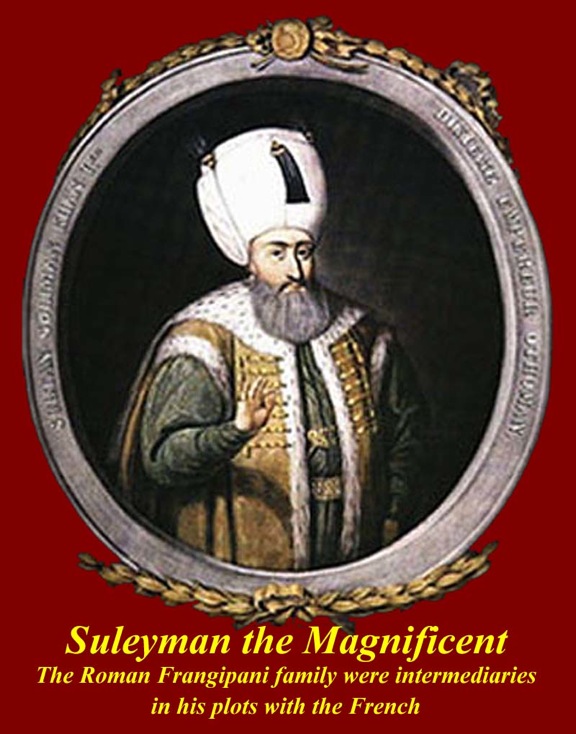
http://www.mmdtkw.org/RenRom0808-Suleyman.jpg
http://www.mmdtkw.org/RenRom0809-SuleymanThugra.jpg
"...Suleyman in his time was regarded as the most significant ruler in the world, by both Muslims and Europeans. His military empire expanded greatly both to the east and west, and he threatened to overrun the heart of Europe itself. In Constantinople, he embarked on vast cultural and architectural projects. Istanbul in the middle of the sixteenth century was architecturally the most energetic and innovative city in the world. While he was a brilliant military strategist and canny politician, he was also a cultivator of the arts. Suleyman's poetry is among the best poetry in Islam, and he sponsored an army of artists, religious thinkers, and philosophers that outshone the most educated courts of Europe. The reign of Suleyman in Ottoman and Islamic history is generally regarded as the period of greatest justice and harmony in any Islamic state.... The Europeans called him "The Magnificent," but the Ottomans called him Kanuni, or "The Lawgiver"....
"...Suleyman was a major player in the politics of Europe. He pursued an aggressive policy of European destabilization; in particular, he wanted to destabilize both the Roman Catholic church and the Holy Roman Empire. When European Christianity split Europe into Catholic and Protestant states, Suleyman poured financial support into Protestant countries in order to guarantee that Europe remain religiously and politically destabilized and so ripe for an invasion. Several historians, in fact, have argued that Protestantism would never have succeeded except for the financial support of the Ottoman Empire.
"Suleyman was responding to an aggressively expanding Europe. Like most other non-Europeans, Suleyman fully understood the consequences of European expansion and saw Europe as the principle threat to Islam. The Islamic world was beginning to shrink under this expansion. Portugal had invaded several Muslim cities in eastern Africa in order to dominate trade with India, and Russians, which the Ottomans regarded as European, were pushing central Asians south when the Russian expansion began in the sixteenth century. So in addition to invading and destabilizing Europe, Suleyman pursued a policy of helping any Muslim country threatened by European expansion. It was this role that gave Suleyman the right, in the eyes of the Ottomans, to declare himself as supreme Caliph of Islam. He was the only one successfully protecting Islam from the unbelievers and, as the protector of Islam, deserved to be the ruler of Islam...." (Exerpted from http://www.wsu.edu:8080/~dee/OTTOMAN/SULEYMAN.HTM.)
In Europe, Süleyman was known as the Magnificent, a recognition of his prowess by those who feared him most. He had great victories along the fringes of Europe in territories also coveted by Charles V. Belgrade fell to Süleyman after a siege in 1521. The next year the Christians were compelled to abandon the Greek island of Rhodes. In 1526 Ottoman forces killed the king of Hungary and the flower of the Magyar nobility at the Battle of Mohács and took Buda on the Danube. Vienna was besieged unsuccessfully during the campaign season of 1529. North Africa up to the Moroccan frontier was brought under Ottoman suzerainty in the 1520s and 1530s, and governors named by the sultan were installed in Algiers, Tunis, and Tripoli. In 1534 Kurdistan and Mesopotamia were taken from Persia. The latter conquest gave the Ottomans an outlet to the Persian Gulf, where they were soon engaged in a naval war with the Portuguese. Ottoman forces confronted those of the Charles V along the Danube and at sea in the western Mediterranean. In 1536 Süleyman I's diplomats concluded a treaty with Francis I of France, the Habsburgs' European rival, which granted the French commercial concessions in the Ottoman Empire in return for an informal alliance against their common enemy. (For years, Jean Frangipani, a Croat possible cognate of the Roman Frangipani family had been the go-between for the French and Ottoman courts.)
When Suleyman died while on a campaign in Hungary in 1566, the Ottoman Empire was a major world power. Most of the great cities of Islam -- Mecca, Medina, Jerusalem, Damascus, Cairo, Tunis, and Baghdad -- were under the sultan's crescent flag. The Ottoman Porte exercised direct control over Anatolia, the Balkan provinces south of the Danube River, Syria, Palestine, and Mesopotamia. Egypt, Mecca, and the North African provinces were governed under special regulations, as were satellite domains in Arabia, in the Caucasus, and among the Crimean Tartars. In addition, the native rulers of Wallachia, Moldavia, Transylvania, and Ragusa (present-day Dubrovnik) were vassals of the Suleyman.
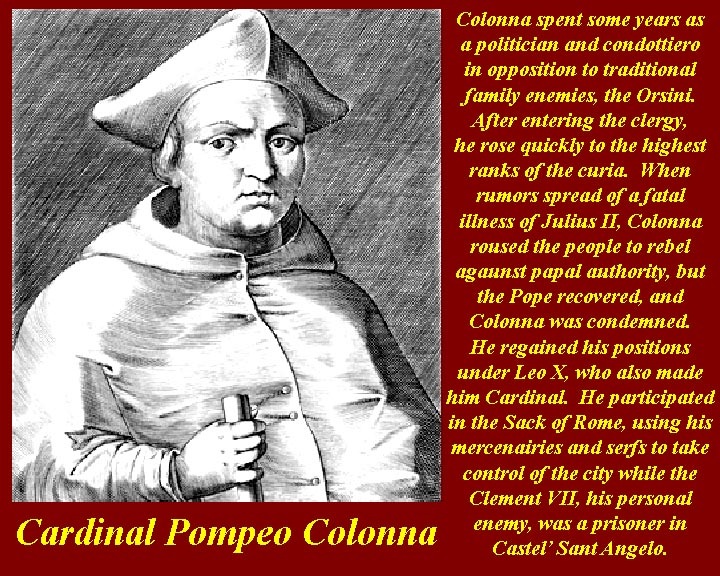
http://www.mmdtkw.org/RenRom0809a-PompeoColonna1.jpg
http://www.mmdtkw.org/RenRom0809b-PompeoColonna2.jpg
Colonna was a bit player in the larger drama, but his presence was felt in Rome. In 1526, the year before the Sack, he reportedly led a mob that broke into the Vatican and stole gold from the altars and sacristy of St. Peters.
He was a protagonist in the Sack of Rome, when, with a group of mercenaries and peasants from Colonna fiefs in the countryside, he took part in the sack and assumed control of the city while his personal enemy, pope Clement VII, was a prisoner in Castel Sant'Angelo. His inital participation in the Sack was partially redeeemed when he opened Palazzo Colonna and offered his protection to Romans fleeing the depredation and violence of the Imperial forces.
He was later legate in Ancona and archbishop of Monreale. In 1530 he was created general lieutenant of the Kingdom of Naples by Emperor Charles V.
Colonna was also a poet. His most famous work is De laudibus mulierum, written for his relative Vittoria Colonna.
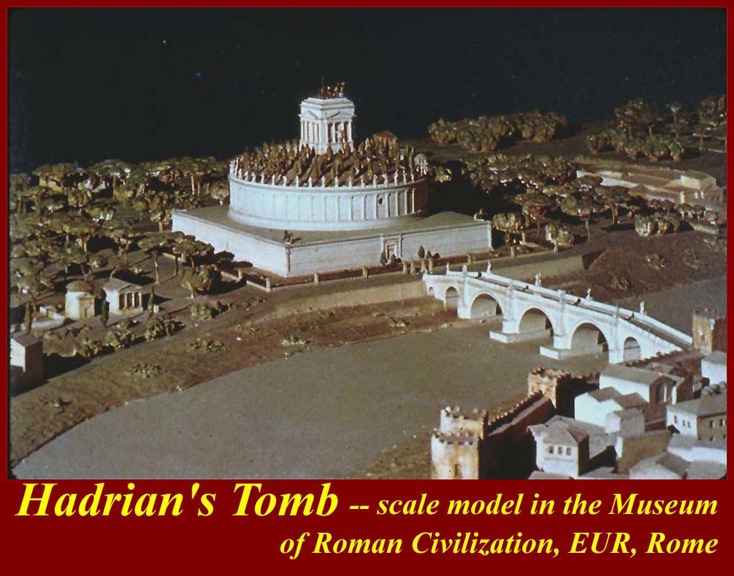
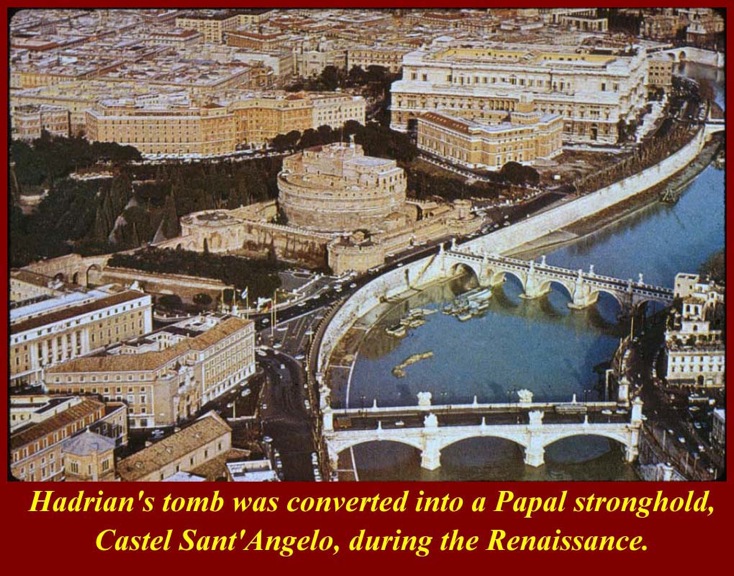
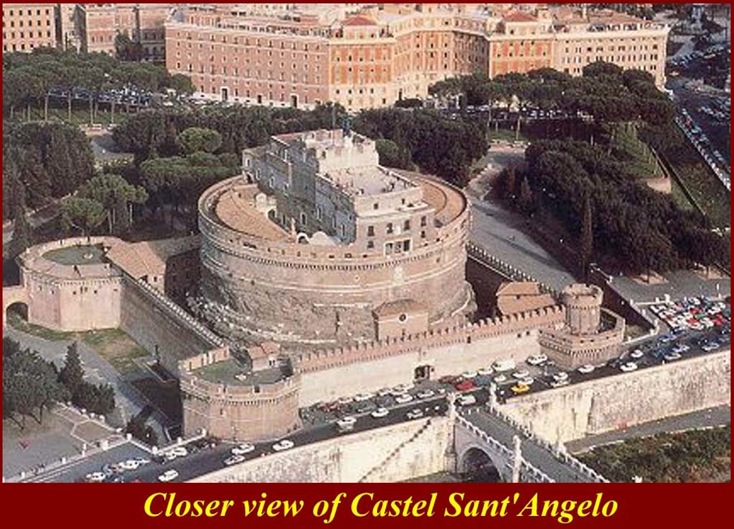
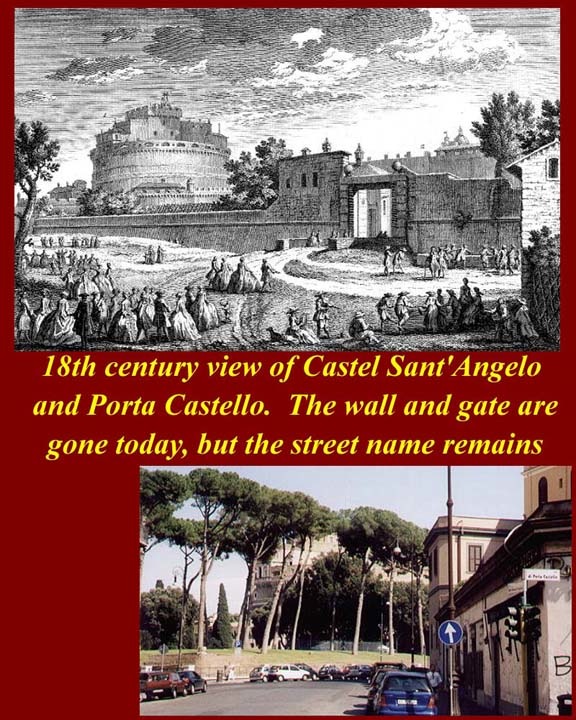
http://www.mmdtkw.org/RenRom0810-HadrianTomb.jpg
http://www.mmdtkw.org/RenRom0811-CastelSAngelo1.jpg
http://www.mmdtkw.org/RenRom0812-CastelSAngelo2.jpg
http://www.mmdtkw.org/RenRom0813-CastelSAngelo3.jpg
http://www.mmdtkw.org/RenRom0814-Passetto.jpg
Castel Sant'Angelo was originally built as a tomb for Hadrian (died 138) and was then was also the site of the entombment of a number of his successors until the time of Caracalla (died 217 AD). The building was converted into a military fortress in 401 by Western Emperor Honorius to guard the Vatican end of the Pons Aelius (now Ponte Sant'Angelo). By 1427 it was very much as it is today except that it was surrounded by an additional low wall with a fortified gate.
When the Imperial troops attacked on May 6, 1527, Pope Clement's initial intention was to try to face them down in the Vatican. But he quickly realized they were out of control and fled through the Passetto, the safety escape passageway built in 1277, to Castel Sant'Angelo. The fortress was not taken during the 1527 Sack, but after one month the Pope officialy surrendered himself to imprisonment in the Castel. (This allowed resupply of comestibles, water, and other supplies and stopped exchanges of fire.)
Clement was kept as a prisoner in Castel Sant'Angelo for six months. After bribing some Imperial officers, he escaped disguised as a peddler, and took shelter in Orvieto, and then in Viterbo. He came back to a depopulated and devastated Rome only in October 1528.
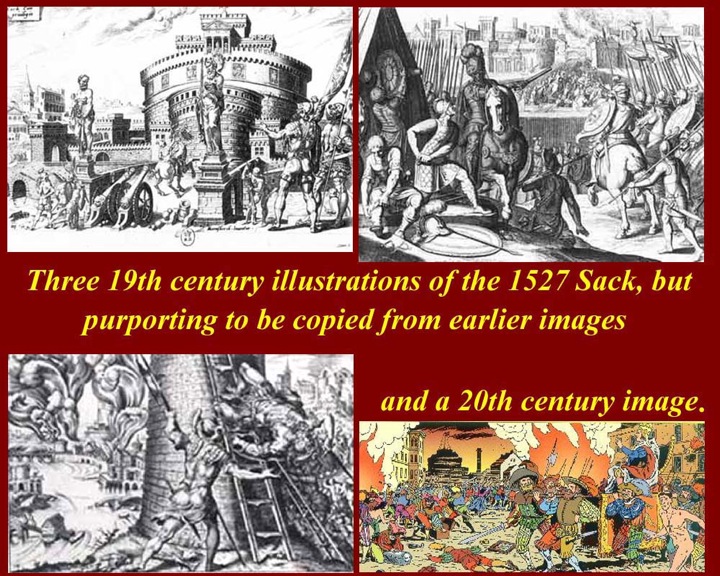
http://www.mmdtkw.org/RenRom0815-SackImages.jpg
http://www.mmdtkw.org/RenRom0815a-1527Sack-JohannesLingelbach17thC.jpg
There are no surviving eyewitness images of the events in Rome during the Sack of 1527. Several artists drew and painted scenes based on description or on earlier images that did not survive.
Fighting forces
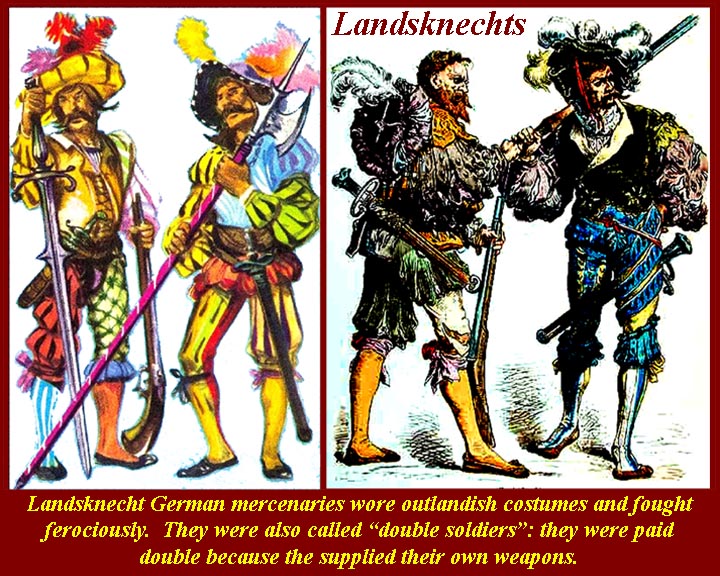
http://www.mmdtkw.org/RenRom0816-Landesnechten1.jpg
http://www.mmdtkw.org/RenRom0817-Landesnechten2.jpg
In addition to Catholic regular Spanish troops, Charles III, Duke of Bourbon, had a large number of Lutheran German mercenary landsknechts in his force. These mercenaries provided their own uniforms and weapons and were also known in German as "double soldiers". Originally they were all just unattached mercenary pikemen (literally "freelancers"), but by the time of the sack they carried a variety of arms including the new personal gunpowder weapon, the harquebus (also arquebus, arquebut and several additional name variations.) The word "landsknecht" meant that the were men of the (flat) lands, as opposed to mountaineers ("montagnards") like the Swiss mercenaries who were also on the market. Generally speaking, the Swiss montagnards worked for the French and the Papacy and German Landsknechts worked for the Spanish and Holy Roman Empire Hapsburgs.
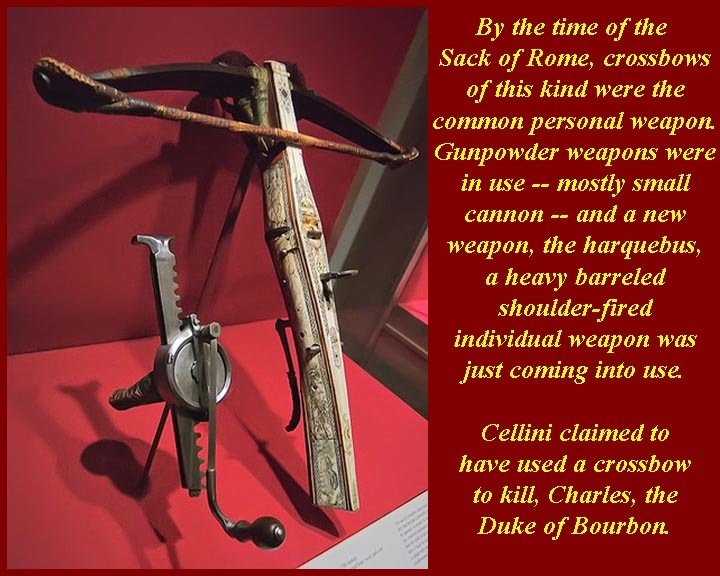
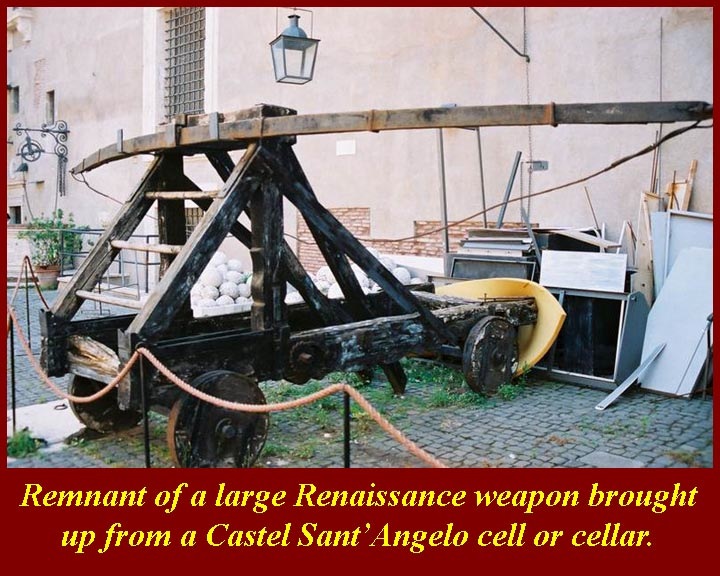
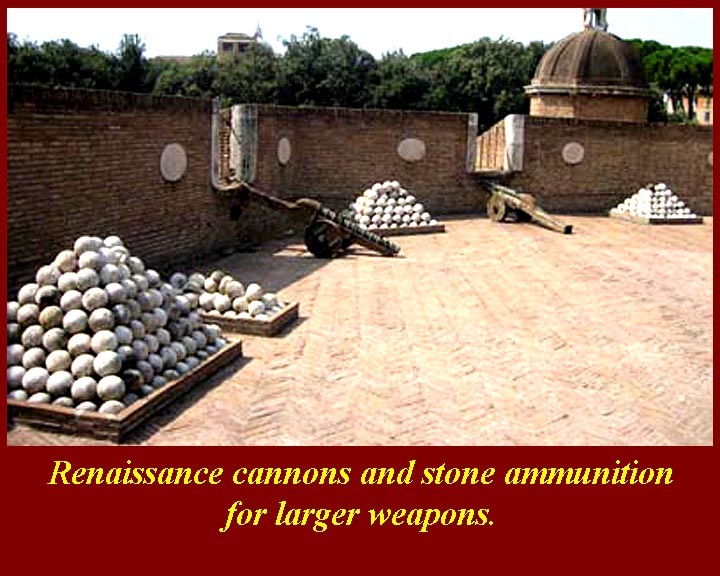
http://www.mmdtkw.org/RenRom0818-Crossbow.jpg
http://www.mmdtkw.org/RenRom0818a-WeaponLg.jpg
http://www.mmdtkw.org/RenRom0818b-SantAngeloGunsAmmo.jpg
http://www.mmdtkw.org/RenRom0819-Arquebus.jpg
Most of the attackers and the defenders were equipped with blade weapons -- swords, lances, halbards, axes -- but some also could fight at a distance using crossbows and Arquebusses. The attackers had abandoned their artillery, both mechanical and gunpowder. Both types of artillery were available to the defenders of Castel Sant'Angelo.
A form of the word "artillery" first appeared in French and is assumed to come from a Latin root. Its first meaning refered to the projectiles rather than the engines that launched them. Use of "artillery" in the sense of "mechanical engines for discharging missiles" (catapults, slings, bows, etc.) is from the late 15th century, and its use to mean "ordnance, large guns" is from 1530s.
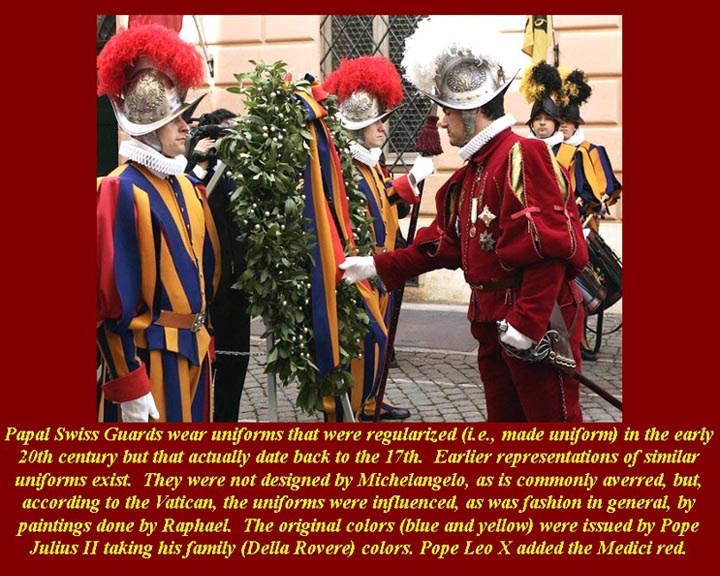
http://www.mmdtkw.org/RenRom0820-SwissGuards1.jpg
http://www.mmdtkw.org/RenRom0820a-SwissGuards2.jpg
The Papal Swiss Guards (official title, Corps of the Pontifical Swiss Guard) are montagnards and were already on duty at the time of the Sack of Rome in 1527. Pope Sixtus IV (1471-1484) had made the first alliance with the Swiss Confederation and built barracks in Via Pellegrino after foreseeing the possibility of recruiting Swiss mercenaries. The upper storey of the fortified Sistine Chapel was also designed as a barracks and guard station for the Swiss Guards. (Their current quarters are just to the east of the Pope's residence on the north side of St. Peter's Square.) The Popes used Swiss montagnards in several engagements before the Sack of Rome -- sometimes (during the papacies of the Borgias) against other montagnards, who fought for the French.
Julius II set up a permanent force of 150 Swiss mercenaries in 1506, the beginning of the current Swiss Guard force. Its first, and most significant, hostile engagement was on May 6, 1527 when 147 of the 189 Guards, including their commander, died fighting the unruly troops of Holy Roman Emperor Charles V during the Sack of Rome in order to allow Clement VII to escape through the Passetto di Borgo, escorted by the other 40 guards.
The Vatican internet site states that the uniform of the Swiss Guards was designed in 1914 by Commandant (1910-1921) Jules Repond, but a painting (by Raphael) of the Swiss Guard bearing Pope Julius II on a litter is often cited as inspiration for the Swiss Guard uniform. The uniforms worn by those soldiers appear to have a large skirt or very broad knee pantaloons. The yellow and blue colors are those of the Della Rovere family of Julius and the red flashes were added by the Medici to reflect their own family colors. Enlisted personnel wear the multi-colored uniforms and officers wear solid scarlet for ceremonial occasions. Many sources claim that the multi-colored uniform of the Swiss Guard enlisted men was designed by Michelangelo, but the Vatican says that it was costumes in paintings by Raphael (not Michelangelo) that influenced the uniform design and also influenced fashion of the period. A plain blue version of the uniform is used for regular duty, and a dark blue long cape is used in inclement weather. The "men in black"-- black suits, white shirt, dark blue tie -- that are seen standing around the doors and inside of St. Peters and in the Vatican Museums are also Swiss Guards.
An short "official" English language history of the Pontifical Swiss Guards is available at the Vatican internet site, http://www.vatican.va/roman_curia/swiss_guard/swissguard/storia_en.htm.
Aftermath of the Sack
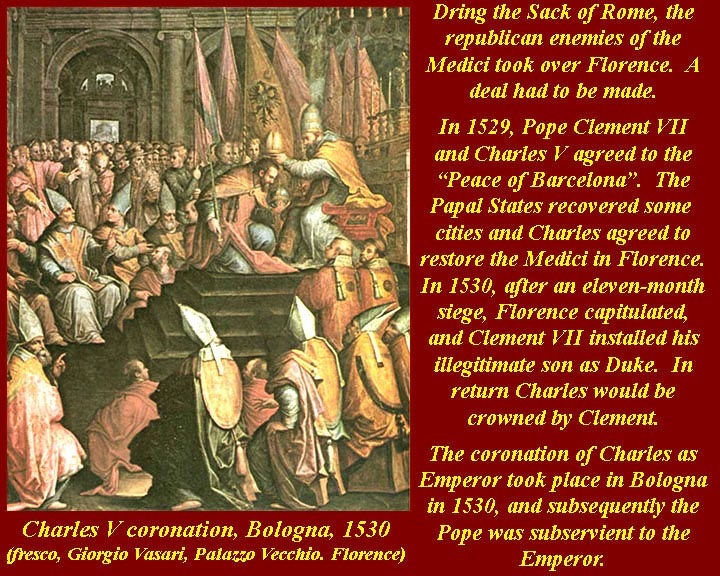
http://www.mmdtkw.org/RenRom0823-CharlesVCoronation.jpg
http://www.mmdtkw.org/RenRom0823a-CharlesVCoronation.jpg
Three years after the Sack, Clement and Charles V had patched things up. By the "Peace of Barcelona" (1529) the Papacy recovered some Italian cities and Charles agreed to restore Medici power in Florence; the Medici had been ousted there by republicans who took advantage of the chaotic movements of the imperial forces in the north. (It took an 11 month siege of Florence by an imperial army to break the republic and reinstall the Medici.) In return the pope crowned Charles V as Holy Roman Emperor in 1530 in Bologna, which allowed Charles officially to drop the word "Elect" from his title; it didn't really matter because that word had long since been dropped unofficially.
The "coronation oath" taken by Charles took the form of an interrogation administered by the Archbishop of Cologne in his capacity as Prince-Elector of the Holy Roman Empire. The last question was, "Will you pay due submission to the Roman Pontiff and the Holy Roman Church?" Charles responded, "I will", but he didn't fool anybody.
http://www.mmdtkw.org/RenRom0823b-RomeCityPopulation1.jpg
During the Sack and in the period immediately following, most of Rome's population -- some 45,000 people -- fled to the countryside or to the safety of relatives in other towns leaving only about 10,000 Romans in the city, the smallest number since the early days of the ancient kings of Rome. They didn't stay away long. In fact in the period following the Sack there was population growth fueled by a building boom as the rich families and the Cardinals repaired and refitted their Palazzi and as the Vatican, the Cardinals, the religious orders, and the social, labor, and religious confraternities did the same for their churches and meeting places. The pre-Sack population was about 55,000, and by 1550 population had risen back to 60,000.
This page is http://www.mmdtkw.org/RenRom0900-HistoriogrIntro.html
Historians and Diarists --Roman Renaissance Historiography -- Unit 9
Historiography is the word historians use to describe their efforts to judge various books written about historical subjects. They try to subject all written accounts of any particular event or incident to objective criteria in order to determine not only what really happened, but also how close to accuracy authors have come. Historiography deals with recorded history (lower case) and not with "everything that's ever happened" History (upper case). Although there were ancient attempts to figure out which previous historians were accurate and which were not, modern historians pretty much agree that historiography as a separate discipline was invented by Italian Renaissance humanists, who first tried to judge the historical accuracy of ancient writings and, as time went on, began to judge each other.
This process continues today, and its major locus is, of course, in academia. Although the continuum of historical writing today is extremely broad, for academic purposes, historiography splits into four basic streams:
We all participate in some of these activities. For example, at the beginning of this course there were recommendations for anyone who felt that they just had to have a textbook in addition to the course handouts. Those recommendations -- an exercise in historiography -- were:Continuing to judge materials that were written in the past -- everything from the ancient sources to histories written last week; The process of choosing textbooks and course materials; Peer review for publication in academic periodicals; and Evaluation and criticism of non-academic works with historical content. The process used in choosing handout materials was also an exercise in historiography.The Renaissance in Rome, by Charles L. Stinger; Renaissance Rome 1500 - 1559, A portrait of a Society, by Peter Partner; and The Art of Renaissance Rome, by Loren Partridge. Jacob Burckhardt's classic, Civilization of the Renaissance in Italy, on the internet at http://www.boisestate.edu/courses/hy309/docs/burckhardt/burckhardt.html Also, whenever we decided that a Renaissance source was "good" (Johannes Burchard) or "bad" (Stefano Infessura) or that modern authors that used good or bad sources were "reliable" or "suspect", we were participating in historiography.
It must be noted that, as much as historians might try to make historiography into an exact "science", it will never be so. Historians, like everyone else, are riddled with their own political, economic, religious, and academic prejudices. Bitter and persistent feuds are not uncommon.
Our own judgements, of course, will continue to be unaffected by prejudice.
Subjects to be discussed in this unit are:
The reasons for Renaissance humanist interest in historical accuracy; Some Internet Links for this unit:"Good" and "bad" primary sources. This often boils down to whether Renaissance writers were critical of themselves and of their own patrons (e.g., Guicciardini or Burchard) or were critical only of their enemies and the enemies of their patrons (e.g., Infessura or Cellini).
The first Italian Renaissance historians/diarists/autobiographers and how good a job they did -- the Rashômon problem;
"Reception 1" -- use of primary sources in the years between then and now;
"Reception 2" -- our own handling of what primary and secondary sources have left us, and the difficulties of portraying the Roman Renaissance (or anything else) for the pop culture market.
http://www.britannica.com/eb/article?eu=115324&hook=524003#524003.hook http://www.knowledgerush.com/kr/jsp/db/biography.jsp?authorId=701&authorName=Benvenuto+Cellini
http://www.mmdtkw.org/VBurcardo.html
http://www.theatrelibrary.org/english.htm
http://www.romeartlover.it/Gregorovius.html
http://www.italicapress.com/index165.html
http://www.newadvent.org/cathen/08002a.htm
http://www.boisestate.edu/courses/hy309/docs/burckhardt/burckhardt.html
Use your Internet search engine to find names of authors or works.
Slides used for this unit are on the Internet at http://www.mmdtkw.org/RenRomUnit0900-0PixList.html.
Renaissance Rome
Unit 9 Slides
http://www.mmdtkw.org/RenRomUnit0900-0PixList.html
Historians and Diarists
Roman Renaissance HistoriographyClick small images or links below to view larger images for Unit 9
http://www.mmdtkw.org/RenRom0901-HumanistHistor.jpg
All humanists studied History and some also wrote histories.
http://www.mmdtkw.org/RenRom0902-CelliniSkepticis.jpg
Benvenuto Cellini's self promotion invites skepticism about anything he wrote in his autobiography.
http://www.mmdtkw.org/RenRom0902a-VasariUncritica.jpg
Giorgio Vasari's uncritical use of unverified/unverifiable source information and his propensity for ignoring or at least belittling anything that didn't originate in Florence gives us problems in assessing his Lives.
http://www.mmdtkw.org/RenRom0903-VallaLingAccura.jpg
Lorenzo Valla reconstructed Latin grammar and thereby helped other humanists understand the ancient historians. He also contributed to historical accuracy by debunking the Donation of Constantine.
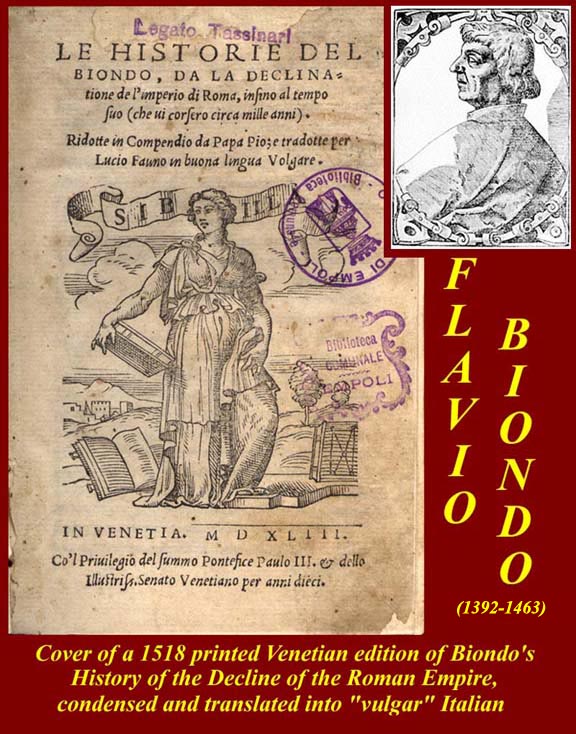
http://www.mmdtkw.org/RenRom0904-BiondoHistory1.jpg
http://www.mmdtkw.org/RenRom0905-BiondiRomaInstau.jpg
Flavio Biondo's history from the decline of the Roman Empire until his own time was a fairly successful attempt to fill in gaps in the record between Constantine and the early Renaissance. Biondo also invented the Renaissance discipline of urban topography with His Roma Instaurata.
http://www.mmdtkw.org/RenRom0906-Guicciardini.jpg
Francesco Guicciardini wrote a twenty volume History of Italy and was the main "source" of information of his brother Luigi's contemporary account of the Sack of Rome. (An English translation if Luigi's account, by Professor James H. McGregor (U. of Georgia), is now available.)
http://www.mmdtkw.org/RenRom0906a-BurchardDiaary.jpg
Johann Burchard was the papal Master of Ceremonies from 1483 through 1503 when he died. He was the keeper of the papal ceremonial schedule and kept a diary of events for the last few months of the pontificate of Sixtus IV, the whole of those of Innocent VIII, Alexander VI, and Pius II, and the first years of the pontificate of Julius II. The whole of Burchard's diary is in the Vatican Library, and it is considered to be an authoritative source of papal history of its time. The Image shows an English language edition of part of his diary, concerning only the pontificate of Alexander VI Borgia, issued by the London Folio Society in 1963 and reissued in 1993.
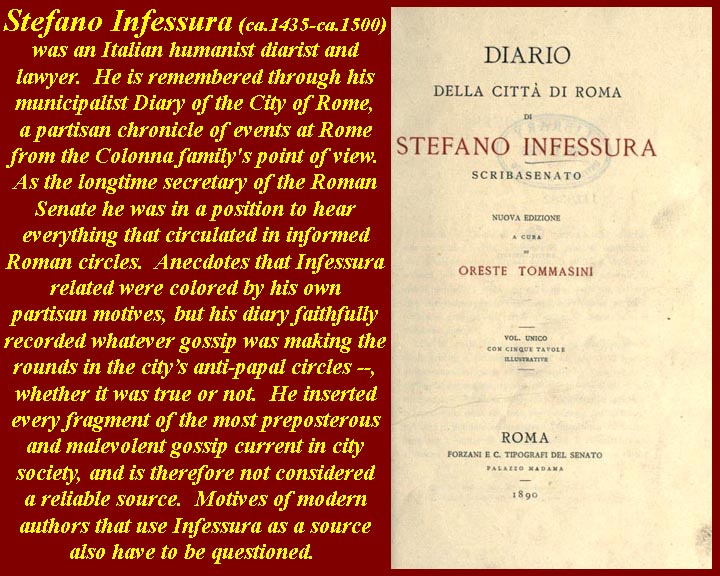
http://www.mmdtkw.org/RenRom0906b-RenInfessuraDiario1.jpg
http://www.mmdtkw.org/RenRom0906c-InfessuraDiario2.jpg
Unlike Burchard, Stefano Infessura's reputation for accuracy is notoriously bad. He was in the pay of the Colonna family, who were mortal enemies of the Borgias, and did everything possible to blacken the name of the Borgia popes. This included reporting any gossip, rumors, or outright lies as fact in his own diaries. His inaccuracy has been known for centuries, and any later authors who relied on his accounts of goings on in the papal court were either woefully ignorant or willfully were trying to defame the Catholic church.
http://www.mmdtkw.org/RenRom0907-HistoryGregorovi.jpg
Ferdinand Gregorovius published an eight volume History of The City of Rome in the Middle Ages but defined the middle ages as the period between 400 AD and 1534 AD. So his history actually includes Rome's "high renaissance" and the Sack of Rome.
http://www.mmdtkw.org/RenRom0908-LucreziaGregorov.jpg
Gregorovius also wrote a sympathetic biography of Lucrezia Borgia, which is now a standard text in "women's studies" courses. The full text of the John Leslie Garner English translation is available free on the Internet at http://www.gutenberg.lib.md.us/2/0/8/0/20804/20804-h/20804-h.htm.
http://www.mmdtkw.org/RenRom0909-SabatiniBorgia.jpg
Raphael Sabatini was most famous for swashbuckling novels and for Errol Flynn movies (Sea Hawk and Captain Blood) -- and don't forget Stewart Granger in Scaramouche. But he also wrote one of the best biographies of Cesare Borgia, the introduction of which excoriates authors of "historical fiction" for not clearly delineating the historical and the fictional. He specifically condemned Victor Hugo's inaccurate treatment of the Borgias. The full text of the Sabatini Life of Cesare Borgia is available on the Internet at http://www.gutenberg.org/etext/3467.
http://www.mmdtkw.org/RenRom0910-BurckhardtTextbo.jpg
Jacob Burckhardt, a Swiss historian, wrote a History of Renaissance Rome in 1868 that is still used as a textbook in many Universities. A full text English translation is available on the internet at http://www.boisestate.edu/courses/hy309/docs/burckhardt/burckhardt.html.
http://www.mmdtkw.org/RenRom0910a-MarciaHallRomeArt.jpg
Marcia B. Hall's Rome is part of the Artistic Centers of the Italian Renaissance series, and, as such, it concentrates on the art of the period in Rome. Some reviewers have complained that it does not cover Roman renaissance architecture deeply enough, but such criticism can be dismissed simply by remembering that the series deals with art, not architecture. The book, which costs about $150, is well beyond the means of many casual readers.
http://www.mmdtkw.org/RenRom0910b-StingerRenaissanceRome.jpg
Charles L. Stinger's The Renaissance in Rome was first published in 1985 and a new edition appeared in 1998. The author acknowledges in his second edition forward that no changes have been made to the text, but the very useful bibliography was updated to reflect newer research. Despite its age, the Stinger I is still a standard university text.
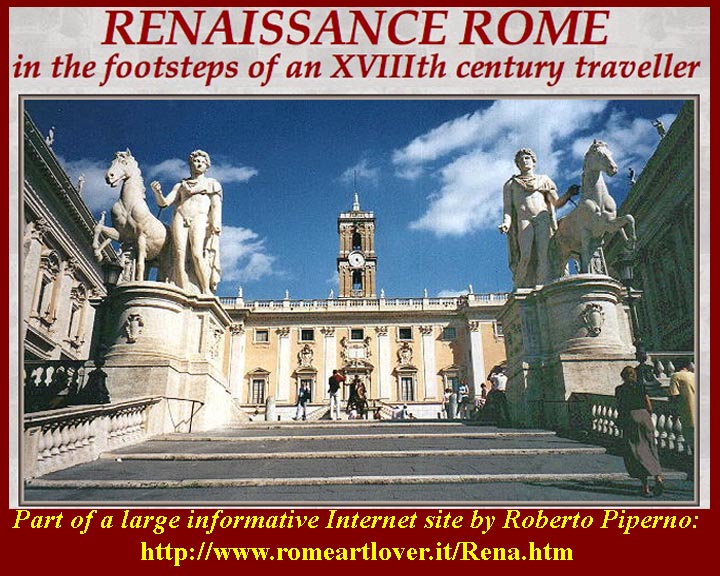
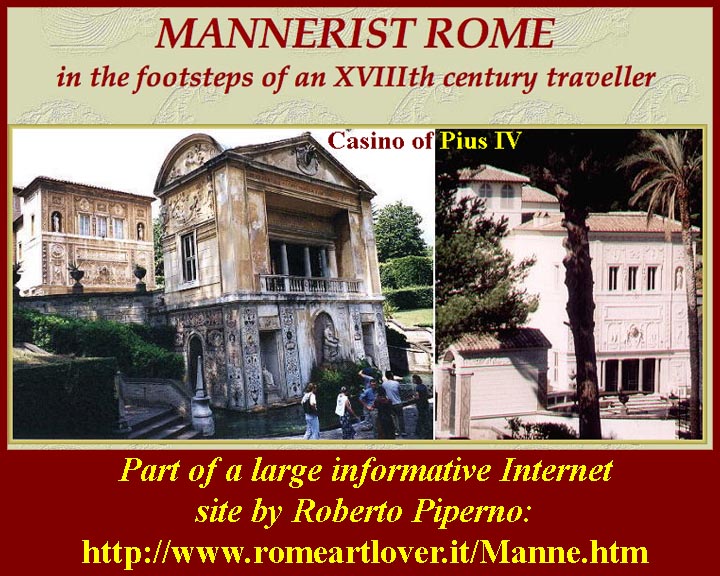
http://www.mmdtkw.org/RenRom0910c-PipernoRenaissance.jpg
http://www.mmdtkw.org/RenRom0910d-PipernoMannerist.jpg
http://www.mmdtkw.org/RenRom0910e-PipernoAbridgedHistory.jpg
Roberto Piperno's Internet site is a "must visit" for anyone interested in the History of Rome. The sections on Renaissance and Mannerist Rome are particularly useful for this course. See:
http://www.romeartlover.it/Umbereco.html#Modern
http://www.romeartlover.it/Rena.htm
http://www.romeartlover.it/Manne.htm
http://www.mmdtkw.org/RenRom0910f-RomeReborn.jpg
The 1993 Vatican Library / US Library of Congress exhibition Rome Reborn is long gone, but, thankfully, its Internet site is still on line. Look for it at http://www.loc.gov/exhibits/vatican/.
http://www.mmdtkw.org/
http://www.mmdtkw.org/
http://www.mmdtkw.org/RenRom0911-SelectiveSources.jpg
Some authors, especially "best sellers", use sources selectively to confirm theses that will sell books. We can sometimes suspect anti-Papal and anti-Catholic motives, at least in the buyers if not in the authors.
http://www.mmdtkw.org/RenRom0912-VersionsLucrezia.jpg
There are often multiple versions of Renaissance history. Gaetano Donizetti's opera, Lucrezia Borgia, is an adaptation of the Victor Hugo version of Borgia "history" as drawn from Tomasso Tomassi and Stefano Infesurra. For the Libretto of Donizetti's opera, see http://opera.stanford.edu/Donizetti/LucreziaBorgia/libretto.html.
http://www.mmdtkw.org/RenRom0913-AgonyEctasy.jpg
Irving Stone's best selling The Agony and the Ecstasy just scratched the surface of the long and complex relationship between Michelangelo and Julius II, but he did as good a job as could be expected -- no single volume could contain it all. It made many mistakes concerning the actual installation of the Sistine Chapel ceiling frescoes. The movie, a great commercial success, was even less able to encompass the story. And no one will ever convince me that Pope Julius sounded like Rex Harrison.
http://www.mmdtkw.org/RenRom0914-DaVinciIndustry.jpg
Today's prime example of misplaced trust in a fictional account that pretends to be based on fact is The Da Vinci Code. It has spawned a whole industry devoted to debunking or explaining the book.
http://www.mmdtkw.org/RenRom0915-DangerousFranco.jpg
It's probably possible to make a movie that accurately reflects legitimate historical research, but, if you know of any, please let me know. There are sometimes also questions about the legitimacy of the original research, on which a film might be based, if the research is done in highly specialized ethnic or sexist academic programs.
This page is http://www.mmdtkw.org/RenRom1000-Controversies.html
Complaints and Controversies
Controversey 1.
Is there anything to the "DaVinci Code"? Scholars say it's all made up. The author claimed that the background was all fact. Critics say the book isn't very good. Is it so popular because it's basically anti-Catholic? Is this the Protocols of the Elders of Rome?
Controversey 2.
Why was Galileo imprisoned? What was the role of Pope Urban VIII?
Copernicus and heliocentrism. Giordano Bruno, and why he is a latter day hero.
Controversey 3.
Were the Borgias as bad as they seemed? Were the any worse than their peers? Who poisoned whom? Did anyone poison anyone? Does Lucrezia's image need correcting?
Complaints:
Did / do the "Talking Statues" ("Statue Parlante") provide a real outlet. Pasquino and Marforio in conversation. "Pasquinate".
Internet Links for Unit 10:
DaVinci Code
http://en.wikipedia.org/wiki/The_Da_Vinci_Code
http://entertainment.howstuffworks.com/davinci-code.htm
http://www.opusdei.us/art.php?p=6437
http://www.telegraph.co.uk/culture/books/booknews/6194031/The-Lost-Symbol-and-The-
Da-Vinci-Code-author-Dan-Browns-20-worst-sentences.html
Copernicus
http://en.wikipedia.org/wiki/Nicolaus_Copernicus
http://plato.stanford.edu/entries/copernicus/
http://www.blupete.com/Literature/Biographies/Science/Copernicus.htm
http://webexhibits.org/calendars/year-text-Copernicus.html
http://www.astro.utoronto.ca/~zhu/ast210/helicentric.html
http://www.bj.uj.edu.pl/bjmanus/revol/titlpg_e.htmlGiordano Bruno
http://www.newadvent.org/cathen/03016a.htm
http://es.rice.edu/ES/humsoc/Galileo/People/bruno.html
http://www.setileague.org/editor/brunoalt.htm
http://www.esotericarchives.com/bruno/home.htmGalileo
http://en.wikipedia.org/wiki/Galileo_Galilei
http://webexhibits.org/calendars/year-text-Galileo.html
http://galileo.rice.edu/
http://www.law.umkc.edu/faculty/projects/ftrials/galileo/galileo.htmlBorgias
http://www.mmdtkw.org/VBorgias.html
http://en.wikipedia.org/wiki/House_of_Borgia
http://www.dragonrest.net/histories/lucrezia.html
http://www.gutenberg.net/dirs/etext02/lcbga10.txt
http://www.reuters.com/article/idUSN097427220100109Talking Statues
http://roma.andreapollett.com/S1/roma-c2.htm
http://en.wikipedia.org/wiki/Talking_statues_of_Rome
http://www.romeartlover.it/Talking.html
Renaissance Rome
Unit 10 Slides
http://www.mmdtkw.org/RenRomUnit1000-0PixList.html
Complaints and ControversiesClick small images of links below to see larger images for Unit 10
Leonardo Da Vinci -- No code necessary!
http://www.mmdtkw.org/RenRom1001-DaVinciMagdaJesu.jpg
Da Vinci Secret? -- Jesus and Mary M. married? Had kids?? Whose offspring were guardians of the secret of the "Grail"???
http://www.mmdtkw.org/RenRom1002-DaVinciNoCode.jpg
Da Vinci -- No code needed
http://www.mmdtkw.org/RenRom1003-DaVinciCodeBored.jpg
Da Vinci-cide -- boring, get a life! Critics universally say that all the Dan Brown novels are riddled with inaccuracies and amazingly badly written. But the public eats them up. Nice pandering, Dan.
http://www.mmdtkw.org/RenRom1003a-LeonardoMOSBoston.jpg
There are many good Internet sites about Leonardo, and there are just as many ridiculous sites. Some of the ridiculous sites are somehow connected with the Da Vinci Code -- pro and con, and others are ridiculous in other ways, e.g., about his life-style, gay or not gay, depending on how you interpret his anatomy drawings. One recent ridiculous controversy is whether or not the Mona Lisa is a self-portrait and, if it is, what it might mean. People are really stretching to find dissertation topics.
One of the good and interesting Leonardo Internet sites is the subject of the image: http://www.mos.org/LEONARDO/
Giordano Bruno
http://www.mmdtkw.org/RenRom1004-BrunoStatue.jpg
Ettore Ferrari memorializes Giordano Bruno -- why is Bruno idolized/idealized.
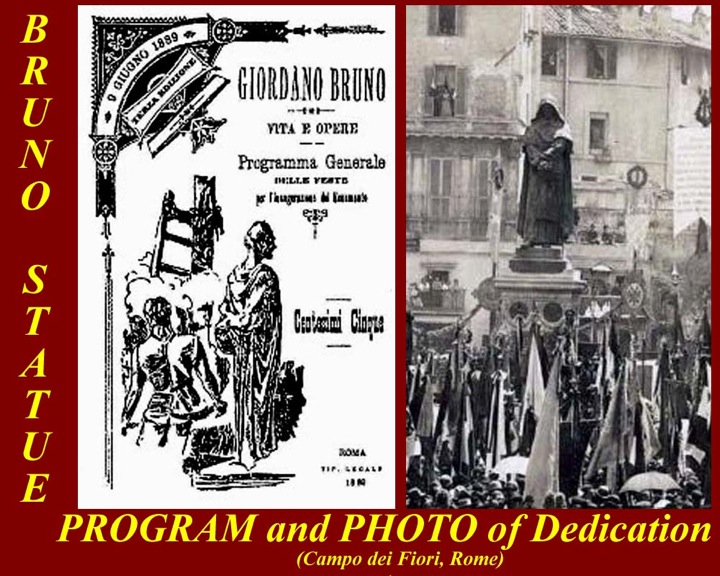
http://www.mmdtkw.org/RenRom1005-BrunoStatueDedic.jpg
http://www.mmdtkw.org/RenRom1006-BrunoCampoFiori.jpg
1889 -- the Bruno statue in context, in the Campo de Fiori on the spot he was burned by the Inquisition. The statue was originally an anti-clerical anti-Catholic shrine, but since the 1960's it has been a gathering place, first, for hippies and, later, for neo-pseudo-hippies -- idle rich kids on the new grand tour.
http://www.mmdtkw.org/RenRom1007-BrunoCampoFior2.jpg
The Bruno statue -- target practice for pigeons.
http://www.mmdtkw.org/RenRom1007a-BrunoDarling.jpg
Not surprisingly, Bruno is revered in Protestant countries, even though his philosophy, not to mention his prickly personality, got him thrown out of several of the Protestant states that he visited while he was on the run from the Catholic Inquisition. In Switzerland he was even excommunicated by the Calvinists, making him a unique individual who was excommunicated by both Catholics and Protestants.
Nicolaus Copernicus
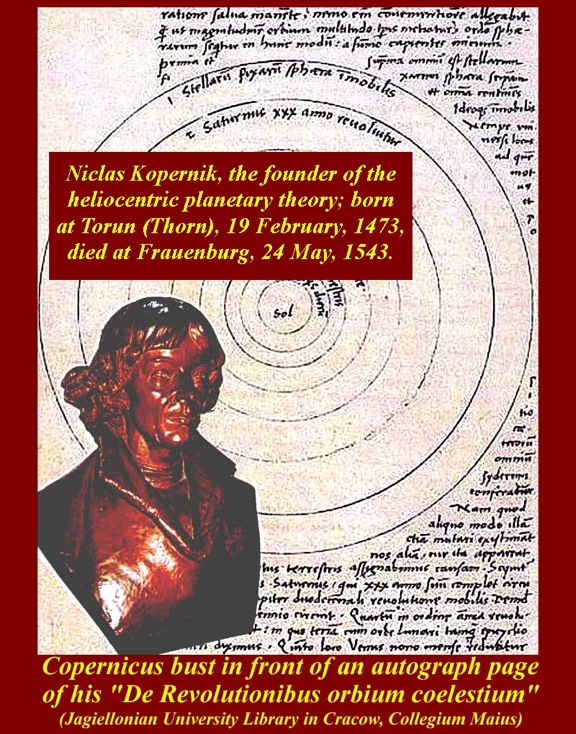
http://www.mmdtkw.org/RenRom1008-CopernicusRevolu.jpg
http://www.mmdtkw.org/RenRom1009-CopernHeliocentr.JPG
Copernicus and heliocentrism -- De Revolutionibus Orbium Celestium
Copernicus is said to be the founder of modern astronomy. He was born in Poland. In 1530, Copernicus completed and gave to the world his great work De Revolutionibus, which asserted that the earth rotated on its axis once daily and traveled around the sun once yearly: a fantastic concept for the times. Up to the time of Copernicus the thinkers of the western world believed in the Ptolemaic theory that the universe was a closed space bounded by a spherical envelope beyond which there was nothing. Claudius Ptolemy, an Egyptian living in Alexandria, at about 150 A.D., gathered and organized the thoughts of the earlier thinkers.
It should be noted that one of the ancient Greek astronomers, Aristarchus, did have ideas similar to those more fully developed by Copernicus but they were rejected in favor of the geocentric or earth-centered scheme as was espoused by Aristotle
http://www.mmdtkw.org/RenRom1009a-CopernicusOpposition.jpg
Church opposition to the heliocentric system proposed by Copernicus: Actually, opposition the Copernican system was first raised by Protestant theologians for biblical reasons shortly after De Revolutionibus was published in 1530, and some protestants still object to heliocentrism. Catholic opposition started only seventy-three years later, when it was precipitated by the trial of Galileo. In 1616 De Revolutionibus was placed on the Index of Forbidden Books "until corrected", and four years later the required corrections were enumerated. Nine sentences, in which the heliocentric system was represented as certain (as opposed to being theoretical) were to be omitted or changed. When this was done, the book was taken off the Index.
Galileo Galilei
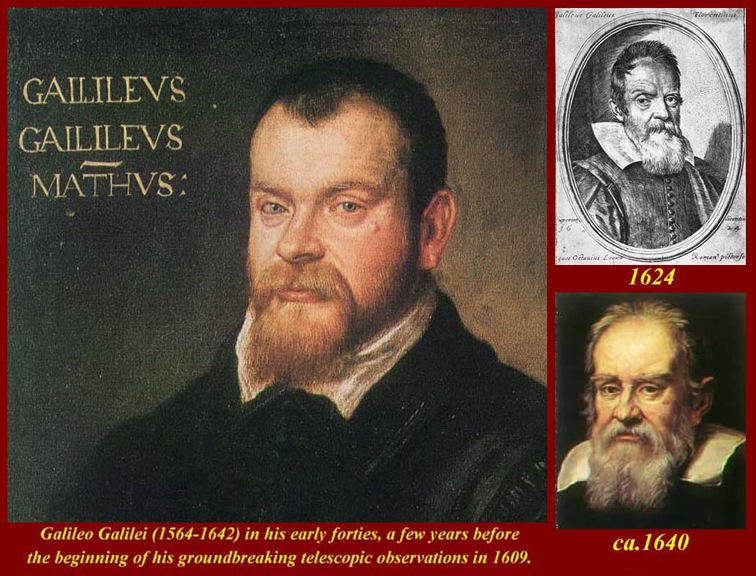
http://www.mmdtkw.org/RenRom1010-GalileoAges.jpg
http://www.mmdtkw.org/RenRom1011-GalileoTelescope.jpg
Galileo portraits / Galileo telescope / moon mountains
http://www.mmdtkw.org/RenRom1012-DialogoGalileo.jpg
The "Dialogo" that got Galileo arrested: Galileo had skirted trouble with the Inquisition for several years -- and was warned about it by his daughter -- but he was always able to evade real trouble because of the protection of his friend, the humanist Cardinal Mafeo Barberini. Then Barberini was elected pope (Urban VIII), and Galileo could have been safe forever. But after several meetings with Urban, during which they discussed heliocentrism, and during which Urban raised his doubts about the system and about Galileo's insistence that it was certain (i.e., not a theory), Galileo issued another of his books defending the system (February 1632). In the Dialogo (Dialogue Concerning the Two Chief World Systems, Galileo put the Pope's arguments in the mouth of the doltish fictional character "Simplicius". Urban was definitely not amused, and instead of offering his usual protection he referred the issue to the Inquisition and presided over a session of the Inquisition that summoned Galileo. After several more sessions, Galileo was secluded first in the Medici Villa in Rome, then at the residence of the archbishop of Sienna in Tuscany, an finally in his own villa in Arcetri, near Florence, where he was under house arrest for the remainder of his life. He died in January of 1642.
For a detailed chronology of Galileo's trials and tribulations, see http://galileo.rice.edu/chron/galileo.html#1630.
Galileo was finally rehabilitated by the Catholic Church in 1984. See http://www.time.com/time/magazine/article/0,9171,921612-2,00.html.
The Borgias
http://www.mmdtkw.org/RenRom1013-LucreziaGregorov.jpg
Gregorovius on Lucrezia Borgia
http://www.mmdtkw.org/RenRom1014-SabatiniBorgia.jpg
Sabatini on Cesare Borgia (and on Victor Hugo)
http://www.mmdtkw.org/RenRom1015-LucreziaVeneto.jpg
Bartolomeo Veneto's portrait of the real Lucrezia
http://www.mmdtkw.org/RenRom1016-BorgiaApartments.jpg
Borgia Apartments in the Vatican
http://www.mmdtkw.org/RenRom1016a-LucreziaFerrara.jpg
Once she got away from the Papal court and arrived in Ferrara (aged 22), Lucrezia Borgia turned out to be the ideal wife -- well almost. She probably had affairs, but then so did her husband. The only real scandal was when that husband, Alfonso d'Este (who during their marriage became Duke of Ferrara), killed a suspected lover while in a jealous rage. She became a patron of the arts and her court rivaled that of her comtemporary and relative, Elizabeth d'Este of Mantua. Her sympathetic biographer, Ferdinand Gregorovius, described her as "amiable, gentle, thoughtless, and unfortunate", that is, she was a victim rather than an actor. For Lucrezia, see http://en.wikipedia.org/wiki/Lucrezia_Borgia. For Lucrezia Borgia, the biography by Gregorovius, see http://www.gutenberg.org/files/20804/20804-h/20804-h.htm.
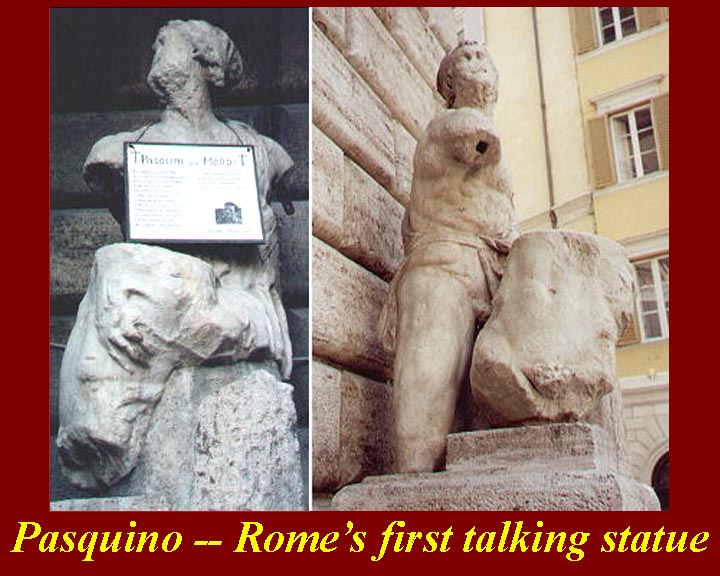
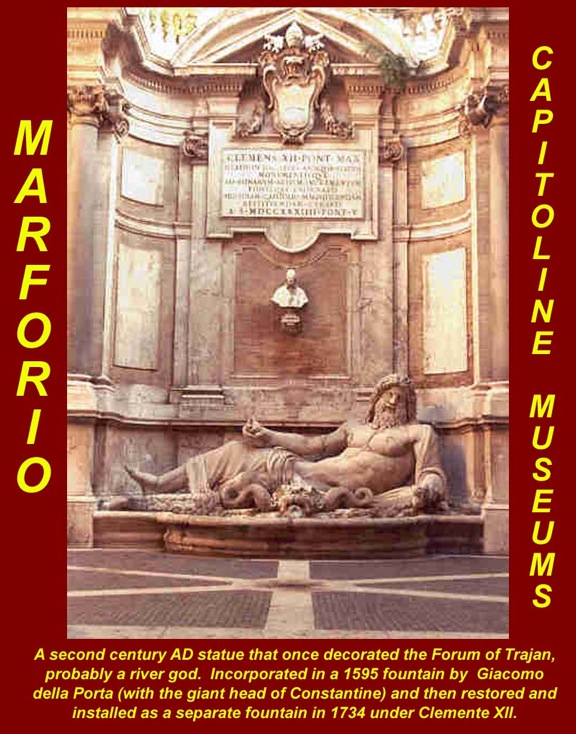
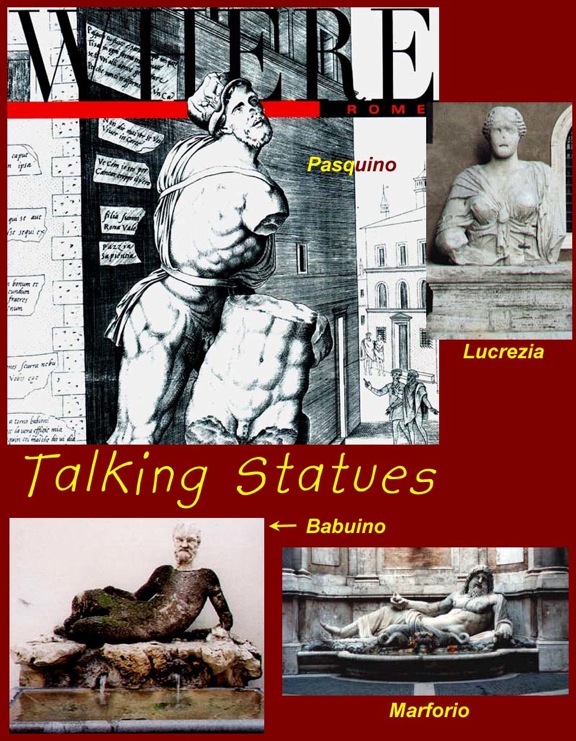
http://www.mmdtkw.org/RenRom1016bPasquino.jpg
http://www.mmdtkw.org/RenRom1017-MarforioTalker.jpg
http://www.mmdtkw.org/RenRom1018-TalkingStatues.jpg
Rome's has had "talking statues" since 1501 when Cardinal Oliviero Carafa installed the torso of a statue representing Menelaus with the body of Patroclus in a small square near Piazza Navona. Each year on April 25 the Cardinal chaired a sort of Latin literary competition and poems were posted on the statue and occasionally this happened outside the competition period. In this way Pasquino (the name given to the statue) became the first talking statue of Rome and it is still used from time to time for posting messages and claims. The little square is named after him Piazza di Pasquino and pasquinata (pasquinade) is the word used for a short satire exhibited in a public place. It was not unusual that dogerel verses critical of the Popes or of other authority figures would appear overnight on the statue to the great amusement of the people.
Of course, informers and secret police started to watch pasquino to see nab the disaffected persons who posted complaints. Soon other staues around town also started "talking" in the same terms; sometimes they even carried on "conversations", in which a pasquinade on one statue is answered the next day in a pasquinade on another statue. The talking statues are all still in use. The escapades of Italian Prime Minister Silvio Berlusconi are frequent pasquinata subjects these days.
Marforio is a large 1st century Roman marble sculpture of a reclining bearded river god or Oceanus, which in the past has been variously identified as a depiction of Jupiter, Neptune, or the Tiber. It was the humanist and antiquarian Andrea Fulvio who first identified it as a river god, in 1527. The Marforio was a landmark in Rome from the late twelfth century. In the early sixteenth century it was still near the Arch of Septimius Severus, where the various authors reported it.
Pope Sixtus V had the Marforio moved to the piazza di San Marco in 1588, and then to the piazza del Campidoglio in 1592, where it decorates a fountain designed by Giacomo Della Porta on a wall of the Basilica di Santa Maria in Ara Coeli, facing the Palazzo dei Conservatori. Part of the face, the right foot, and the left hand holding a shell were restored in 1594. In 1645, the building of the Palazzo Nuovo enclosed the fountain. The statue was moved again in 1679, at the order of Pope Innocent X, who had it placed in the courtyard of the Palazzo Nuovo di Campidoglio where it remains today.
http://www.mmdtkw.org/RenRom1019-Pasquinate.JPG
Pasquino: Romans still gather to read "Pasquinate".